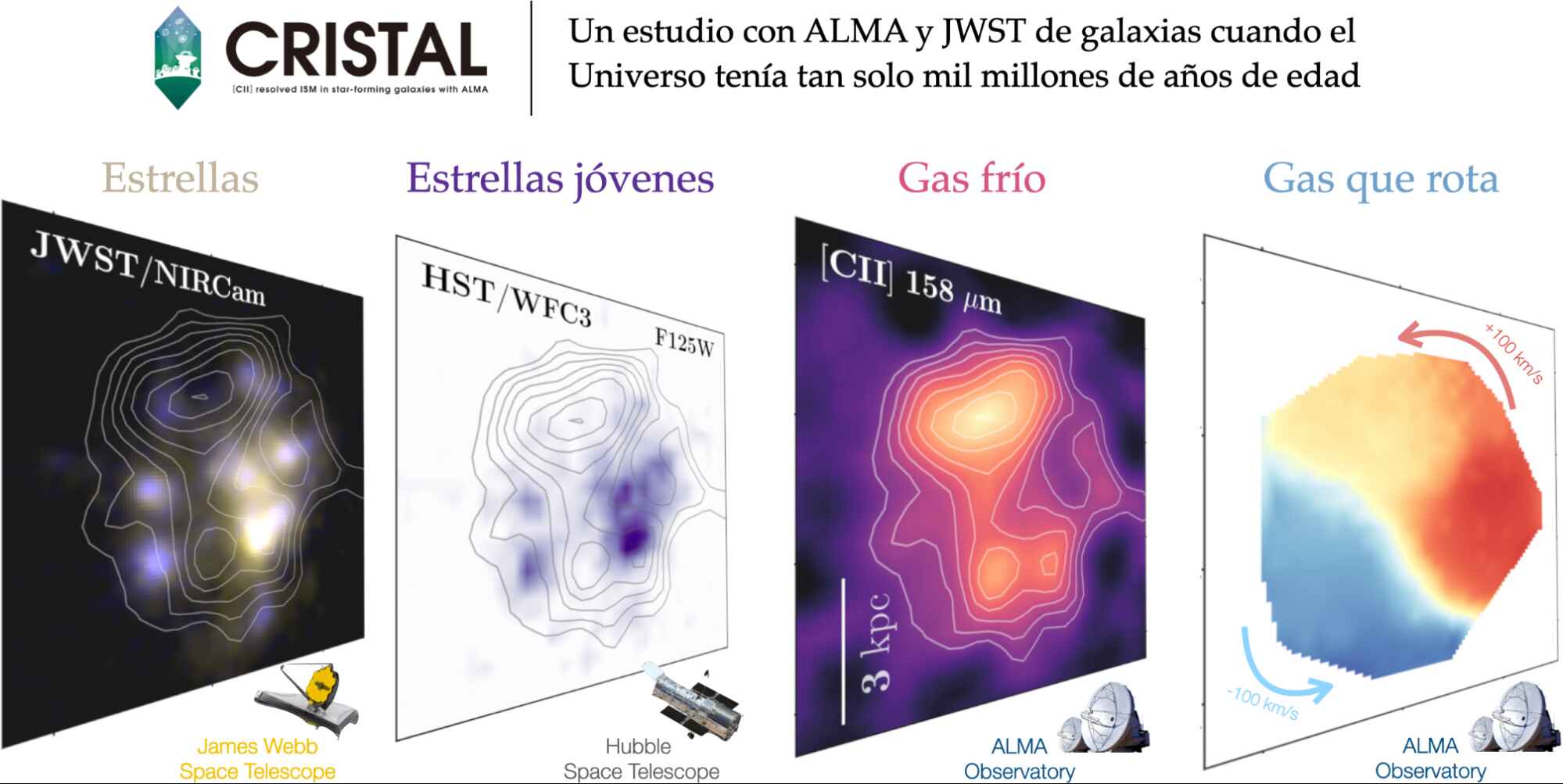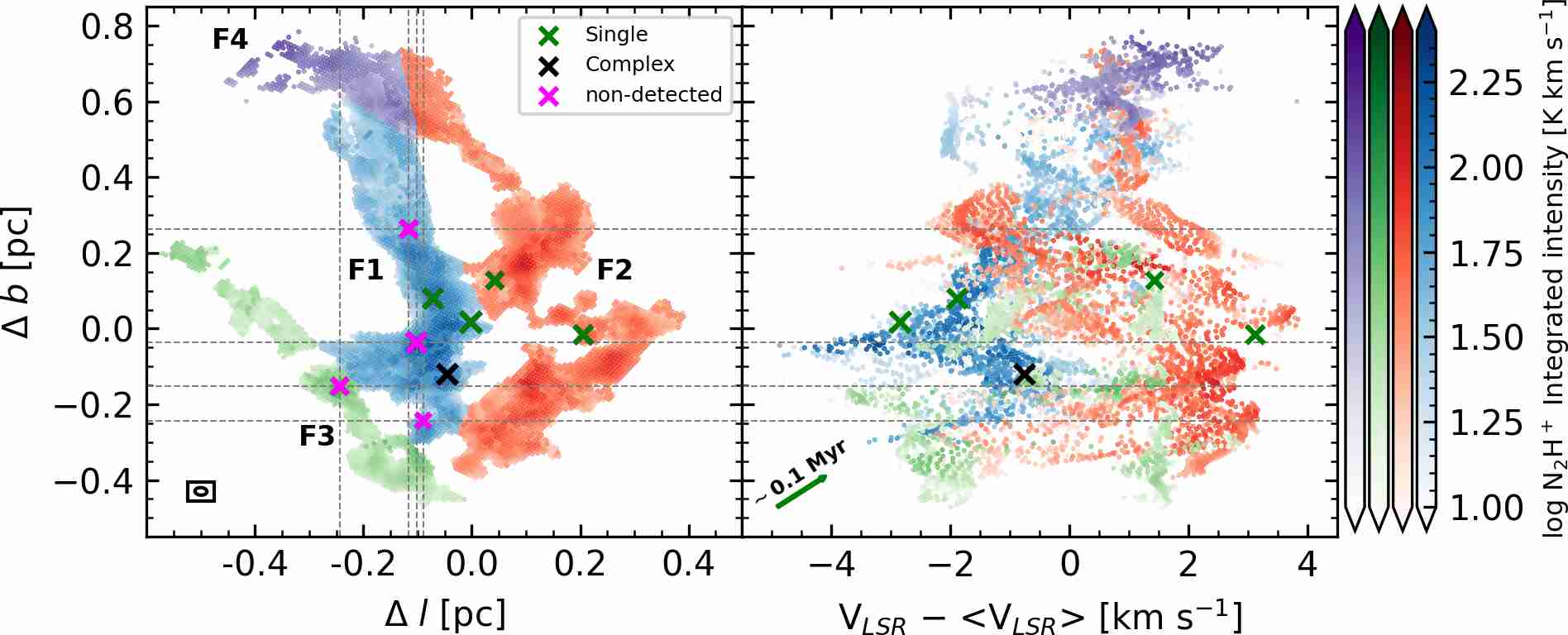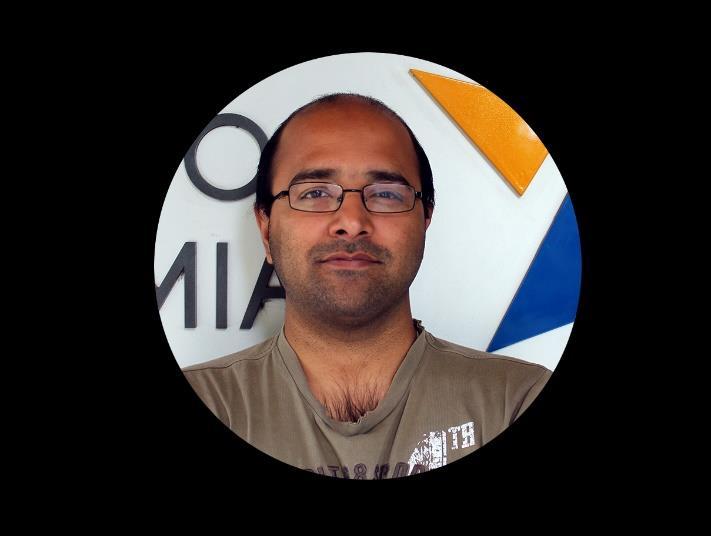Latest News:
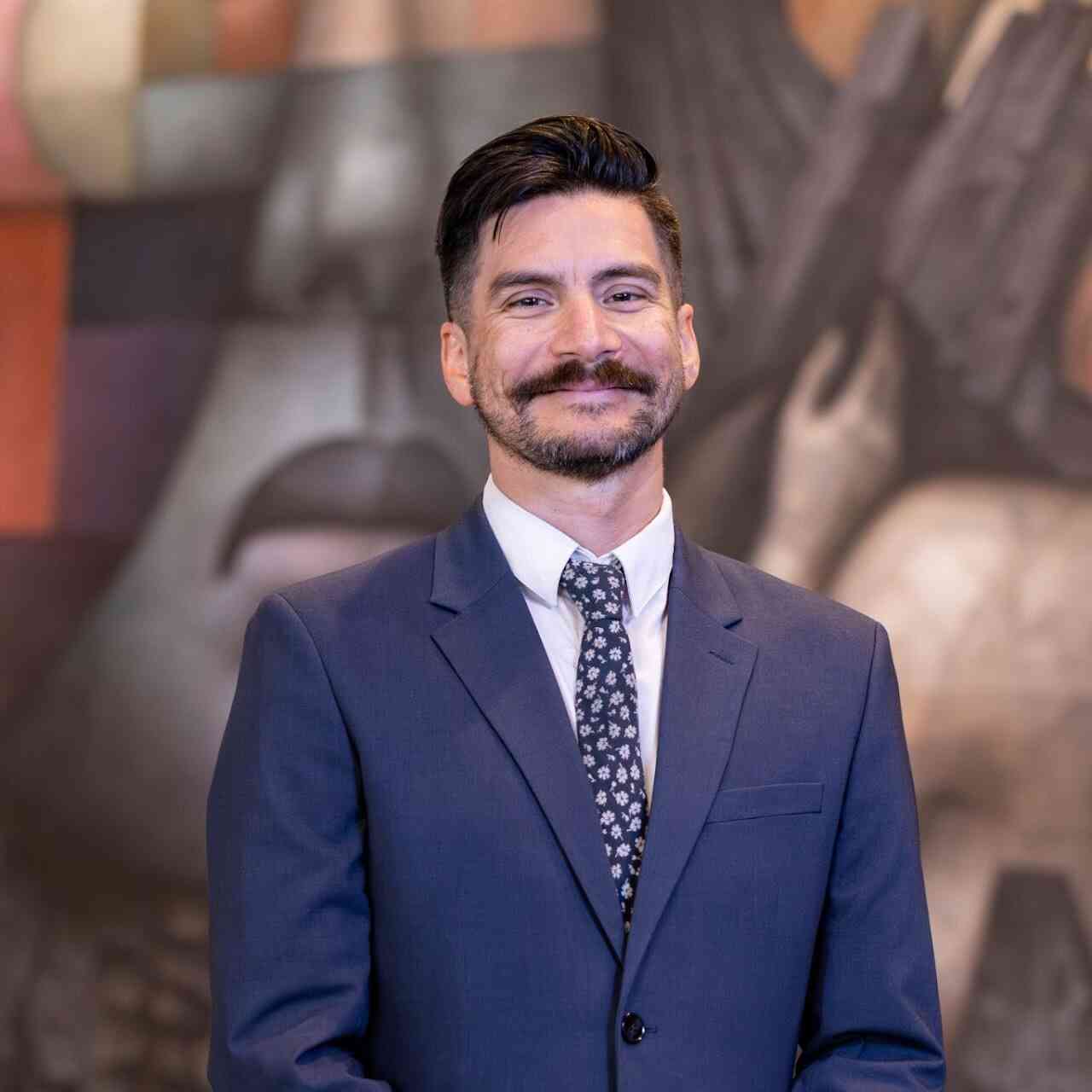
Concepcion, 22 December 2025
UdeC Astronomy Academic Leads Publication That Brings Together All the Knowledge Accumulated About the Beginning of the Universe
The publication was released today in the prestigious journal Nature Astronomy. It brings together the main advances achieved thanks to the combined capabilities of ALMA and the James Webb Space Telescope, revealing that the first galaxies and black holes formed earlier and faster than previously expected, and highlighting the leading role that Chile will play in the coming decades.
The international team was led by Rodrigo Herrera-Camus, academic at the University of Concepcion (UdeC) and director of the Millennium Nucleus of Galaxies (MINGAL). The work integrates the most significant results obtained over the past three years from joint observations with the ALMA observatory, located in northern Chile, and the James Webb Space Telescope (JWST).
“This is a beautiful achievement, not only because of its promising content, but also because Nature Astronomy invited us to write this article, which is a true recognition that we are leaders in the field. This is not only about what our team has learned from its research; it is a paper about what the global astronomical community has learned about the early Universe. That is extremely rare. It is a great honour,” says the UdeC astronomer.
Treasure of the sky
Thanks to the combination of data from these two giants, ALMA and JWST, Herrera notes that the study of galaxies observed between 300 and 800 million years after the Big Bang, the “childhood” of the Universe, has undergone a profound transformation. “We now know that galaxies and their associated supermassive black holes emerged much earlier in cosmic history than classical models predicted.”
Before these instruments existed, research on distant galaxies relied mainly on ultraviolet observations and global estimates of mass and star formation, with very limited information on gas and dust. Today, it is possible to observe cold gas, dust, and stars on scales comparable to those studied in nearby galaxies, revealing that early evolution was faster, more complex, and more diverse than expected.
“In both abundance and size, these first galaxies appeared and grew much faster than our simulations could explain. It has truly revolutionised our understanding of how galaxies like the Milky Way formed so early,” explains Herrera-Camus. Among the main findings is the rapid appearance of interstellar dust and of chemical elements such as carbon, nitrogen, and oxygen in the very first stages of these systems.
The work also documents the detection of well-organised galactic discs at extremely early times, challenging the idea that such structures formed slowly and gradually. Added to this is the identification of “baby” supermassive black holes, some without a clearly visible host galaxy, as well as powerful galactic winds capable of expelling gas and regulating star formation from very early stages.
Stronger Together
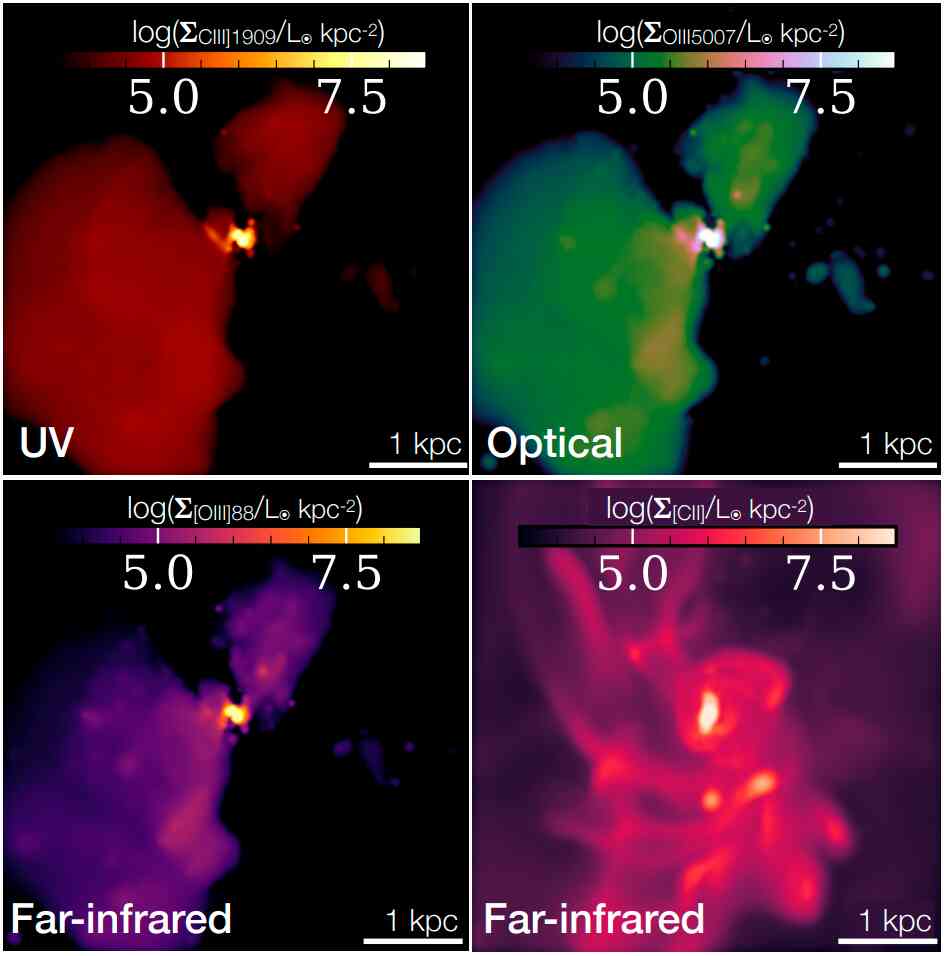
“This article presents an integrated view of the early Universe, bringing together the most relevant research worldwide to build a coherent picture of how the first galaxies formed, how they became enriched with metals, how the first discs were born, and how the first black holes grew,” says the researcher, who is also part of the Center for Astrophysics and Related Technologies – CATA (ANID Basal Centre). According to the astronomer, this article becomes a key and up-to-date reference for the field.
The paper draws on ALMA observations, which trace the early interstellar medium through atomic lines such as [CII] and [OIII], and on JWST data obtained with instruments including NIRCam, NIRSpec, and MIRI. These results are complemented by advanced cosmological simulations and sophisticated spectroscopic and energy-modelling techniques, also projecting the crucial future role of the Extremely Large Telescope (ELT) in deepening these studies.
The work highlights the leading role that Chile will play in the study of the early Universe thanks to the forthcoming operation of the ELT which, in combination with ALMA, will reveal with unprecedented detail how the first galaxies formed. It is also the result of more than a year and a half of work, originating in the international workshop “Synergistic ALMA+JWST View of the Early Universe”, held in December 2024 at the Lorentz Center in Leiden, the Netherlands.
The study, entitled “The early Universe with JWST and ALMA”, was written by Rodrigo Herrera-Camus together with Natascha M. Förster Schreiber (Max Planck Institute for Extraterrestrial Physics), Livia Vallini (Istituto Nazionale di Astrofisica), Rychard Bouwens (Leiden Observatory, Leiden University), and John D. Silverman (Kavli Institute for the Physics and Mathematics of the Universe, University of Tokyo). The article can be accessed at the following link: article
Millennium Nucleus MINGAL

Concepcion, 22 December 2025
UdeC Department of Astronomy Invites the Community to Explore the Universe This Summer
With a varied programme of activities, the Department of Astronomy at the University of Concepcion (UdeC), through its Astronomy Outreach Team (EDA in spanish), is launching its 2026 Summer Programme, an initiative aimed at bringing astronomy closer to children and families during the month of January.
The programme will run from Monday 12 to Friday 16 January and includes workshops specially designed for children up to 12 years old, as well as family activities, combining scientific content, educational materials, and hands-on experiences.
A journey through the cosmos to learn by doing
Throughout the week, participants will explore different areas of astronomy, such as our galaxy, black holes, eclipses, the Sun–Earth–Moon system, lunar exploration, telescopes, the life and evolution of stars, and comets.
Each day will include morning workshops focused on children and afternoon sessions designed for families, many of them featuring practical activities, model building, and specially prepared materials to help explain complex astronomical concepts in an engaging and accessible way.
Among the highlights are workshops such as A Journey Through Our Galaxy, Lunar Explorers, Telescopes: The Eyes of the Earth, Life of the Stars, and Comets in the Sky, among others.
Solar observation open to the community
As part of the programme, a guided solar observation session will be held each day at Laguna Los Patos, on the UdeC campus. This activity will allow participants to observe the Sun safely and learn about its characteristics, reinforcing the practical learning experience of the week.
Registrations open
Participation in the activities requires prior registration, due to limited places for each workshop. The full programme, including dates, times, and target audiences, is available in the registration form.
Registration form: Link
The 2026 Summer Programme is an initiative organised by the UdeC Department of Astronomy through its Science Outreach Team, with the collaboration of the Center for Astrophysics and Related Technologies – CATA (ANID Basal Centre), the Millennium Nucleus TITANS, and the Millennium Nucleus MINGAL.
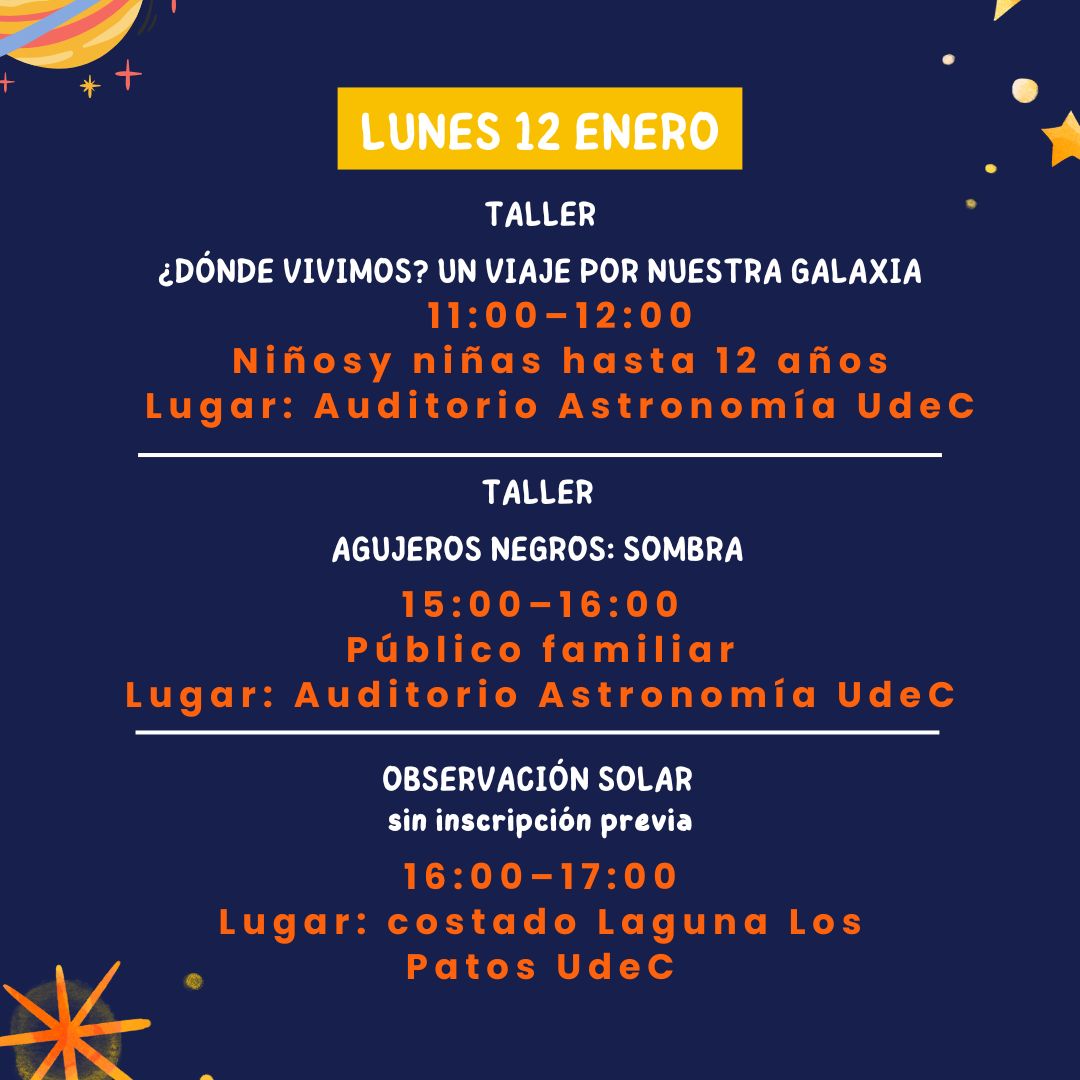
|
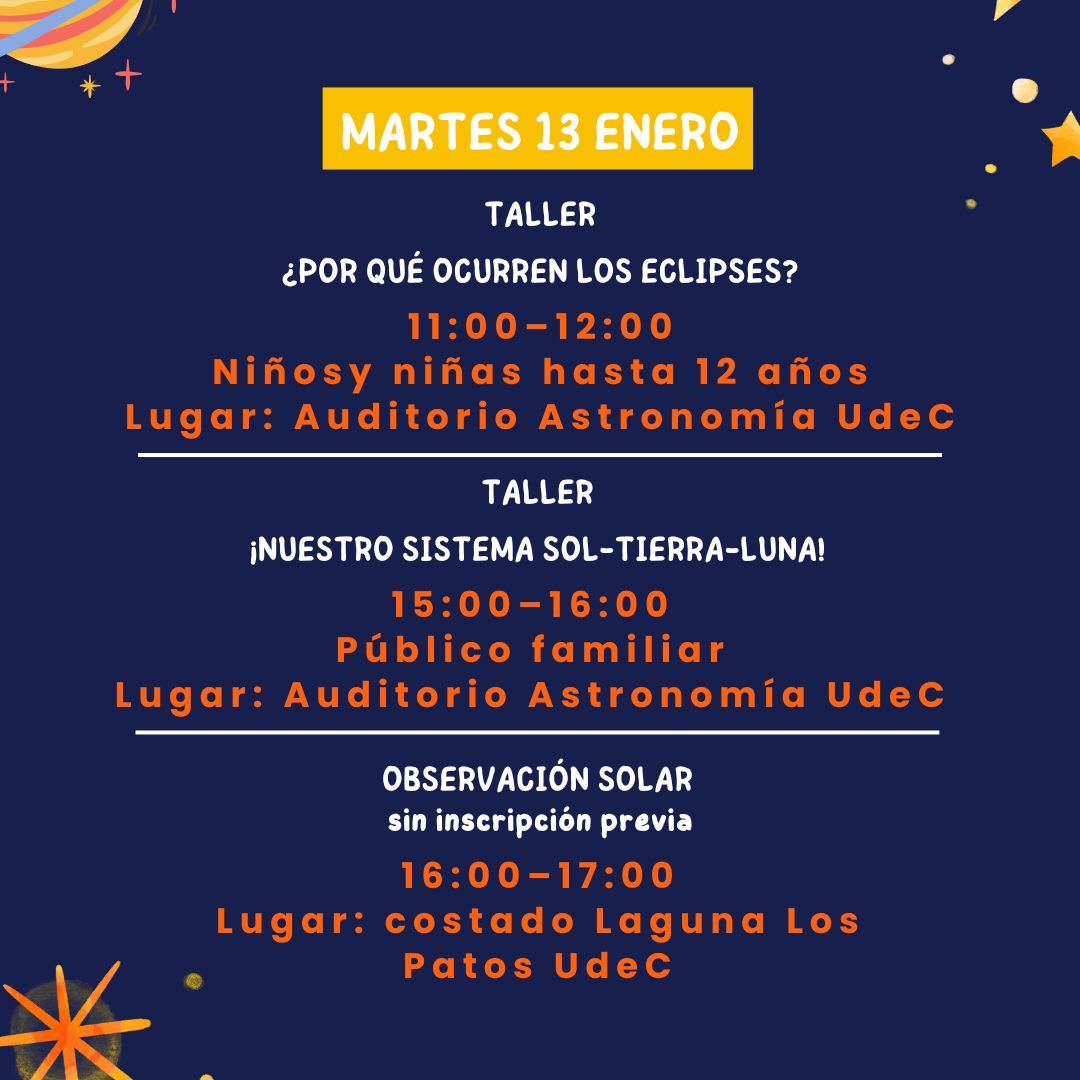
|
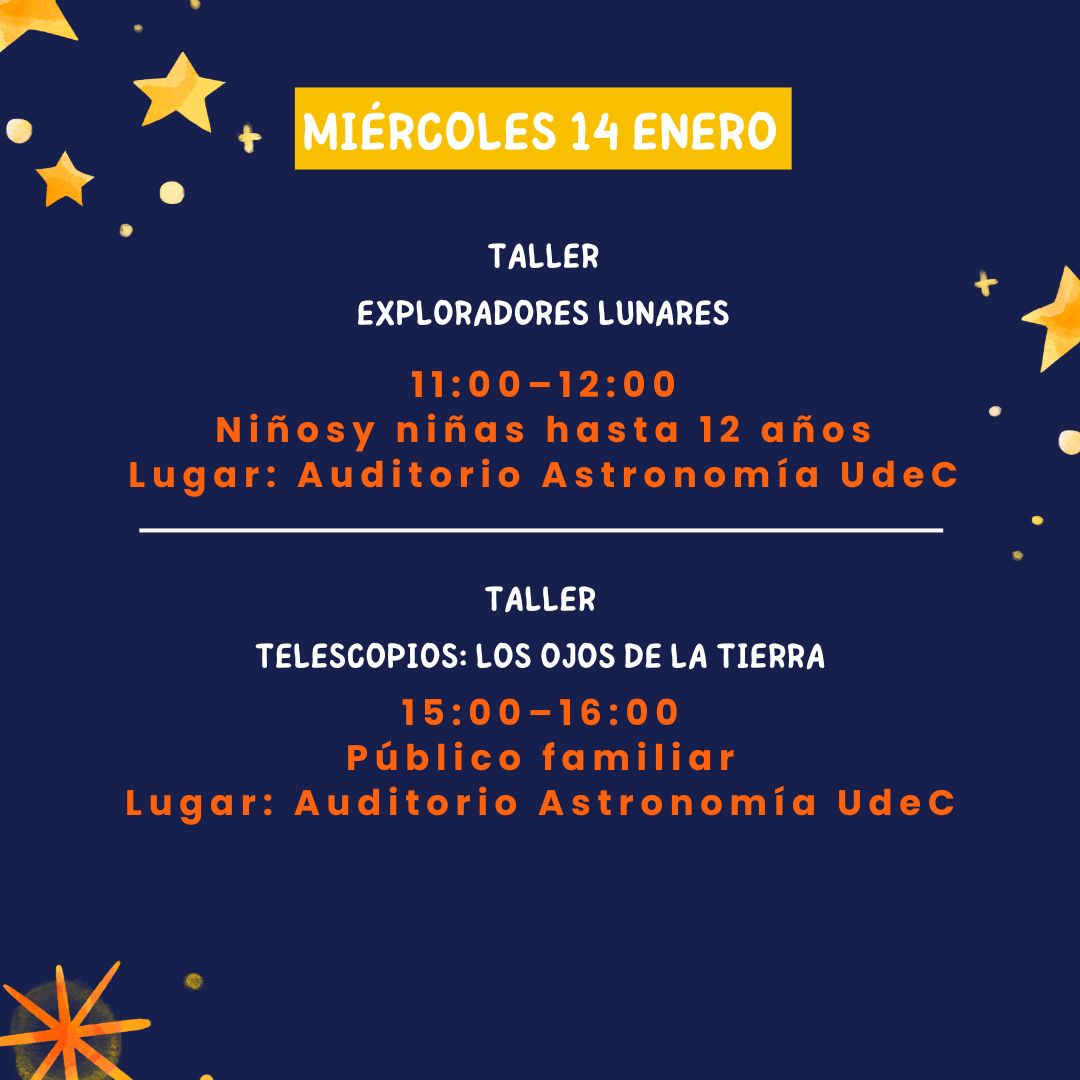
|
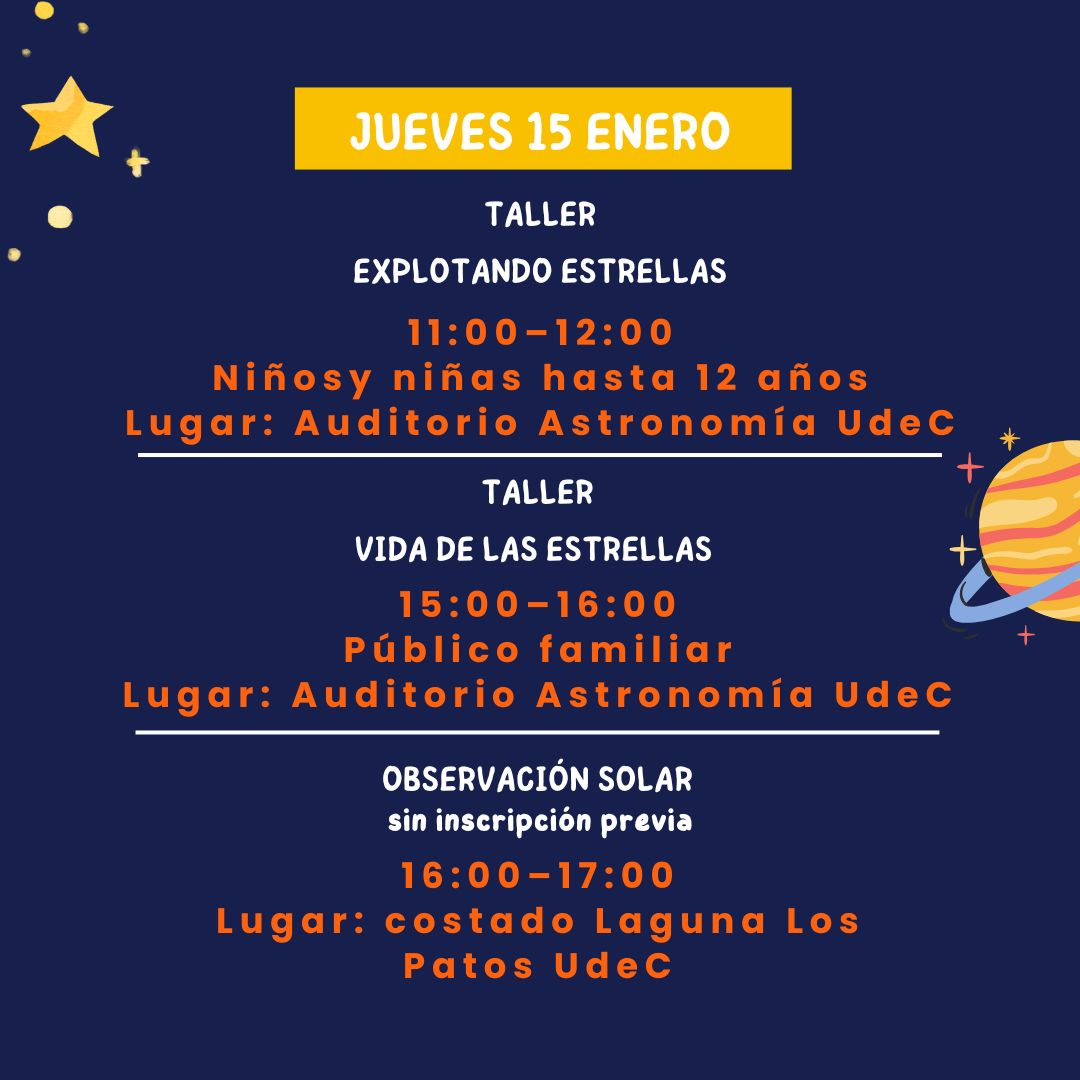
|
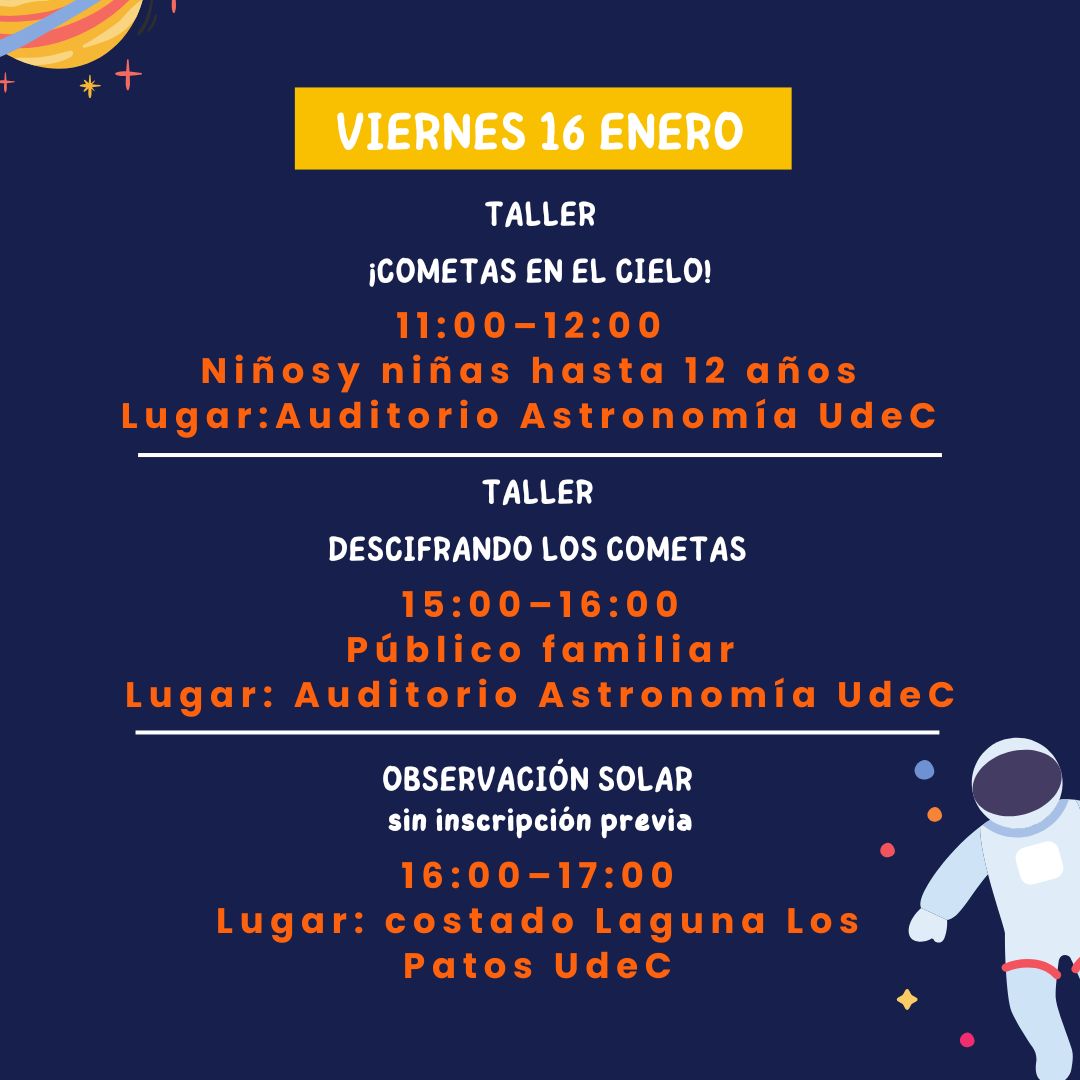
|
Department of Astronomy Communications
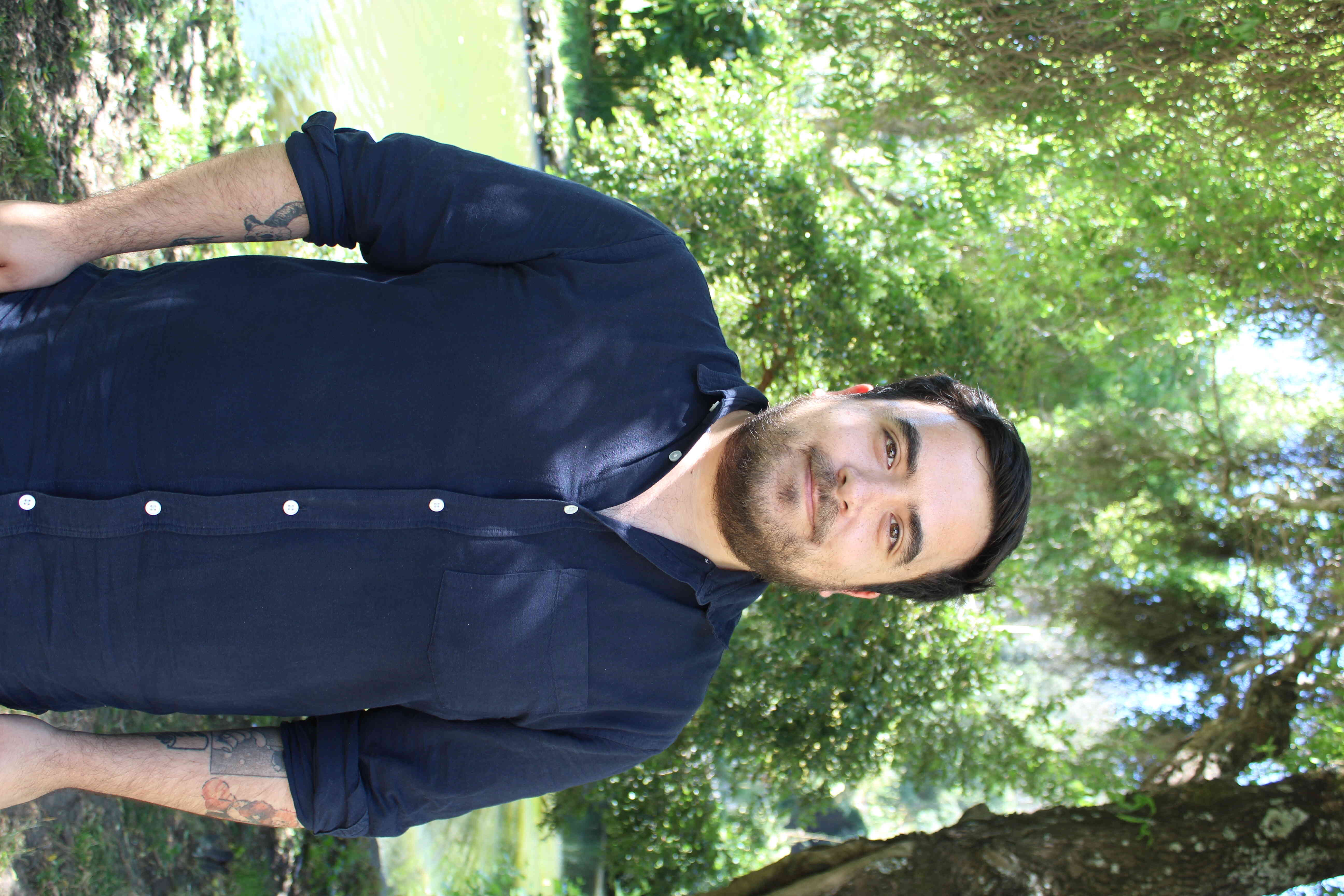
Concepcion, 12 December 2025
UdeC Researcher Returns from Scotland to Strengthen International Collaboration in Star Formation
Astronomer Dr. Rodrigo Álvarez-Gutiérrez, a graduate of the PhD in Physics with a specialisation in Astronomy at the University of Concepción, completed under the supervision of Dr. Amy Stutz, principal investigator at CATA, returned this December to the Department of Astronomy in the University of Concepcion (UdeC). This academic visit is focused on supporting ongoing research and strengthening ties between Rodrigo’s current institution, the University of St Andrews in Scotland, and the star formation group at UdeC.
Rodrigo, who since January 2025 has been undertaking a postdoctoral position at the prestigious St Andrews Centre for Astronomy, describes this visit as “very special”, both for the opportunity to reconnect with the community where he was trained and to contribute from his new experience as a postdoctoral researcher. “Coming back feels very new to me, but now I have more tools and can support the students’ work in a more direct way,” he says.
Support for UdeC Students and Bridges with CATA
During his stay, he has been working closely with Dr. Amy Stutz and with Master’s and PhD students involved in CATA-funded projects. Although his postdoctoral position in Scotland is not formally linked to the centre, he received strong support from CATA during his doctoral studies, and his experience in analysing data from ALMA and APEX, among other, has now made him a key collaborator in research on star-forming regions.
“I am a co-author on several of the group’s papers and am directly involved in the techniques being used. This allows us to study how the properties of gas in stellar regions affect the formation of new stars,” he explains.
For Rodrigo, this visit helps to strengthen the bridge between his current career path and the UdeC–CATA scientific ecosystem: “Amy’s group has been producing results of international relevance, and my intention is to remain connected and to contribute from abroad,” he says.
Pioneering Research in Massive Star Formation
His research line at St Andrews focuses on the study of massive protostars and so-called accretion events, a phenomenon whose investigation at a global level is relatively recent.
“The field is only about ten years old. There is still very little information, and our project aims to determine how frequent these events are, under what conditions they occur, and how they affect the final formation of the star,” he notes. The team uses high-resolution observations with ALMA to characterise these systems and to contribute to more accurate models of star formation.
UdeC–St Andrews Collaboration: New Projects and Opportunities for Students
Among their most recent projects, Rodrigo and Professor Amy are developing a study of the magnetic field in a star-forming region, where they suspect that this field may be inducing a rotation that inhibits the formation of new stars. To advance this research, they have been awarded observing time on the IRAM 30-metre radio telescope at Pico Veleta, Spain. Two PhD students from St Andrews will take part in these observations between January and February, with the aim of extending these opportunities to UdeC students as well.
“We want there to be mobility, joint work, and co-authorships. In fact, UdeC PhD student Nicolás Sandoval and former Master’s student Javiera Salinas recently visited St Andrews, where they presented their work and held research meetings with my group. That is exactly what we want to encourage,” he emphasises.
In addition, Rodrigo is already co-supervising a student from the UdeC Master’s programme in Astronomy and plans to open up new thesis opportunities between both institutions, fostering collaboration in order to develop more comprehensive research by complementing the analyses carried out by both groups.

Living and Conducting Research in Scotland: Challenges and Lessons Learned
Settling in Scotland was not without its challenges. “I arrived in the middle of winter, with sub-zero temperatures and sunsets at four in the afternoon. It was a very abrupt change,” he recalls. He lives in the town of Dundee, from where he travels nearly an hour each day to St Andrews. “Sometimes the bridge is closed due to strong winds, which makes the whole journey longer, but I’ve got used to it now,” he says with a laugh.
Over time, however, the experience has become enriching both academically and personally. “My mentor, Dr Claudia Cyganowski, and her team are very open, and the project I am working on is unique of its kind. I know it will have a significant impact on my career.”
Even so, he acknowledges that he misses Concepción: “The climate, the friends, the academic environment… coming back always does me good.”
Looking Ahead
His postdoctoral contract runs until 2028, a period during which he hopes to consolidate this bridge between Chile and Scotland. “I want to maintain and strengthen collaborations with UdeC, and for more students to benefit from international connections. The idea is that, by the time my postdoctoral position ends, an established relationship will exist between both universities.”
His visit to Concepción, which runs until 12 December, has provided an opportunity to make progress on projects, support thesis work, and strengthen a collaboration that promises to continue growing.
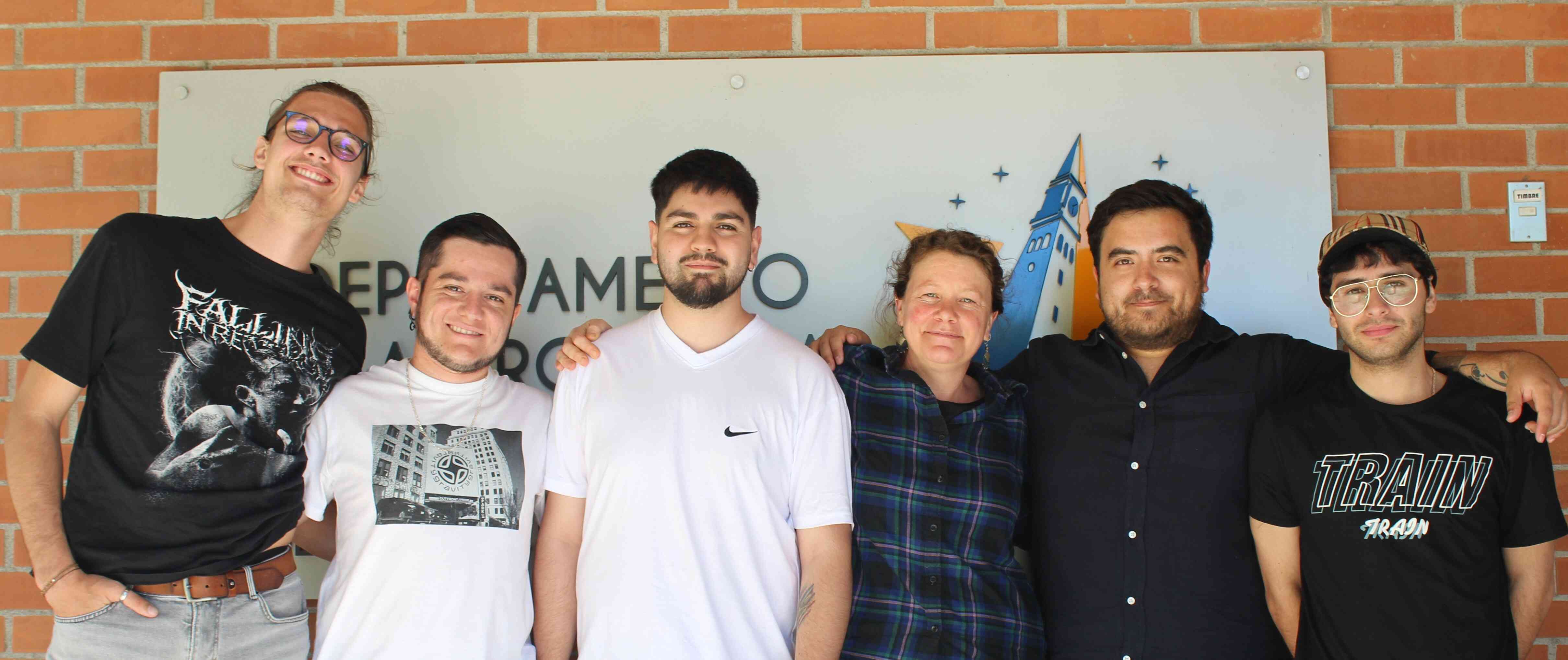
|
Department of Astronomy Communications
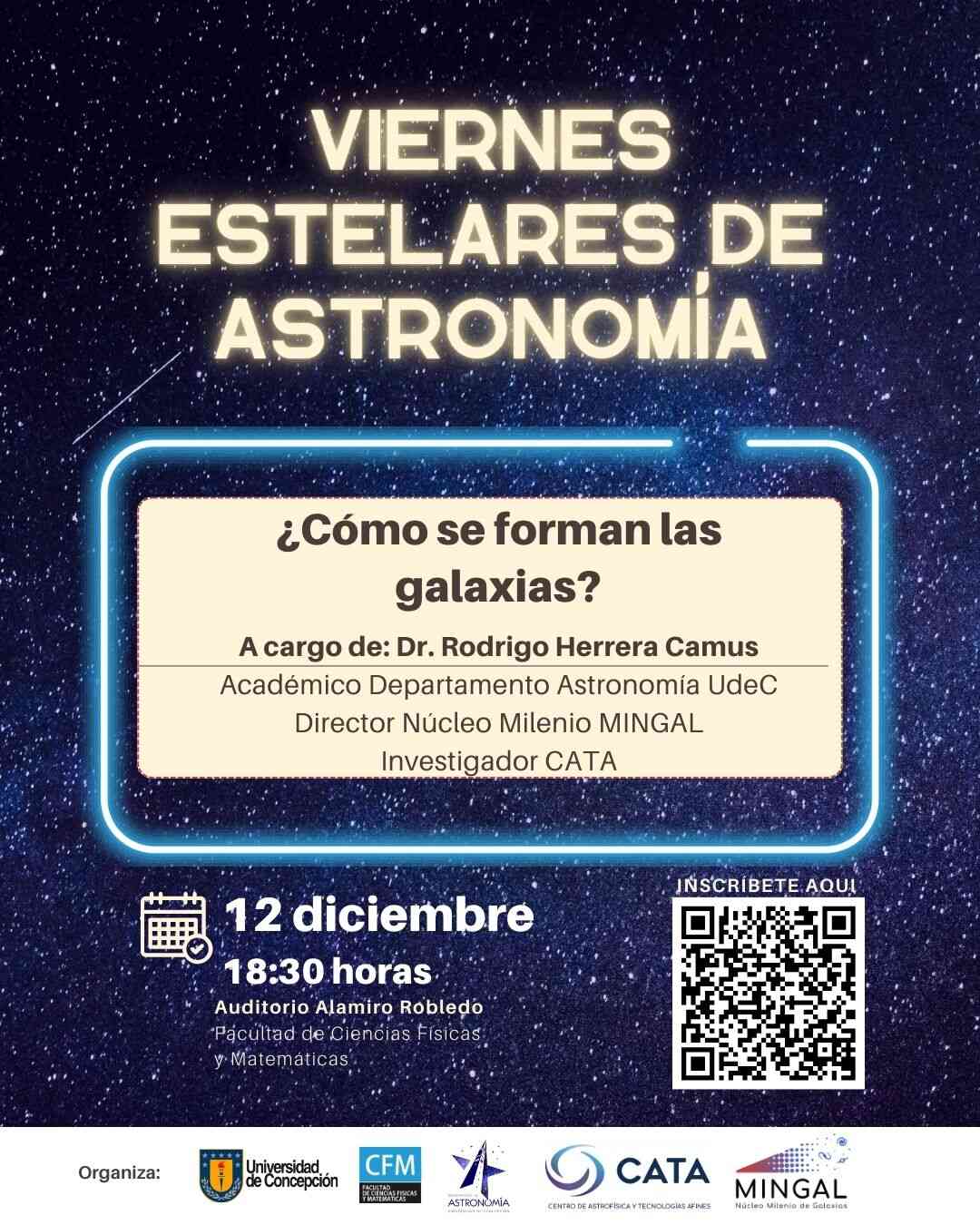
Concepcion, 10 December 2025
Final Stellar Fridays Talk of 2025 Invites the Public to Explore How Galaxies Form
The UdeC Department of Astronomy is closing the year with a new edition of Stellar Fridays, a classic science outreach series open to the entire community. To conclude the 2025 season, Dr Rodrigo Herrera Camus, UdeC academic, director of the Millennium Nucleus MINGAL, and CATA researcher, invites us to explore how the galaxies that fill the Universe today were formed.
How did the Universe go from the chaos that followed the Big Bang to a landscape filled with galaxies? In this talk, we will explore how the first galaxies emerged and how they grew and evolved into the Universe we know today. Using observations from telescopes such as ALMA and the JWST, we will look at key processes including star formation, gas accretion, and galaxy mergers.
In addition to offering an up-to-date perspective on how galaxies are built and evolve, this talk aims to bring astronomy closer to people of all ages and interests. Stellar Fridays has established itself as a meeting space between the community and the research carried out at UdeC, promoting curiosity, critical thinking, and a sense of connection with the Universe we inhabit.
Date: Friday, December 12
Time: 18:30
Venue: Alamiro Robledo Auditorium, Faculty of Physical and
Mathematical Sciences, UdeC
Registration: Link
For more information: departamento.astronomia@gmail.com
Department of Astronomy Communications
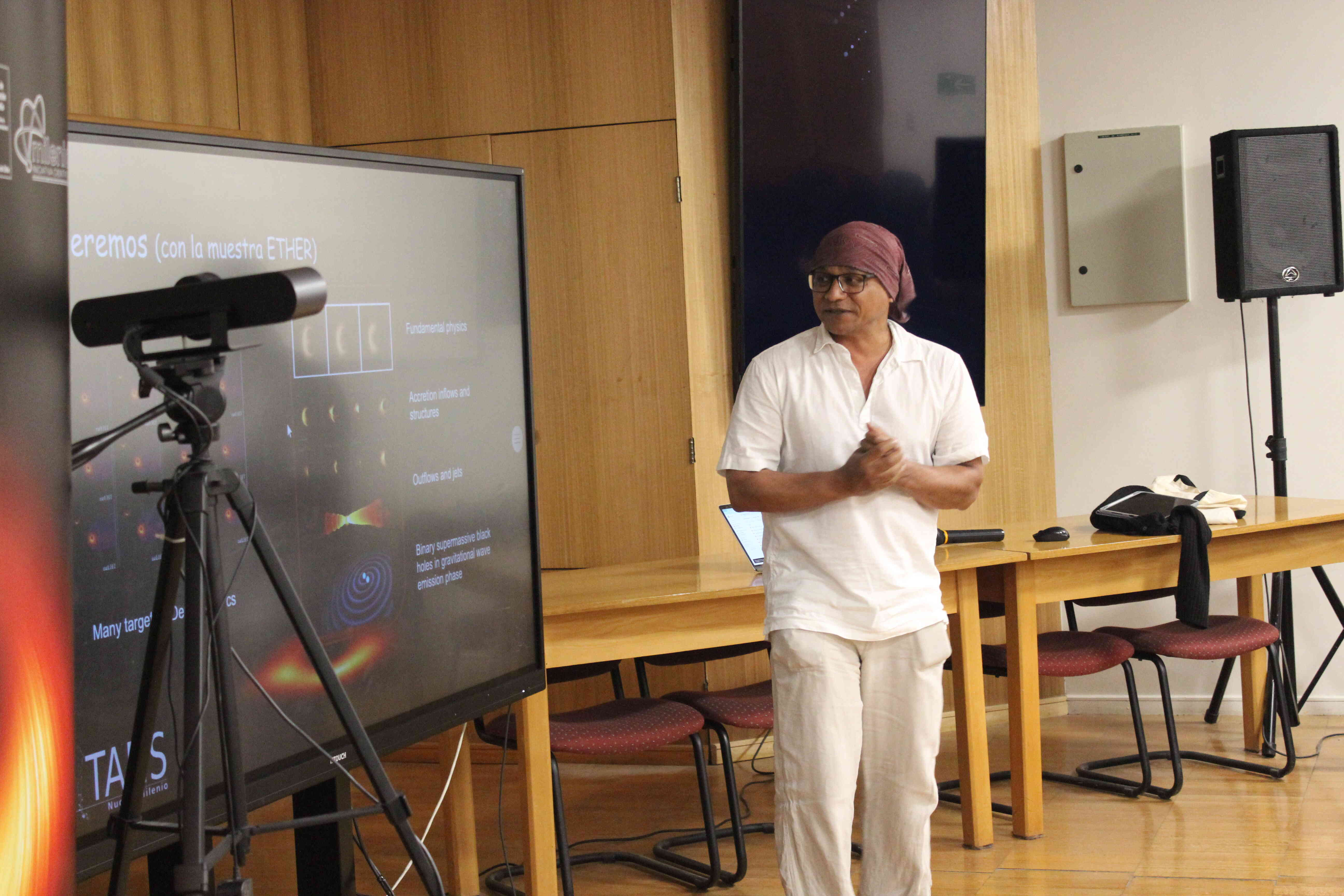
Concepcion, 8 December 2025
UdeC Hosted the Latin American Congress on Extragalactic Astronomy
Between 2 and 3 December, the Department of Astronomy of University of Concepcion (UdeC) served as one of the hosts for the Latin American Congress on Extragalactic Astronomy (CLASTROex), an event that brought together students and academics from various countries to introduce extragalactic astrophysics to new generations.
The initiative, organised by students from the Millennium Nucleus of Galaxies (MINGAL) and the Millennium Nucleus TITANS, together with peers from Venezuela, brought participants together in a hybrid format, with in-person hubs and streaming connections. The aim was to create a space for interaction, collaboration, and training for undergraduate and postgraduate students in astronomy, physics, and related fields, as well as early-career researchers and professionals beginning their work in areas such as galaxy evolution, cosmology, the use of radio telescopes, instrumentation, and the analysis of astronomical data.
The idea for CLASTROEx emerged during the launch of the MINGAL Nucleus, when the students proposed organising an international activity led by themselves. “I thought: why not do something between Chile and Venezuela?” explains Jocabed Martínez López, a PhD student in Physical Sciences with a specialisation in Astronomy at the University of Concepción and a member of MINGAL. “Then the conversations grew, more students from different countries joined in, and it became a Latin American congress. We wanted to talk about galaxies, about supermassive black holes, and to create a space that truly belonged to us,” she says.
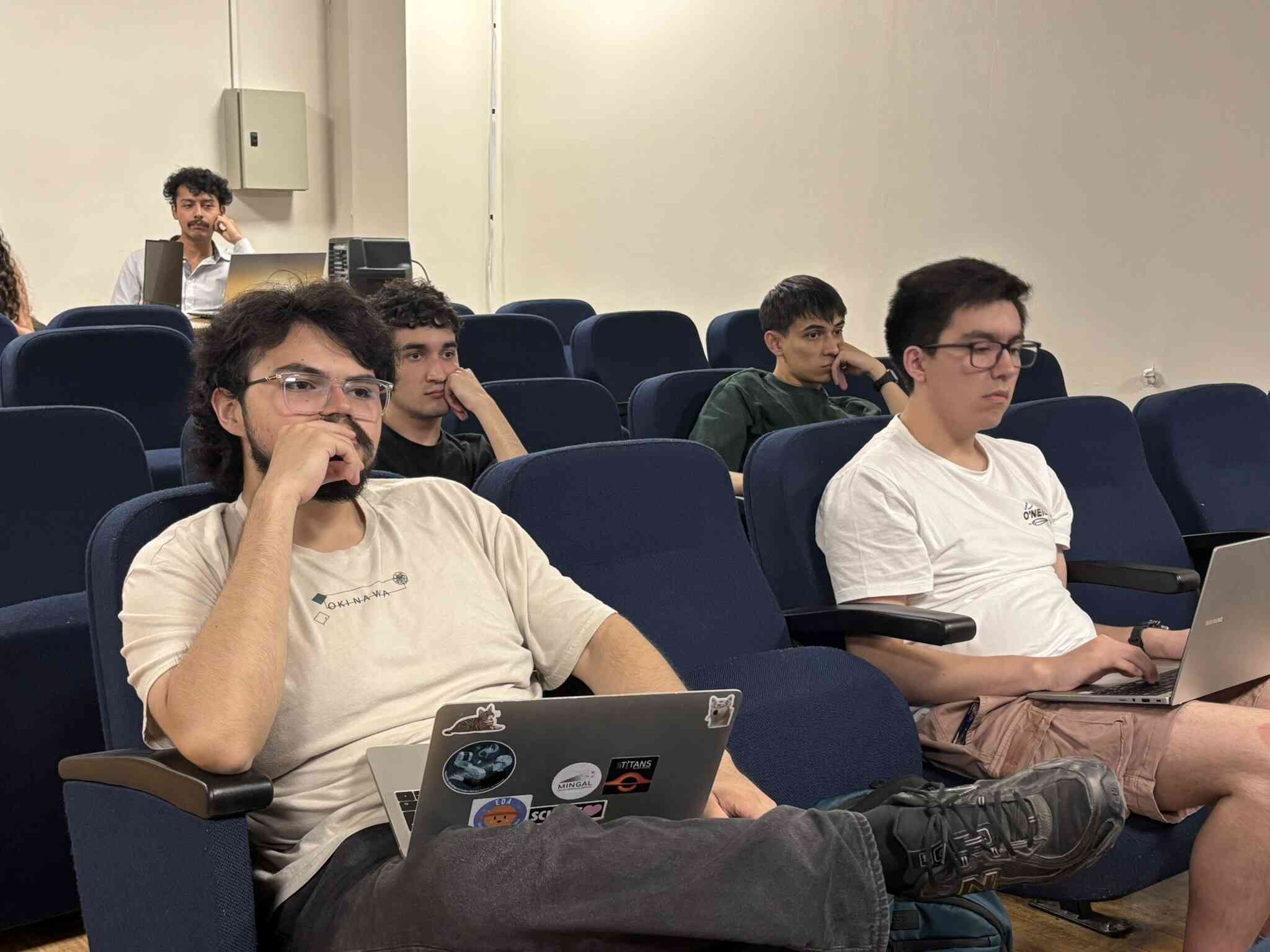
The first day featured talks by academics and students connected from Chile, Venezuela, Mexico, Australia, and Germany. For Martínez, this diversity defined the spirit of the meeting: “Feeling that connection between places so different, all researching galaxies, was very inspiring. It has been a wonderful experience for those of us who are just beginning our scientific careers.”
The academic from the UdeC Department of Astronomy and director of MINGAL, Dr Rodrigo Herrera-Camus, highlighted the leading role of the students in the organisation. “This initiative was born in our first meetings as a nucleus, as we considered how to contribute to the community through science, training, and the development of new generations,” he said, adding that “the congress is led by students, who are the heart of this event, and that makes it especially valuable.”
The programme also offered training spaces, oral presentations, and collaborative activities between scientific groups, reflecting the integrative nature of CLASTROEx and its aim to remove geographical barriers. Participating institutions included the University of Concepcion, the Federico Santa María Technical University, and the Austral University of Chile, while Venezuela was represented by the Central University and the University of the Andes.
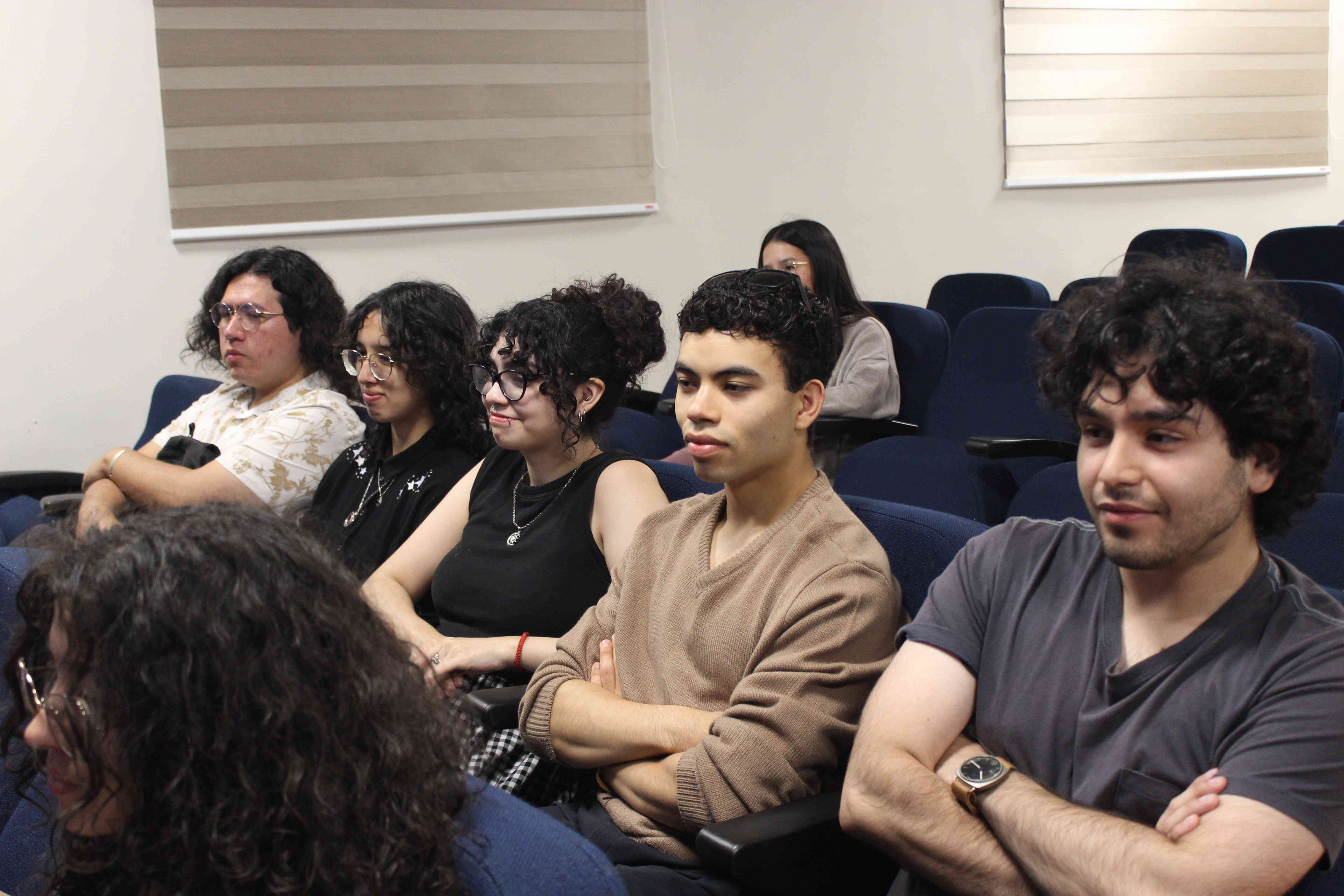
|
Department of Astronomy Communications
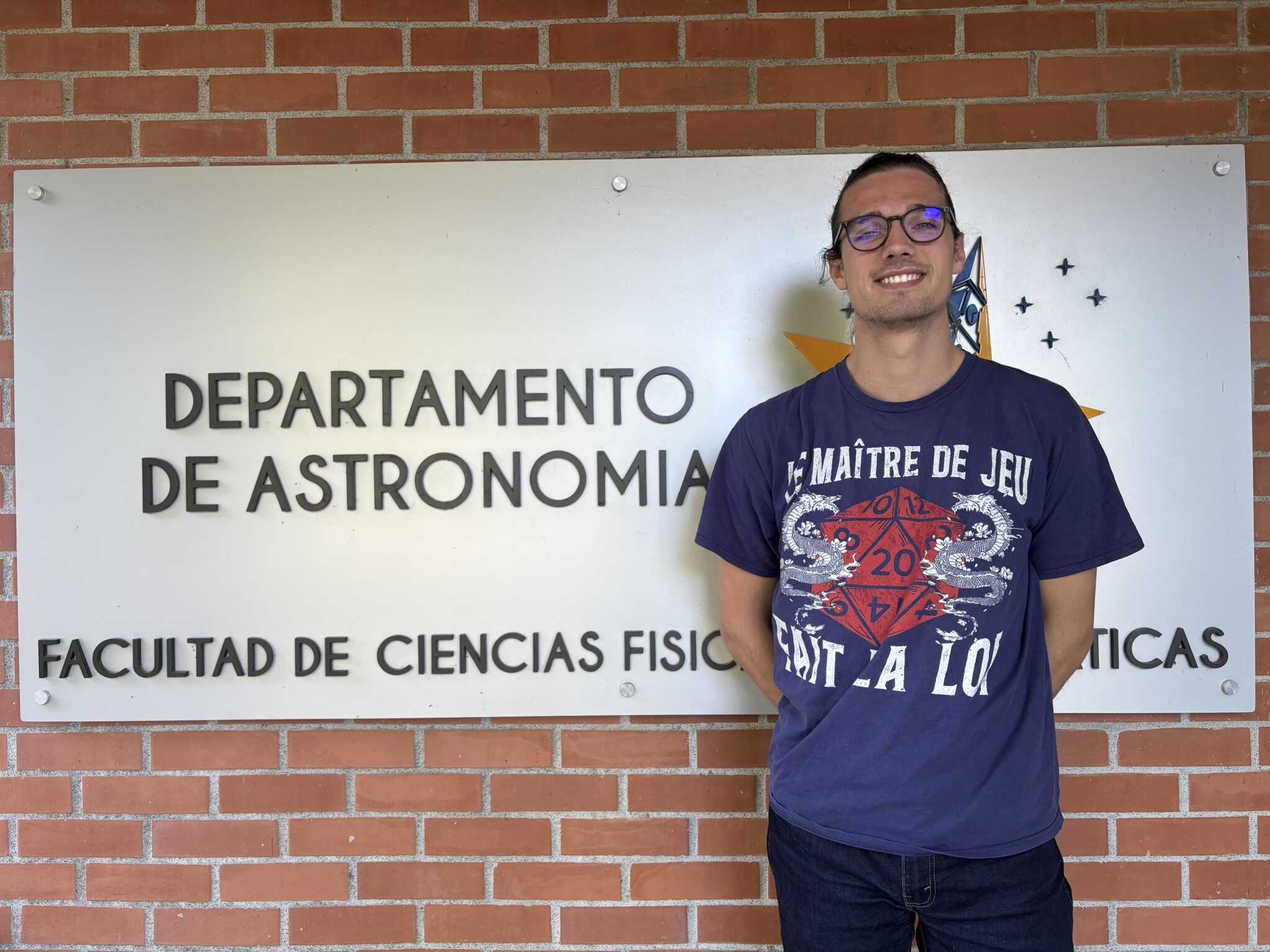
Concepcion, 2 December 2025
PhD Student from the University of Grenoble, France, Visits the Department of Astronomy to Advance Research in Massive Star Formation
Romeo Veyry, a PhD student in Star Formation at the Université Grenoble Alpes (UGA), is visiting the Department of Astronomy of the University of Concepcion (UdeC) until December 6. His stay, carried out in collaboration with the team of Dr. Amelia Stutz, principal investigator at the Center for Astrophysics and Associated Technologies (CATA), is part of one of today’s major challenges in astrophysics: understanding how massive stars form and how the dense gas that gives rise to them is structured.
Originally from France, Romeo has a strong academic background, holding two master’s degrees—one in condensed matter physics and another in astrophysics—from the Université Grenoble Alpes. He arrived in Chile in early November and is currently pursuing his PhD under the supervision of distinguished researcher Dr. Frédérique Motte, a leading international expert in high-mass star formation.
In this context, Romeo is visiting Concepción to work closely with Dr. Amelia Stutz’s team on the kinematic analysis of molecular gas and the study of diazenylium (N₂H⁺), a key tracer of filaments and large-scale structures in star-forming regions. His stay will allow him to deepen his expertise in these methodologies and advance the development of his doctoral research.
In this interview, Romeo shares more about his background, his experience visiting Chile for the first time, and the work he is conducting with the Star and Planet Formation team at CATA in Astronomy UdeC.
What is your area of specialization, and what motivated you to choose this field?
I specialize in massive star formation, more specifically in the kinematics of the regions where these stars are born. I fell in love with astrophysics when I was a child, and working in this field has always been a dream of mine. My motivation to study star formation came during my courses on the subject. I’ve always found it fascinating that stars—objects that are fundamental building blocks of our universe—are still not fully understood, especially the formation process of the most massive ones.
Is this your first time in Chile? How has your experience in our country been so far?
Yes, this is my first time in Chile. My experience has been excellent so far; people have been very kind despite my level of Spanish. They’re some of the most welcoming people I’ve ever met.
How did your collaboration with Professor Amelia Stutz begin?
Amelia Stutz and her team are part of the ALMA-IMF program consortium. This large program is led by Principal Investigator Frédérique Motte, who is also my PhD supervisor. Since I am the only person in Grenoble working on the kinematics of massive star formation, I needed the expertise of Professor Stutz and her team.
What is the main objective of your stay in Chile, and why is it scientifically relevant to your research?
The main objective of my stay is to work closely with Professor Stutz’s team to develop my method for determining the column density of the diazenylium molecule across all ALMA-IMF regions. This molecule has been extensively studied by the team, and I need their expertise on the subject. I also need to reduce a significant amount of data, and the team has the expertise to teach me how to do it.
Diazenylium (N₂H⁺) is a very interesting molecule that traces the presence of large-scale filaments and forms within the dense gas of massive star-forming regions. Studying this molecule and its kinematics helps us understand the mechanisms driving large-scale massive star formation. Column density is a key parameter for studying kinematics, so my work here in Chile focuses on developing a code to derive the diazenylium column density in the ALMA-IMF regions.
What challenges does the interpretation of ALMA data present when studying massive star-forming regions?
In many cases, the study of molecular lines in spectral data involves molecules that display only a single line at a given frequency. In the case of diazenylium, what makes it both interesting and challenging is that it is a hyperfine multiplet: several blended lines that produce a spectrum that is very rich but also quite complex.
What progress do you hope to make during your stay?
I hope to gain the team’s expertise in reducing ALMA data using the ALMA-IMF pipeline. I also aim to complete the analysis of the diazenylium column-density maps across all ALMA-IMF regions.
Do you plan to continue this collaboration in the long term after your visit?
Of course. This team is truly excellent to work with, and I hope to continue collaborating with them in my future projects.
Department of Astronomy Communications
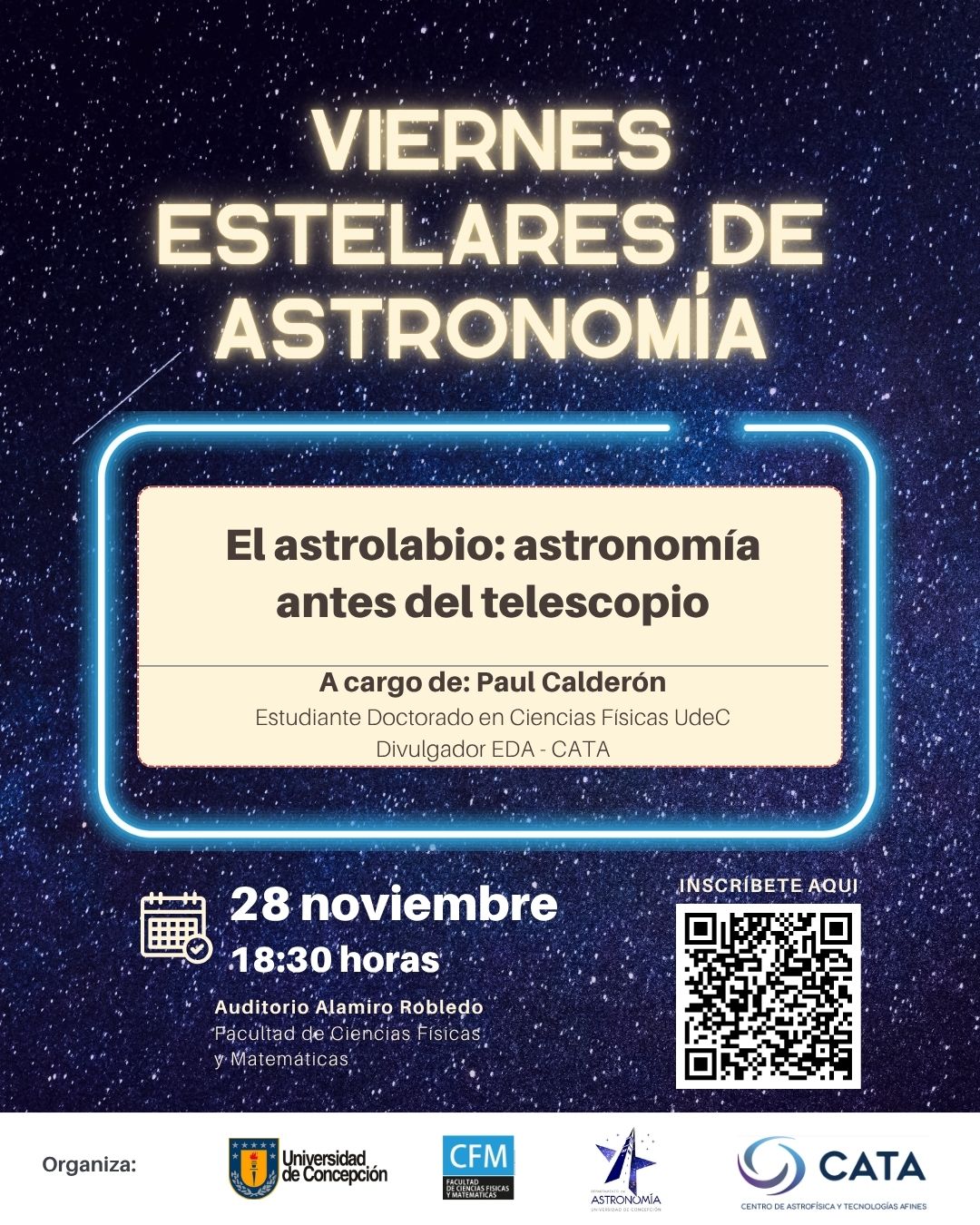
Concepcion, 26 November 2025
Stellar Fridays presents: “The Astrolabe: Astronomy Before the Telescope”
The Department of Astronomy at the University of Concepción (UdeC) invites the community to a new edition of Stellar Fridays, the traditional series of public science outreach talks. On this occasion, the speaker will be Paul Calderón, a PhD student in Physical Sciences at UdeC and CATA science communicator, who will present the talk “The Astrolabe: Astronomy Before the Telescope.”
Paul emphasizes the importance of spaces like Stellar Fridays for fostering people’s eagerness to learn. “Our curiosity is inseparably tied to science, whether for something as fundamental as our own survival or for understanding the deeper aspects of our origins, nature, and destiny. Science outreach is the bridge that transforms abstract theoretical and mathematical concepts into a shared human experience, democratizing access to knowledge,” the speaker notes.
The astrolabe is one of the most iconic instruments in the history of astronomy. Used from antiquity through the Renaissance, it allowed astronomers to measure the height of celestial objects above the horizon, determine the time, and solve problems of geographic positioning. Its origins date back to classical Greece, but it was refined by Islamic astronomers in the Middle Ages, who transformed it into an essential tool for observing the sky. Before the invention of the telescope, the astrolabe represented the pinnacle of technical knowledge applied to astronomy, and its use reflects the deep connection between science, art, and culture.
Event Information
Speaker: Paul Calderón, PhD student in Physical Sciences at
UdeC and EDA–CATA science communicator
Talk title: “The Astrolabe: Astronomy Before the
Telescope”
Date: Friday, November 28
Time: 18:30
Venue: Alamiro Robledo Auditorium, Faculty of Physical and
Mathematical Sciences, UdeC
Registration: Link
For more information: departamento.astronomia@gmail.com
Department of Astronomy Communications
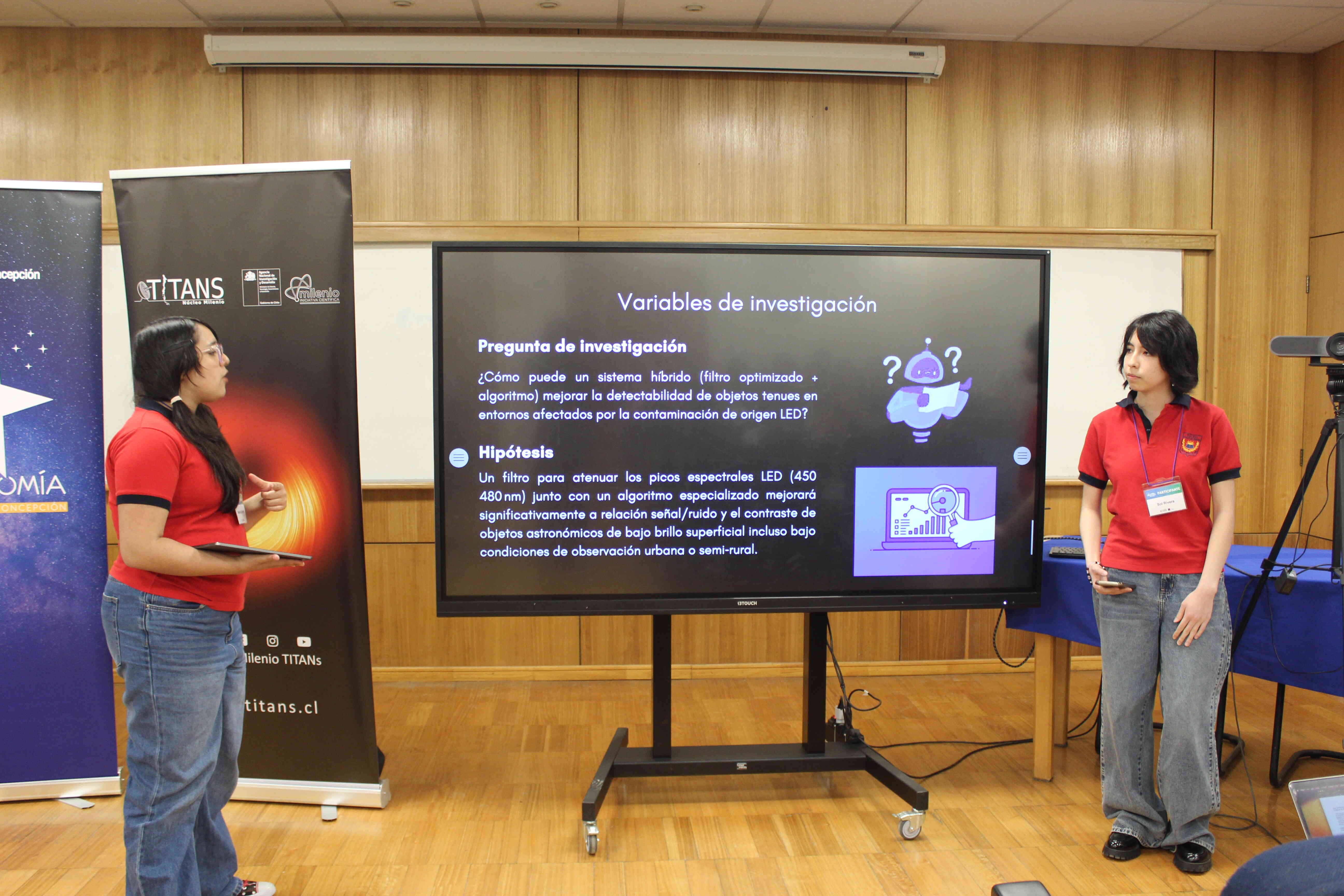
Concepcion, 24 November 2025
School Science in Action: This Was the Experience of the 13th School Astronomy Congress at UdeC
The initiative brought together high school students from different regions of the country on November 21 at the Faculty of Physical and Mathematical Sciences, for a day dedicated to research, scientific curiosity, and astronomical outreach.
Organized by the Millennium Nucleus TITANS in collaboration with the Department of Astronomy from the University of Concepcion (UdeC), the congress brought together 10 teams from Santiago, Concepcion, San Nicolas, Villarrica, San Carlos, Constitucion, Valdivia, Valparaiso, Tome, and Arica. Over several months, these groups developed projects guided by a teacher and supported by young researchers from the Nucleus, culminating in the presentation of their results before a specialized jury.
The goal of this congress is to bring scientific research closer to the community and to promote the sharing of astronomical knowledge among new generations. The presentations covered a wide range of topics, from the Andean worldview of the southern skies to the development of optical systems designed to mitigate light pollution in astronomical observations.
Pamela Henríquez, coordinator of the School Astronomy Congress, highlighted the motivation of the participating groups. “It is exciting to see the teams present today, knowing all the effort behind their work. Many hours of preparation with their supervising teacher—most of the time outside school hours, traveling from other regions to get here. Each team shows a sense of responsibility and commitment in putting together a solid project following the scientific method and working collaboratively. Today, the students had the opportunity to show their peers and the jury all that effort. From their presentations, you can tell they truly enjoyed the entire process,” Pamela noted.

For the participants, the day was as challenging as it was inspiring. Montserrat Pardo, from Kent School in Santiago and a member of the team “Echoes of the Universe: Listening to the Infinite from the Big Bang to the Stars,” expressed her enthusiasm for the event. “We’ve had an amazing time. It has been an experience in which we’ve truly learned so much, not only through our own project, but also through the work of others. I think everything they are doing is very interesting, and learning from our peers is something I find incredibly valuable and meaningful,” the student commented.
The winners on this occasion were:
1st place:
“Learning Through Play: Creating an RPG Video Game to Enhance Understanding of Supermassive Black Holes,” Mauro García Rojas and Mariano Jofré Parra, teacher Andrés Freire Contreras, Constitución, Maule Region.
2nd place:
“Echoes of the Universe: Listening to the Infinite from the Big Bang to the Stars,” Montserrat Pardo Figueroa and Francisca Barrera Berrios, teacher Miriam Reyes Bustamante, Metropolitana Region.
3rd place:
“Southern Skies: Andean Worldview for the World,” Javiera Delfín Álvarez and Priscila Sabando Sanhueza, teacher Eduardo Roco Avilez, Arica and Parinacota Region.
It is worth noting that the team that won first place received, as their prize, a trip to the Las Campanas Observatory, one of the most important astronomical research centers in the world. There, they will be able to see firsthand how astronomers work and gain a deeper understanding of the global significance of this observatory located in the Atacama Region.
Carol Rojas, astronomer and Head of Communications and Outreach at the Las Campanas Observatory, served as a member of the jury for the congress. “The Observatory has been part of this activity for many years because we believe it is very important to support education in the country, and especially everything related to science. It is also important for us to encourage scientific vocations. We believe that for students, the opportunity to visit a scientific observatory and see how top-level scientific research is actually conducted is extremely valuable.”
With more than a decade of history, the School Astronomy Congress has established itself as a unique space for new generations to discover scientific vocations and develop key skills for their academic and professional futures.
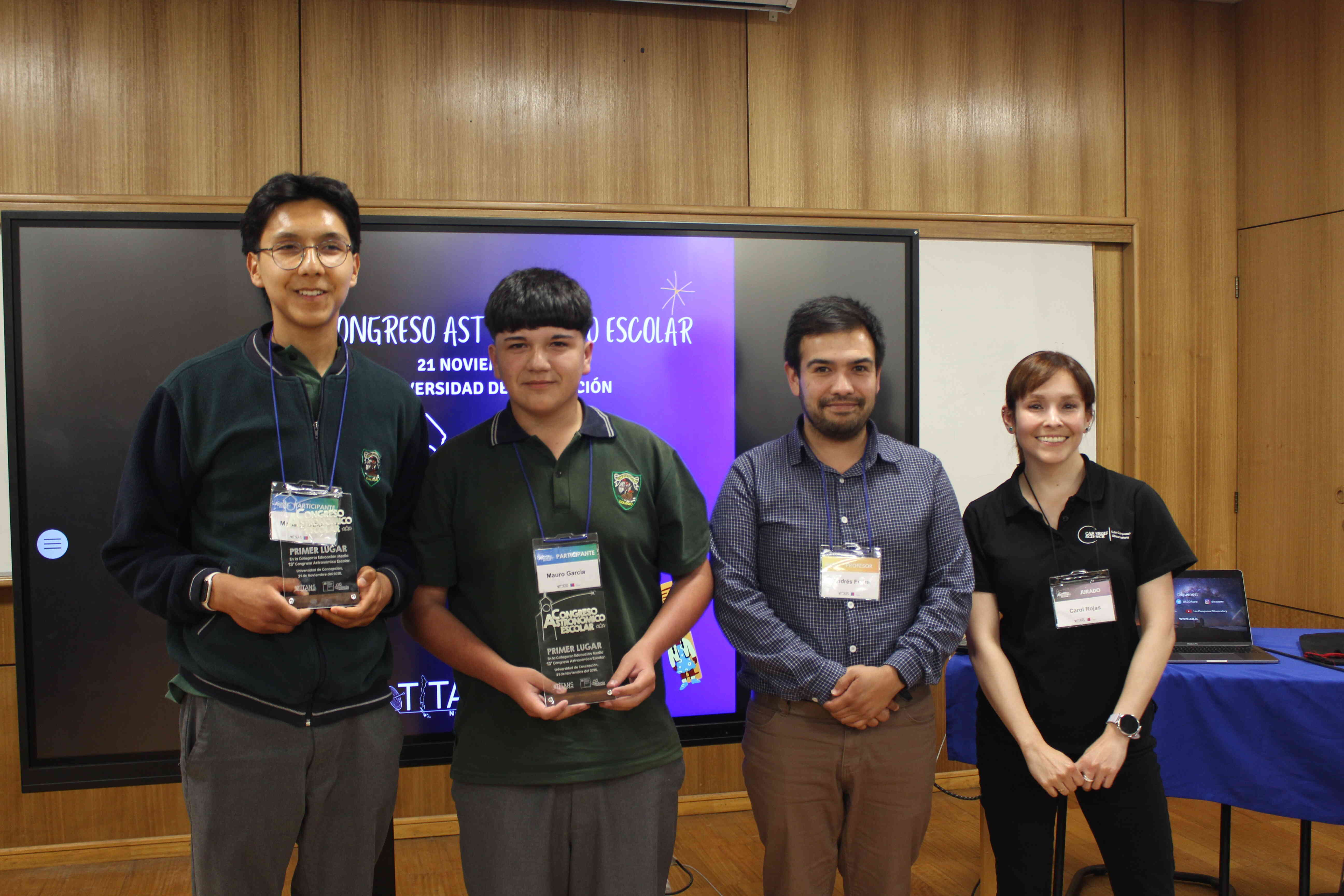
|
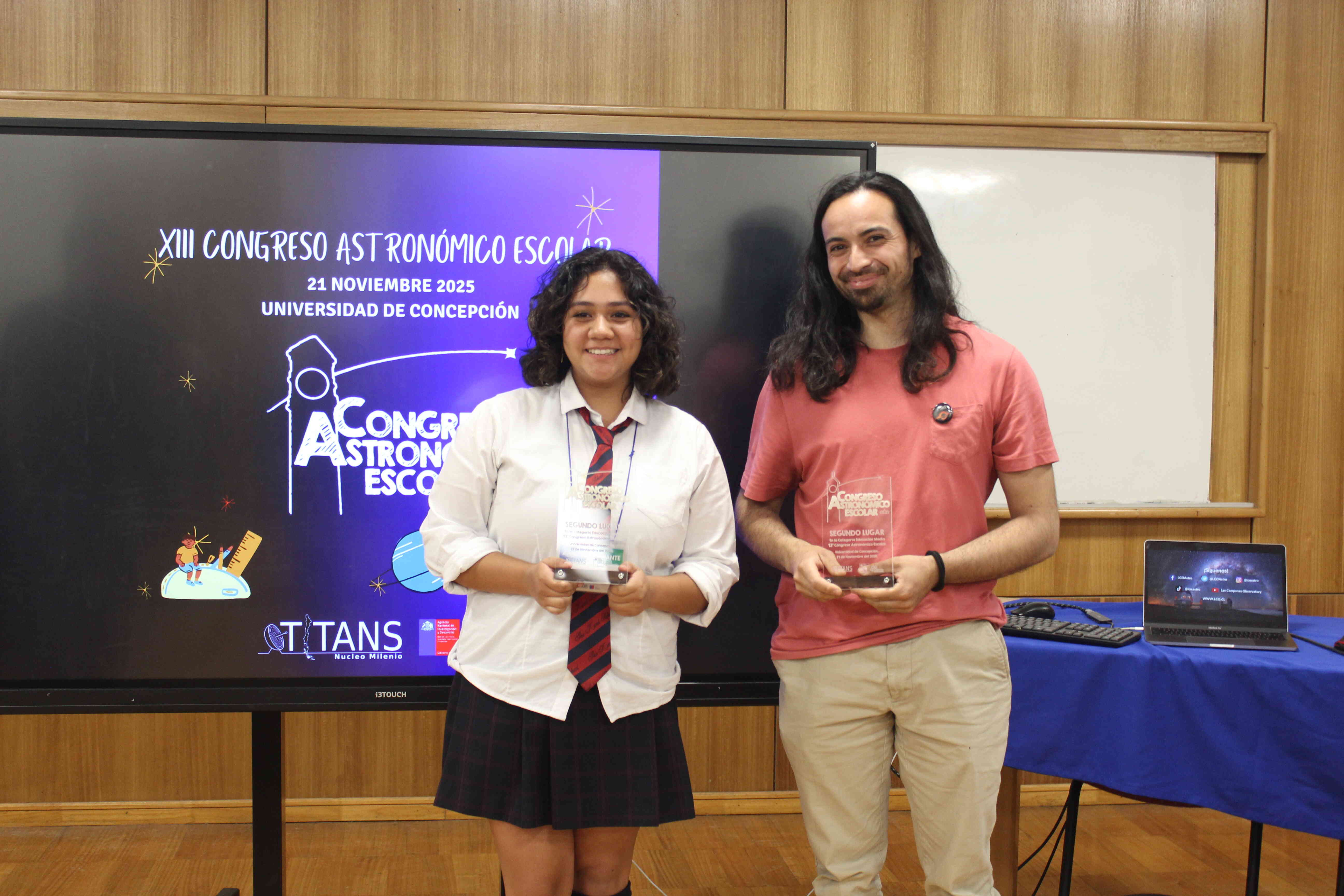
|

|
Bárbara Iraira
Journalist
Department of Astronomy UdeC
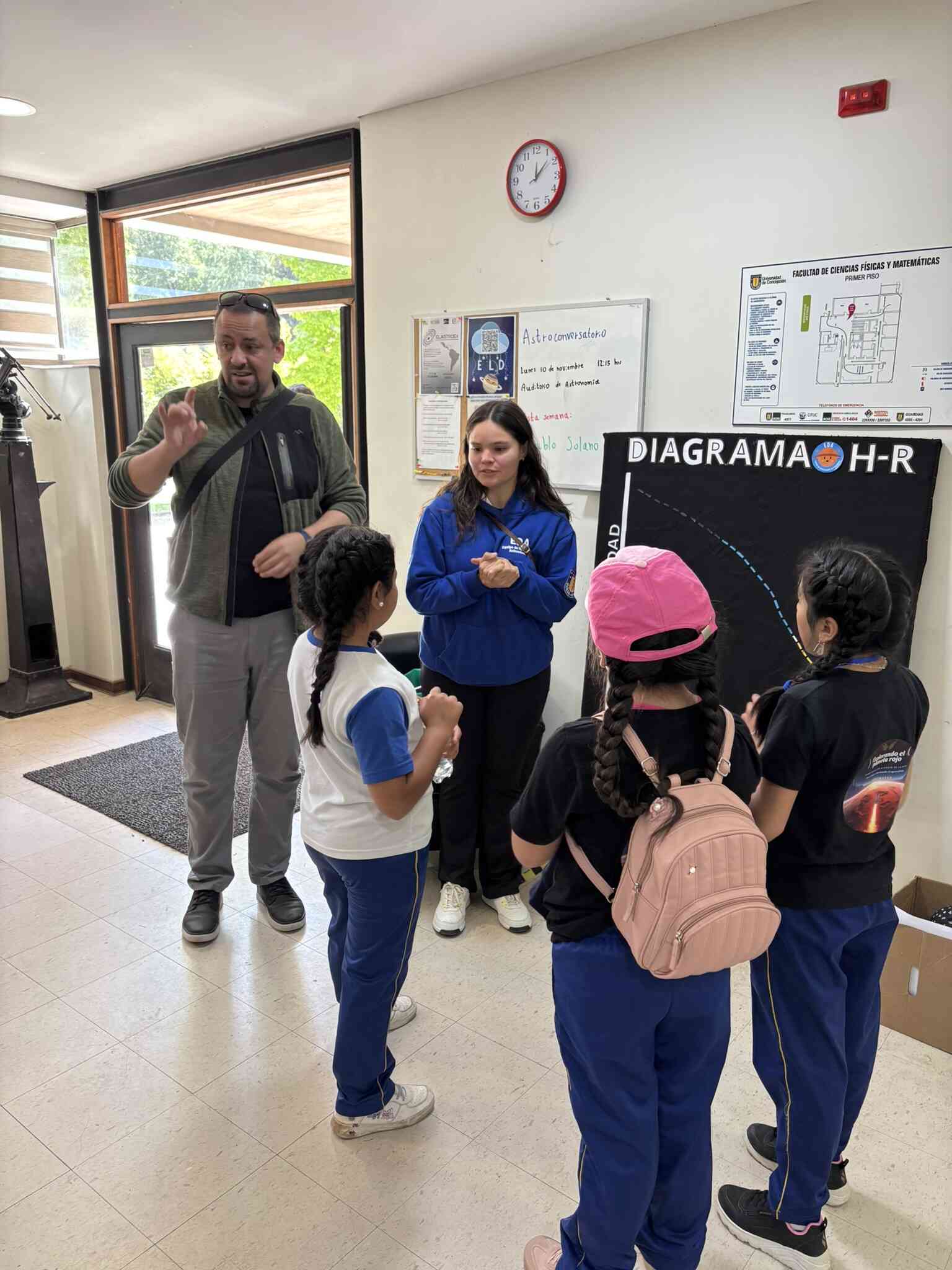
Concepcion, 14 November 2025
Astronomers from MINGAL and the Department of Astronomy Meet with Students to Learn About Their Inclusive Science Project
Fifth-grade students Ailén Rauque and Miyalen Hueico, from school Purísimo Corazón in Fresia (Los Lagos Region), visited the Department of Astronomy at the University of Concepcion (UdeC) at the invitation of the Millennium Nucleus of Galaxies (MINGAL). The visit acknowledged their project, “Connecting NASA’s advances with the classroom and promoting inclusive learning,” which was recognized by the Ministry of Science’s Explora program for its innovative approach to inclusive astronomy.
The event included the participation of sign language interpreters from Lense Biobío, MINGAL director Rodrigo Herrera-Camus, and astronomer Linda Tacconi, a senior researcher at the Nucleus and at the Max Planck Institute for Extraterrestrial Physics. Tacconi, recently awarded the Royal Astronomical Society’s 2024 Caroline Herschel Medal, was visiting Chile to meet with the Millennium’s team.
The visit began with a campus tour led by the UdeC Open Doors program, after which the students presented their project to researchers from MINGAL and the Dedoscopio project, a UdeC initiative focused on inclusive science. They then toured the CePIA Laboratory, took part in a sensory activity on the Hertzsprung–Russell diagram organized by the Astronomical Outreach Team (EDA in spanish), and concluded the morning by operating the radio astronomy antenna in the Wenulafken area.
“We invited this group of students because of their commitment to inclusive astronomy, the excellent project they presented, and their genuine enthusiasm for learning,” explained Francisca Contreras, MINGAL’s outreach coordinator. “It was truly beautiful to see Ailén teaching blind-deaf sign language to the visiting astronomer; it was a truly moving moment.”
Contreras also highlighted the group’s energy: “The girls’ enthusiasm was contagious. Teachers were very grateful that the activity was adapted to include deaf individuals, something unprecedented in the Department.” The interpreters also appreciated the experience, noting that it was the first time they had taken part in a scientific activity of this kind, setting an important precedent for accessibility in astronomical outreach.
Professor Rodrigo Herrera-Camus emphasized the importance of promoting these spaces: “When I see you, I feel that our country has a bright future. Our task as adults is to create a country where you can reach your fullest potential.”
For the students, the visit carried deep personal and academic meaning. “No one had ever learned in an inclusive way throughout their entire life. That also motivates our project,” said Ailén Rauque.
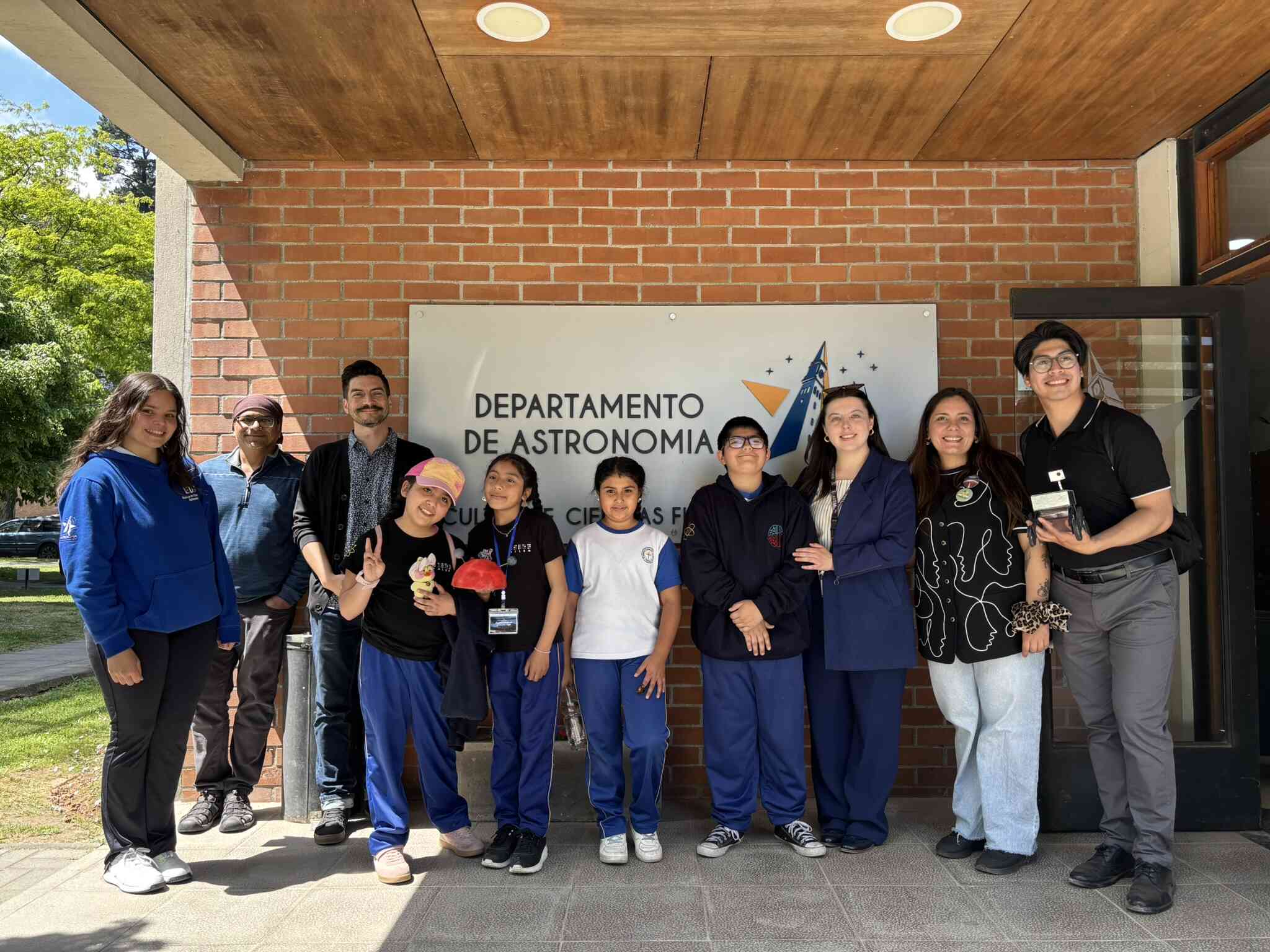
|
Millennium Nucleus of Galaxies (MINGAL)
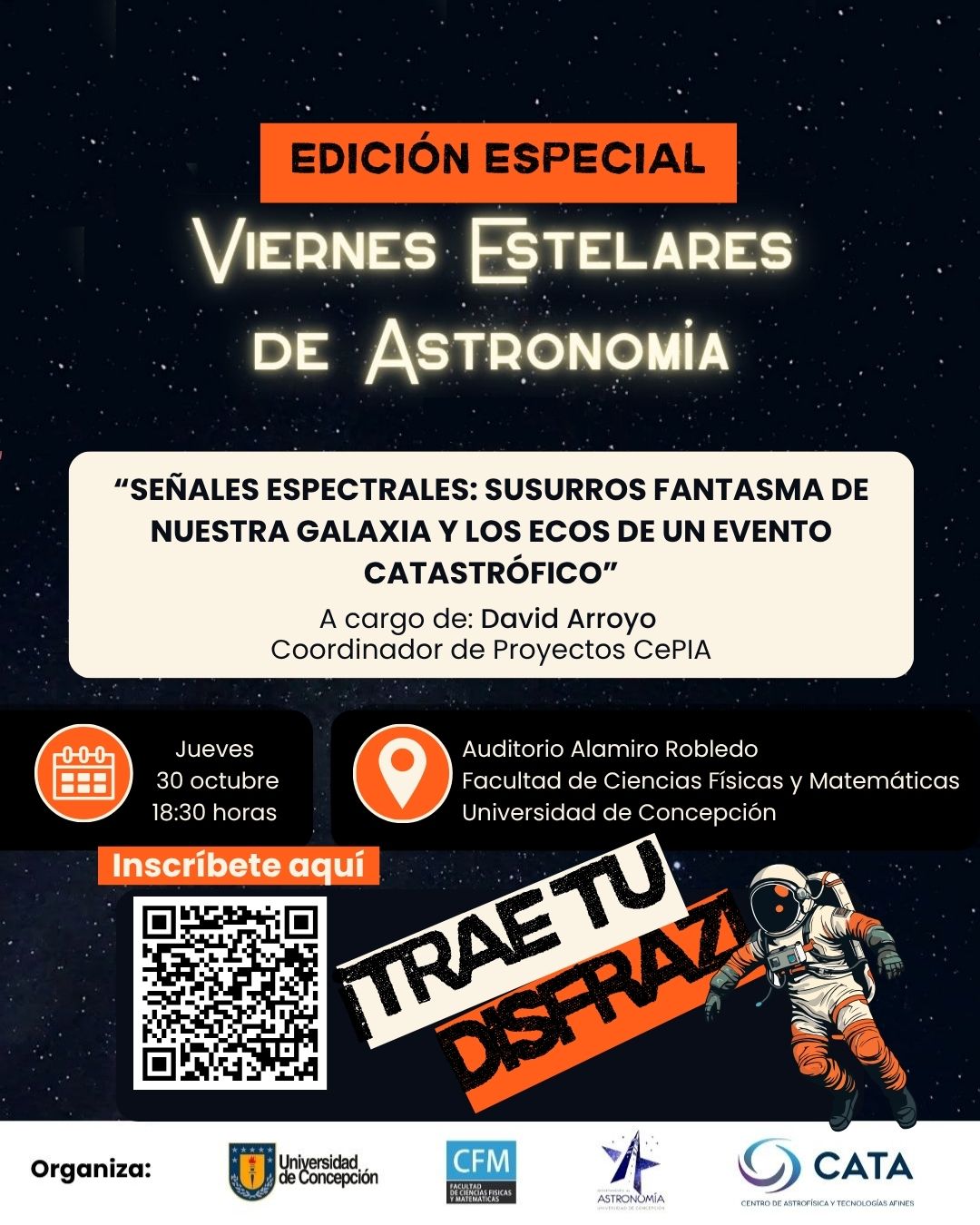
Concepcion, 27 October 2025
Special Edition of Viernes Estelares: A Night to Hear the Whispers of the Cosmos
The traditional lecture series of the Department of Astronomy at the University of Concepción moves to Thursday, October 30, with a special edition that combines science, mystery, and costumes. The speaker will be David Arroyo, Electronic Civil Engineer and Project Coordinator at CePIA.
The Department of Astronomy at the University of Concepción invites the community to take part in a new edition of Viernes Estelares, which will exceptionally take place on Thursday, October 30. This event promises to awaken scientific curiosity and a sense of wonder at the deepest mysteries of the universe.
The lecture, titled “Spectral Signals: Ghostly Whispers of Our Galaxy and the Echoes of a Catastrophic Event”, will explore the hidden messages traveling through the depths of space. “The silence of the universe is an illusion. Across the cold and immense void travel spectral messages—whispers from a remote past and fleeting flashes of cosmic violence. These are radio signals, the ghosts that inhabit the cosmos, waiting to be deciphered,” previews the speaker.
During the talk, the audience will be invited to become detectives of the invisible, tracing the origins of enigmatic ghostly flashes that once defied all explanation. The journey will lead back to the primordial echo, a ghostly hum saturating all space, hiding the key to a catastrophic event that gave rise to everything we know.
The presentation will also reveal how engineering and technology allow us to listen to the whispers of the cosmos, forging instruments capable of capturing the intangible and turning these mysterious echoes into knowledge. It will be a journey through the most mysterious signals of space—perfect to spark curiosity and experience true cosmic awe.
At the end of the event, there will be a costume contest with a surprise prize. Attendees are encouraged to come dressed in cosmic-themed costumes—planets, galaxies, astronauts, comets, or any stellar creation—though wearing a costume is not required to participate.
Venue: Alamiro Robledo Auditorium, Faculty of Physical and Mathematical
Sciences, University of Concepción
Date: Thursday, October 30
Time: 6:30 p.m.
Inquiries: departamento.astronomia@gmail.com
Registration form: Link
Department of Astronomy Communications

Concepcion, 20 October 2025
UdeC Leads National Awards in ANID’s Advanced Technologies Competition
Three UdeC applied research projects in the fields of astronomy, agronomy, and forestry were selected in this funding program, out of a total of 11 awarded nationwide.
Eleven projects were selected in the 2025 call of the Advanced Technologies competition, under the Applied Research Subdirectorate of Chile’s National Agency for Research and Development (ANID). Three of them are led by academics from the University of Concepción — one being the only project selected from the central-southern macrozone, while the other two are part of the general list.
This funding line aims to support applied research and technological development projects with extended validation cycles. The results represent a contribution of nearly 2 billion Chilean pesos for the implementation of these initiatives over a four-year period.
According to UdeC’s Director of Development and Innovation, Dr. Jorge Carpinelli Pavisich, these results reflect the strong scientific and technological capabilities that the University of Concepción has consolidated.
“The three awarded projects are a concrete example of how our University addresses complex problems with cutting-edge solutions that have national impact and global projection.”The director also highlighted the diversity of the topics selected:“From the development of new grapevine varieties adapted to climate change and designed to strengthen one of our most emblematic industries — wine production; to a national hydrological model that will project water availability and management through the year 2100, contributing to sustainability and public policy planning; and finally, to the creation of advanced microelectronic technology for astronomical observation, positioning Chile not only as an observer but also as a developer of the technology that allows us to explore the universe.”
Advanced Technologies – ANID
The UdeC projects awarded in this public funding program and their respective principal investigators are:
WinEd: Innovation in Viticulture, Omics Platforms, and Gene Editing for High-Quality Wine Production. Dr. Claudia Muñoz Espinoza, Faculty of Agronomy, Chillán Campus.
Development of MMIC Technology for Precision Millimeter-Wave Cameras in Astronomical Observation. Dr. Rodrigo Reeves Díaz, Faculty of Physical and Mathematical Sciences.
MHiDROC3 – Chilean Hydrological Model for Climate Change.Dr. Rafael Rubilar Pons, Faculty of Forestry Sciences.
“We thank and recognize the work of the researchers leading these initiatives, and we take on with rigor and responsibility the challenge of continuing to strengthen science and technology in service of Chile’s well-being and competitiveness,” stated Dr. Carpinelli.
Local Technology to Observe the Universe with Greater Clarity

The initiative led by Dr. Rodrigo Reeves seeks to develop a new generation of hybrid millimeter-wave receiver modules (Monolithic Microwave Integrated Circuits, MMIC), combining various technologies for implementation in cameras that can be installed in telescopes such as the Leighton Chajnantor Telescope (LCT) and international observatories.
“This architecture aims to achieve electronic noise levels below 20 K — unprecedented in national developments — while drastically reducing the size, energy consumption, and manufacturing costs of millimeter-wave receivers,” explained the academic from the Department of Astronomy.
In terms of institutional impact, Dr. Reeves highlighted that the Project: “positions Chile, UdeC, and CATA on the international map of low-noise microelectronics, bridging advanced instrumentation and astronomical observation, in collaboration with VTT (Finland), ShNU (China), and Caltech/JPL (USA).”
He added that the project will strengthen the existing infrastructure at UdeC’s Center for Astronomical Instrumentation (CePIA). “The laboratory will not only be able to design but also integrate and characterize MMIC modules under real observation conditions,” he noted.
Addressing the problem behind the project, the scientist explained:“Current receivers are expensive and not easily scalable, which prevents building cameras with many sensitive pixels.”
The project therefore seeks to offer “a solution combining high integration density, low noise, and low power consumption — enabling faster and higher-resolution sky mapping while reducing observation times and operational costs for large telescopes.”
Beyond its research impact, the initiative will also contribute to the training of advanced human capital and open the door to national manufacturing of advanced microwave components and sensors, with potential applications in regional industry, telecommunications, environmental sensing, and satellite payload systems.
“From astronomy,” emphasized Dr. Reeves, “this project seeks to show that Chile can move from being an observer of the universe to also becoming a designer and manufacturer of the technology that observes it — bringing innovation that strengthens our industry’s competitiveness in the global context.”
Improving Wine in the Context of Climate Change
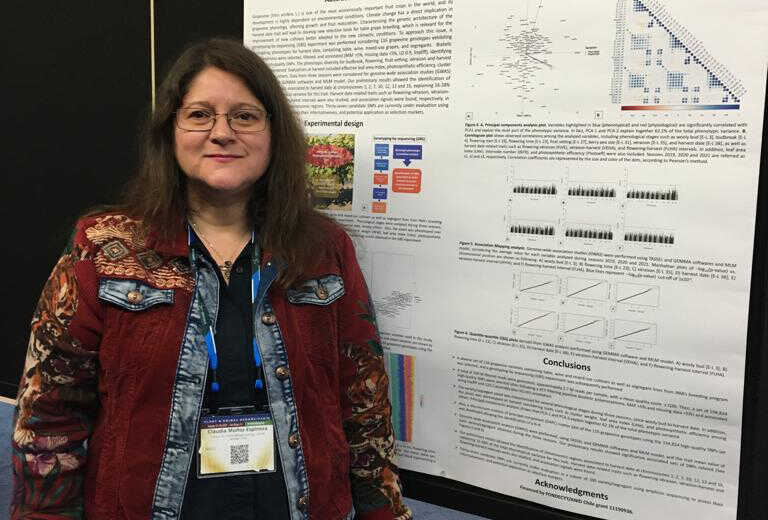
The proposal led by Dr. Claudia Muñoz received the highest national score. It focuses on developing a genomic platform to enhance wine quality in terms of sensory characteristics, stability, and other factors highly valued by the wine industry and international markets.
“We have worked in collaboration with fellow scientists and with Viña Concha y Toro, and we hope this project will allow us to develop advanced gene-editing strategies that improve wine quality and enable the creation of new grapevine varieties with superior characteristics,” explained the researcher.
Dr. Muñoz, from the Department of Plant Production, noted that wine quality is deeply influenced by polyphenolic compounds.
“In the current context of climate change, environmental variables alter vine physiology and growing conditions, which will in turn affect harvest timing, composition, style, and wine quality — impacting the sustainability of viticulture,” she said.
The researcher emphasized that this pioneering platform is expected to have a strong impact on both human capital formation and international collaboration.“As wine is one of the most consumed beverages worldwide, the results will be relevant to other countries as well,” she added.
The project also involves the Agricultural Research Institute (INIA) La Platina, the Plant Biotechnology Center at Universidad Andrés Bello, and Viña Concha y Toro.
Managing Water Resources Through 2100
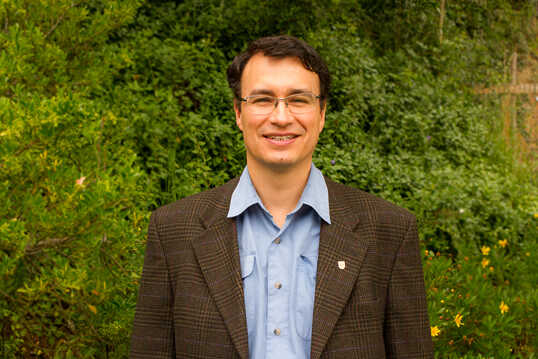
Dr. Rafael Rubilar leads the team, which also includes the current Dean of the Faculty of Environmental Sciences, Dr. Mauricio Aguayo Arias, and researchers from the Universidad Católica del Maule. Together with a group of engineers, they previously developed a FONDEF IT project that laid the groundwork for this new initiative.
“We created a base software that we used to train staff at the General Water Directorate (DGA). This project allows us to continue that service and make planned improvements,” explained Dr. Rubilar.
“It’s a public-interest project, developed mainly for the DGA, but we also have participation from water boards and CMPC Forestal, who are interested in the project’s applications,” he added.
The model allows visualization and projection of Chile’s river basin hydrology. Initially designed for certain regions, it is now expected to scale to a national level and include predictive capabilities for river flow through 2100.
“We will incorporate satellite data, vegetation change indicators, and make dynamic adjustments to the model. We’re enthusiastic about what it means, because it’s a spatially distributed model capable of simulating 500-by-500-meter pixels, enabling the determination of water availability at different points within a basin,” said Dr. Rubilar, academic from the Department of Silviculture and Director of the Soil, Water, and Forest Research Laboratory (LISAB).
Among the goals, the team also foresees the licensing of the technology.
“By the fourth year, we expect to have the tool ready for applied use by potential users and to define mechanisms for its long-term sustainability, since it will be a valuable contribution to Chile’s strategic planning for water management,” he emphasized.
VRID UdeC
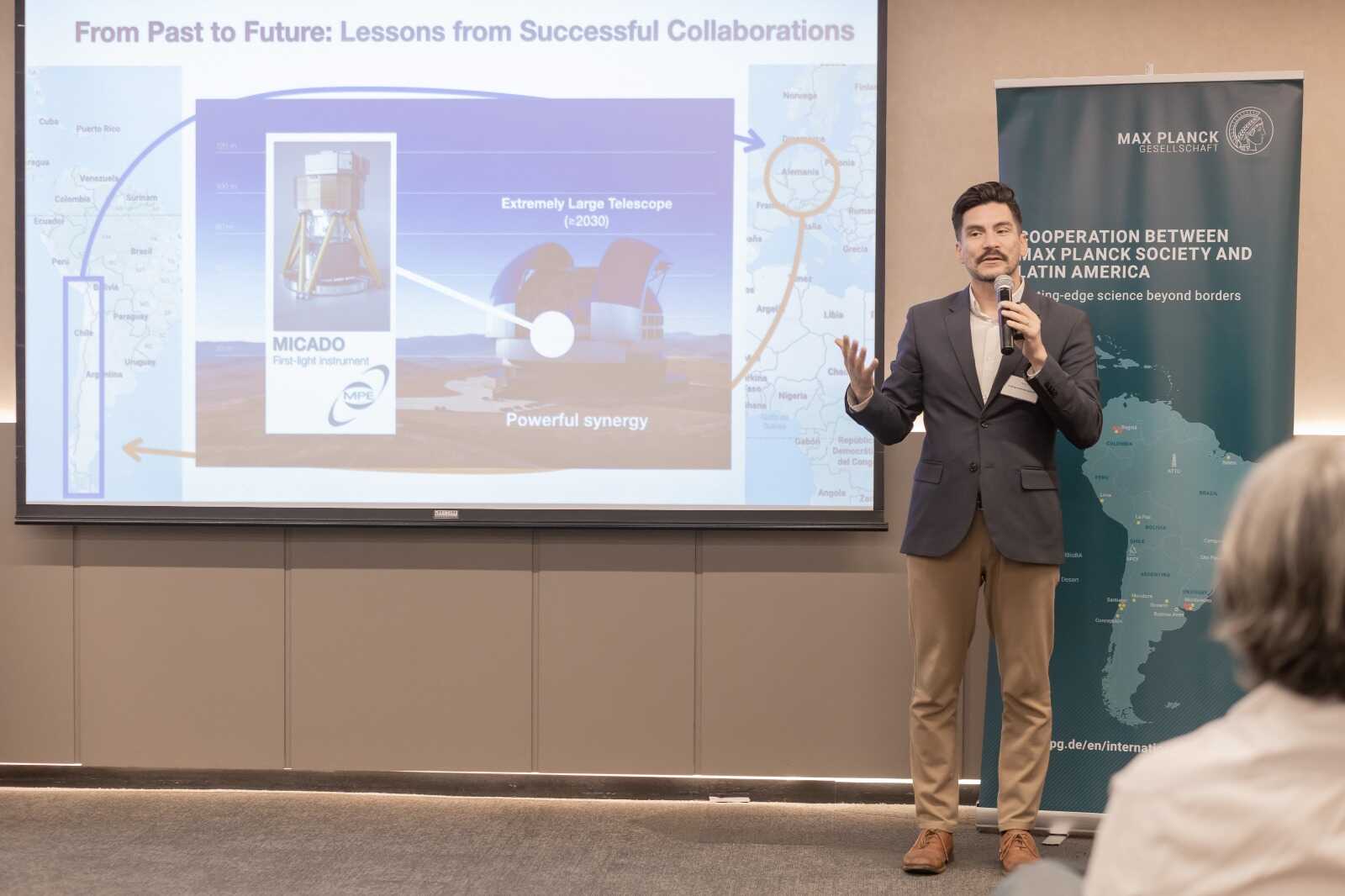
Concepcion, 17 October 2025
Professor Rodrigo Herrera Camus Represents Chile at Latin American Meeting of the Max Planck Society
Dr. Rodrigo Herrera, a faculty member of the Department of Astronomy at the University of Concepción, together with Dr. Esteban Vöhringer from the Faculty of Chemical Sciences, were the two Chilean representatives at the regional meeting of the Max Planck Society, held on October 9 and 10 in São Paulo, Brazil. The event brought together group leaders and young researchers to strengthen international scientific cooperation.
Of the five groups associated with the Max Planck Institutes in Chile, only two were selected to represent the country in São Paulo. Both belong to the University of Concepción: Dr. Herrera, from the Department of Astronomy at the Faculty of Physical and Mathematical Sciences, who leads the group “The Baryonic Cycle in Galaxies,” associated with the Max Planck Institute for Extraterrestrial Physics; and Dr. Vöhringer, from the Department of Physical Chemistry at the Faculty of Chemical Sciences, who leads the Computational Biophysical Chemistry laboratory, associated with the Max Planck Institutes for Terrestrial Microbiology and Multidisciplinary Natural Sciences.
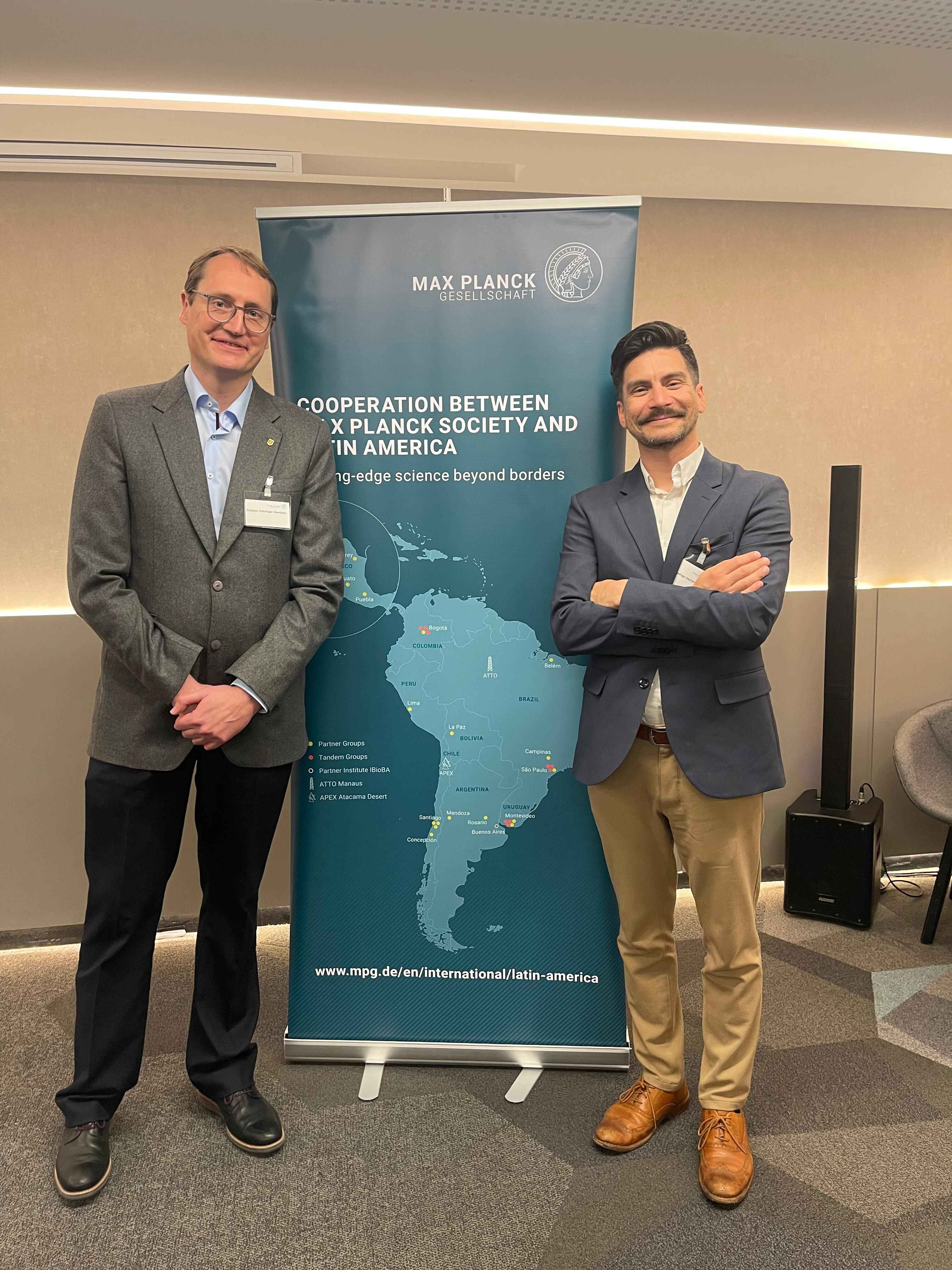
For Dr. Rodrigo Herrera, being chosen as Chile’s representative at the Max Planck meeting was “a tremendous honor and an excellent opportunity to showcase the work carried out by our associated group at the University of Concepción, as well as the full potential of our country to offer high-quality research resources and human capital. Together with Max Planck as a strategic partner, we can continue developing basic and frontier science in Chile, particularly in the field of astronomy.”
Over 40 representatives from the Latin American scientific community attended the event in São Paulo. During the meeting, participants discussed opportunities to strengthen international collaboration, promote internships, develop joint projects, and encourage the participation of students and young researchers.
“Meeting our Max Planck group leaders and young researchers in São Paulo was one of the highlights of my Latin America trip. Their talent and commitment show how international collaboration strengthens science — and the global community that depends on it,” said Patrick Cramer, President of the Max Planck Society, via his social media account X.
Dr. Vöhringer noted that this recognition highlights the University of Concepción’s leadership in international research. “It demonstrates the impact of our work and the institutional commitment to generating knowledge within global networks. UdeC positions itself as a reference institution that drives multidisciplinary projects, fosters the training of advanced human capital, and enables Chilean science to play a leading role in addressing global challenges,” said the academic.
This participation consolidates the University of Concepción’s international projection and underscores its role as a leading institution in frontier research across both disciplines, demonstrating how regional academic excellence can have an impact on global science.

|
Faculty of Physical and Mathematical Sciences, UdeC
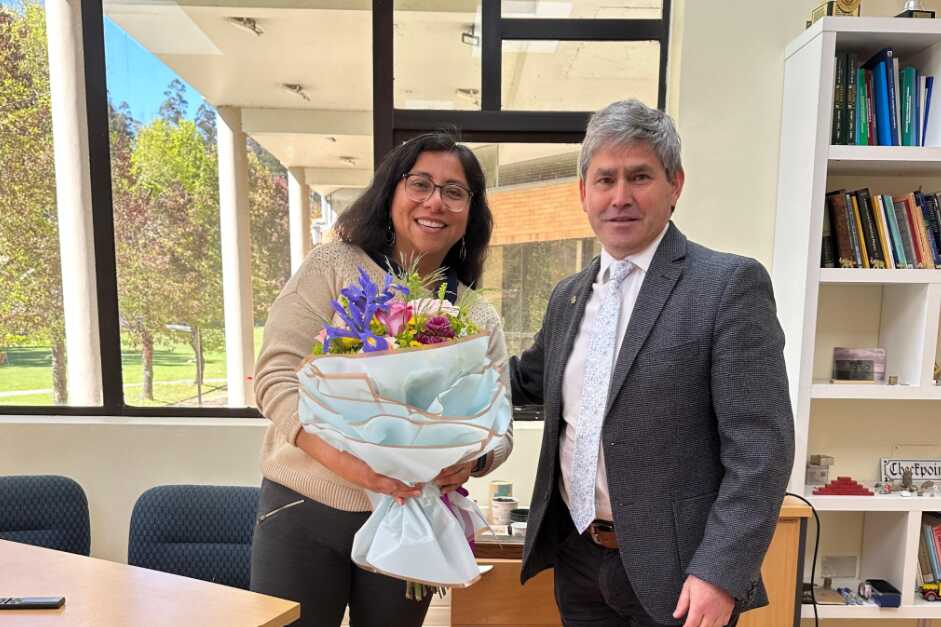
Concepcion, 10 October 2025
Astronomy Department Academic Receives International Recognition for Outstanding Research Work
Dr. Mary Loli Martínez, from the University’s Astronomy Department, was recently recognized by the Government of Mexico for her outstanding academic career and contribution to scientific research. This prestigious award has generated great pride within the university community and is seen as an opportunity to strengthen academic ties between Chile and Mexico.
“Yes, honestly, I was not fully aware of the significance of this recognition, and of course, all the congratulations I’ve received have been a bit unexpected. But I am very happy, and as the Rector said, we hope that this award will pave the way for formal collaborations with the embassy, so that both countries can benefit, since we have many things in common,” said Mary Loli Martínez.
The academic also highlighted the potential of this recognition to foster new partnerships. “We also have projects, such as the Pacific Alliance scholarships and academic exchanges… so I hope that from this we can create networks between the two countries, and especially with the university, which I think is important,” she added.
For his part, the Dean of the Faculty, Luis Roa, expressed his pride in the recognition received: “Mary Loli has done an outstanding job both academically and in research. That is why the recognition she has received from her country, Mexico, fills us with pride. We believe this is the beginning of something bigger, and we look forward to sharing much more joy regarding this with Mary Loli.”
Finally, the Dean emphasized the importance of such distinctions: “For the faculty, for the Astronomy Department, and for the university itself, this is very important. These recognitions do not go unnoticed.”
Faculty of Physical and Mathematical Sciences, UdeC
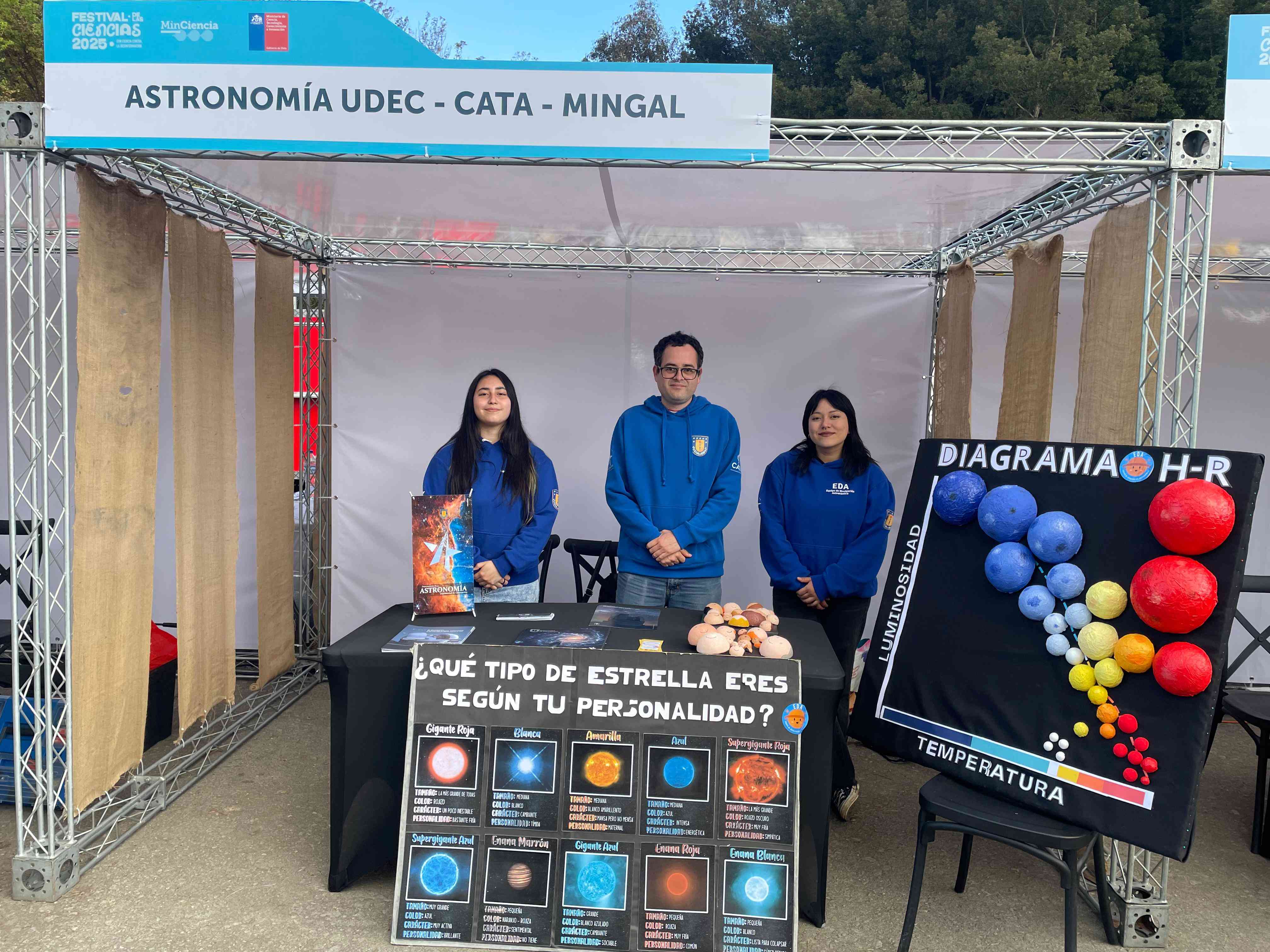
Concepcion, 8 October 2025
Astronomy UdeC participated in the 2025 Festival of Science in San Pedro de la Paz
On Sunday, October 5, the Department of Astronomy at the University of Concepción took part in the 2025 Festival of Science (FECI), held at Laguna Grande Park in San Pedro de la Paz.
This national event, organized by the Ministry of Science, Technology, Knowledge and Innovation, took place simultaneously in various cities across the country, offering free activities for all audiences. In the Biobío Region, the festival was supported by the Municipality of San Pedro de la Paz and Explora Biobío, bringing together more than 5,000 attendees for a day dedicated to celebrating knowledge and scientific curiosity.
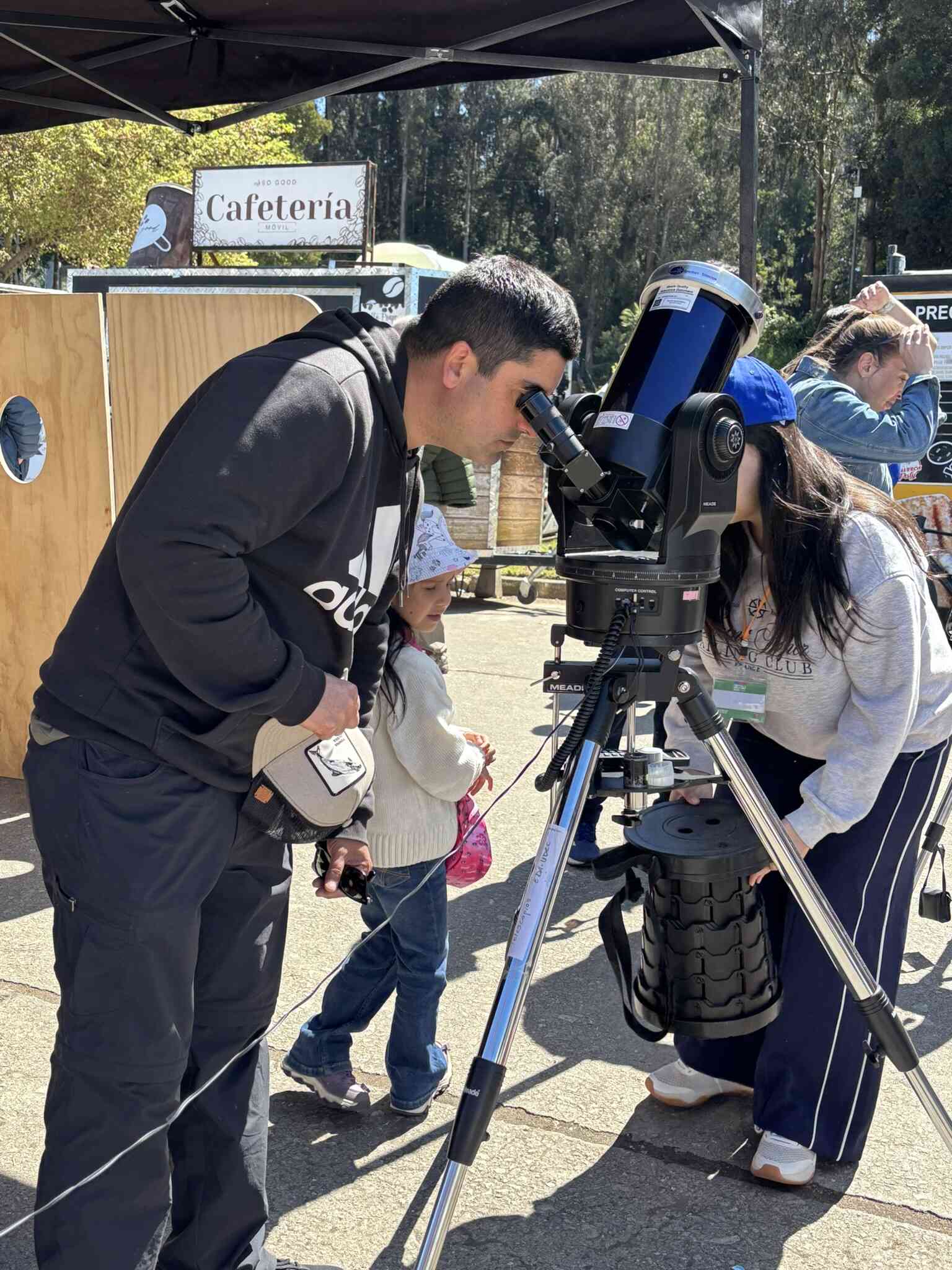
The Astronomy UdeC booth featured a telescope area for solar observation and demonstrations on how these instruments are used, along with interactive activities that brought visitors closer to the stars and their properties.
The participation was coordinated by students from the Astronomical Outreach Team (EDA), who shared their enthusiasm and knowledge with children, youth, and adults interested in discovering the cosmos. The activity also received support from the MINGAL and CATA centers, which contributed to the department’s presence at this important scientific outreach event.
Under the theme “With science against misinformation: discover, ask, and verify,” the 2025 Festival of Science brought together more than 20 institutions from the Biobío Region, offering talks, live music, and experiments that invited reflection on the value of evidence and critical thinking.
Department of Astronomy Communications
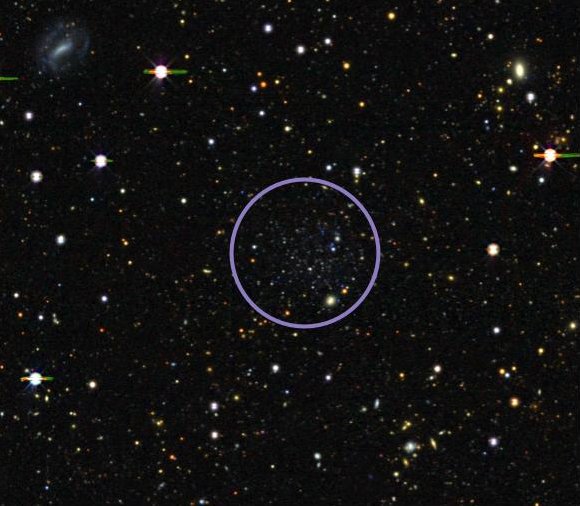
Concepcion, 5 August 2025
Chilean astronomers detect carbon monoxide in the smallest gas-rich dwarf galaxy discovered to date
- The finding helps us understand how stars form in extreme environments with very low metallicity.
Research led by Chileans Dr. Vicente Villanueva, Researcher at the Center for Astrophysics and Related Technologies (CATA), and Dr. Matías Blaña, PhD in Astronomy from the University of Munich, has detected carbon monoxide (CO) in the dwarf galaxy Leo T, located 1 million light-years away at the edge of the Milky Way and the smallest detected so far with gas and low metallicity.
Leo T was discovered in the mid-2000s and has since been studied with various instruments, but this is the first time that molecular gas has been detected in it.
The team identified three compact molecular clouds, each with a mass close to 5,000 times that of the Sun. In total, they represent just 3% of the gas present in Leo T. The detection was made possible by the Atacama Compact Array (ACA) telescope at the ALMA observatory, whose high sensitivity allowed it to pick up signals that were previously difficult to observe.
The observation also revealed that one of the gas clouds appears to be being expelled from the galaxy, possibly due to stellar winds and interaction with the Milky Way environment. “There are some clouds that are held back by Leo T’s gravity, but there are others that are being left behind. It’s as if the wind is pushing them out of the galaxy. Our hypothesis is that stellar winds are forming these structures, but at the same time they are expelling them. It’s like driving a car with a leaf in your hand: if the car goes too fast, the leaf ends up flying away,” explains Villanueva, also a postdoctoral astronomer at the University of Concepción.
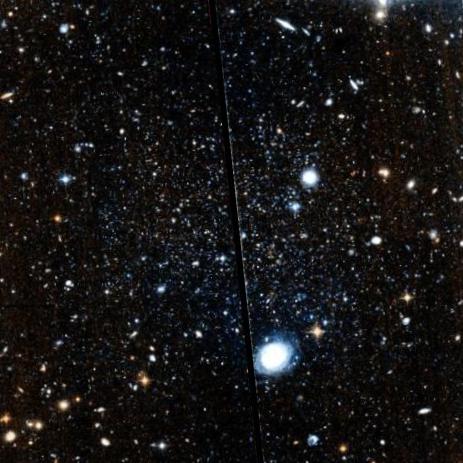
“Leo T is a very small galaxy. It has a stellar mass almost a million times smaller than that of the Milky Way. Being so small, it has less gravity, so the material needed to form stars is lost to stellar winds. Finding molecular gas clouds in a galaxy like this is truly surprising. To detect them, we had to rely on much deeper data integration, almost a hundred times more sensitive than normal. ALMA has the ability to break through these barriers, which is why this discovery is so significant,” adds Vicente Villanueva.
“Since its discovery in 2007, this galaxy dominated by dark matter has shown exotic properties, as it is so small and has so few stars compared to other dwarf galaxies located within the Milky Way. However, contrary to what was previously thought, it contains a large amount of gas (five times more than its stellar content),” explains Matías Blaña, also an astronomer at the University of La Serena.
The CHIMERA project, within which this research is framed, seeks to understand the interstellar medium in low-mass, low-metallicity galaxies. The collaboration between Vicente Villanueva and Matías Blaña was fundamental in making the detection a reality.
The researchers also highlighted the role of the international team that participated in the publication. Among them were Chilean astronomers and CATA associate researchers Rodrigo Herrera-Camus (UdeC), Gaspar Galaz (UC), Mónica Rubio (U. de Chile), and Michael Fellhauer (UdeC), who contributed their expertise to analyze the data and contextualize the findings.
The role of carbon monoxide in star formation
Carbon monoxide (CO) is an indirect tracer of molecular hydrogen (H₂), the raw material for star formation. Detecting it in such a small galaxy with so few metals is a major challenge, as CO is usually scarce in these environments.
“Today we know that star formation occurs mainly from molecular gas, but molecular hydrogen is difficult to observe. That’s why we use tracers such as CO. The problem is that in dwarf galaxies such as Leo T, the amount of CO is so small that, in order to find it, we have to go to the limit of the sensitivity of the instruments,” says Villanueva.
The research also determined that Leo T has extremely high CO-H₂ conversion factors, confirming that much of the molecular hydrogen is “hidden” and cannot be easily observed through CO. This provides key clues about how small galaxies form stars under conditions similar to those in the early universe.
“These galaxies are like living fossils that tell us how the first stars in the universe were formed. Understanding them is like looking back in time and seeing how the first cosmic lights were lit,” says Villanueva.
Next steps
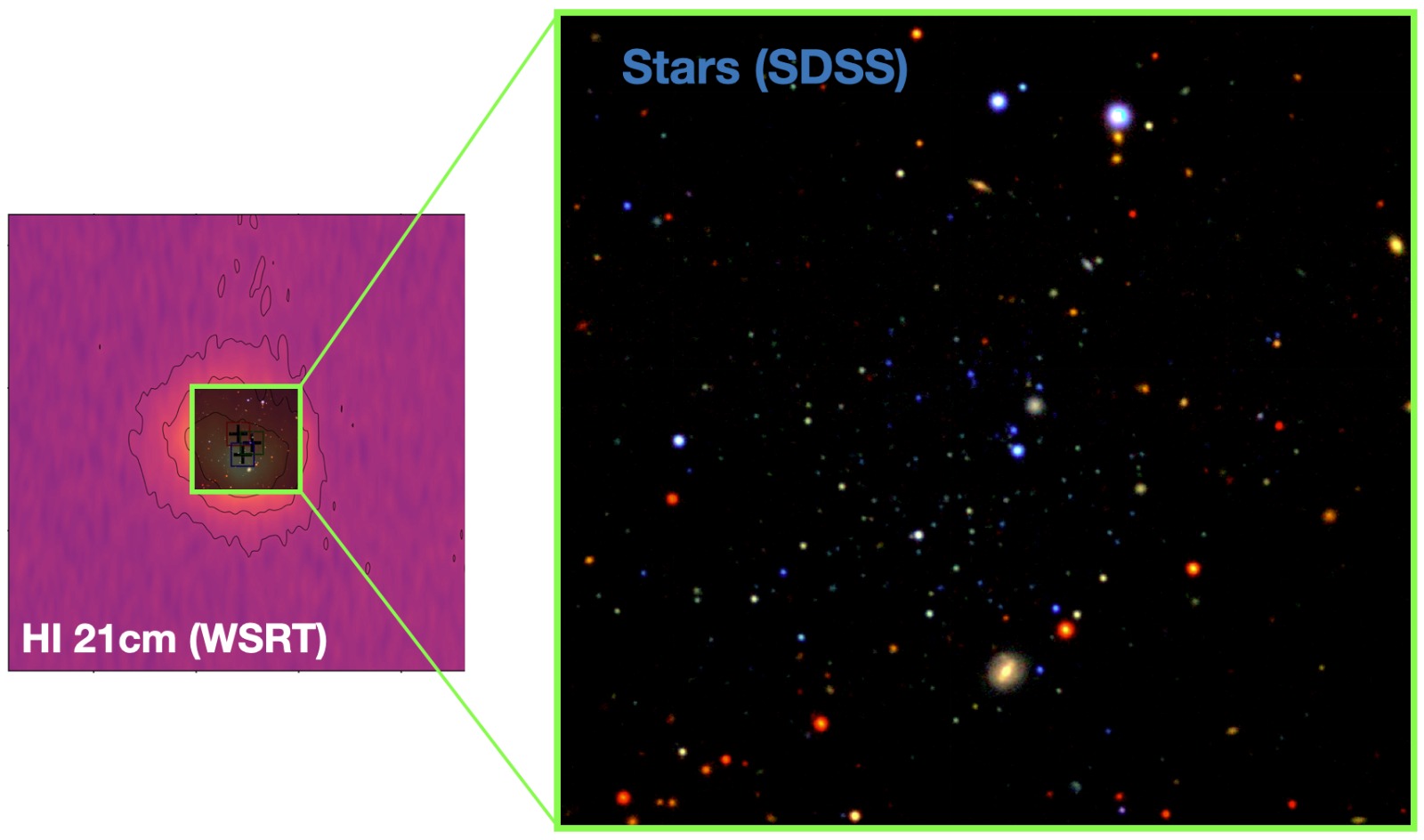
The team plans to conduct new observations with ALMA, which has higher resolution, to accurately determine the internal structure of the detected clouds. Blaña adds that at first, “it was a big surprise to find molecular gas in this galaxy. Several studies indicated that it had stopped forming stars several million years ago and speculated that Leo T was entering its ‘retirement’ stage. The history of this galaxy is still unknown: whether it collided with the Milky Way in the past, or whether it is entering for the first time, which adds to its mysteries.”
“Our observations tell us that there are two factors that explain the formation of these structures: atomic gas, which had already been identified, and the action of stellar winds that compress the gas and convert it into molecular gas. Now we want to go deeper to understand how this process evolves and whether Leo T still has the capacity to form new stars,” says Villanueva.
Finally, both astronomers conclude that they are already leading new proposals for the CHIMERA project, led by both of them and involving collaborators from Chile, Europe, and the United States, which focuses on studying star formation and dynamics in low-mass galaxies using both observations and simulations.
“In particular, we have already applied for more time at ALMA to see the clouds in greater detail and observe their structures, and we have been granted time at APEX to observe molecular gas at different temperatures. In addition, we applied to the renowned VLA (Very Large Array) radio telescope to see if, with the morphology of the atomic gas in Leo T, we can determine its orbital history and origin through new simulations, and determine how this monoatomic gas is connected to the molecular gas,” concludes Matías Blaña.
More Information
Scientific article: Astronomy & Astrophysics
Simulations of gas evolution in Leo T: video
Simulations of Leo T’s Orbit: video
Astronomy Communications UdeC- CATA

Concepcion, 24 July 2025
Between galaxies and extraterrestrials: Stellar fridays of astronomy return
- After a period of pause, the popular lecture series “Stellar Fridays of Astronomy” returned to the premises of the Faculty of Physical and Mathematical Sciences at the University of Concepcion (UdeC), with two sessions dedicated to fascinating topics: galaxies and the possibility of extraterrestrial life on our planet. These first two talks took place on 13 and 27 June, drawing a combined audience of over 90 attendees.
The first lecture, titled “Galaxies: The Fundamental Building Blocks of the Universe”, was presented by Dr. Vicente Villanueva, a postdoctoral researcher at UdeC, and a member of the Center for Astrophysics and Related Technologies (CATA) and the Millennium Nucleus of Galaxies (MINGAL). The talk explored key aspects of galaxies, such as their most prominent structures and morphologies, the telescopes astronomers use to study them, and the current state of research in the field — with the aim of understanding what we have learned about them in recent years.
The second lecture, titled “The Drake Equation”, was presented by Dr. Michael Fellhauer, UdeC academic and associate researcher at CATA. During the session, attendees had the opportunity to learn about the Drake Equation — a formula developed to estimate the number of detectable civilisations that might exist in the Milky Way. The equation considers factors such as the rate of star formation in the galaxy, the fraction of those stars that host planetary systems, and the number of planets per solar system with environments suitable for life.
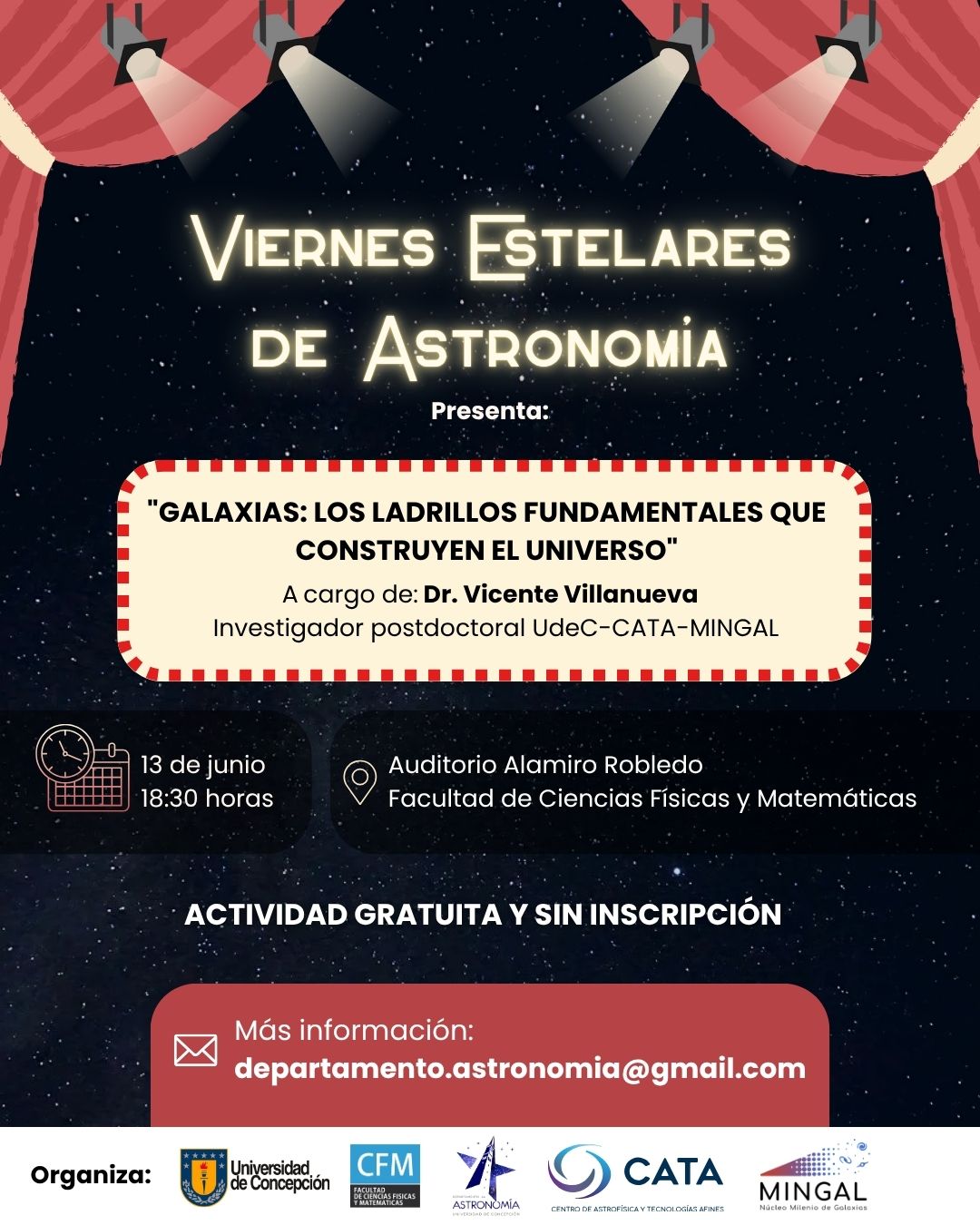
“With a successful return, we have resumed this traditional activity of our Department. We had a large number of attendees, from adults to young children, who also had the chance to speak with the researchers and ask questions after each talk. We are glad to bring back these talks, which are free and of high quality, and which we will continue to hold on a monthly basis,” said Celeste Burgos, Head of Outreach and Communications at the Department of Astronomy.
As the journalist points out, “Stellar Fridays of Astronomy” is a monthly event organised by the Department of Astronomy at the University of Concepcion, aimed at bringing this science closer to the public in an engaging and accessible way. The series is known for the high quality delivered by the academics who lead each session. These events are completely free of charge and open to all, with no registration required. The public is warmly invited to attend each session at the Alamiro Robledo Auditorium of the Faculty of Physical and Mathematical Sciences, on the dates and times announced by the department via its social media channels.
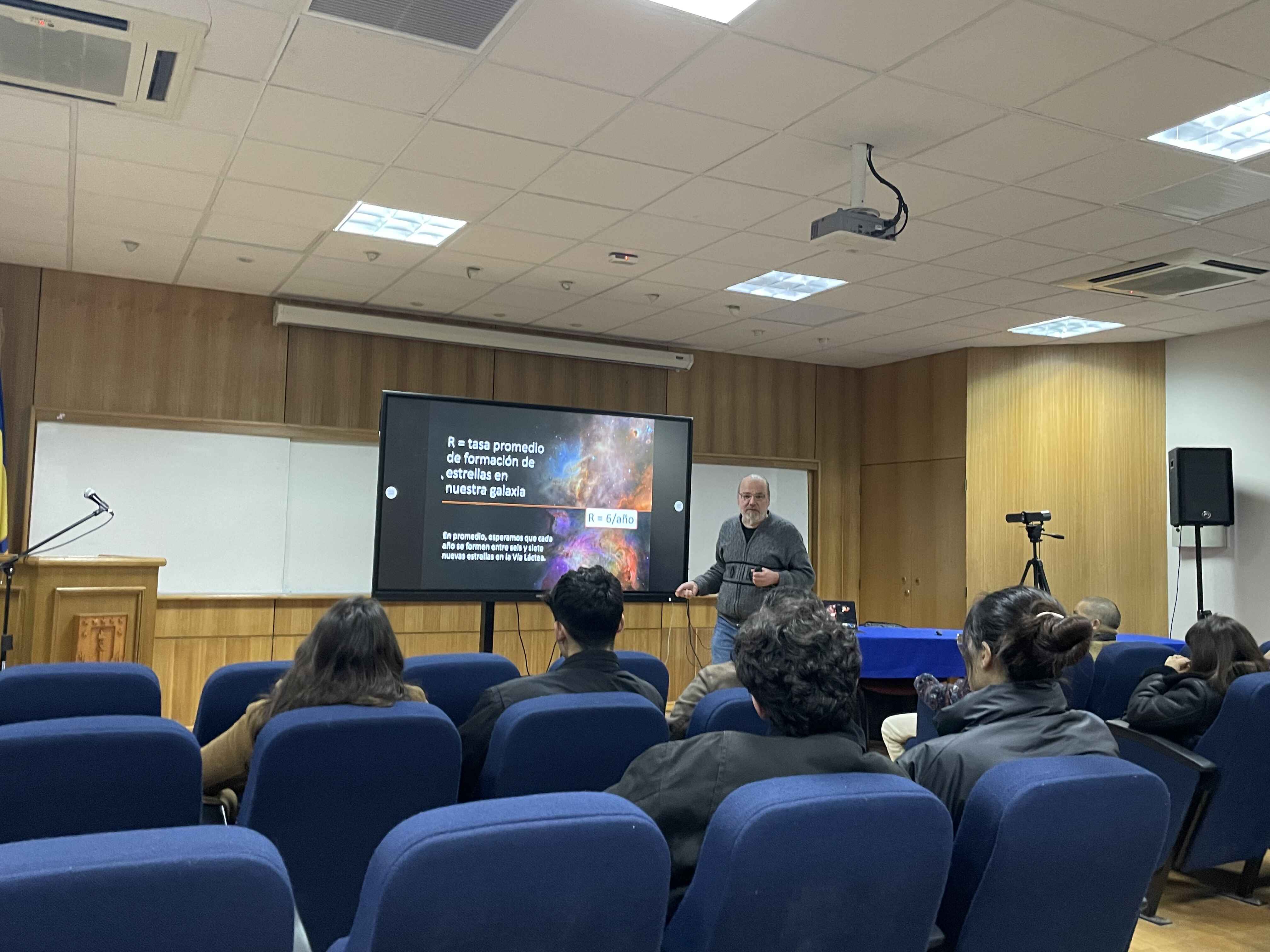
|
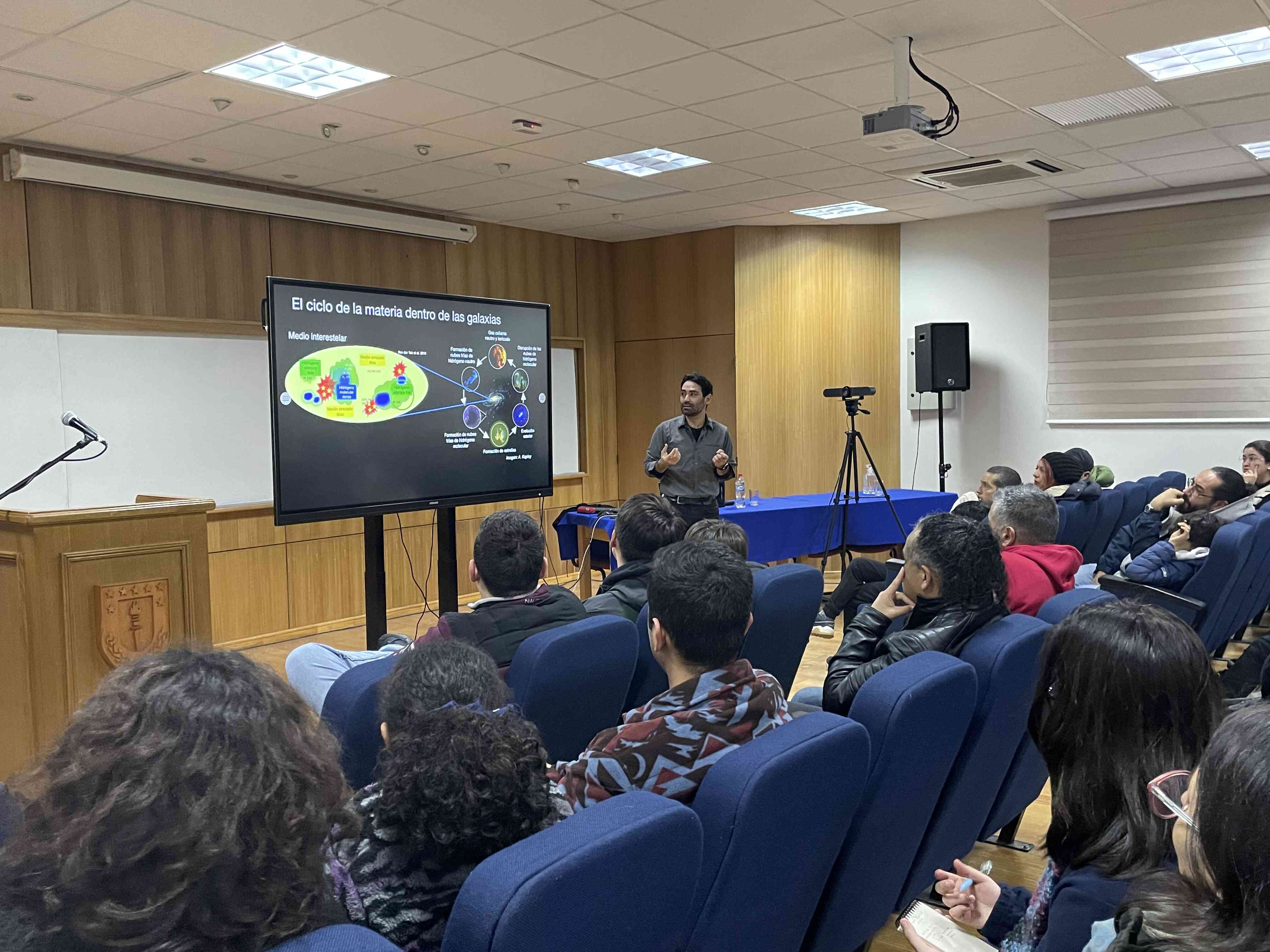
|
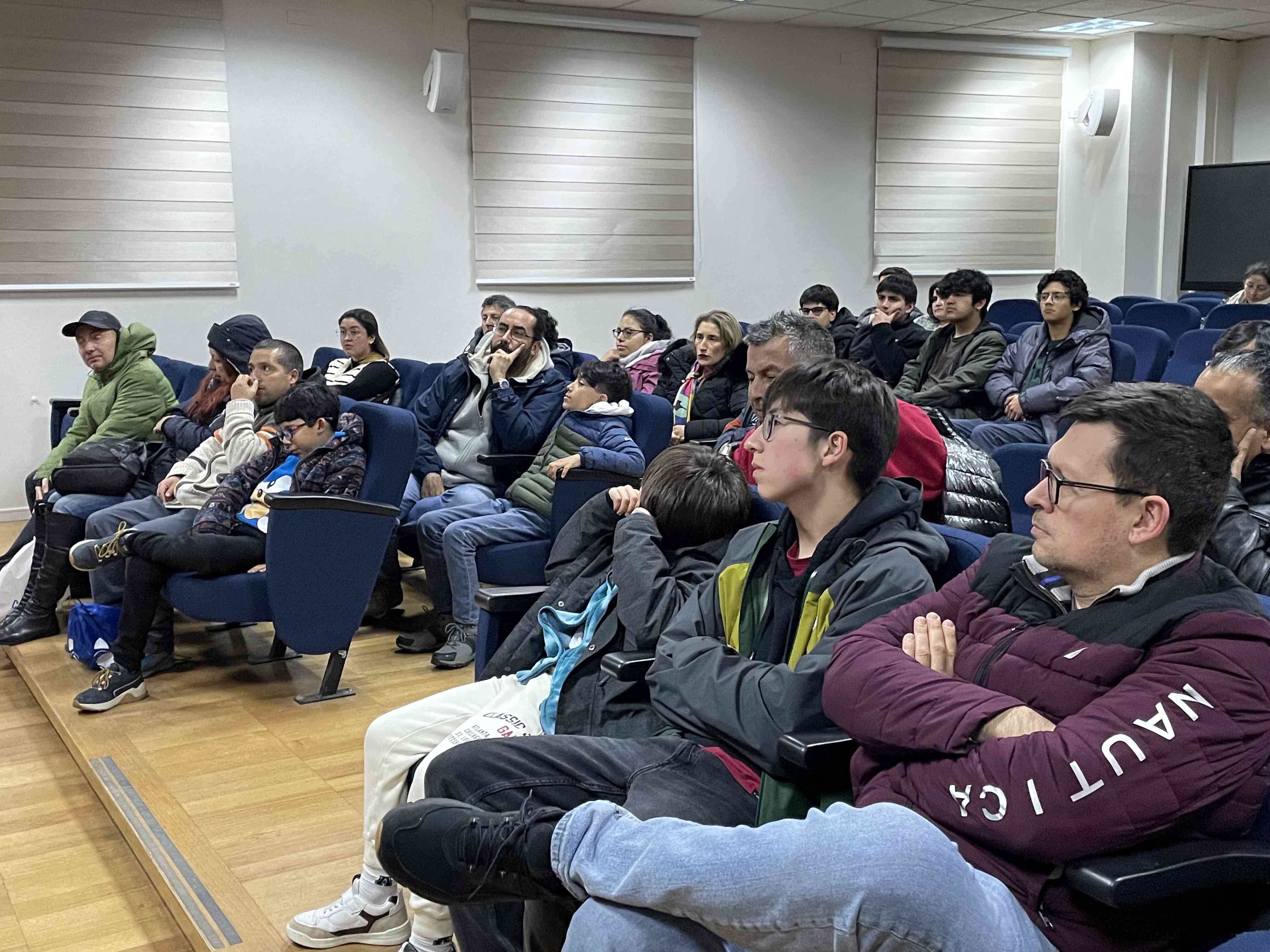
|
Celeste Burgos Badal
Department of Astronomy Communications
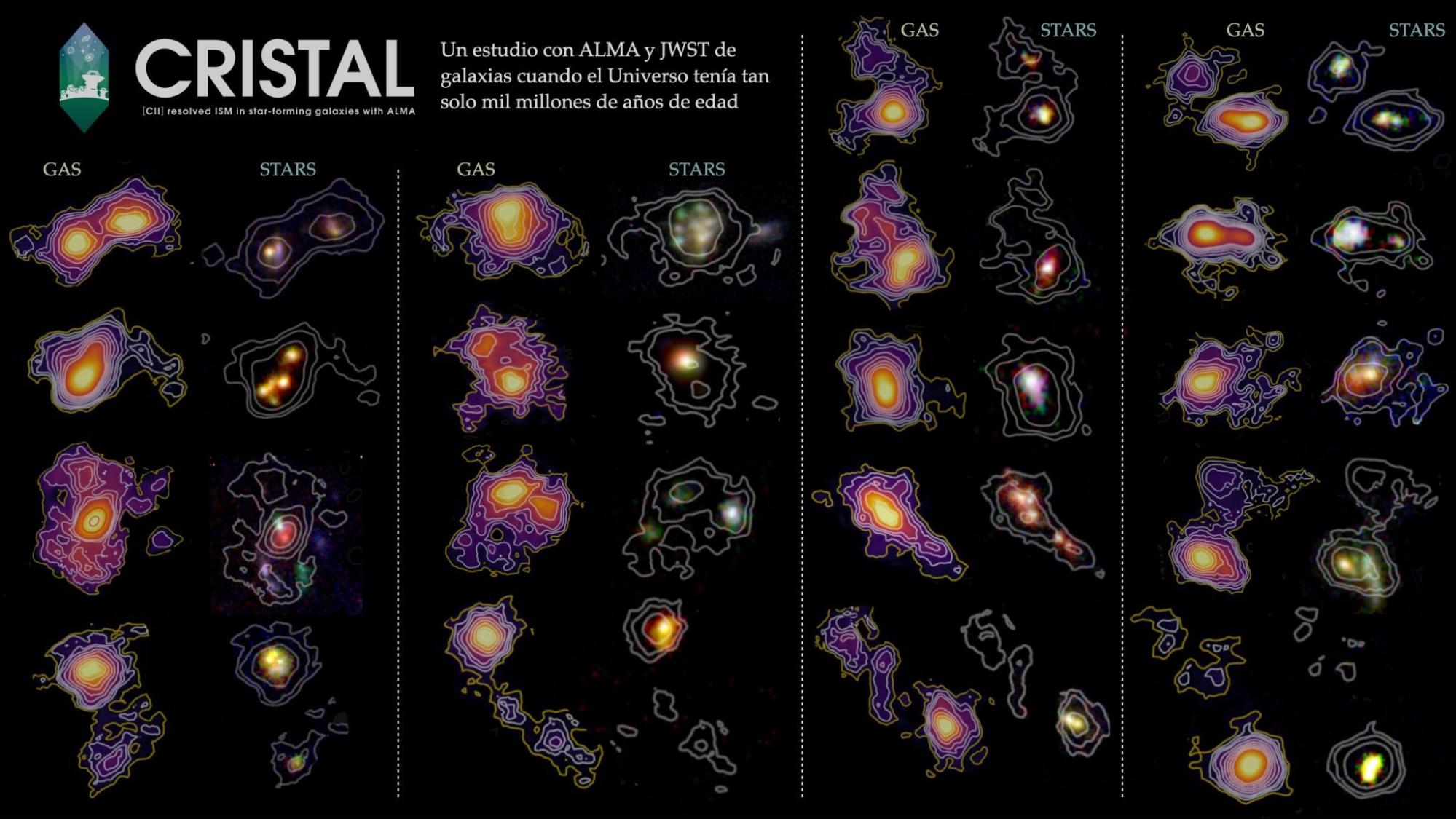
Concepcion, 1 July 2025
Chilean astronomers reveal unprecedented details of the first galaxies
- The CRISTAL project, led from Chile by astronomers from the Millennium Nucleus of Galaxies (MINGAL), has captured the most comprehensive image of the early Universe to date.
“We have been able to observe – with an unprecedented level of detail – how stars, dust, and gas are distributed and interact within a sample of the first galaxies formed in the cosmos,” explains Rodrigo Herrera-Camus, director of MINGAL and astronomer at the University of Concepcion, who led the research.
“For the first time, and thanks to the ALMA observatory, we were able to study the cold gas in these galaxies – the raw material from which stars are born. We discovered that these young galaxies had complex structures, exhibited galactic winds expelling gas from their discs, and contained more cosmic dust and metals than previously expected,” added Herrera-Camus, who is also a researcher at the Center for Astrophysics and Related Technologies (CATA).
These observations are challenging our existing models of galaxy formation and opening up new avenues for research. “We now have a new family portrait of early galaxy evolution. ALMA allowed us to observe the cold gas and cosmic dust, while the Hubble and James Webb space telescopes revealed the populations of both young and older stars,” the astronomer added.
A snapshot of the universe in its "early youth"
Through the CRISTAL project (“[CII] Resolved ISM in STar-forming galaxies with ALMA”), researchers succeeded in carrying out the first ‘census’ of gas, dust, and stars in galaxies when the Universe was just one billion years old. This was made possible through joint observations using the ALMA observatory in Chile and the James Webb and Hubble space telescopes.
“CRISTAL provides the kind of detailed data that simply wasn’t possible before ALMA and JWST,” emphasised Herrera-Camus. “These discoveries allow us to reconstruct the internal ecosystem of the first galaxies and understand how, after billions of years of evolution, they gave rise to galaxies like the Milky Way,” added the astronomer, who also holds a PhD in Astrophysics from the University of Maryland, United States.
The CRISTAL programme is the first ALMA Large Programme, in its ten years of operation, to be led from Chile. It was selected through a highly competitive global process. Coordinated from the University of Concepcion (homepage) the project brings together more than 40 astronomers from around the world. Among the principal co-investigators are MINGAL astronomers Manuel Aravena, from Universidad Diego Portales, and Jorge González-López, from the Institute of Astrophysics at Pontificia Universidad Católica de Chile, as well as 2020 Nobel Laureate in Physics, Prof. Reinhard Genzel, from the Max Planck Institute for Extraterrestrial Physics.
Currently, the group led by Herrera-Camus is analysing new observations from the James Webb space telescope. “These new images allow us to study in greater detail the properties of the hot gas surrounding the stars, as well as the quantity and characteristics of the elements present in that gas,” concluded the astronomer.
The results are published in the article “The ALMA-CRISTAL survey: Gas, dust, and stars in star-forming galaxies when the Universe was ∼ 1 Gyr old,” in the journal Astronomy & Astrophysics, which can be accessed via this link: article.
Comunicaciones MINGAL
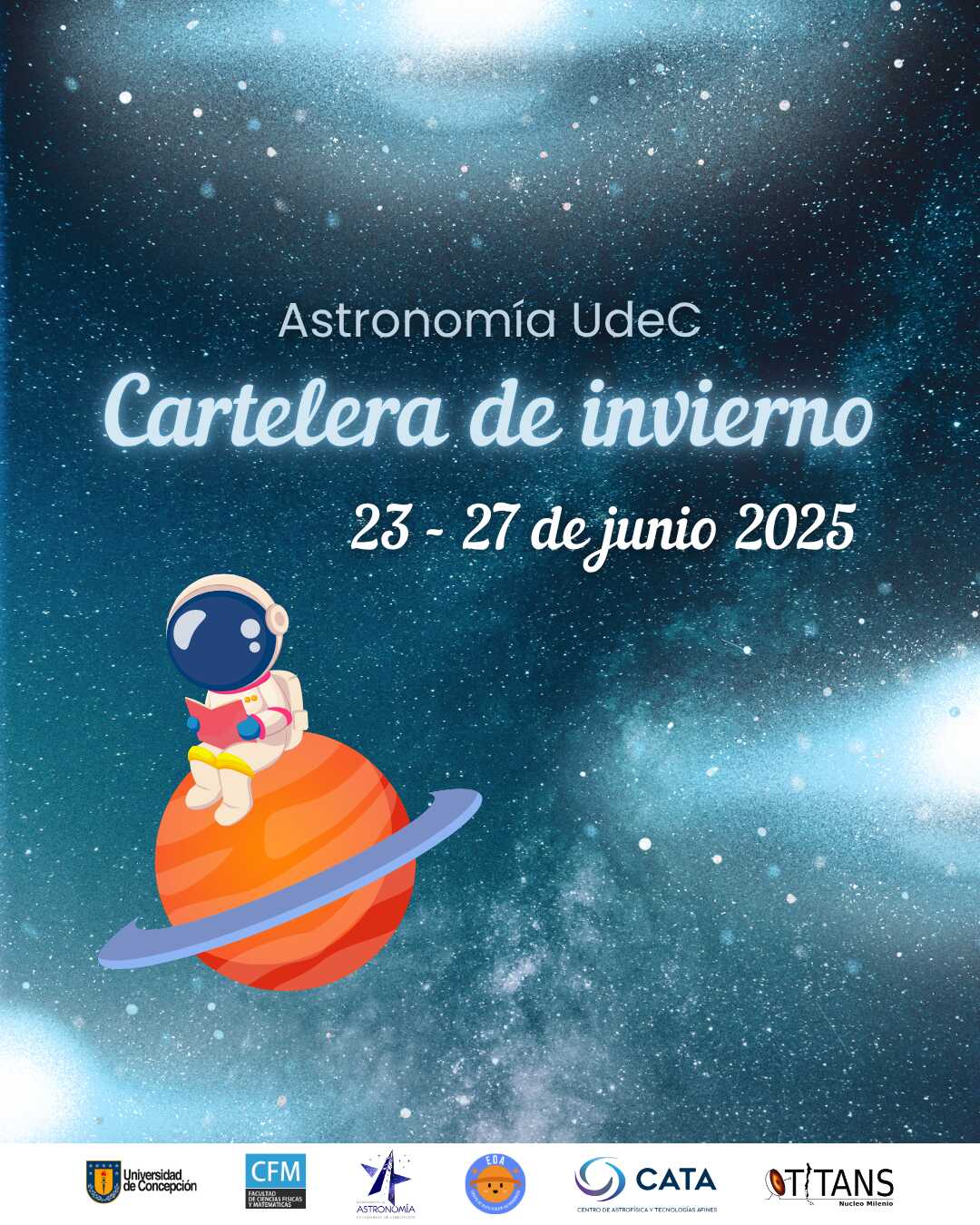
Concepcion, 30 June 2025
More Than 200 participants engaged in the Winter Astronomy Outreach Series
- Once again, the Department of Astronomy at the University of Concepcion carried out activities aimed at bringing knowledge about the Universe closer to the community.
From 23 to 27 June, a series of talks, astronomy-themed films, and workshops took place. Among the latter, delivered by the Astronomy Outreach Team (EDA in spanish), were workshops such as “Stars Don’t Have Points,” “Space Messaging,” and “Living in Space,” aimed at children who, taking advantage of their winter school holidays, were able to learn about astronomy in a fun and engaging way.
The outreach series also attracted an adult audience with the talk “Pre-Hispanic Observatories in Ancient Mexico”, delivered by Dr. Mary Loli Martínez, academic from our department. The talk explored how the sky was observed in ancient Mexico and the importance of the movement of celestial bodies in religious and social activities. “Much of the astronomical knowledge has been preserved in the architecture of their cities, where even today celestial events such as equinoxes or planetary transits can be observed with remarkable precision,” explained the researcher.
Dr. Michael Fellhauer, in turn, delivered the talk “The Drake Equation”, introducing the audience to this tool used to analyse the probability of extraterrestrial life. “The Drake Equation was created to break down the question of whether extraterrestrial civilisations exist into smaller questions, based on the conditions necessary for intelligent life to emerge on a distant planet. In this talk, we examined them step by step, using all the astronomical knowledge we have gathered to date,” explained the academic. Both talks sparked strong interest among attendees, who went on to ask questions and engage in discussion with the speakers.
The activity also included a selection of astronomy-themed films and the talk “Black Holes”, led by the EDA. In total, 14 activities were held, drawing more than 200 participants.
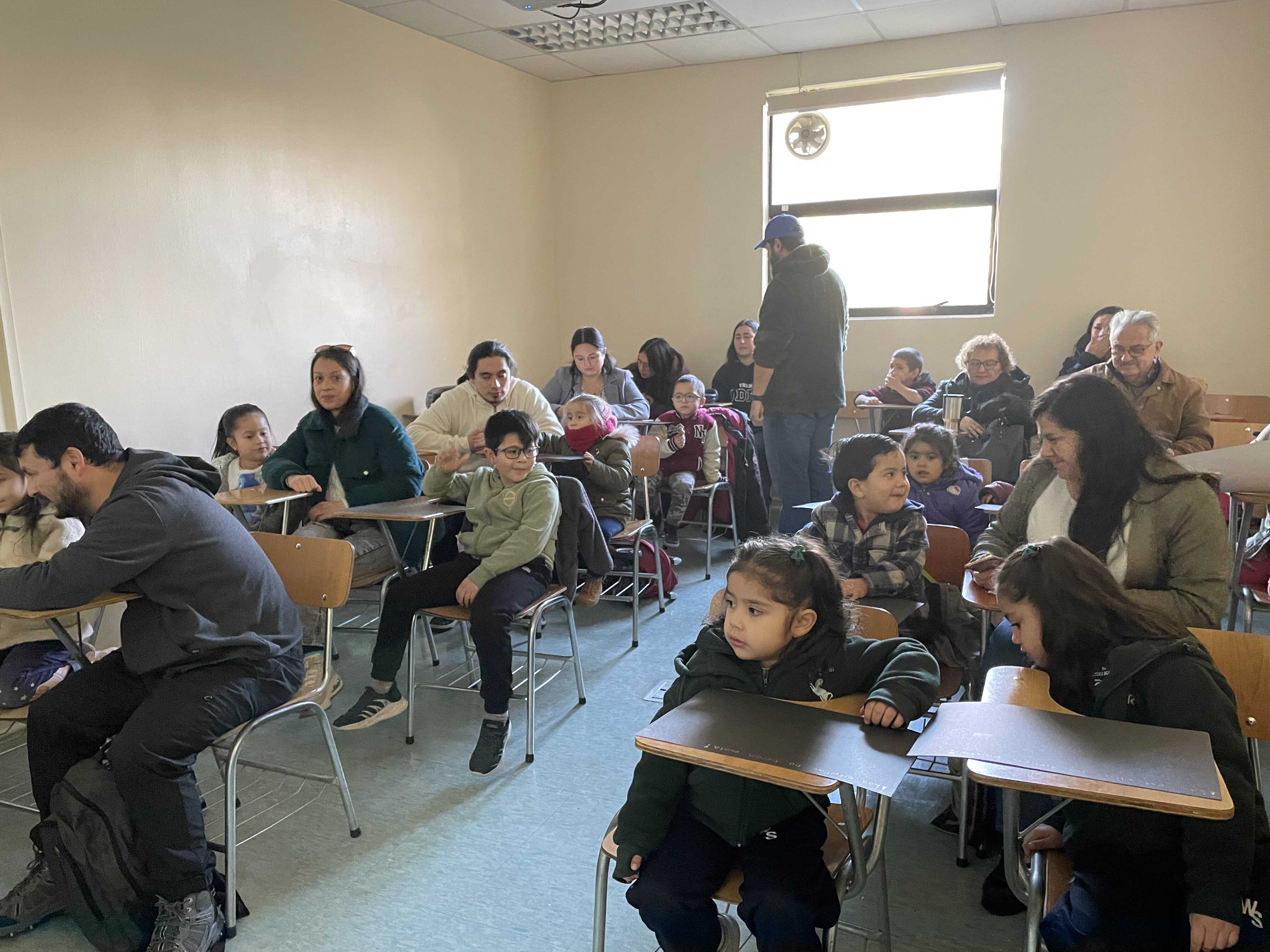
|
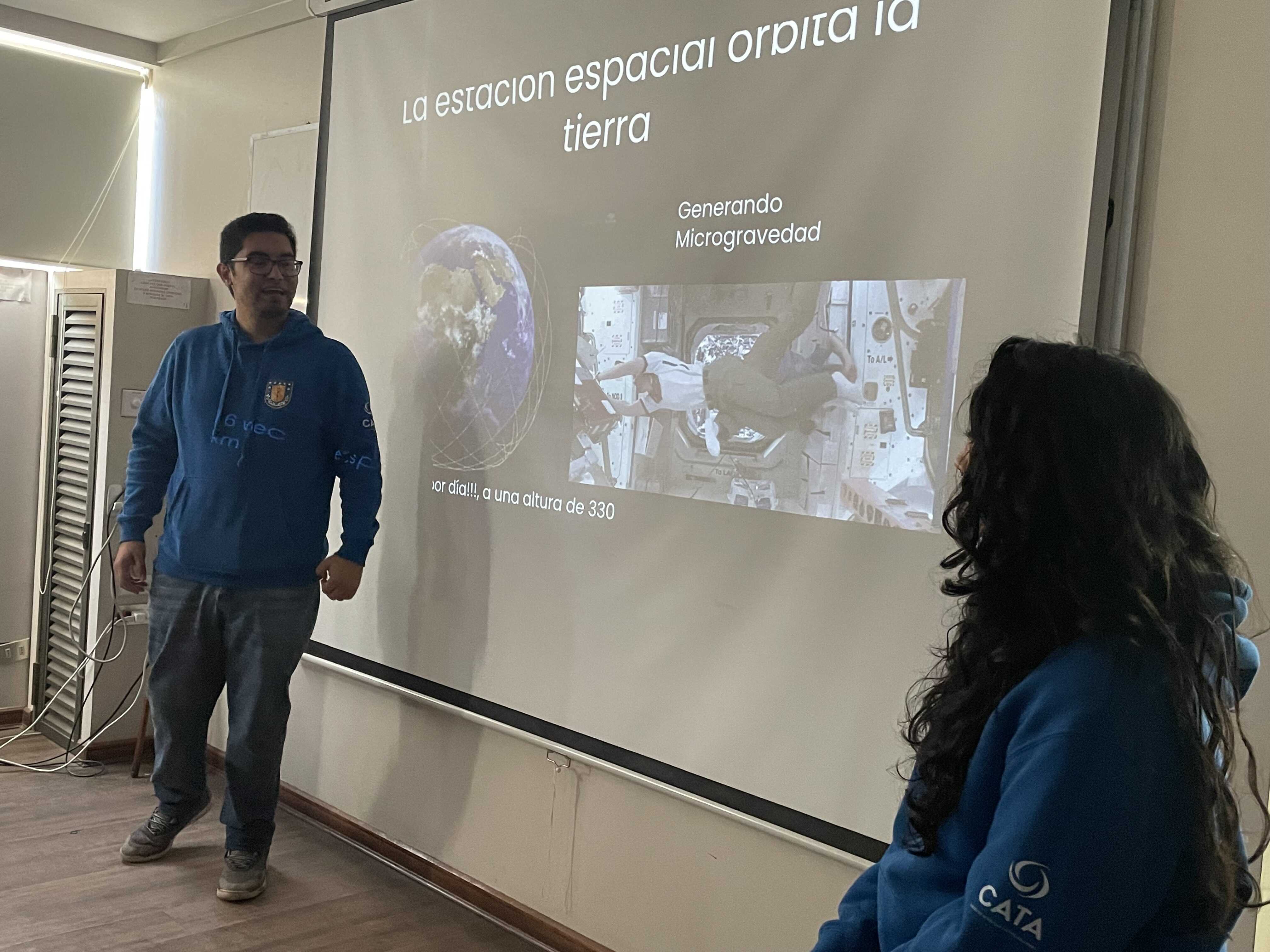
|

|
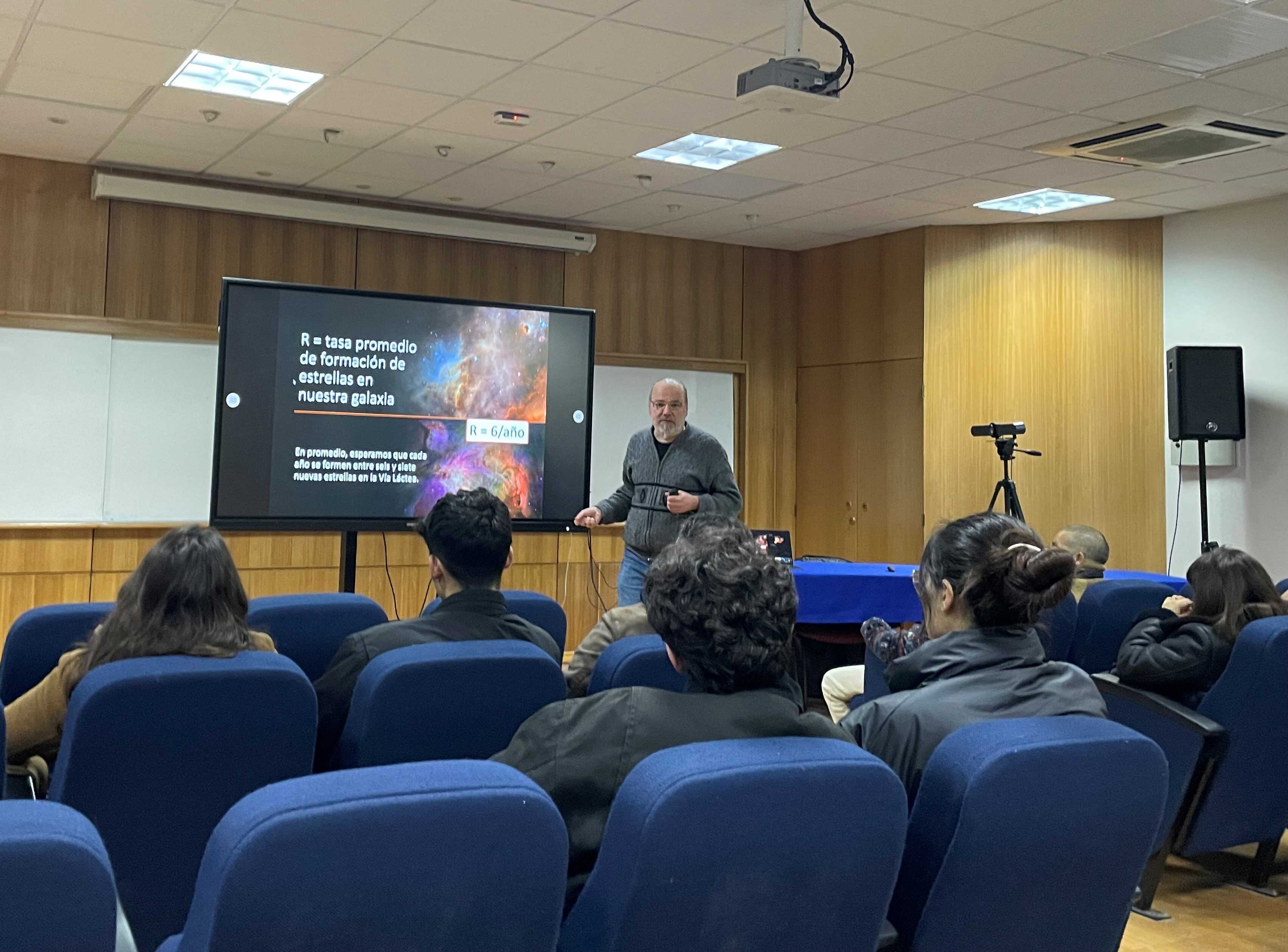
|
Celeste Burgos Badal
Department of Astronomy Communications
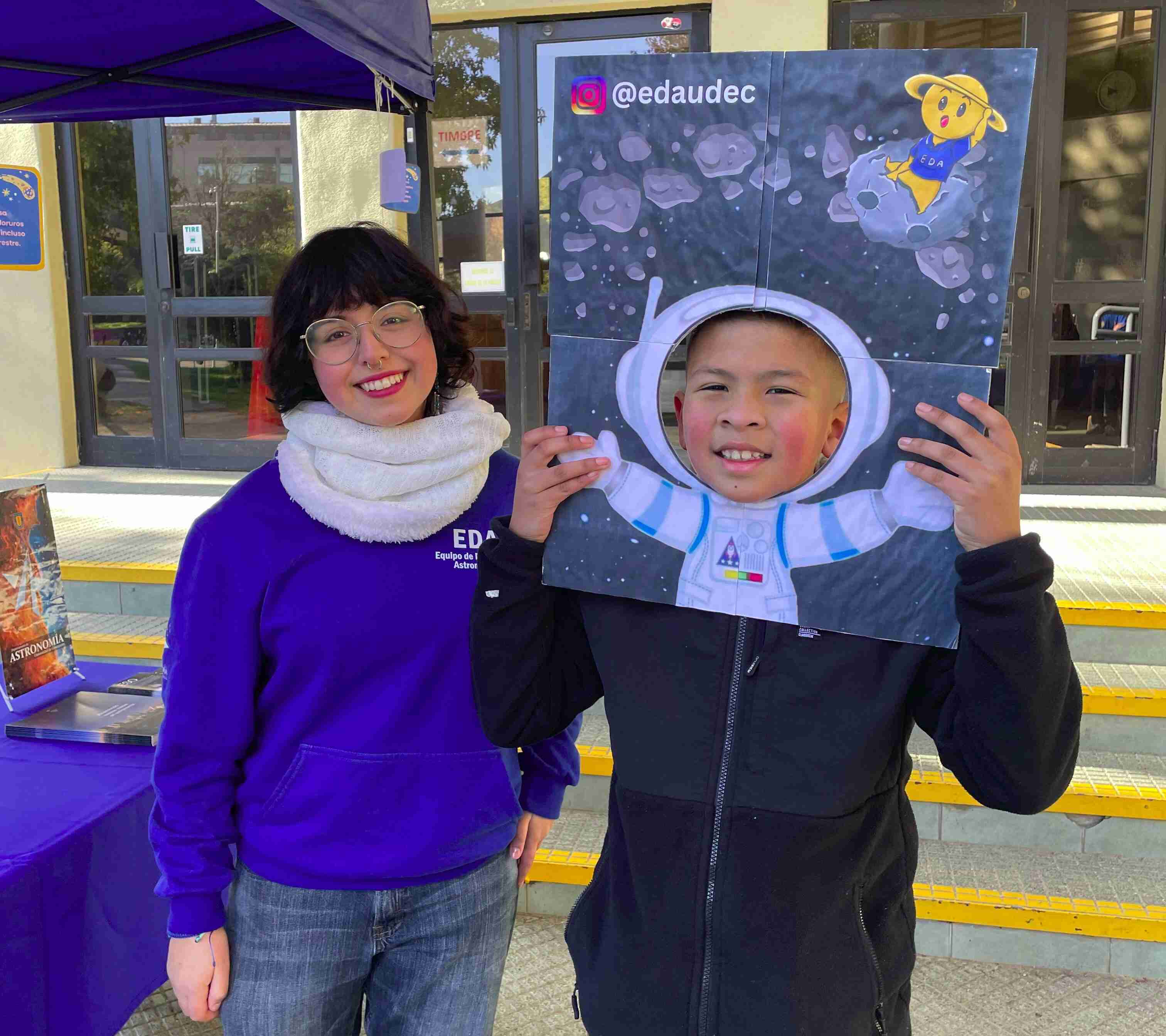
Concepcion, 28 June 2025
Astronomy Department invites the public to join asteroid day celebrations
- Featuring a themed fair and a free public talk, both taking place on the university premises
Nearly a decade ago, the United Nations General Assembly declared 30 June as Asteroid Day, with key advocates including Brian May, astrophysicist and guitarist of the band Queen, alongside other prominent scientific figures. This date aims to raise public awareness about the risks posed by asteroid impacts on our planet and to inform about the communication measures that would be taken worldwide in the event of a crisis. In this context, the Department of Astronomy at the University of Concepcion (UdeC) has prepared a long list of engaging activities for this weekend, open to the public.
The invitation is for Saturday, 28 June, starting at 11:00 am, when a themed fair will open outside the Faculty of Physical and Mathematical Sciences at UdeC. The fair will feature various game stations specially prepared for the occasion by the department’s Astronomy Outreach Team (EDA in spanish). It will remain open to all visitors — both adults and children — for four and a half hours, concluding at 3:30 pm the same day.
However, that is not all, as at noon, at 12:00 pm, the talk “Asteroid Hunters” will be held in the Auditorium of the Department of Astronomy. The talk will be delivered by David Arroyo Reyes, Project Coordinator at the Center for Astronomical Instrumentation (CePIA). During this educational session, attendees will learn about the key technologies humanity currently possesses to detect, track, and characterise near-Earth asteroids. Additionally, the talk will explore how science enables us to understand their speed, size, composition, and even their potential for space mining.
This event is part of the ongoing efforts by the Department of Astronomy to bring this science closer to the public, reinforcing outreach through games, exhibitions, and many other activities. Both the fair and the talk are completely free and require no prior registration, making this an excellent opportunity to come and enjoy learning about asteroids with the whole family.
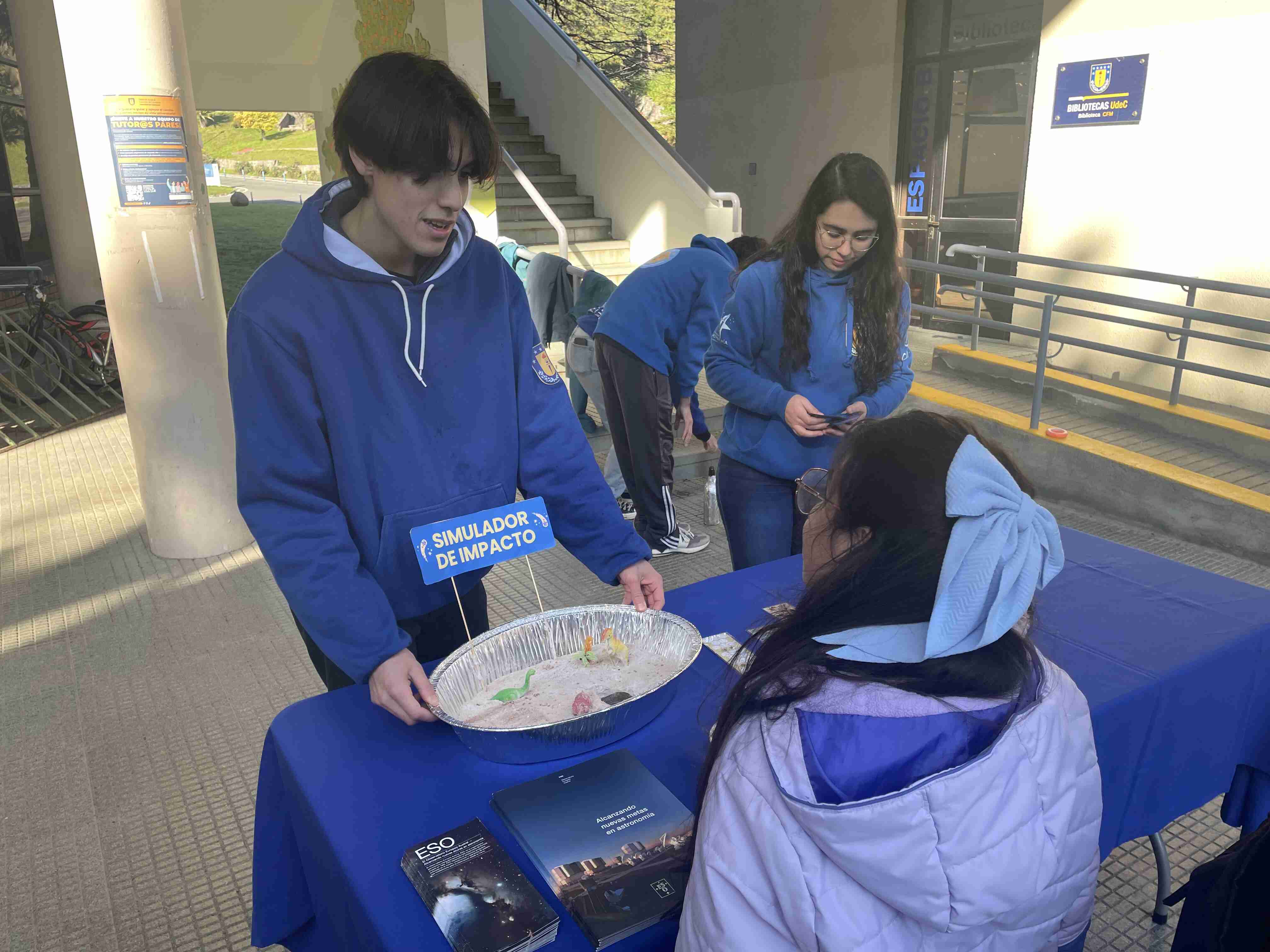
|
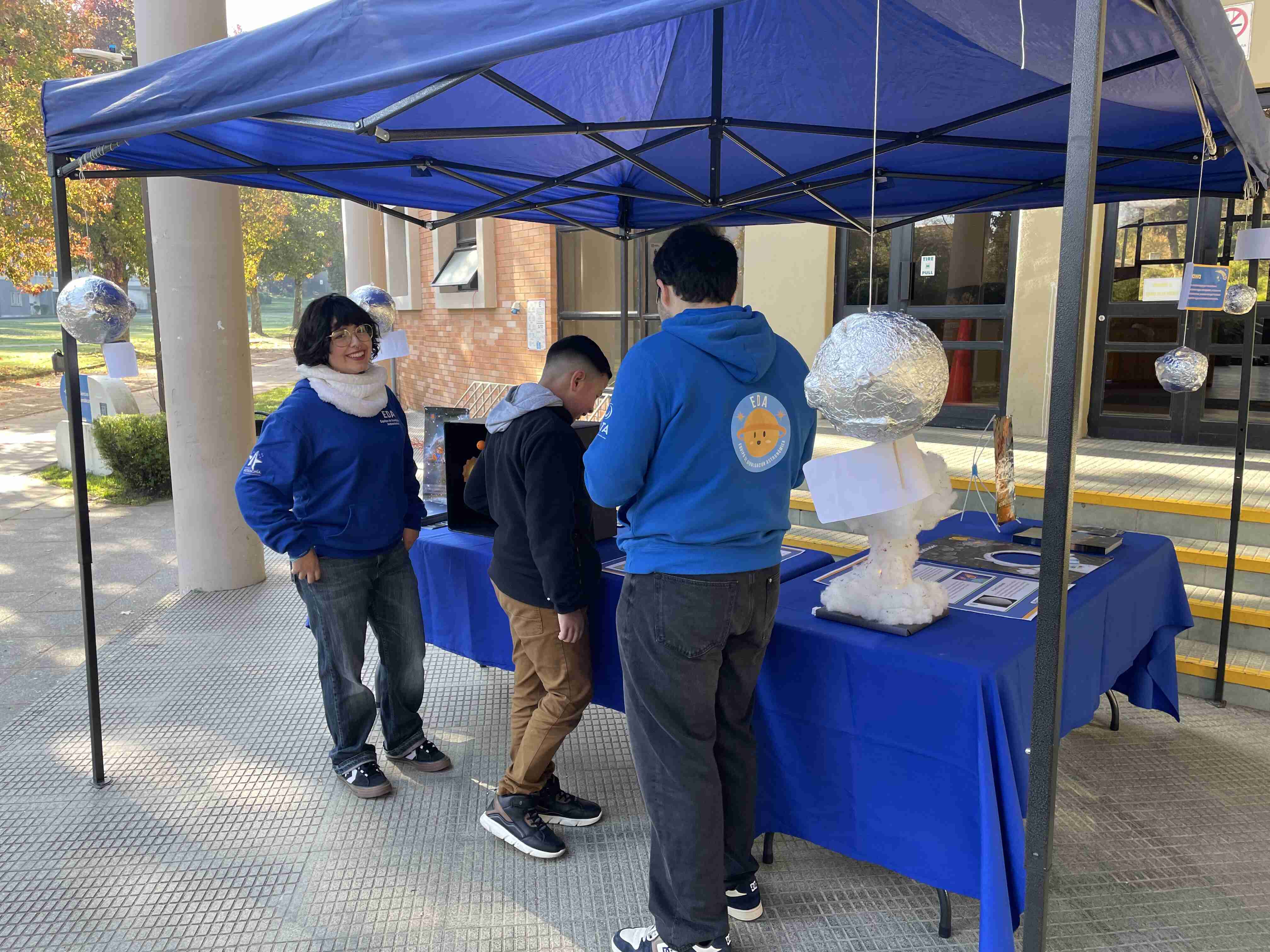
|
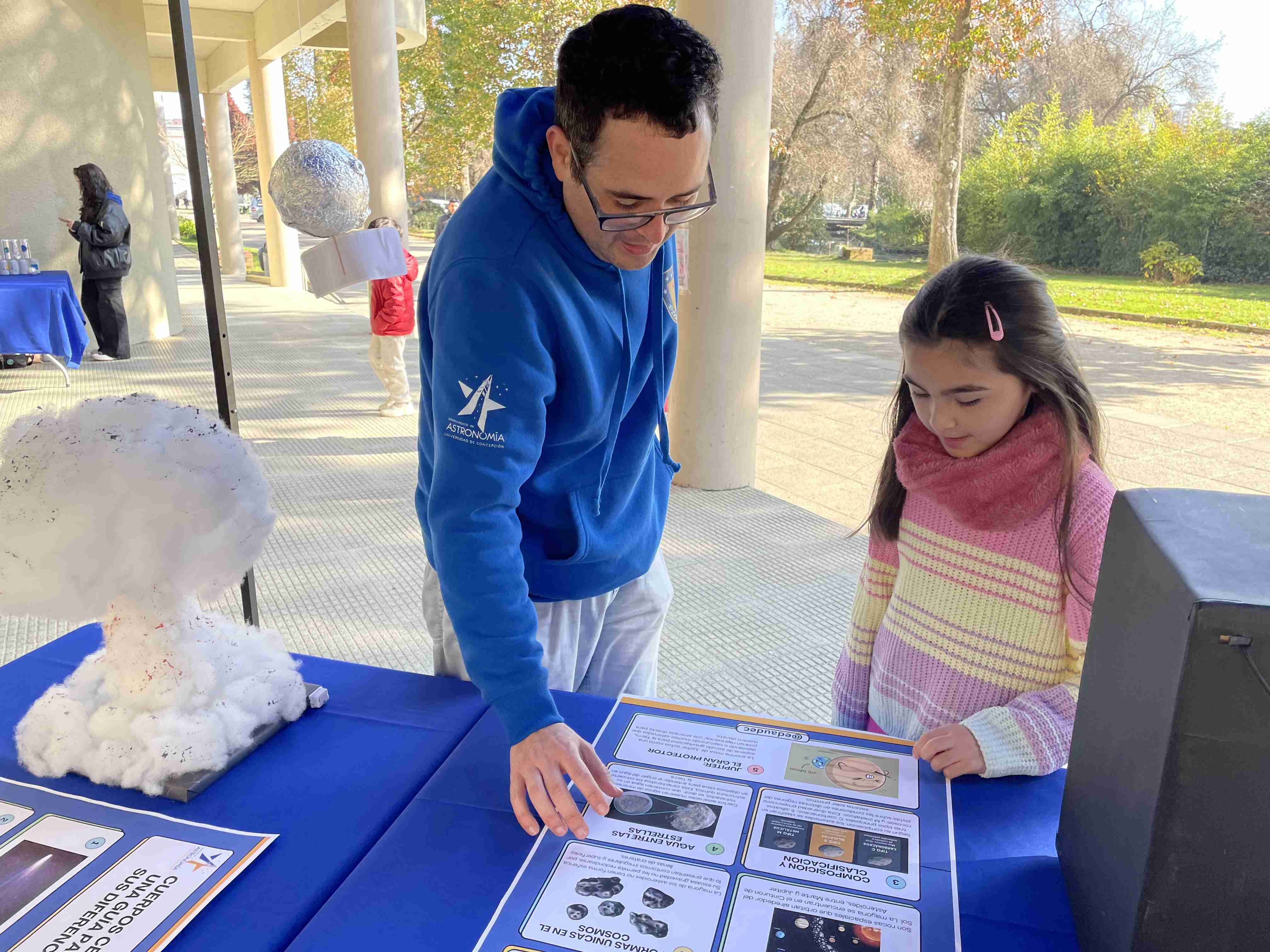
|
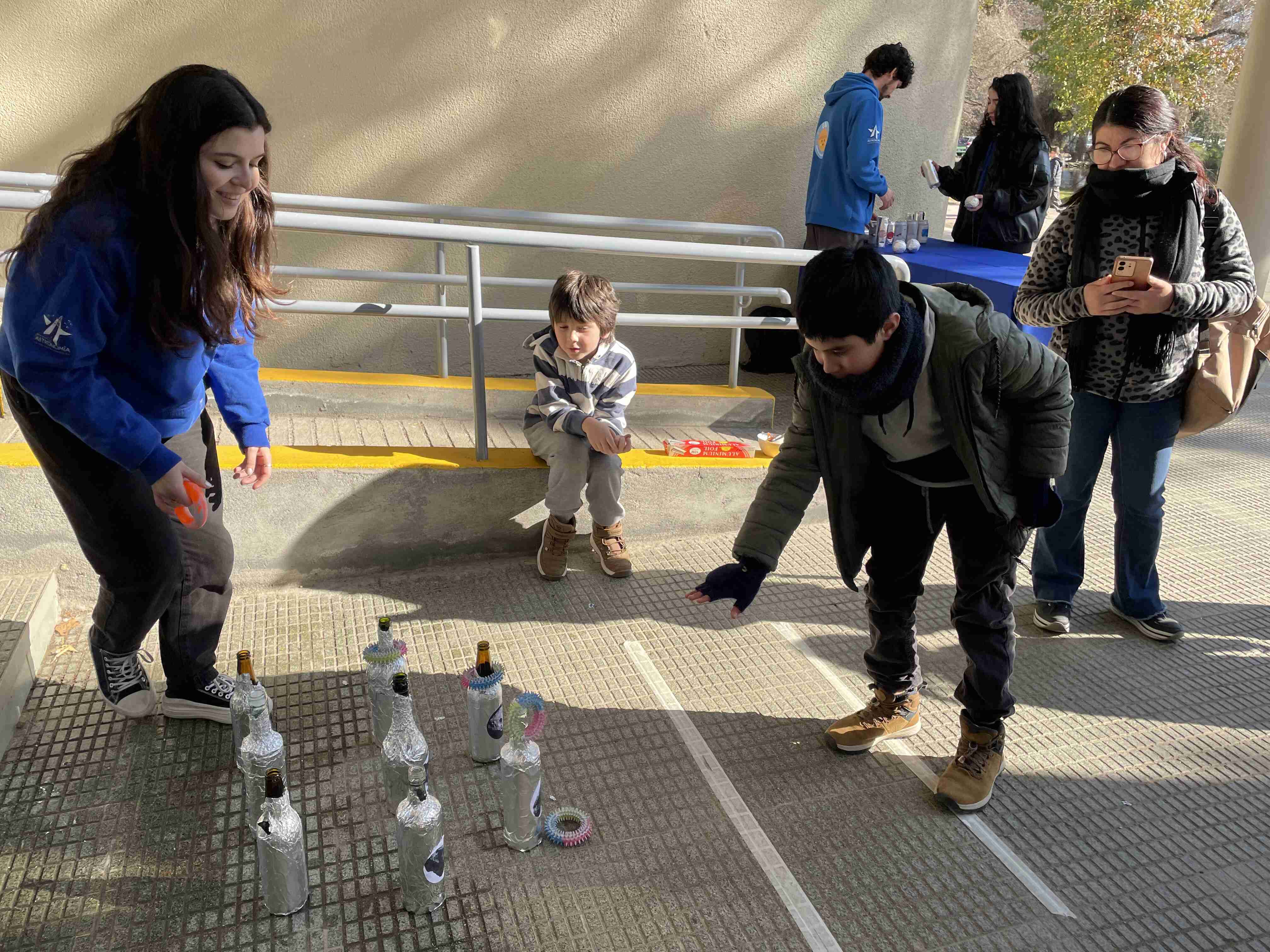
|
Celeste Burgos Badal
Department of Astronomy Communications
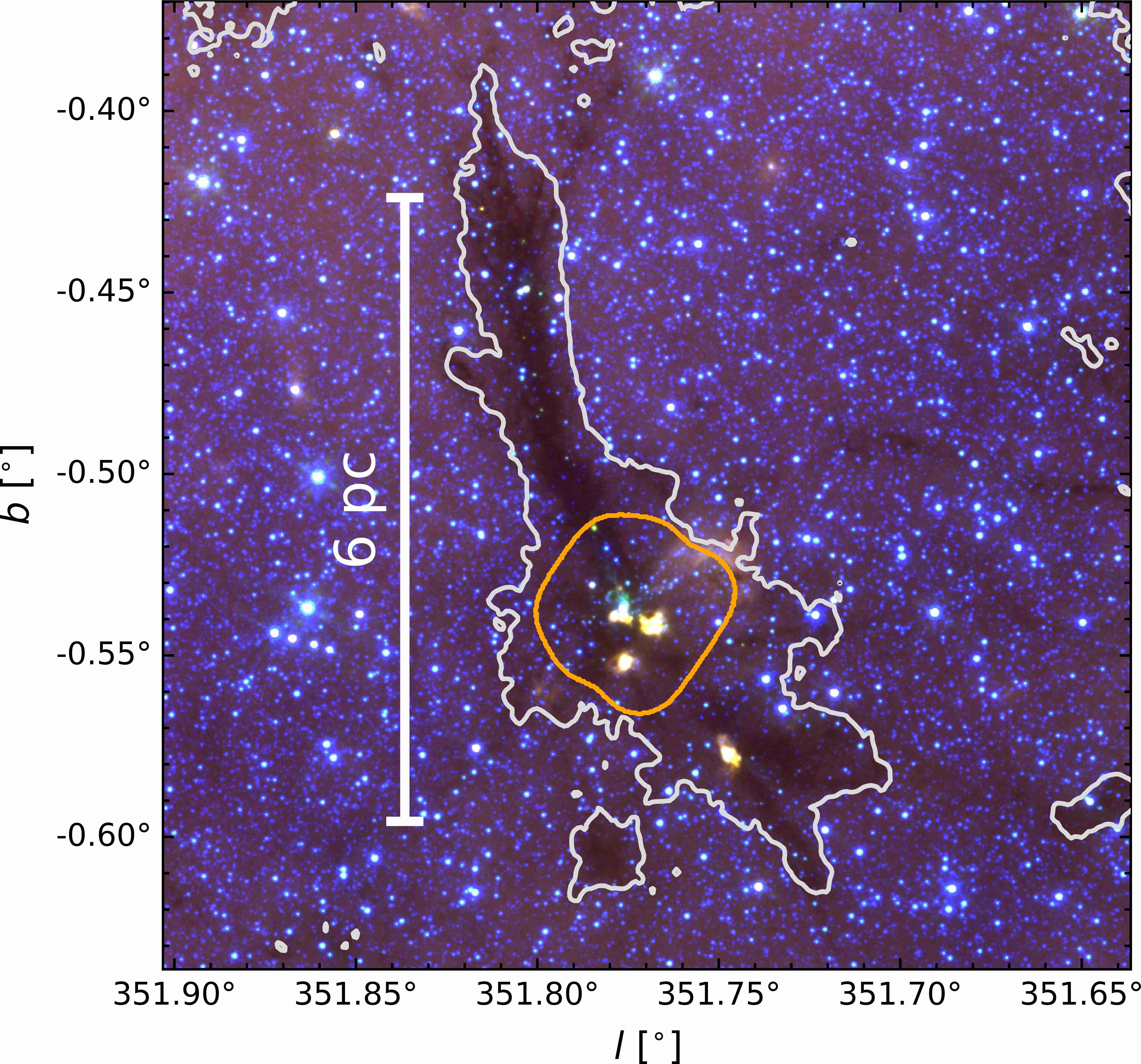
Concepcion, 25 June 2025
Study by young Chilean astronomer reveals new key parameter for understanding star formation
- The research, published in the journal Astronomy & Astrophysics, has national astronomer Nicolás Sandoval as lead author. The study focuses on the massive stellar protocluster G351.77, located about 6,500 light-years from Earth.
An international team of astronomers has identified a new parameter that could contribute significantly to the study of star formation. The research is led by Chilean Nicolás Sandoval, PhD student at the Center for Astrophysics and Related Technologies (CATA) and astronomer at the Universidad de Concepción (UdeC). The study was also led by Amelia Stutz, Principal Researcher at CATA and academic at UdeC.
The research focuses on the protocluster G351.77, a compact region approximately 3 light-years in diameter within a nebula, dominated by cold, dense gas. In these areas, known as massive protoclusters, the conditions necessary for the birth of new stars are found, and they are considered to be the first stages in the formation of massive star clusters.
The study, entitled “ALMA-IMF. XVIII. The assembly of a star cluster: Kinematics of dense gas in the massive protocluster G351.77,” was recently published in the journal Astronomy & Astrophysics. It analyzed the motion of gas within this “star nursery” using observations obtained with the Atacama Large Millimeter/submillimeter Array (ALMA) radio telescope, located in northern Chile.
The team discovered the presence of V-shaped structures, called V-shapes, which indicate how gas moves toward denser regions called “dense cores,” where stars are born. These structures act as channels that continuously feed the forming cores. “From measurements of collapse rates and total gas mass, we infer that the protocluster is continuously fed with gas from the surroundings, suggesting that it assembles ‘from the outside in,’” explains Nicolás Sandoval, lead author of the study.
In simple words: the protocluster, containing a large mass, generates a strong gravitational attraction that causes the surrounding gas to collapse towards the denser zones. This process is key to star formation.
The finding of these structures, also known as V-shapes, is not only relevant for understanding the internal dynamics of these regions, but could also become a new tool for identifying the evolutionary stage of star-forming regions. “This is because more evolved regions do not seem to present a large number of these structures, while they are observed in young regions,” adds Sandoval.
The study involved leading researchers from national and international institutions: Rodrigo Álvarez-Gutiérrez, Javiera Salinas and Atanu Koley (Universidad de Concepción); Simón Reyes-Reyes (Max Planck Institute for Astronomy, Germany); Roberto Galván-Madrid (UNAM, Mexico); Frédérique Motte and Fabien Louvet (Université Grenoble Alpes, France); Adam Ginsburg (University of Florida, USA) and Nichol Cunningham (SKA Observatory, UK).
For more than three and a half years, the team used advanced tools such as CASA software, specialized in the calibration and analysis of radio astronomy data, and Position-Velocity diagrams, which allow observing how gas moves in a specific region. These diagrams are fundamental to reveal processes such as collapse, rotation or gas outflows.
The next step, according to Sandoval, will be to apply this methodology to new ALMA observations covering the entire star-forming region that hosts the G351.77 protocluster, in order to better understand the impact of the environment on the early evolution of stars.
More information: article
Celeste Burgos Badal
Comunicaciones Astronomía UdeC

Concepcion, 9 June 2025
Monthly public skywatching evenings successfully resumed
- On 5 June 2025, the Department of Astronomy at the University of Concepcion launched the Night-time Astronomical Observation Sessions.
This initiative aims to provide an on-site space for scientific outreach, where the Outreach Team offers attendees scientific content and access to telescopes for observing astronomical objects visible at the time of each session — all free of charge and of a high standard.
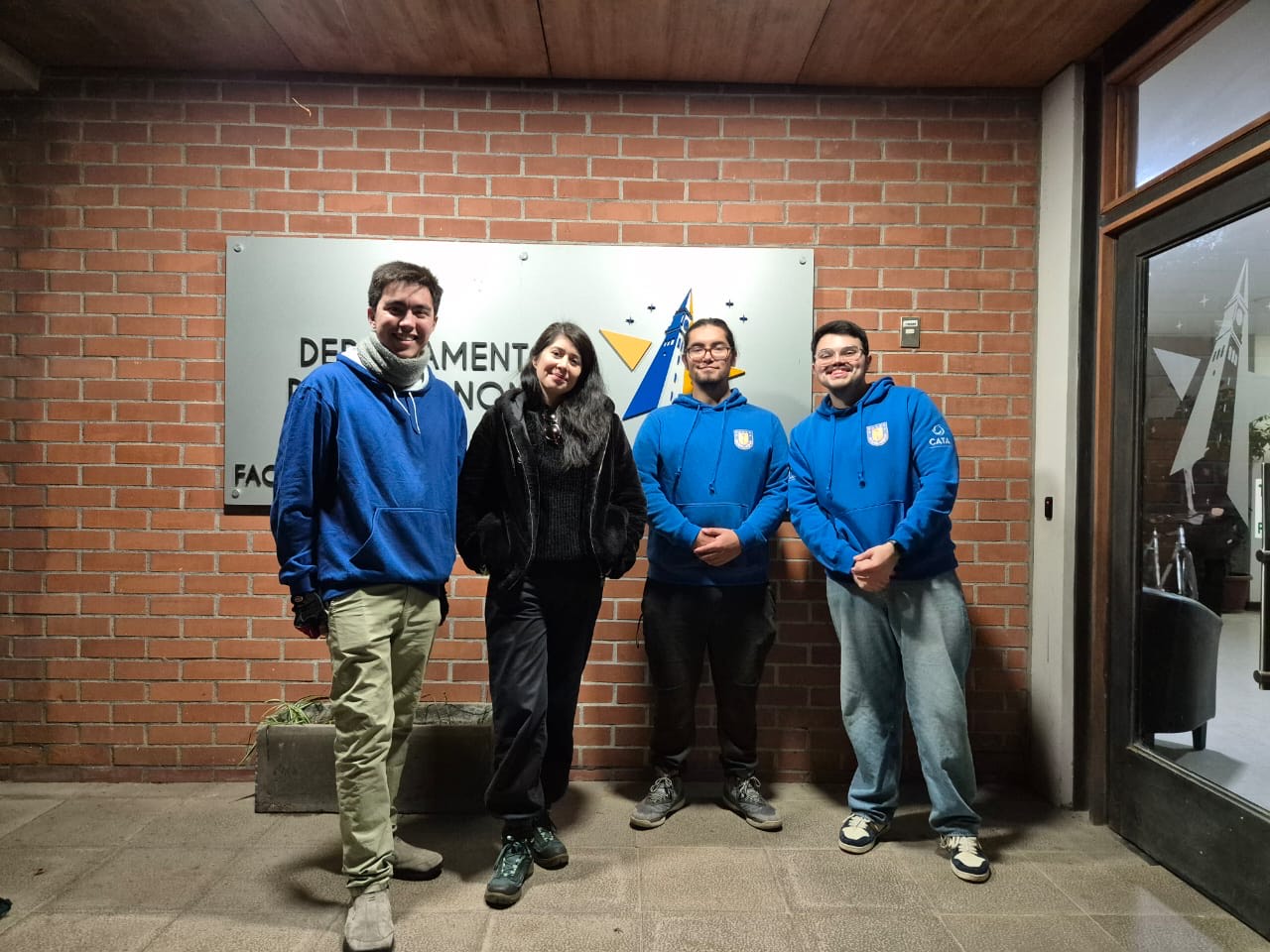
On this occasion, the activity — held on the terrace of the 6th floor of the Faculty of Physical and Mathematical Sciences at the University of Concepcion — took place with prior registration, filling all available places and welcoming all registered participants. Attendees had the opportunity to learn more about the constellation Orion, observe the Moon and the planet Mars, and even ask the organising team questions about to the telescopes being used.
The event was coordinated by Celeste Burgos, in charge of the communications of Astronomy UdeC and Outreach Coordinator at the Center for Astrophysics and Related Technologies (CATA), along with Nikola Salazar, Andrés Fuentes, and Agustín Gutiérrez from the UdeC Astronomy Outreach Team, who guided attendees throughout the activity.
The outreach activity is expected to continue on the 5th and 20th of each month.
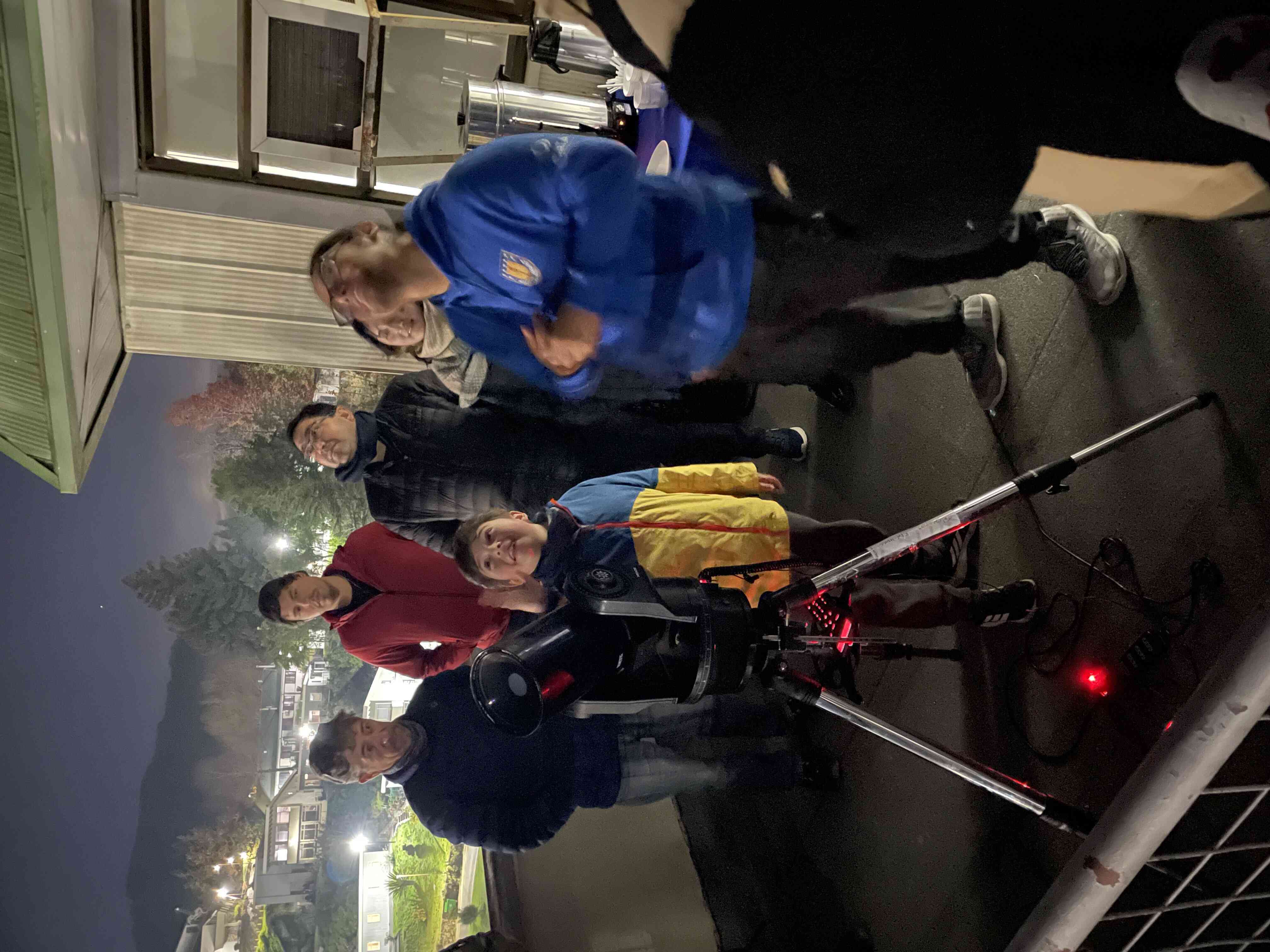
|
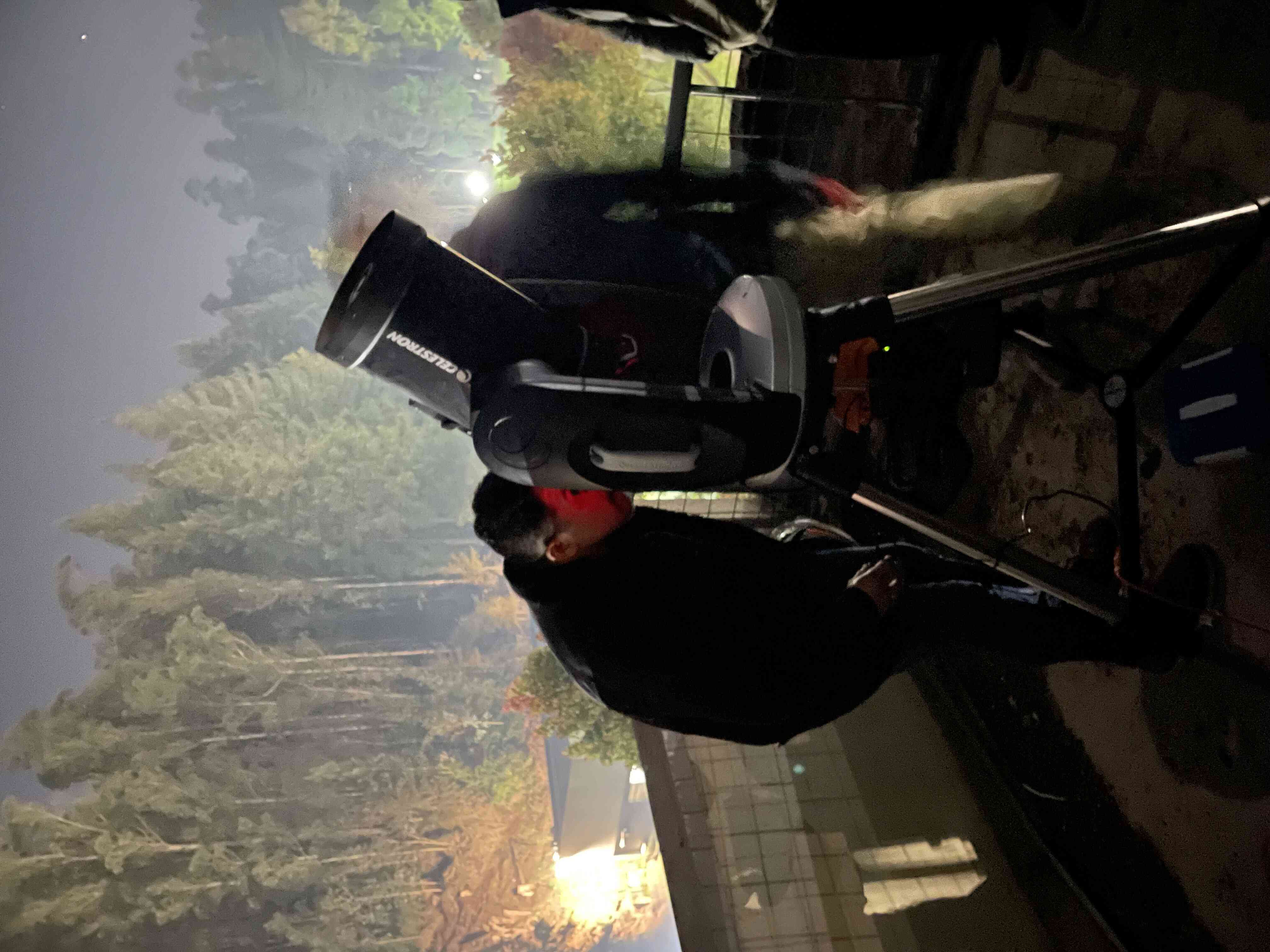
|
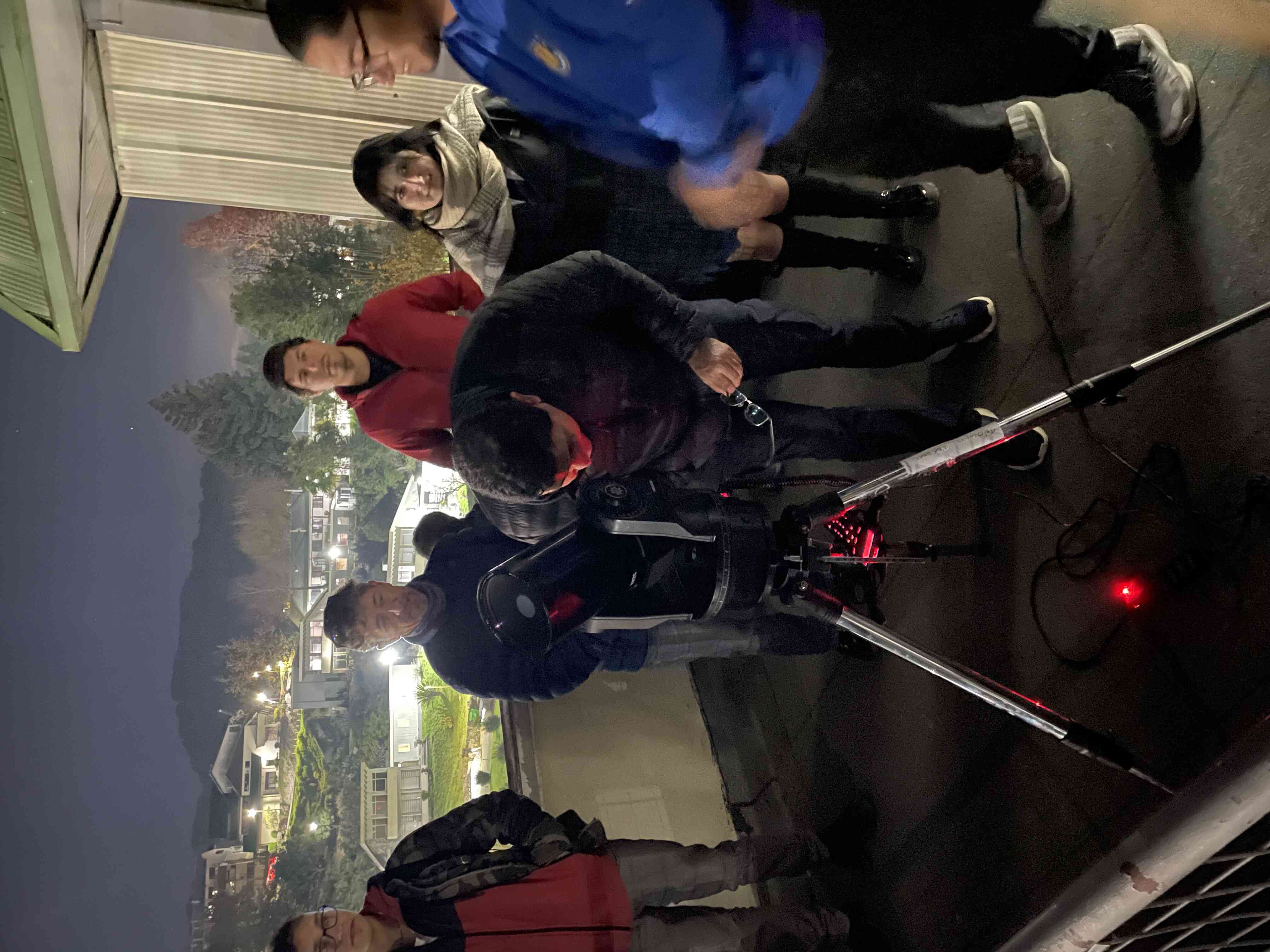
|
Celeste Burgos Badal
Department of Astronomy Communications
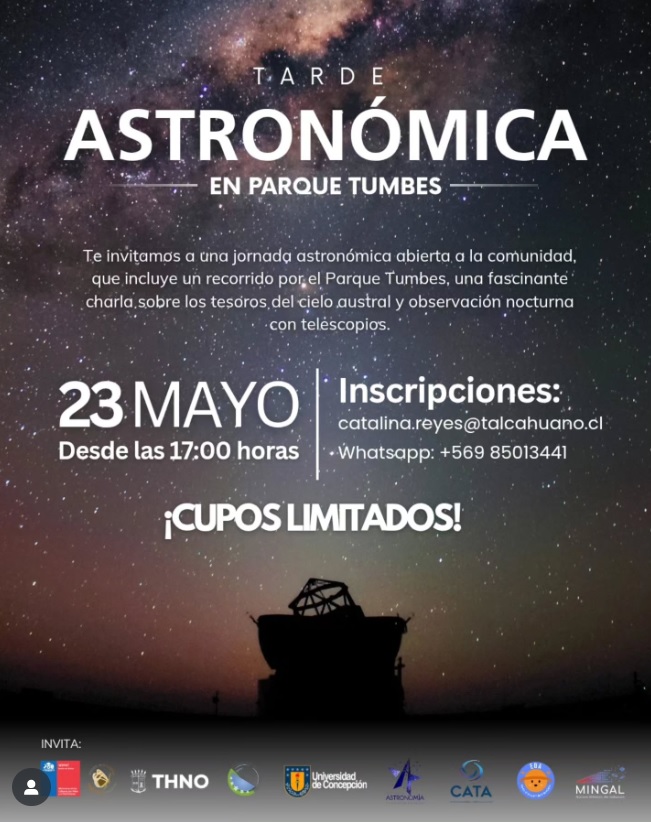
Concepcion, 26 May 2025
UdeC Astronomy joined the Día de los Patrimonios Celebrations in Biobío
- The Department of Astronomy at the University of Concepcion invited the community to celebrate the Día de los Patrimonios with activities designed to bring stellar knowledge closer to the public in an engaging and educational way. The activities were free of charge and took place in Talcahuano.
As part of the national celebration of the Día de los Patrimonios, an Astronomical Session was held on Friday 23 May from 5:00 p.m. at Parque Tumbes. The event was the result of a collaboration between UdeC Astronomy, the Museum of Natural History, and the Municipality of Talcahuano. The activity included a guided walk through the park to learn about its local flora and fauna, as well as the talk “Treasures of the Southern Sky”, presented by Dr. Rodrigo Herrera-Camus, Director of the Millennium Nucleus of Galaxies (MINGAL) and Associate Researcher at the Center for Astrophysics and Related Technologies (CATA).
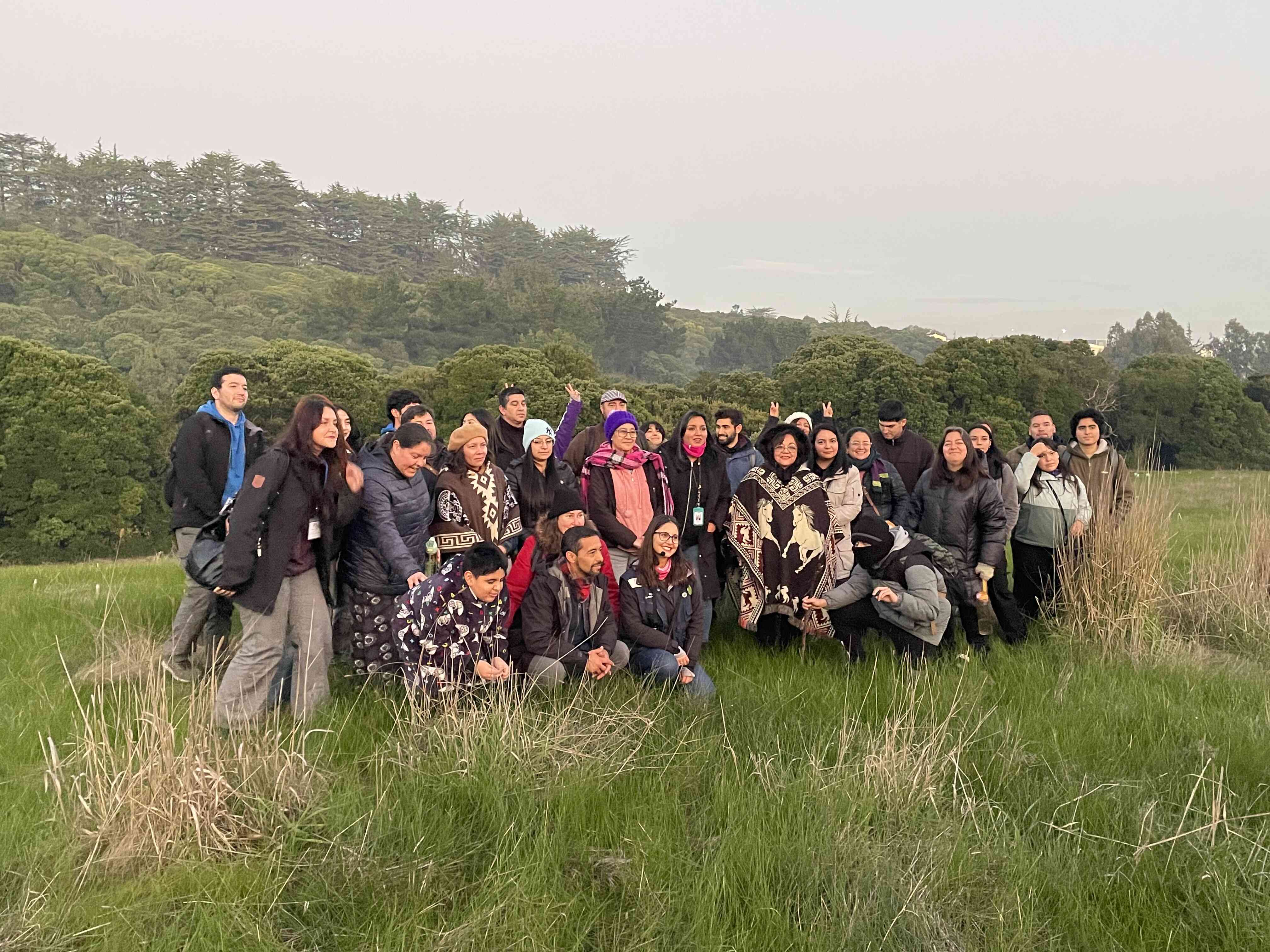
The talk focused on five treasures of the night sky: the iconic Southern Cross, the fascinating Magellanic Clouds, the dazzling centre of the Milky Way, the Pleiades star cluster, and the Orion Nebula. It explored how to identify them, their nature, and the significance they hold within the Mapuche worldview. The session concluded with a stargazing activity led by the Astronomy Outreach Team (EDA), during which several of the celestial bodies mentioned in the talk were observed. The event ended with an educational workshop entitled “Stellar Collision”, also carried out by the EDA.
“This event was very well received by the community, with all places fully booked. It offered attendees an opportunity to appreciate our heritage, made up of the region’s skies, flora, and fauna. We must remember that Chile is the world capital of astronomy, thanks to the quality of its skies — a heritage we must recognise and value as citizens,” said Celeste Burgos Badal, Outreach Coordinator at both the CATA and the Department of Astronomy at the University of Concepcion.
These institutional collaborations are expected to continue in the future, aiming to offer more free opportunities for learning and astronomical outreach.
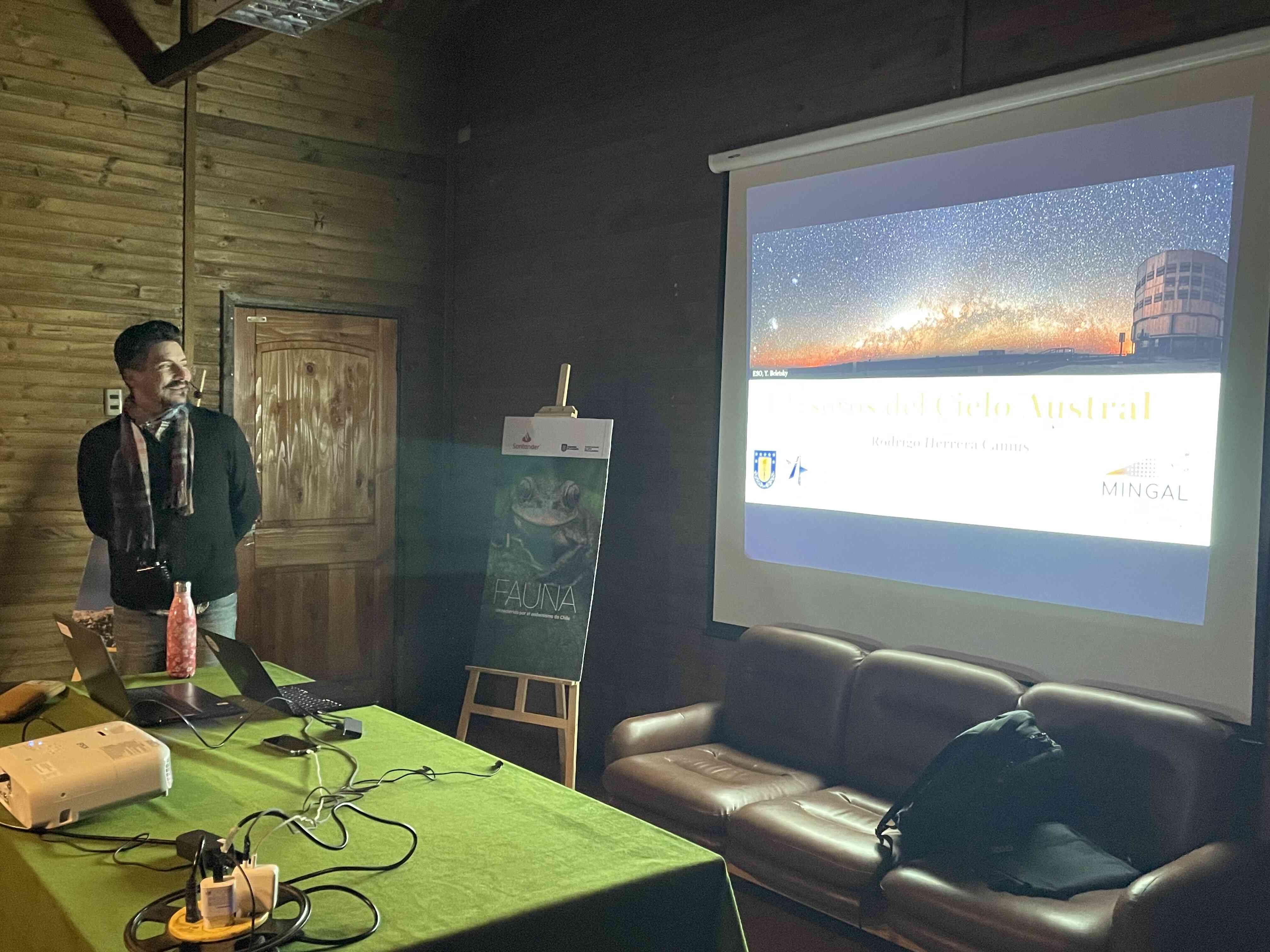
|
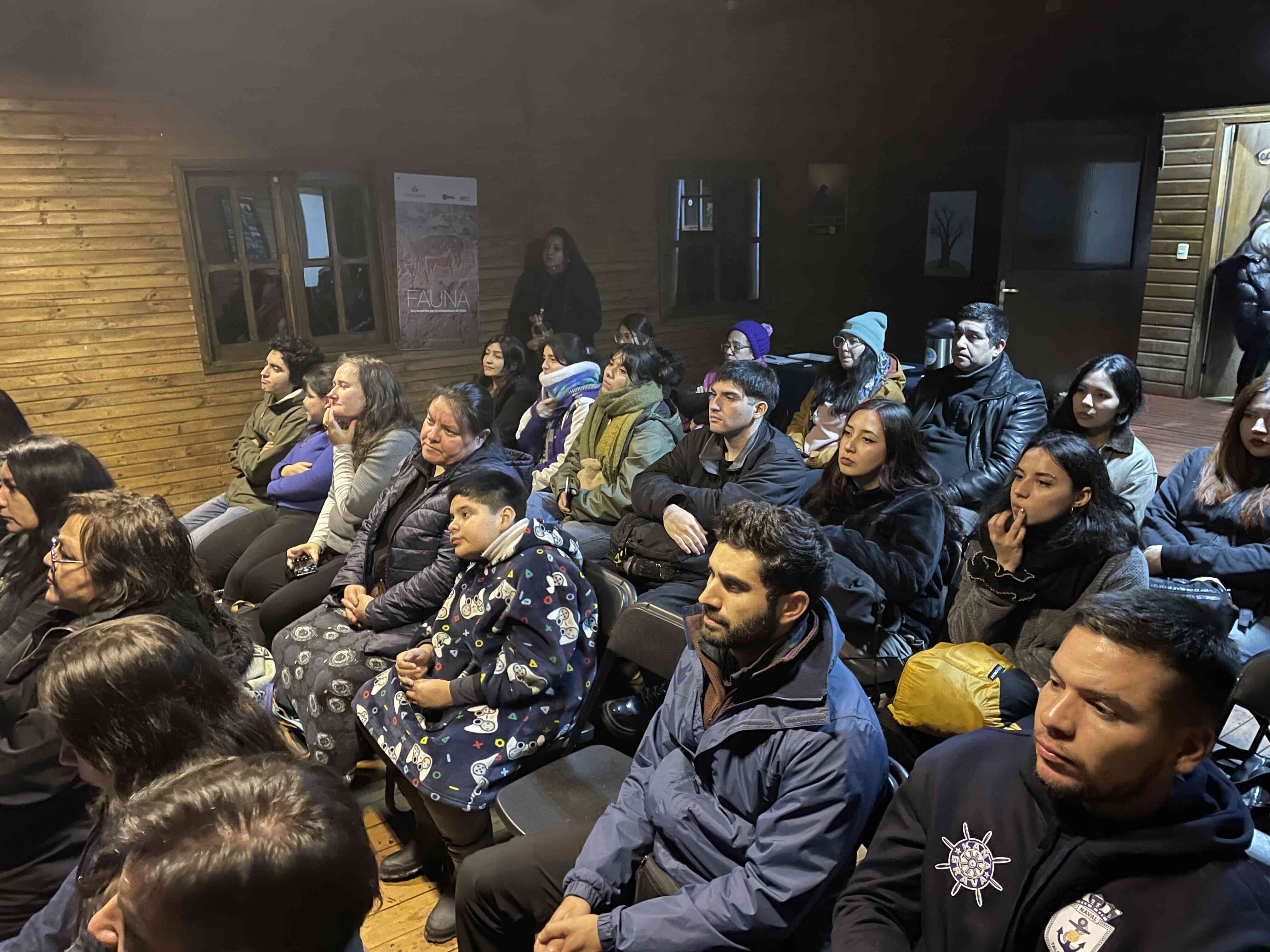
|
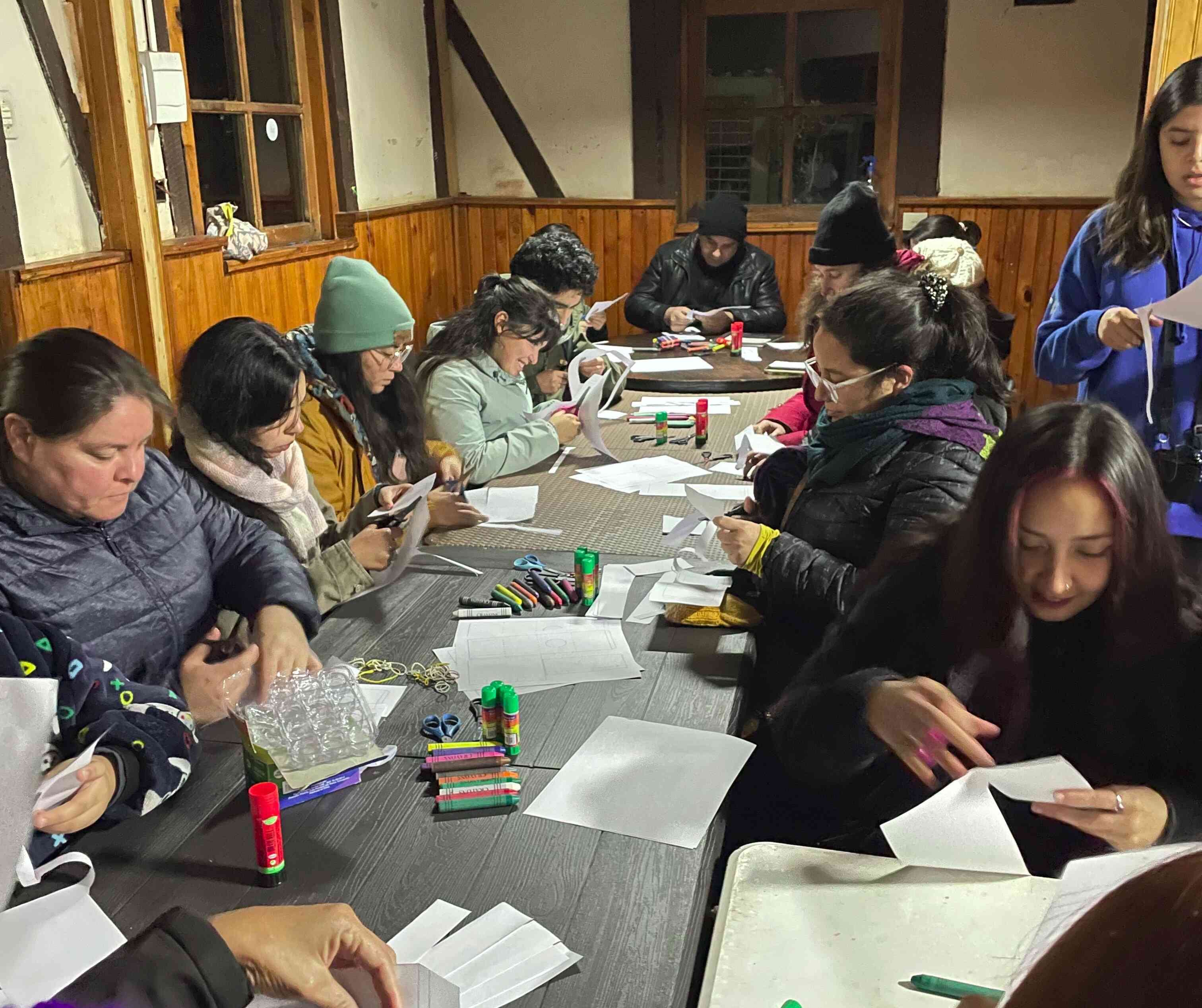
|
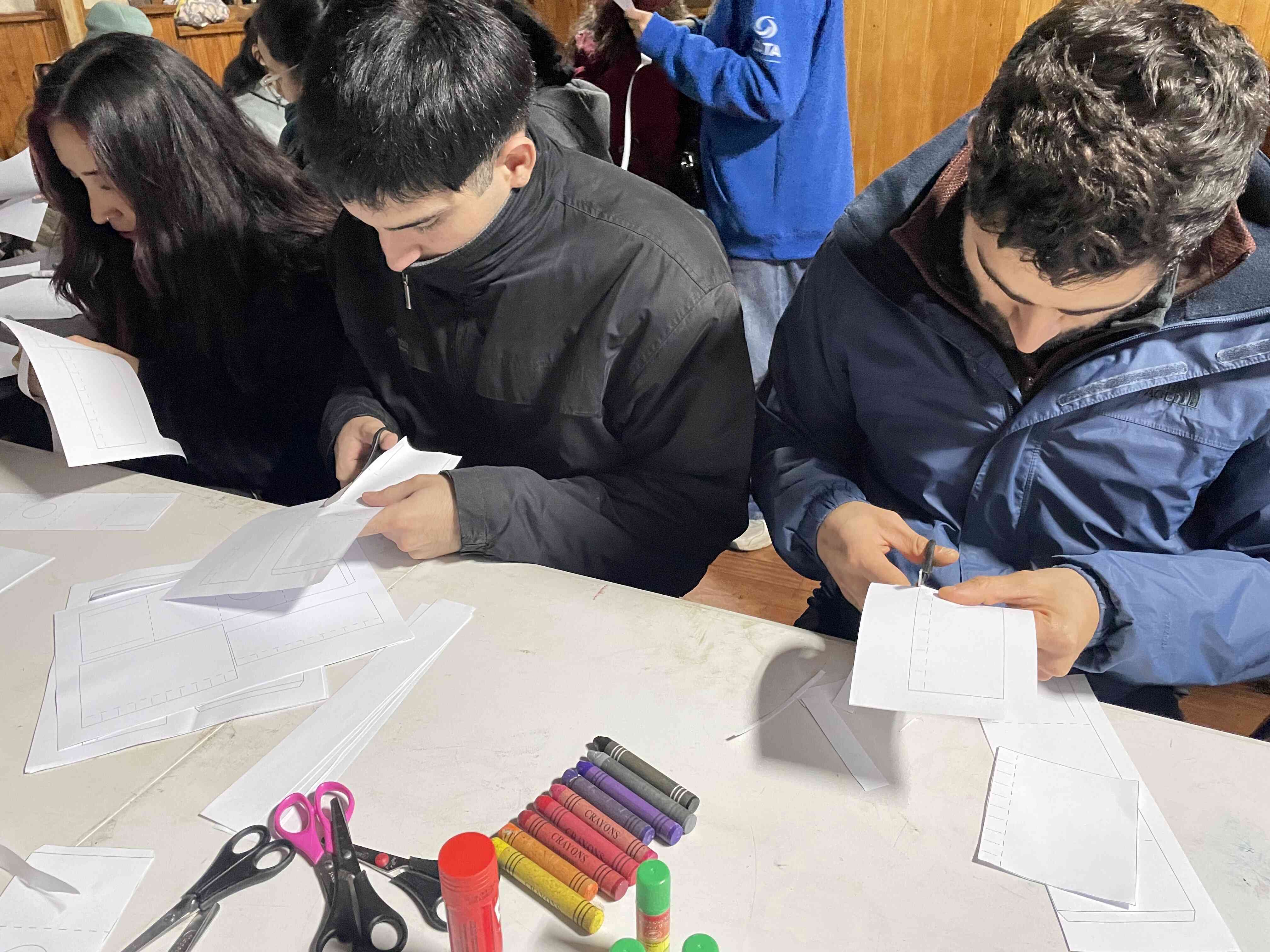
|
Celeste Burgos Badal
Department of Astronomy Communications
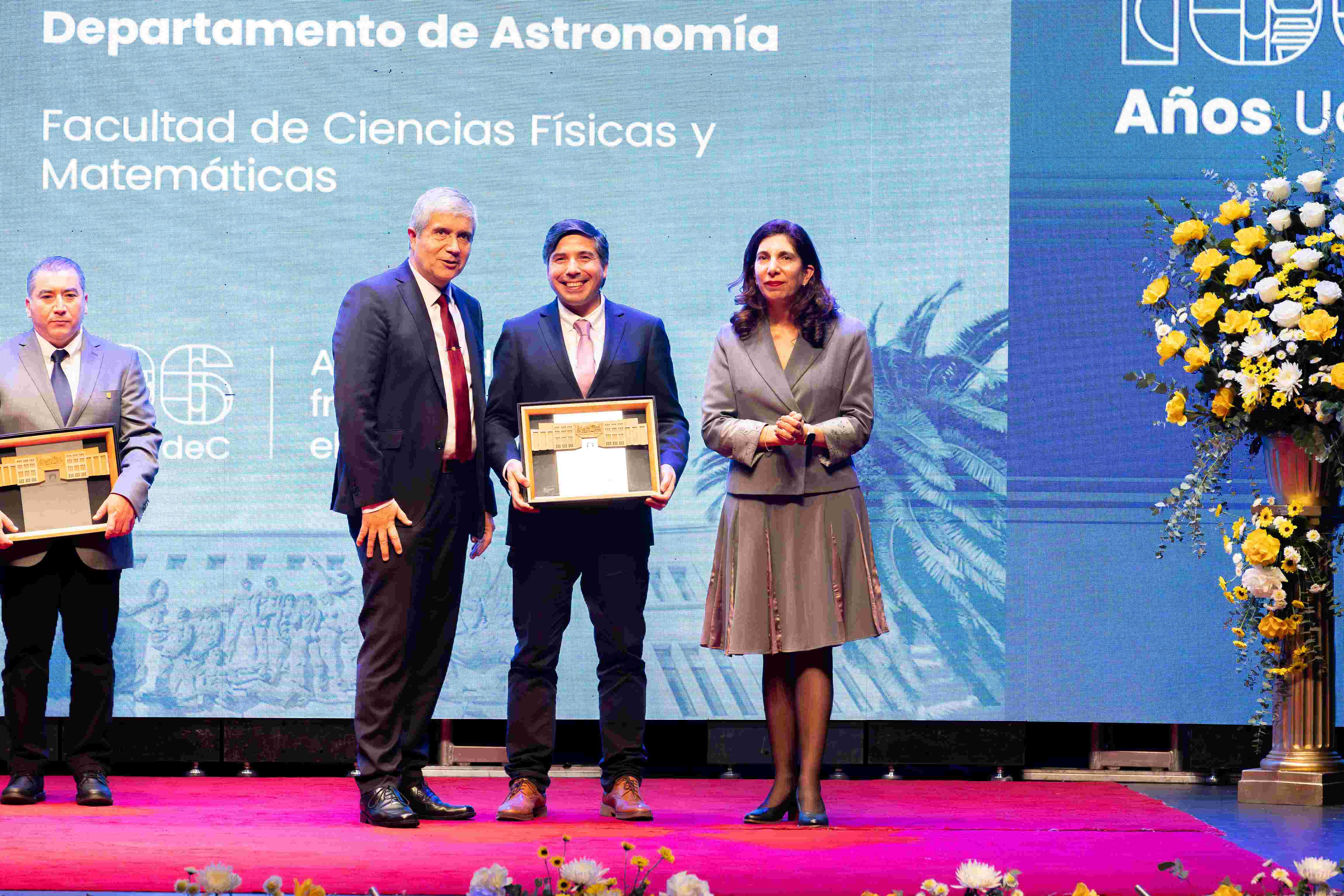
Concepcion, 19 May 2025
Dr. Rodrigo Reeves Appointed Full Professor at the Universidad de Concepción
- Rodrigo Reeves, PhD in Engineering, Associate Researcher at CATA and academic at Universidad de Concepción, was appointed full professor on a new anniversary of the university.
As part of the celebrations for a new anniversary, the Universidad de Concepción (UdeC) recognized the academics who in 2025 reached the rank of Full Professor, the highest within its teaching staff. Among them was distinguished Dr. Rodrigo Reeves, Associate Researcher of the Center for Astrophysics and Related Technologies (CATA) and academic of the university.

Professor Reeves is an Electrical Engineer and holds a PhD in Electrical Engineering from the Universidad de Concepción. He has dedicated his career to the development of radio astronomy and astronomical instrumentation, with postdoctoral training at the prestigious California Institute of Technology (Caltech). He currently participates in the Ministerial Advisory Commission on Areas of Scientific and Research Value for Astronomical Observation of the Ministry of Science, and serves as professor of the Department of Astronomy of the UdeC, head of career and director of the laboratory CePIA (Center for Astronomical Instrumentation).
The researcher of our Center deeply valued this new milestone in his academic career. “I consider this appointment quite significant both in my personal and academic development. It is a recognition to the trajectory where everything weighs: teaching, research, student training and linkage with the environment. I also receive this recognition from my alma mater, which has a special flavor. It is quite exciting,” said Reeves.
Regarding the impact that this recognition can have on his role within CATA, the engineer emphasized that it reinforces the prestige and projection of the center. “It validates the excellence of the scientific staff and attracts international collaborations. It also enhances the Center’s capacity to lead high-impact projects and makes it possible to apply for competitive funds that require demonstrating a consolidated track record,” he explained.
For the researcher, this new academic role also opens opportunities to strengthen the training of new generations and deepen links with foreign centers. “It will generate synergies with other universities, both in training and student mobility and in joint participation in projects. This will consolidate CATA’s leadership and influence at national and international level,” he concluded.

|
Celeste Burgos Badal
Department of Astronomy Communications
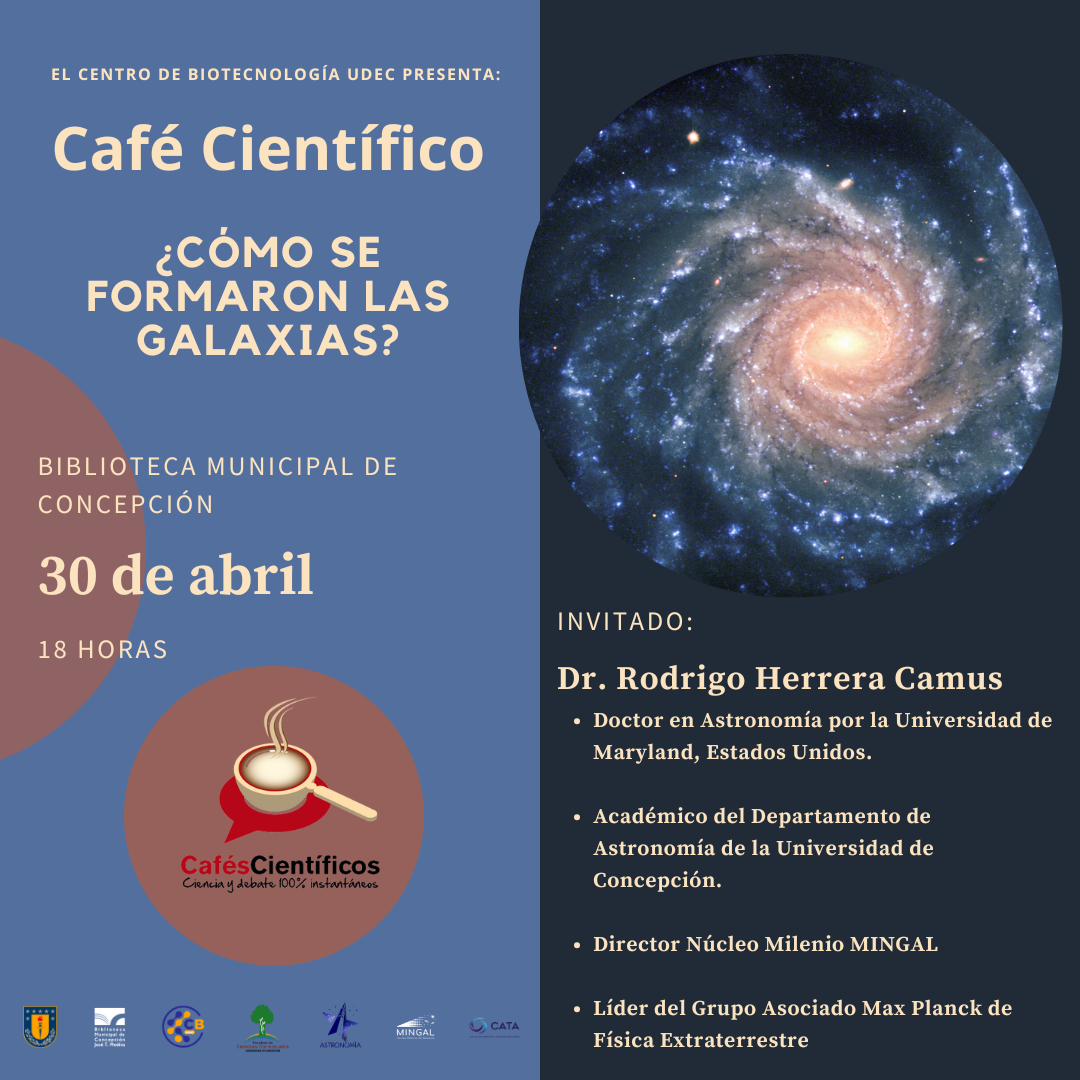
Concepcion, 2 May 2025
Scientific Coffee Series 2025 kicks off with a talk on Galaxy Formation
- Dr. Rodrigo Herrera Camus opened this year’s science outreach series with a talk entitled “How Do Galaxies Form?” at the Municipal Library of Concepcion.
The first presentation of the 2025 Scientific Coffee lecture series took place on 30 April, organised by the Biotechnology Center of the University of Concepcion (UdeC) in collaboration with the Municipal Library of Concepcion and the UdeC Department of Astronomy.
The event brought a large audience, with 170 people attending the talk How Do Galaxies Form? which explored the formation of these vast stellar and planetary systems. The presentation also provided engaging educational content on their composition and highlighted their significance for the advancement of astronomical research.

The talk was delivered by Dr, Rodrigo Herrera Camus, academic at the Department of Astronomy of the University of Concepcion, who is also a researcher at the Center for Astrophysics and Related Technologies (CATA) and Director of the Millennium Nucleus of Galaxies (Mingal).
Regarding the importance of this type of activity, Dr. Herrera stated: “I believe these are an excellent opportunity to share the science being carried out at the university. Many of these research projects are funded with public funds, so I see it as both highly positive and a meaningful responsibility to be able to share current scientific discoveries with the community. At the same time, it is also a chance to inspire new generations of scientists to go even further — reaching corners of the universe that are, as of now, even more hidden than those discovered to date,” said the researcher, who also leads the Group Associated with the Max Planck Institute for Extraterrestrial Physics.
This inaugural talk of the 2025 Scientific Coffee series is expected to encourage more people to take part in science outreach events open to the entire community, providing valuable knowledge to those interested in the wide range of topics that will be explored in upcoming sessions.
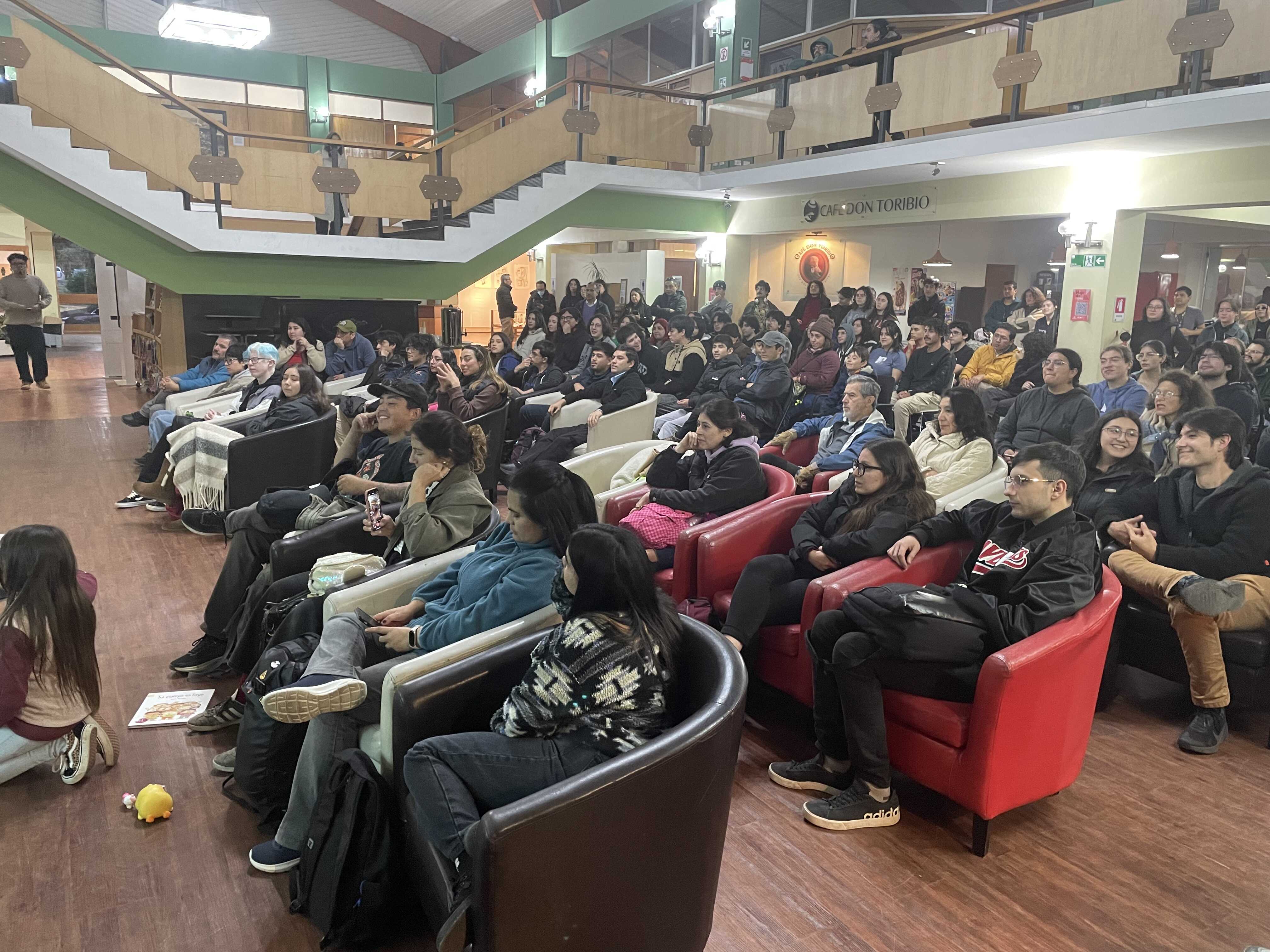
|
Celeste Burgos Badal
Department of Astronomy Communications
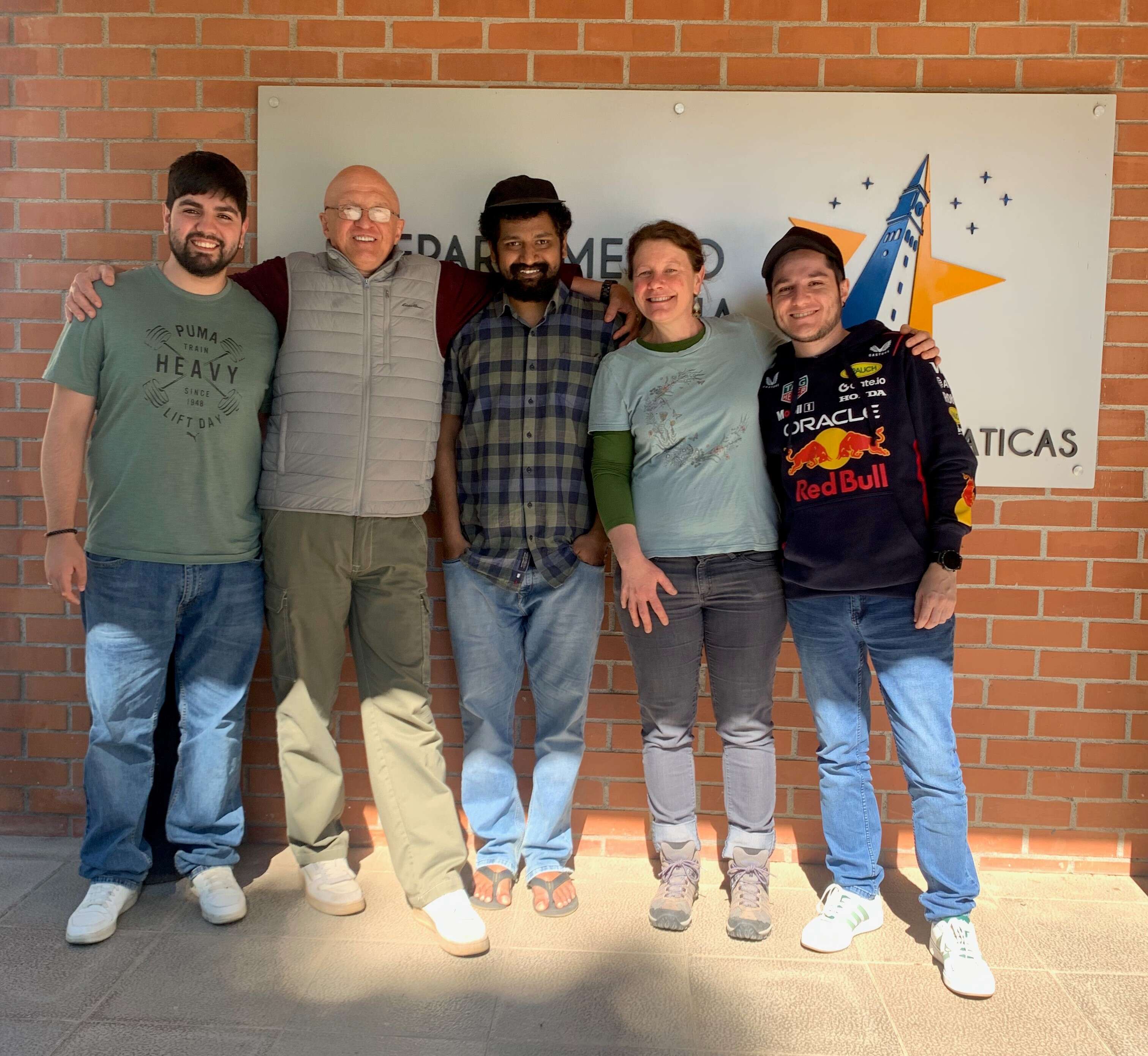
Concepcion, 21 April 2025
Astrophysicist Alexandre Lazarian visits the Department of Astronomy and gives a talk on Solar Magnetic Activity and Earth’s Climate
- The academic from the University of Wisconsin-Madison visited our country as part of the Fulbright Chile program to conduct research with Chilean scientists.
Until the end of May, our country will receive the visit of astrophysicist Alexandre Lazarian, an academic from the University of Wisconsin-Madison, USA, and a scholar of the prestigious Fulbright program. It is in this context that the scientist will develop research together with the team of the Principal Researcher of the Center for Astrophysics and Related Technologies (CATA) and academic of the Universidad de Concepción (UdeC), Dr. Amelia Stutz, who will develop studies of magnetic fields and turbulence in star formation zones.
“I was familiar with Amelia’s important work and we met in person at conferences. This visit allows us to strengthen our scientific ties and initiate a new cooperation program that will use the unique data from Chilean telescopes, particularly ALMA”, explains the researcher, whose visit to our country was possible thanks to the support of CATA and the Vice-Rectory for Research and Development of the UdeC.
Lazarian’s team is developing innovative techniques for data analysis, which, together with the data obtained from the telescopes installed in Chile, will allow optimizing the use of these techniques and obtaining new relevant information in the study of magnetic fields. “The experience of Professor Amelia Stutz and her group allows us to analyze the data. This is a productive collaboration that benefits both parties and I hope that this collaboration will continue successfully after my visit. I am passionate about Chile and would like to return to this beautiful country and visit the Universidad de Concepción frequently,” says the astrophysicist.
Solar magnetism and its effects
During his visit to Concepción, the researcher gave two talks, one focused on cosmic rays aimed at professionals in the area and also a public talk entitled “Magnetic activity of the Sun and Earth’s climate”, in which he delved into the effects of the Sun’s magnetic activity on our planet and humanity. “This is a topic of intense research around the world. This is because, first of all, the Sun’s magnetic activity induces energetic particle flows that interact with the Earth’s magnetosphere. In addition to creating spectacular auroras, these particles damage space equipment, create magnetic storms, and disrupt radio communications, among other effects. Predicting these events requires a better understanding of the physics of solar flares and the propagation of these particles in magnetized plasmas between the Sun and Earth. And second, magnetized plasmas create a shell around the solar system that restricts the arrival of galactic cosmic rays at the Earth. These cosmic rays ionize the Earth’s atmosphere and cause water droplets to condense in the upper atmosphere. These droplets reflect sunlight, which affects the climate,” explains Lazarian.
The talk generated many questions about the effects of solar activity on cellular connectivity and about the relative importance of human and solar activity in climate change. An upcoming talk open to the general public on the effects of astrophysical turbulence is expected during May.
Celeste Burgos Badal
Department of Astronomy Communications
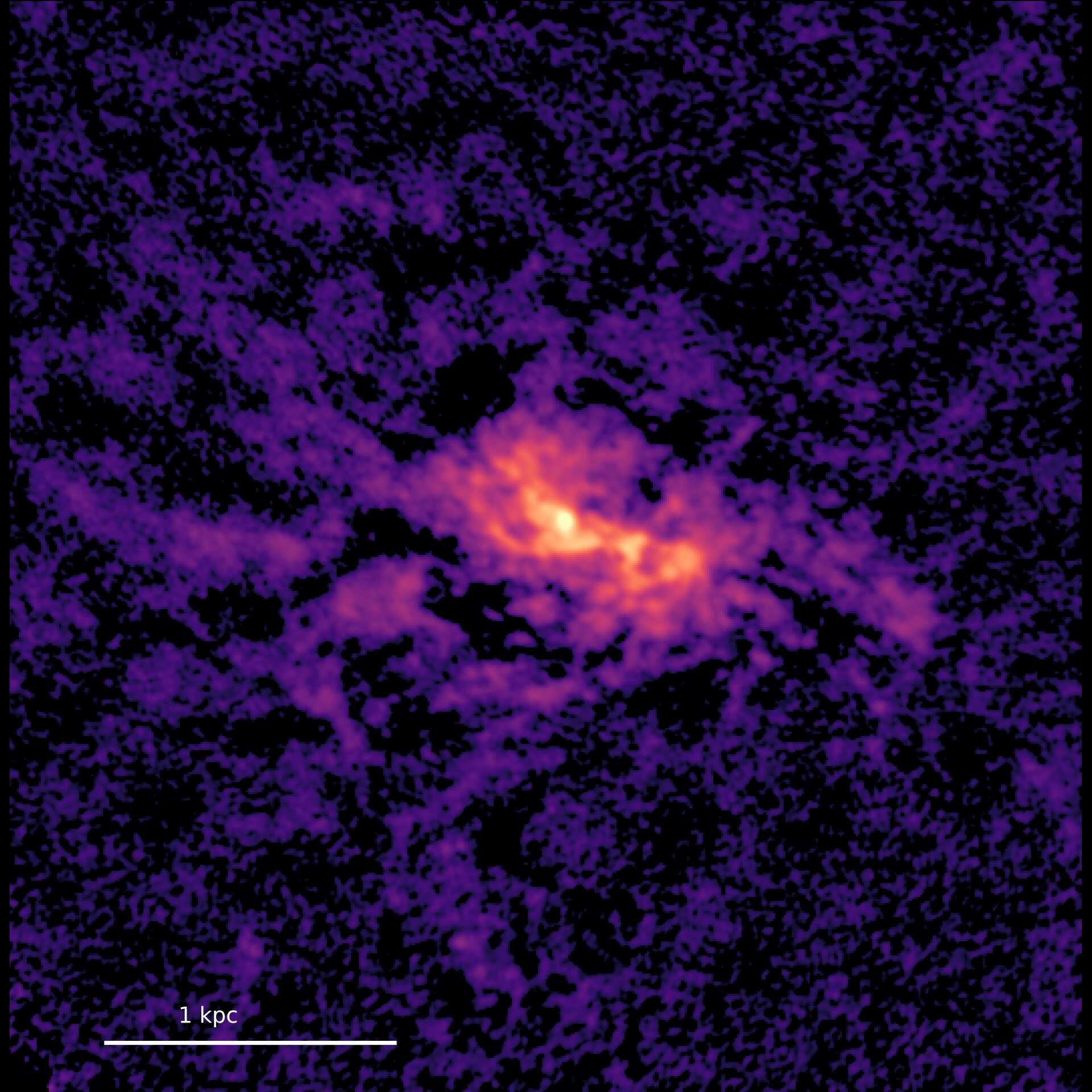
Concepcion, 4 April 2025
Study of dust in “Cigarette Galaxy” could provide insight into star formation and life under extreme conditions
- A study could provide insight into the life and formation of stars under extreme conditions in the local universe. The work is led by Dr. Vicente Villanueva, Postdoctoral Researcher at the Center for Astrophysics and Related Technologies (CATA), where new observations taken with the James Webb Space Telescope (JWST) and the Northern Extended Millimeter Array (NOEMA) were presented.
A research, led by Chilean Dr. Vicente Villanueva, Postdoctoral Researcher at the Center for Astrophysics and Related Technologies (CATA) and astronomer at the University of Concepcion, would allow to know the life and formation of stars in extreme conditions within the local universe. The work was applied inside the galaxy M82 (or known as the “Cigar Galaxy”), the galaxy with the closest explosive star formation to the Milky Way.
The study, recently published in the journal Astronomy & Astrophysics, also includes the participation of Dr. Rodrigo Herrera-Camus, Associate Researcher at CATA and professor at the Universidad de Concepcion. Both, together with Dr. Alberto Bolatto of the University of Maryland (researcher in charge of data acquisition), presented new observations taken with the MIRI (Mid InfraRed Imager) instrument aboard the James Webb Space Telescope (JWST), and complemented with data from the Northern Extended Millimeter Array (NOEMA), located in Europe.
The astronomers focused on M82 because of its proximity to the Milky Way, which is approximately 11.7 million light-years away, experiences strong galactic winds, and has served as an excellent analog of star-forming galaxies in the early universe. The objective was to study the emission of dust particles known as polycyclic aromatic hydrocarbons (PAH), which are detected at different wavelengths depending on their size, and of carbon monoxide (CO), the tracer molecule of the immediate fuel for star formation. Both provide information about the energy being emitted in galaxies and the physical conditions they harbor.
“What happens in these galaxies is that they have a lot of energy injection, because there are a lot of stars forming and, therefore, a lot of radiation is emitted. These particles (PAHs) in M82 are excited differently than in other galaxies with similar star formation rates to the Milky Way, where the smaller ones are more difficult to excite than the larger ones. What is relevant in this study is that we have compared the relationships between molecular gas, which is the most immediate fuel for star formation, and dust emission from these molecular clouds (also essential for star formation) between normal galaxies and M82,” says Vicente Villanueva.
The researcher highlights the work done with the James Webb telescope using MIRI in the range 7.7 -11.3 micrometers, from which images were obtained in the F770W and F1130W filters that allowed the PAH and CO emissions to be analyzed as never before and compared with each other. The investigation of the emission of these molecules is crucial because it allows astronomers to analyze the composition of the interstellar medium, the energetic and dynamic conditions in star formation in galaxies such as the “Cigar Galaxy”. In addition, by observing these features, information can be inferred about star formation processes and how the environment affects the chemistry of gas and dust in galaxies.
“Dust plays a key role in galaxies because it is a way to give more heavy elements to the interstellar medium. When dust is present, even though it represents a tiny fraction of the interstellar material, it greatly changes the physics of the stars because it increases the opacity of the atmospheres, not allowing the stars to grow too much when they are forming. As a consequence, stars in formation end up being of medium size like our Sun, which was born from a molecular cloud that had a lot of dust,” emphasizes Villanueva.
The CATA researcher states that one of the important results of the study is that “when one compares the linear (almost ‘one-to-one’) relationship seen in normal galaxies between PAH and CO emission, we note that these relationships vary in the extreme environment of M82, giving clues to distinct energetic mechanisms capable of altering the interstellar medium even more significantly”. Even so, the astronomer emphasizes that similar studies also seek to answer other open questions left by this work. Among others, it is necessary to verify whether the dust particles help to remove the molecular clouds that form stars from the galaxies, and consequently to extinguish the formation of new stars or simply to violently excite these structures to finally destroy them.
Chile’s long-term role in this research
This research offers new information on how the galactic environment and the particles present can affect star formation, while providing clues about the evolution of similar galaxies in the early universe. Such studies are essential for advancing our understanding of star formation and galaxy dynamics over time.
Villanueva comments that thanks to the JWST it was possible to obtain and analyze the emission images of the hydrocarbons and carbon monoxide present in these observations. The role of NOEMA consisted in obtaining the best visibility of M82 for CO data, since this galaxy is not visible from the southern hemisphere. However, this may change in the future and provide more precise details from Chilean soil by investigating similar galaxies.
“In Chile there are many projects already under construction that will break records in terms of access to observations of the early universe. Projects like the Extremely Large Telescope (ELT), Giant Magellan Telescope (GMT) and Vera Rubin are going to generate detailed information like no combination of telescopes in the history of mankind has consolidated so far. Chile will practically become the most important ‘eyes to the skies’ in the world in the coming decades, and this is a technological and political challenge for our country; we certainly need to be up to the challenge”, said the CATA – UdeC postdoctoral researcher.
UdeC-CATA Astronomy Communications
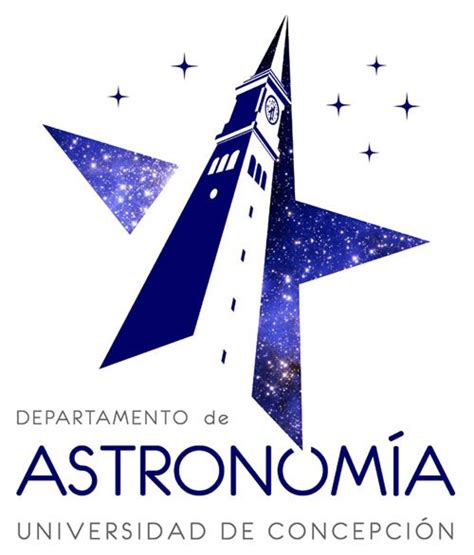
Concepción, 17 de Octubre 2022
Two Tenure track professorship positions at Universidad de Concepcion, Chile
Job Category: Faculty Positions (tenure and tenure-track)
Institution Classification/Type: Large Academic
Institution/Company: Universidad de Concepción
Department Name: Departamento de Astronomía
Street: Avda Esteban Iturra S/N
City: Concepción
State/Province: Bio-Bio
Country: Chile
The Astronomy Department at Universidad de Concepcion, Chile, invites applications for two tenure-track professor positions across all areas of astronomy, including astronomical instrumentation. Minimum requirements are a Ph.D. in astronomy, engineering, physics, or a closely related field, as well as an established record of excellence in research. Strong commitments to teaching, mentoring, outreach, and administration are highly desirable.
The city of Concepción is located a short 50 min flight from Santiago de Chile, about 500 km to the south, on the Pacific Ocean but not far away from the Andes. It is famous for its active cultural life and hosts the Universidad de Concepción, one of the prestigious in the country. The University is known for its large lush and green campus, recognized for its design and architectural style.
The Astronomy Department includes 12 faculty, ~10 postdocs, and ~50 Ph.D. and Masters students. Current research spans observational to theoretical Galactic and extragalactic astronomy, including star and cluster formation and evolution, stellar astrophysics evolution and variability, Galactic archeology, the distance ladder, AGN, galaxy clusters and galaxy evolution, astrochemistry, magneto-hydrodynamical and stellar-dynamical simulations. The Department is also interested in opening new research fields (including but not limited to astrobiology and planetary sciences).
We pursue vibrant instrumentation programs through the CePIA Radioastronomy (http://cepia.udec.cl/) and Cosmic Dust ( http://www.astro.udec.cl/dust_lab/) laboratories. Both labs are highly interdisciplinary and international. Our department members co-lead several large international (e.g., ERC Synergy and Max-Planck) and national (e.g., Milenium and BASAL) grants and research programs. The Department is internationally recognized for its public outreach and teacher training programs.
In addition to existing computational (e.g., http://www.astro.udec.cl/kultrun/ ) and instrumentation facilities, the successful applicants will have access to 10% of observing time on all telescopes in Chile (e.g., ALMA, ESO facilities), membership in large survey-mode experiments (e.g., SDSSV, LSST), and opportunities to participate in upcoming facilities (e.g., LCT , CCAT-Prime).
Applicants are expected to teach in Spanish within 2 years. The start date may be as early as March 2023. Applicants should submit a cover letter, a CV, a statement of research interests and future plans (max. 4 pages), a teaching statement including student mentoring experience (max. 2 pages), and the names of three professional references, on or before November 18th 2022 (link below).
Application page: https://form.jotform.com/222536031307647
Department homepage: http://www.astro.udec.cl/e/index.html
Visit the following link for more details: https://jobregister.aas.org/ad/a9159ee0
Application Deadline: Friday, November 18, 2022.
Apply to Job
Attention To: The Director
Institution/Company: Universidad de Concepción
Department Name: Departamento de Astronomía
Street: Avda Esteban Iturra S/N
City: Concepción
State/Province: Bio-Bio
Country:Chile
Phone: +56412661441
Email: svillanova@astro-udec.cl
Inquiries about Job
Attention To: The Director
Subject: Tenure track professorship position at Universidad de Concepcion, Chile-2022
Email: svillanova@astro-udec.cl
Franco López Flores
Comunicaciones Departamento de Astronomía
Universidad de Concepción

Concepción, 26 de Mayo 2020
Ph.D Gael Chauvin is awarded with the Charles Defforey- Institut de France Prize
The astrophysicist, who currently works as a researcher at the International Franco-Chilean Laboratory of Astronomy, obtained the distinction along with a team of colleagues for his SPHERE + project, dedicated to the search for exoplanets.
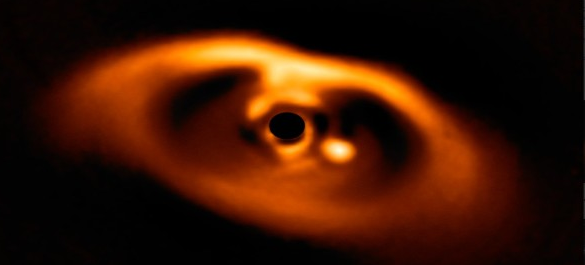
David Azócar
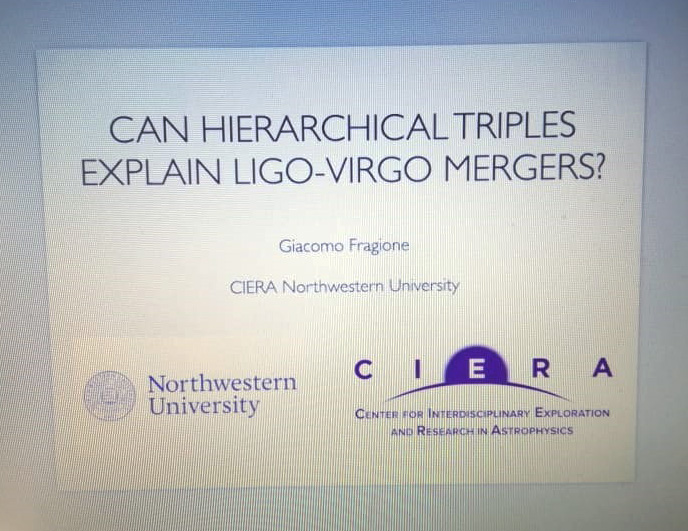
Concepción, 19 de Mayo 2020
A series of colloquia is held at the Department of Astronomy Udec
Since 29 April 2020 scientific seminars are being held in which academics from the Department of Astronomy participate together with researchers from various educational centres of the world. The first participating scientist was Dr. Giacomo Fragione, who is a member of Northwestern University, and works on topics related to gravitational wave-induced fusions of binary compact objects. On April 29, Dr. Fragione presented "Can hierarchical triples explain the LIGO-Virgo mergers?".
On May 6, Dr. Tom Richtler, an academic from the Department of Astronomy Udec, who focuses his work on studying globular clusters and galaxy cluster systems, presented " Luminosity profiles of spherical galaxies - their physical meaning". May 13 was Dr. Aaron Geller’s turn from Northwestern University. Geller presented "Visualizing Your N-Body Simulations", in which he gave an overview of his research on how stellar dynamics and stellar evolution conspire to create the most interesting stars and planets. On the 20th of May Dr. Jennifer Schober from the Astrophysics Laboratory, EPFL, talked about the origins and evolution of cosmic magnetic fields in "New insights on the origin and evolution of cosmic magnetic fields".
The colloquia continued on June 3 with the presentation of Tim Lichtenberg from the Oxford University, who talked about " Geophysical imprint on rocky planet formation and evolution". A week later, June 10, was the turn of Dr. Phillip Grete of University of Michigan, who unveiled K-Athena – a performance portable structured grid finite volume magnetohydrodynamics code. On June 17, Dr. Pierluigi Cerulo of the University of Concepción presented " The Morphological Evolution of Galaxies as a function of the Environment". The colloquiums will continue on June 24; 1, 8, 15 and 29 July.
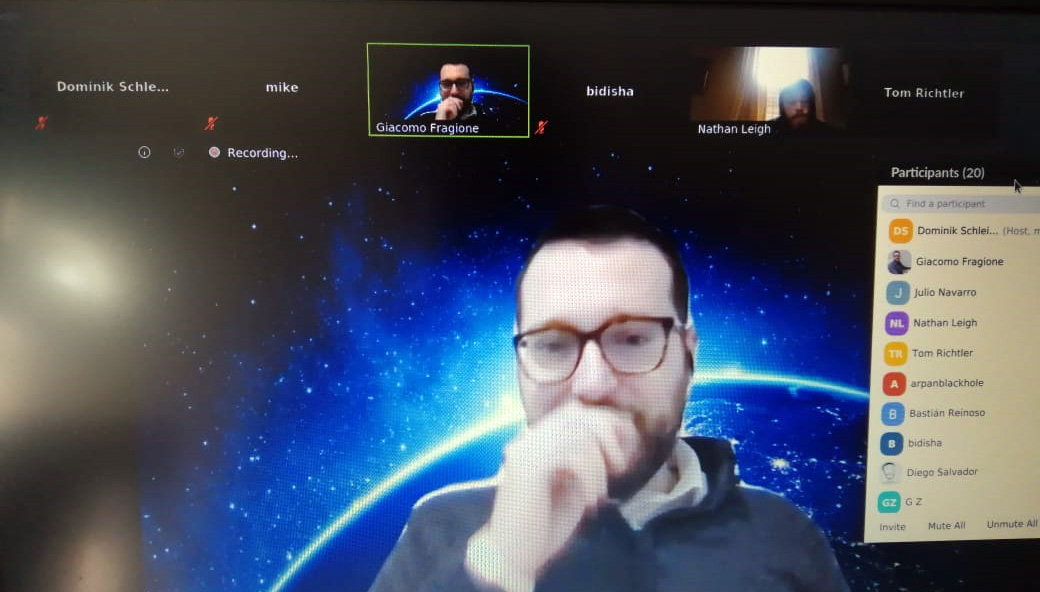
|

|
Comunicaciones Departamento de Astronomía
Universidad de Concepción
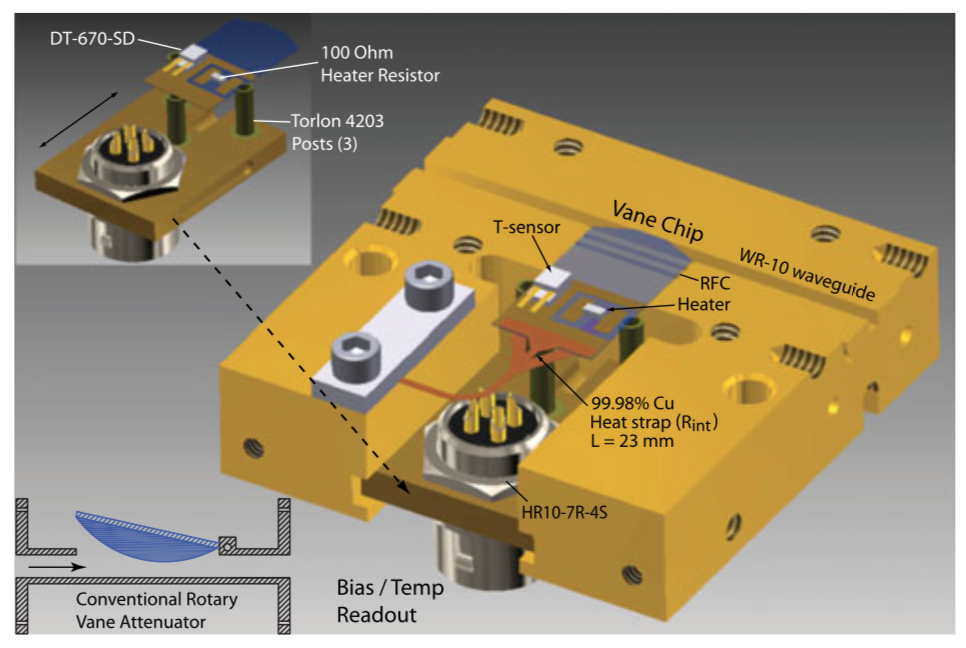
Concepción, 03 April 2020
Astronomy researcher receives award for best paper of the year in prestigious international scientific journal
- The recognition, titled the "IEEE MTT-S 2020 THz Science and Technology Best Paper Award," was presented by IEEE, an association dedicated to promoting innovation and technological excellence and recognised as the largest professional technical society in the world.
- The award is expected to be presented at the upcoming “International Microwave Symposium” organised by IEEE, which will take place during the week of 22 to 26 June 2020 in Los Angeles, California, USA.
- Dr. Rodrigo Reeves, an academic in the Department of Astronomy at the University of Concepción, is a member of the award-winning team.
“A Programmable Cryogenic Waveguide Calibration Load With Exceptional Temporal Response and Linearity” is the title of the research that won the award for best paper of the year in science and technology. The work was carried out by scientists Jacob W. Kooi (JPL), Rodrigo A. Reeves (UdeC), Arthur W. Lichtenberger (UVA), Theodore J. Reck (JPL), Andy K. Fung (JPL), Sander Weinreb (Caltech), James W. Lamb (Caltech), Rohit S. Gawande (JPL), Kieran A. Cleary (Caltech), and Goutam Chattopadhyay (JPL).
“The publication focuses on the development of a calibration source for instruments detecting ultra-weak signals operating at cryogenic temperatures, such as those used in millimetre and sub-millimetre radio astronomy. The calibration source is programmable, miniaturised, and highly responsive in terms of temporal behaviour, capable of changing and controlling its physical temperature within seconds,” explains Dr. Reeves.
The design allows wave receivers, such as those used by ALMA, to be presented with a radiative blackbody source whose temperature can be rapidly varied, without affecting the operating conditions of the instrument being characterised — something that had not been possible until now at cryogenic temperatures in the millimetre wave range. This innovative concept can now be extended to frequencies as high as the THz range.
The recognition is awarded by the IEEE Microwave Theory and Techniques Society (MTT-S), the Institute of Electrical and Electronics Engineers (IEEE), the largest professional technical organisation in the world, composed of engineers, scientists, and professionals in the field.
Celeste Burgos Badal
Department of Astronomy Communications
University of Concepcion
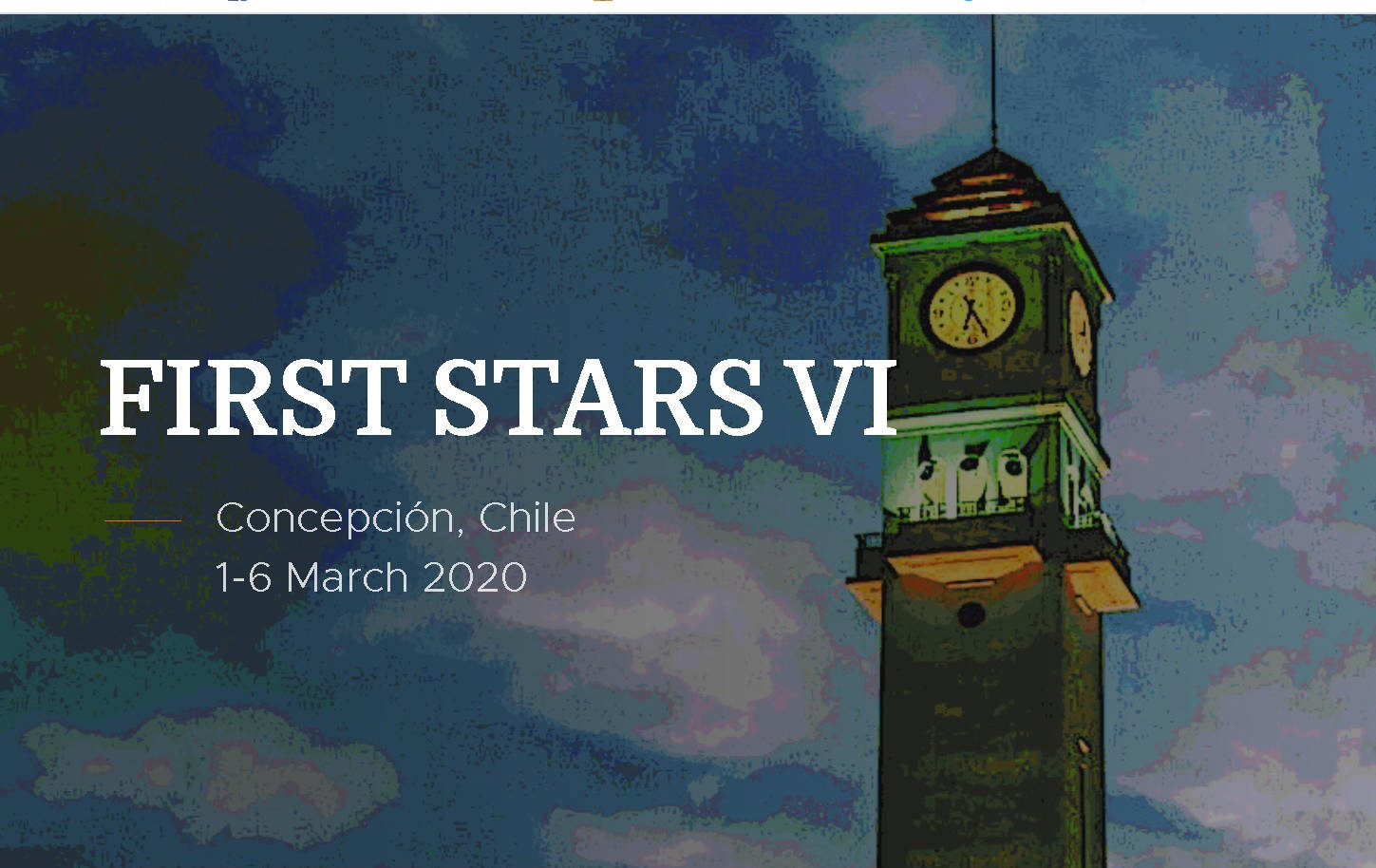
Concepción, 02 March 2020
First Stars VI
International Conference on Stellar Origins held in Concepcion
This is the sixth edition of “First Stars”, a conference taking place for the first time in South America. The event brings together over 100 scientists from various countries to discuss the current state of research on the origins of the Universe.
Over the past decade, significant progress has been made in probing how the first stars, galaxies, and black holes formed. Notable milestones include the first detections of gravitational waves, opening a new window into our Universe; the first detection of a signal from the epoch of reionisation through the EDGES experiment; as well as continued advances in areas such as stellar archaeology and the search for the earliest galaxies. Moreover, further major developments are expected in the coming years thanks to future missions such as the JWST and the SKA.
It is precisely because of these advances in astronomical research that the sixth edition of “First Stars” is being held for the first time in South America, specifically in the city of Concepcio n. From 1 to 6 March 2020, the University of Concepción will host the conference, which aims to discuss the current theoretical and observational understanding of stellar birth throughout cosmic history, the impact of the formation of the first stars and galaxies on the subsequent evolution of the Universe, the first supernova explosions and chemical enrichment, cosmic reionisation, and the formation of supermassive black holes.
Scientists from the Department of Astronomy at the University of Concepcion make up the local organising committee of “First Stars VI”. The committee includes Dr. Bidisha Bandyopadhyay and Drs. Stefano Bovino, Michael Fellhauer, Rafeel Riaz, and Dominik Schleicher. Internationally, the event is also organised by researchers from France, the United States, Brazil, Germany, Chile, Italy, Australia, Japan, and the United Kingdom.
The conference, which brings together around 120 researchers, places particular emphasis on current and future space- and ground-based observational plans, and on comparing these with predictions from the most advanced numerical simulations. Previous editions of the conference were held in Garching in 1999, Pennsylvania in 2003, Santa Fe in 2007, Kyoto in 2012, and Heidelberg in 2016. This year’s edition is the first in the series to take place on our continent and has a specific aim of strengthening ties with the observational community in Chile, which hosts some of the world's largest telescopes and offers significant opportunities within its astronomical community. The event also seeks to encourage the participation of young researchers and students. Confirmed participants include scientists such as Andrew Bunker from the University of Oxford; Elisabetta Caffau from the Paris Observatory; Shingo Hirano from Kyushu University, Japan; Takashi Hosokawa from Kyoto University, Japan; Mattis Magg from ITA, Germany; Takashi Moriya from the National Astronomical Observatory of Japan; and Ezequiel Treister from the Pontificia Universidad Catolica de Chile, among others.
The event is funded by the Anillo Project “ACT 172033: Formation and Growth of Supermassive Black Holes”, the ALMA – CONICYT fund 31180014, and is supported by the Vice-Rector’s Office of the University of Concepcion through the second call for proposals under the “Funding for National and International Conferences” programme.
For more information: http://www.astro.udec.cl/FirstStarsVI/#home
|
|
|
|
|
|
Celeste Burgos Badal
Department of Astronomy Communications
University of Concepcion
Concepción, 02 March 2020
First graduate of the Master's in Astronomy programme
Monserrat Martínez is the first graduate of the Master's in Astronomy programme at the University of Concepcion. This programme, now in its third year, aims to provide its graduates with high-level professional skills to succesfully pursue a career in professional astronomy, particularly in the era of new, large observatories that will be established in Chile, such as the Extremely Large Telescope, the Vera Rubin Observatory, and the Giant Magellan Telescope.
Monserrat, who succeeded with the highest grade, defended her Master's thesis titled "Identification of galaxy population using a phylogenetic approach" on 24 January 2020. Under the supervision of Professors Ricardo Demarco (supervisor) and Guillermo Cabrera (co-supervisor), this work was also evaluated by Professor Neil Nagar. Monserrat's research also involved the participation of Drs. Pierluigi Cerulo, Nathan Leigh, and Rodrigo Herrera-Camus.
For two years, Monserrat worked implementing phylogenetic trees to study galaxy evolution. Inspired by the work of the astrophysicist Paula Jofré — who developed a method to identify families of stars using phylogenetic trees — Monserrat proposed to apply this technique to galaxies for her Master's project. She explained: "I decided to propose this topic to Professors Demarco and Cabrera, and they accepted because it fit Professor Demarco's knowledge in galaxies and Professor Cabrera's knowledge in data science".
Professor Demarco is an astronomer who focuses on understanding how galaxies we observe in the local universe were formed, as well as their physical properties at different redshifts. Meanwhile, Professor Cabrera is a computer engineer whose fields of expertise include data science, astrostatistics, and astroinformatics, among other fields.
This master's project involved interdisciplinary work between astronomy and computer science. The young scientist learned artificial intelligence techniques and their application in astronomy. "Based on the work carried out by the Chilean astrophysicist Paula Jofré, Monserrat wondered if the method could be applied to galaxies, their structure, and evolution. It was something very novel, which she developed on her own. Obviously, we discussed any doubts related to astrophysics, but details of the method were studied independently by Monserrat, paving her own research path. It is the first time I have seen a student start a thesis project from scratch, which is remarkable and shows the level she has achieved, standing out from her peers thanks to her efforts, dedication, and, of course, her skills.", comments Dr. Demarco.
Regarding Monserrat's evaluation of the Master's in Astronomy programme, she points out: "It covers all areas necessary for an astronomer and allows you to take electives in any research area at the university. Each professor has their own style of teaching, which gives you the freedom to choose the approach that suits you best. The Master's programme is well structured and has the advantage of beginning to research or think about your thesis from the first semester, thanks to the research unit course".
The next step for Monserrat is pursuing a PhD in astronomy at the Swinburne University of Technology in Melbourne, Australia. "My supervisor will be Dr. Karl Glazebrook, and we will investigate stellar populations in the first galaxies (redshift > 4) formed in the Universe, utilising smart algorithms to study the spectra from the James Webb telescope", explained the young scientist. "Monserrat will combine artificial intelligence techniques and existing data in order to prepare for the work she will carry out using this telescope, which will be orbiting in space in a few years. When this happens, Monserrat will be part of a privileged group of scientists that can use this telescope, conducting state-of-the-art science, as she has the capabilities to carry out advanced research", commented Dr. Demarco.
Therefore, the Department of Astronomy, through its Master's programme, expects to continue training professionals who can contribute to science from any part of the world. "We are working on training competent proffesionals through the dedicated efforts of the academic staff, supported by the achievements obtained during our undergraduate programme. We expect this Master's to establish itself as a point of interest for students and colleagues, not only in Chile but also abroad, in the formation of new highly skilled individuals, which also draws attention to the work carried out by the Department of Astronomy at the University of Concepcion, positioning it within an international context", concluded Dr. Demarco.
Celeste Burgos Badal
Department of Astronomy Communications
University of Concepcion
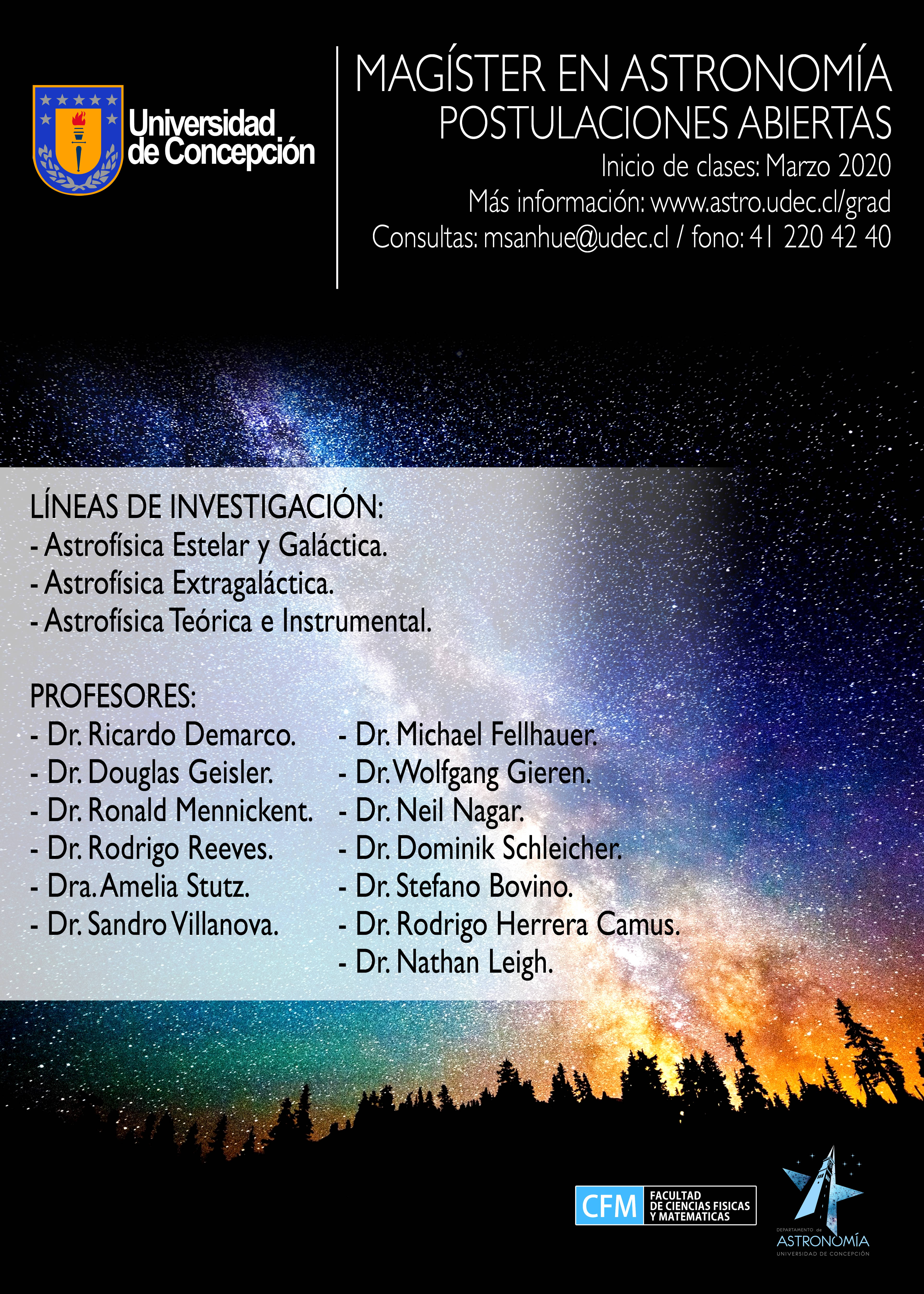
Concepción, 02 March 2020
Master's in Astronomy has been accredited for a period of three years
The National Accreditation Commission delivered its evaluation on 20 December 2019, granting a three-year accreditation to the Master's in Astronomy, the maximum period possible for programmes that do not yet have any graduates.
Academics at the Department of Astronomy are pleased with the news that the Master's programme, which started in 2017, has been accredited for a period of three years.
The process began in 2017 supervised by Dr. Sandro Villanova — Director of the programme and academic at the Department of Astronomy. "We gathered and analysed all the documents in order to start the accreditation process, such as study plan, institutional environment, academic staff, enrolled students, institutional collaborations, research projects, etc., to conduct a self-evaluation of the program by involving academic and administrative staff, and also students of the programme. In this process, we identified the strengths and weaknesses of the programme and developed a plan to address any issues found", explained Dr. Villanova.
Once the report was finished, it was sent to the National Accreditation Commission (Comisión Nacional de Acreditación, CNA), which sent a group of evaluators to conduct an on-site evaluation of the program by visiting the Faculty of Physical and Mathematical Sciences, the Department of Astronomy, and meeting with Dean Dr. Roberto Riquelme, faculty members and students.
"The commission examiners sent their report to the CNA, which issued a final evaluation and granted us a three-year accreditation on December 20, 2019, which is the highest possible for programmes that have no graduates yet. Next year, we will start a new accreditation process for our students so they can apply for Conicyt benefits without interruptions", commented Dr. Villanova.
The Master in Astronomy aims to train specialised professionals and astronomers capable of developing state-of-the-art research projects and cutting-edge technology, utilising the current and future instrumental infrastructure of our country. It is worth noting that the University of Concepcion is the only institution in central-southern Chile offering an astronomy degree, making it essential to continue supporting programmes like this.
The scope of the master programme offered by the Department of Astronomy, the variety of courses it includes, and the different areas of specialization provided by its faculty in fields such as Stellar and Galactic Astrophysics, Extragalactic Astrophysics, and Theoretical and Instrumental Astrophysics, are unique in Chile and give the programme a profile of excellence; it is also the only postgraduate option located south of Santiago.
Additional information of the programme: http://www.astro.udec.cl/e/news/news/n13.html
Celeste Burgos Badal
Department of Astronomy
University of Concepcion
Concepción, 18 December 2019
Student from the Faculty of Physical and Mathematical Sciences awarded the DAAD scholarship for studies abroad
Patricio Alister, who currently studies the formation of black hole seeds in primordial clusters, will pursue PhD studies in Germany.
For three years, Patricio Alister — a student from the Faculty of Physical and Mathematical Sciences at the University of Concepcion — will work as doctoral researcher at the University of Heidelberg thanks to the CONICYT-DAAD scholarship for studies abroad. "My research will focus on mass loss in protostellar collisions, using simulations to develop a mass-loss model that can be applied in post-processing to primordial stellar clusters, where protostars are constantly colliding, to finally assess its influence on the formation of supermassive black hole seeds", explained Patricio.
Currently, Patricio is undertaking master studies on the same topic, investigating how mass loss affects stellar collisions and the formation of supermassive black hole seeds. "The difference with my PhD project is that at the moment I don't have models of protostellar collisions, which is what I will develop in my research in Germany", commented Patricio.
At the University of Heidelberg, Patricio will work alongside the German astronomer Ralf Klessen. "The idea to apply for this scholarship came from Professor Dominik, who has contacts with experts related to my field of study, so it was very convenient to pursue my studies there", he stated. When asked about the contribution his research could make to science, Patricio answered: "Explaining the presence of supermassive black holes today is one of the current goals of astronomy, and for that it is important to create good theoretical models capable of explaining what we observe. In this sense, my project contributes by improving the realism of current models for the formation of seeds for supermassive black holes, so they can be validated or further improved. The ideal would be to obtain solid results in order to provide a scientifically valid model. Additionally, a mass-loss stellar model is an understudied field and could be relevant in other fields", he concluded.
Celeste Burgos BadalDepartment of Astronomy Communications
University of Concepcion
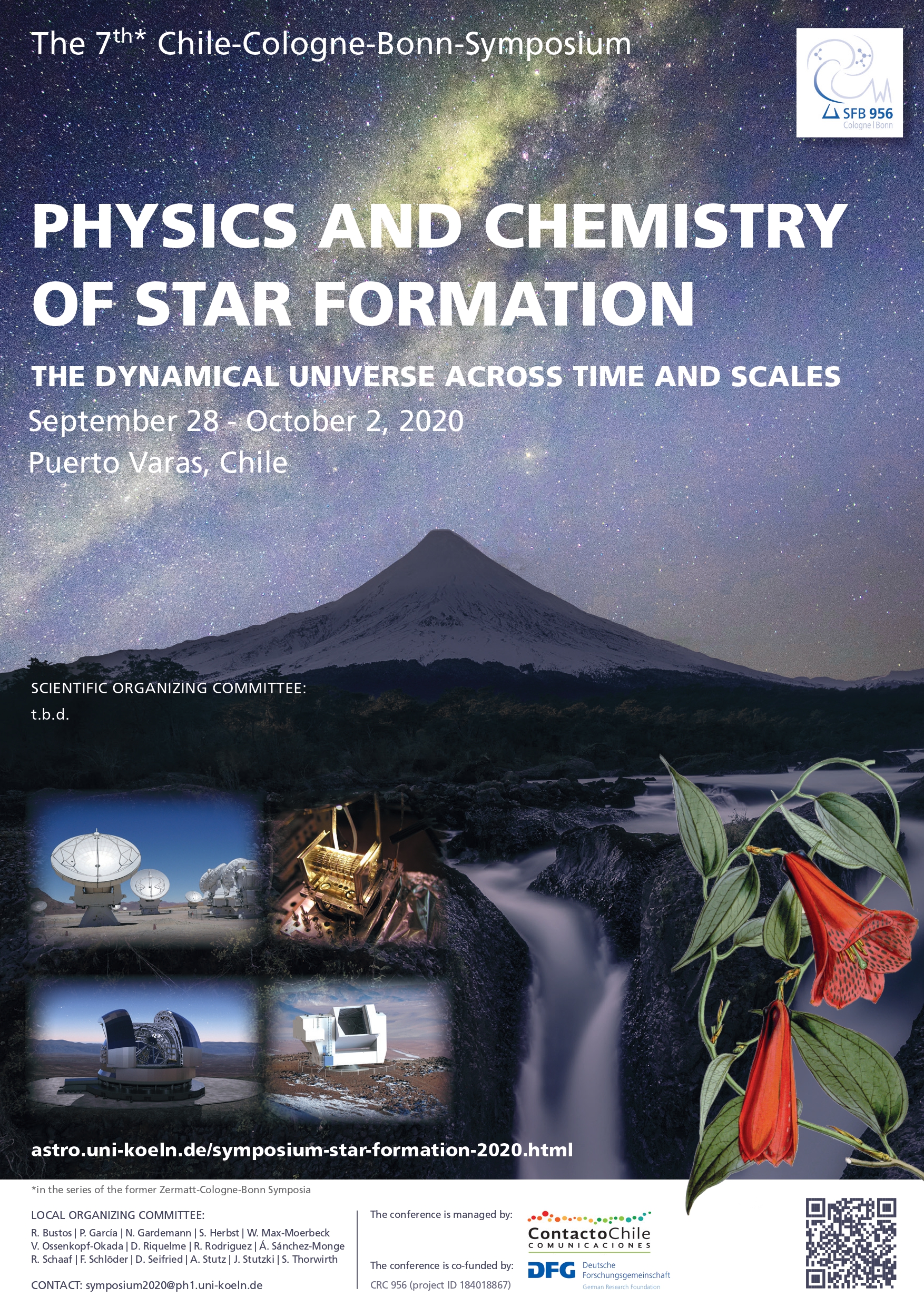
Concepción, 17 December 2019
Distinguished scientific meeting to be held for the first time in Chile
- The "7th Chile-Cologne-Bonn Symposium: Physics and chemistry of star formation, the dynamic Universe through time and scales" will be held in Puerto Varas and is expected to gather hundreds of astronomers.
- Dr. Amelia Stutz, an academic from the Department of Astronomy at the University of Concepcion (UdeC), was awarded funds from the ESO-Chile Joint Committee to encourage the participation of young astronomers in the event.
- This meeting aims to highlight the key role of Chile as a global centre for astronomy.
Chile is now recognised as a central figure in the development of astronomical research. To that end, Dr. Amelia Stutz, in collaboration with Chilean and German scientists, will organise the "7th Chile-Cologne-Bonn Symposium: Physics and chemistry of star formation, dynamical Universe through time and scales", to be held in Puerto Varas from 28 September to 2 October. This event seeks to encourage young astronomers to participate in the various activities planned, such as scientific discussions, meetings, conferences, and other world-class academic events.
"Training young astronomers in cutting-edge scientific results is one of the most direct ways to transform the astronomical potential of Chile into scientific achievements, and also highlight the key role of Chile as the centre for astronomy", explains Dr. Stutz. Therefore, through the project titled "From Cervino to Osorno Volcano: the ISM Symposium Chile-Cologne-Bonn 2020", funded by the ESO-Chile Joint Committee, the team will organise this symposium, which will gather hundreds of scientists to exchange advances in their research.
"We requested these funds to ensure the continuity of the series of conferences held for the first time in Chile. These funds will be used to cover the expenses of young Chilean and international astronomers, whether for registration fees or travel costs, to facilitate their participation in the event", commented Dr. Stutz. This event is organised by the Institute of Physics at the University of Cologne, the Argelander Institute of Astronomy at the University of Bonn, the Max Planck Institute for Radio Astronomy. This activity — which has been held since 1998 — is part of a series of symposia related to the physics and chemistry of the interstellar medium.
For more information visit: https://astro.uni-koeln.de/symposium-star-formation-2020.html
Celeste Burgos BadalDepartment o Astronomy Communications
University of Concepcion
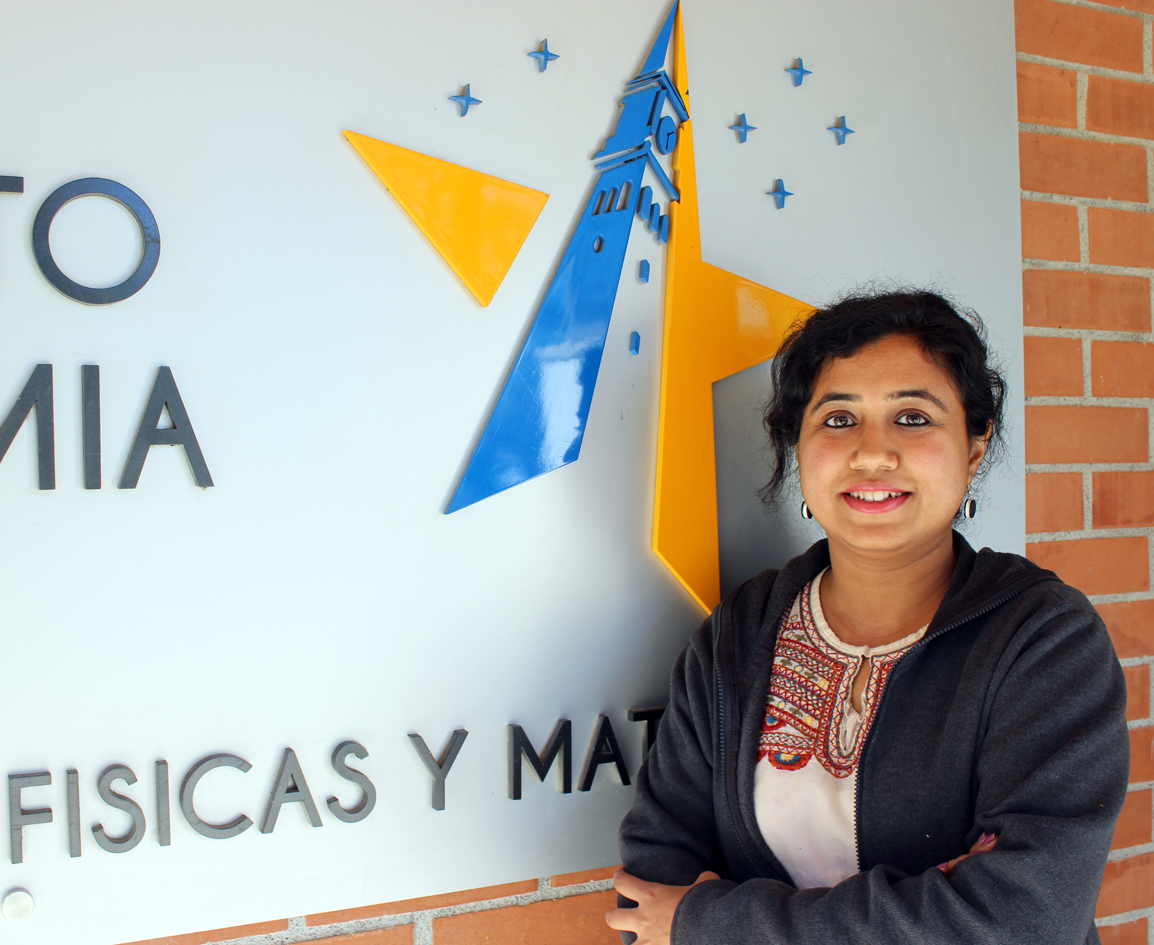
Concepción, 14 November 2019
Researcher from the Department of Astronomy to analyse the physics of black holes
- Dr. Bidisha Bandyopadhyay, who is currently undertaking postdoctoral research at the University of Concepción, will carry out this task.
- Thanks to the Fondecyt Postdoctoral Programme, the accretion processes in black holes will be studied.
Dr. Bidisha Bandyopadhyay — originally from India and currently carrying out postdoctoral research in the Department of Astronomy at the University of Concepción — will conduct the project titled "Probing the accretion physics of nearby low-luminosity AGN with the Event Horizon Telescope". The project will be carried out thanks to the Fondecyt Postdoctoral Programme and will run for three years. During this time, Dr. Bandyopadhyay will work alongside Dr. Dominik Schleicher — an academic from the same department.
Dr. Bandyopadhyay explained: "The first photon ring image of M87, announced by the Event Horizon Telescope (EHT), has opened a new window to survey the regions near supermassive black holes. The Event Horizon Telescope offers a unique opportunity to investigate the physics in supermassive black holes through Very Long Baseline Interferometry (VLBI), including the existence of the event horizon, the astrophysics behind supermassive black holes, accretion flows, and the properties of outflows".
This project aims to contribute significantly to the predictions and interpretations of the data obtained by the EHT through the development of new numerical tools applicable in this field. "Having resolved Sgr A* and M87, we now need to be able to resolve even smaller scales — down to approximately 100 Schwarzschild radii — which, in principle, would be sufficient to study the accretion flows," commented Dr. Bandyopadyay, who has developed and applied tools that can be used for comparison with theoretical models.
"Through this project, we expect to make a significant contribution to the interpretation of EHT data and provide relevant predictions that will aid in planning future observations. Collaboration with Dr. Christian Fendt from Heidelberg and Dr. Fu-Guo Xie from Shanghai, who currently maintains the RIAF code, will also bring additional expertise to the country, which will be useful for the modelling of accretion flows in general. We already hold regular meetings with Dr. Neil Nagar and Dr. Venkatessh Ramakrishnan, both members of the EHT, and who contributed to capturing the first image of the photon ring around the black hole in M87. To better understand the high-energy (X-ray) emissions from these sources, we have established a collaboration with Professor Patricia Arévalo's group at the University of Valparaiso", concluded Dr. Bandyopadyay.
Celeste Burgos BadalDepartment of Astronomy Communications
University of Concepcion
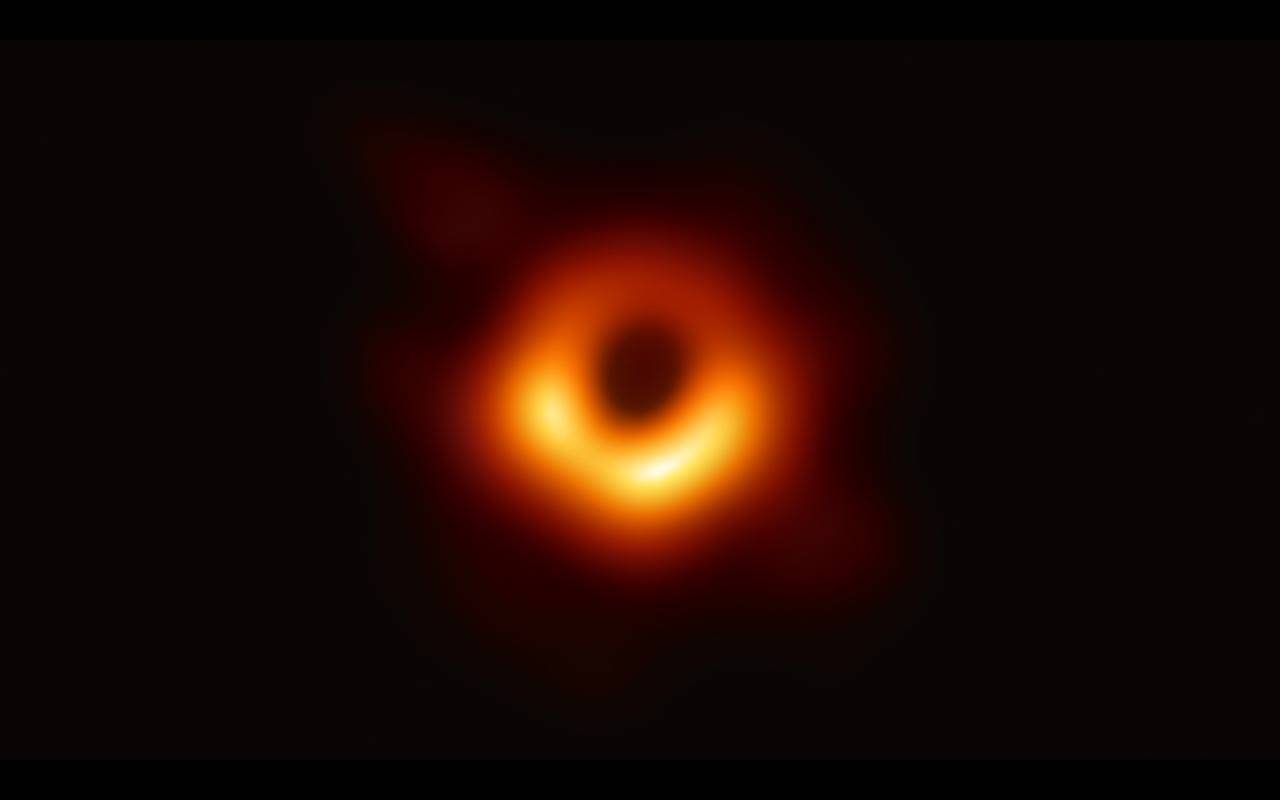
Concepción, 18 October 2019
Scientists identify two additional black holes to be studied with the Event Horizon Telescope
- The black holes selected are located in the galaxies NGC 3998 and Cen A, both of which have the necessary characteristics to be analysed.
- The research began in 2018 and was published in the scientific journal Monthly Notices of the Royal Astronomical Society.
The Event Horizon Telescope (EHT) — a network of radio telescopes located at various sites around the world — enabled the capture of the first-ever image of the shadow of a supermassive black hole, M87, marking a milestone in astronomy. This powerful instrument offers a unique opportunity for scientists to study these cosmic monsters through Very Long Baseline Interferometry (VLBI), a technique in which radio telescopes distributed across the globe are utilised to create a single Earth-sized telescope in order to analyse the physics of black holes, such as their event horizon, accretion processes, or outflows formationin Low-Luminosity Active Galaxy Nuclei (LLAGN).
The EHT has made it possible to survey regions in the accretion disk of the black hole that had previously been impossible to resolve. Therefore, one of the key areas of research is the range of physical processes occurring in the accretion disk in order to understand the source of energy powering these systems.
In this context, a group of researchers formulated a theoretical model aimed at predicting the emission profile of accretion discs around supermassive black holes in nearby galaxies, in order to determine whether the EHT or the Global 3mm VLBI Array — a network of instruments composed of eight antennas located in countries such as Spain, France, Germany, and Sweden, among others — is capable of resolving these structures.
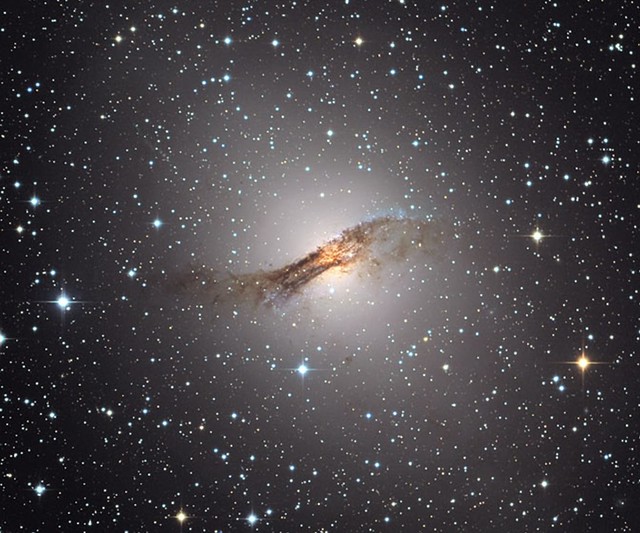
The article titled "Resolving accretion flows in nearby active galactic nuclei with the Event Horizon Telescope” presents research conducted by a group of scientists including Dr. Bidisha Bandyopadhyay as first author; Dr. Venkatessh Ramakrishnan (who, together with Bandyopadhyay is undertaking postdoctoral research in the Department of Astronomy at the University of Concepción); Drs. Neil Nagar and Dominik Schleicher, academics from the Department of Astronomy; Dr. Patricia Arévalo; Elena López and Yaherlyn Díaz, researchers from the University of Valparaiso; Dr. Fu-Guo Xie from the Shanghai Observatory. Notably, Drs. Neil Nagar and Venkatessh Ramakrishnan were among the scientists involved in capturing the first-ever image of the shadow of the supermassive black hole M87, which was published in April 2019.
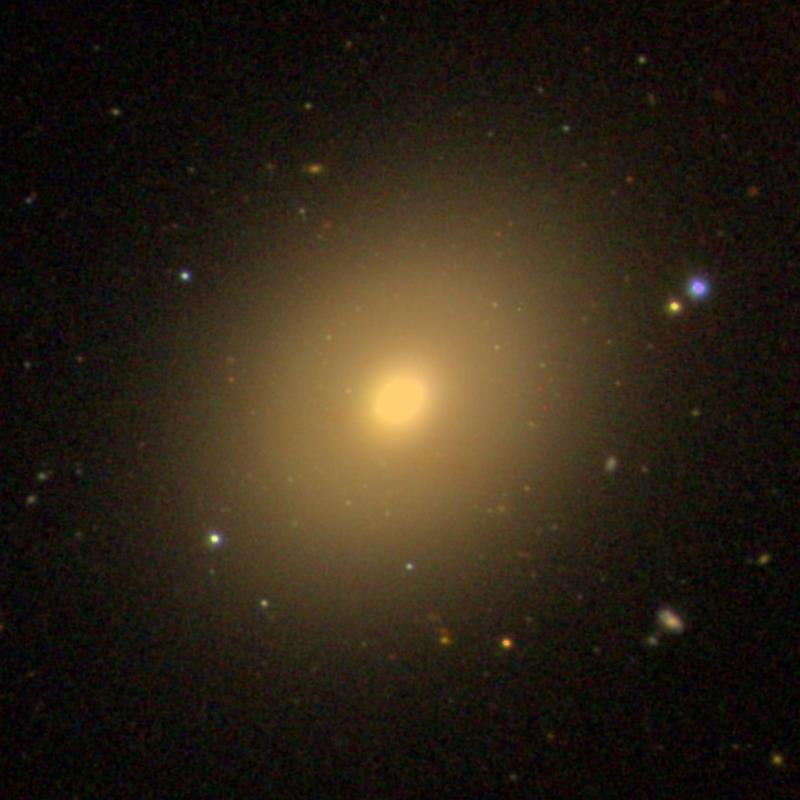
In this way, following the first image of the M87 black hole, it is now possible to plan observations of supermassive black holes in other galaxies. This is the purpose defined by the group of researchers in their recent article, who determined that the supermassive black holes located in the galaxies NGC 3998 and Cen A are good candidates for future observations. "The reason is that these objects are the only ones with a structure in their accretion disc that can be observed, as they are sufficiently large to be analysed, unlike other objects which appear only as a small point", explained Dr. Schleicher.
The supermassive black holes in NGC 3998 and Cen A have masses of 270 and 55 million times that of the Sun, and are located at distances of 51 and 14 million light years from the Milky Way, respectively. Unlike M87, these are less massive but are closer to us (M87 is 6.4 billion times the mass of the Sun and lies 55 million light years from our galaxy). Moreover, because they possess more active accretion than M87 and Sgr A*, they allow for the study of black hole growth.
This article was published in the scientific journal Monthly Notices of the Royal Astronomical Society (MNRAS), and was financially supported by the Anillo ACT172033, the ALMA-Conicyt 31160001, and the Fondecyt Postdoctoral 3190366.
To access the article: https://ui.adsabs.harvard.edu/abs/2019arXiv190705879B/abstract
Celeste Burgos BadalDepartment of Astronomy Communications
Universidad de Concepción
Concepción, 9 October 2019
Dr. Neil Nagar receives 2019 Municipal Science Award for his contribution to the first-ever image of a black hole
Each year, the Municipality of Concepción honours distinguished citizens who have made remarkable contributions to fields such as the arts and sciences. On this occasion, the astronomer Neil Nagar- academic in the Department of Astronomy at the University of Concepción -was selected for this prize, for his participation in the team that characterised the first image of a supermassive black hole
This prize consists of a fund of approximately $1,100 USD, which will allow him to continue developing his work as an astronomer.
In April of this year, researchers from the Event Horizon Telescope (EHT)- a network of eight telescopes located in different parts of the world -succeeded in capturing the image of a supermassive black hole. A total of 347 researchers, including Neil Nagar and Venkatessh Ramakrishnan, both from the Department of Astronomy at the University of Concepción, contributed to this astronomical and scientific milestone, which led to the 2020 Breakthrough Prize, also known as the "Oscar of Science" in the "Fundamental Physics" category, as well as recognition from the Chilean Parliament.
The Municipal Award in Arts, Science, Applied Research, and Social Sciences, recognises in the field of science, the milestone achievement that marked the first-ever image of the shadow of a black hole, captured by a team of 347 scientists from around the world, including the distinguished scientist Neil Nagar.
Dr. Neil Nagar holds a PhD in Astronomy and focuses on the study of active galaxies, supermassive black holes, galaxy kinematics, and high-energy cosmic rays.
It is worth noting that he is not the only academic from the Department of Astronomy who has been honoured with the Municipality Award; Wolfgang Gieren, Ronald Mennickent and Douglas Geisler were also recognised in 2009, 2014 and 2016 respectively for their contributions to science.
The ceremony will be held on 11 October at 19:00 in the Honour Hall "Regidor Carlos Contreras Maluje" at the Municipality of Concepción.
About Neil Nagar
- He holds a PhD in Astronomy from the University of Maryland, College Park, USA, which he earned in 2000
- Bachelor in Electronics Engineering and Master's in Mathematics from the Birla Institute of Technology and Science, Pilani, India, in 1993
- He has been collaborating with the EHT since 2010, currently focusing on a sample of active galaxies, calibration and analysis of ALMA data
- He joined the Department of Astronomy at the University of Concepción in 2004
Minicipal Awards
- It is designed for the recognition of labor and work of residing citizens or citizens born in Concepcion
- It has four categories: arts, science, applied research and social sciences
- It is awarded together with distintive degree and a fund equal to nearly $1,000 USD
- The jury is conformed by the Major of Concepcion, five consejales, and one representative for each university residing in the city for more than ten years
- These awards are intended to recognise the work of local residents or individuals from Concepción
- It has four categories: arts, science, applied research, and social sciences
- The award consists of a commemorative diploma and a monetary prize equivalent to approximately $1,000 USD
- The jury is chaired by the Mayor of Concepción, five councillors, and one representative from each university that has been established in the city for more than ten years
Department of Astronomy Communications
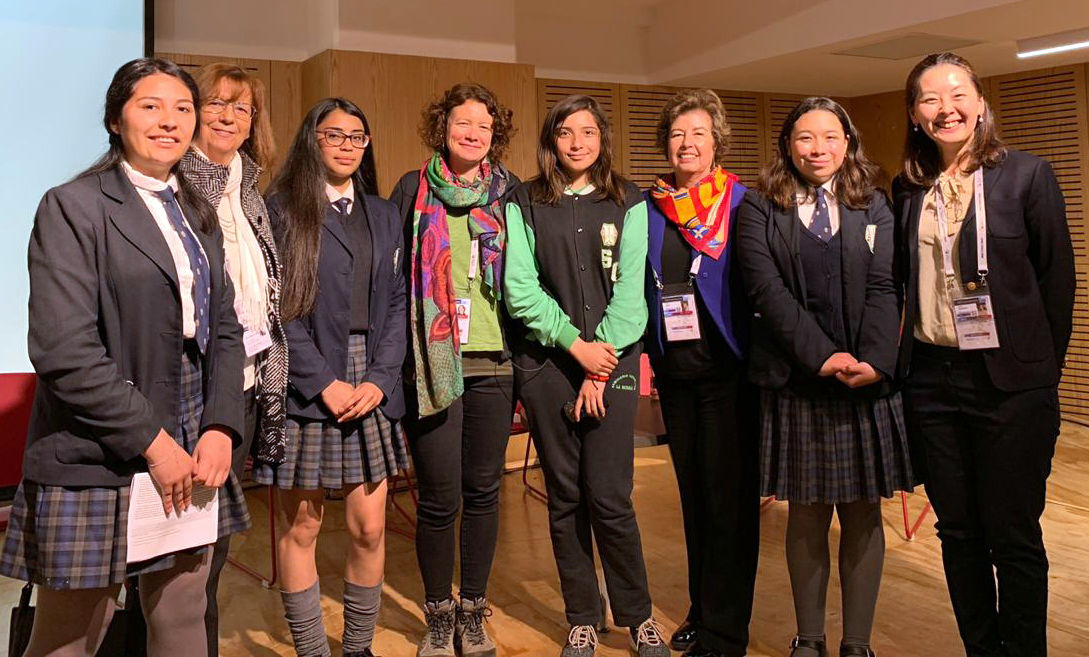
Concepción, 9 October 2019
At the Asian-Pacific Economic Cooperation Forum:
Astronomer takes part in event on the role of women in economic and intellectual development
Dr. Amelia Stutz took part in the "Public-Private Dialogue on Women and the Economy", an event held as part of the APEC forum, where she shared her experience and perspective of the role of women in theworkplace.
In 2019, Chile was the host of the Asia-Pacific Economic Cooperation (APEC) Forum, with the aim of promoting growth of the member economies through technical and economic cooperation via trade in the Asia-Pacific region. This year, APEC will bring together international economic leaders on 16 and 17 November, with priority topics such as "Digital Society", "Integration 4.0", "Sustainable Growth" and "Women, SMEs, and Inclusive Growth". In relation to the latter, a series of meetings were held in La Serena from 30 September to 4 October, focused on women and their participation in traditionally male-dominated fields.
One of these events was the "Public-Private Dialogue on Women and the Economy", which was attended by Dr. Amelia Stutz, an academic and astronomer from the Department of Astronomy at the University of Concepcion, who was invited as a guest speaker. She took part alongside other distinguished scientists in the field such as María Teresa Ruiz, Mónica Rubio and Sotoko Takahashi.
"In general, we discussed key aspects of how we pursued our scientific careers, from our early days up to this moment. In doing so, we encourage new generations to continue their goals and interests in fields where one must not only work for their goals, but also fight for them, whether professional or intellectual, since we referred to traditionally male-dominated contexts", explained Dr. Stutz, who specialises in multiple wavelengths related to star formation, including the identification and characterisation of young protostars, properties of molecular clouds, and the role of magnetic fields in the star formation process.
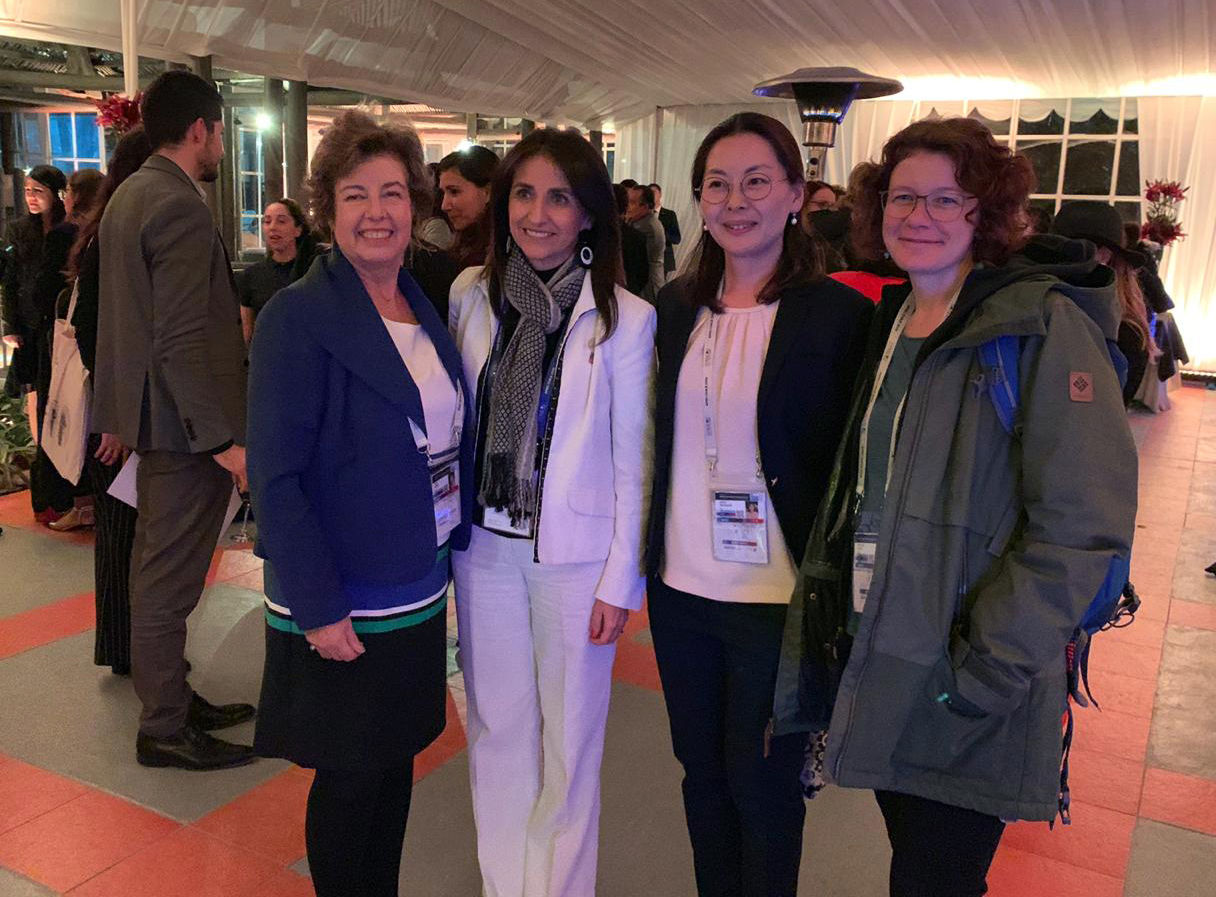
In the event, national and foreign business and political leaders attended, aimed to discuss the economic empowerment of women, considering the opportunities offered by new industries and digital development at the regional level.
"To me, it is important to be able to show the achievements in highly specialised fields such as astronomy, since people are often not very aware of them. For this reason, sharing the realities of the academic and scientific environment becomes very important when it comes to recognising the outstanding work carried out by women and in doing so, inspiring others as well", said Dr. Stutz, who has focused on the Orion molecular cloud, the most massive and near high-mass star-forming region, and together with her collaborators developed a new model for cluster formation in that cloud.
Moreover, the "Women and Astronomy" Forum was held at the Regional Library Gabriela Mistral in La Serena on 4 October, where several women astronomers gave talks to students and the general public. "This activity began with a remarkable talk by Dr. Rodolfo Barbá from the University of La Serena on the historical role of women in Chilean society. I then shared with the attendees my personal and professional experiences as a woman who has completed her studies and has professionally worked in the USA, Germany, and Chile", said Dr. Stutz, who has been part of the Department of Astronomy at the University of Concepcion as a professor since 2016.

At the event, the speakers discussed the role of women in astronomy, their contributions and what it is like to work in observatories. Moreover, they addressed the challenges of balancing professional and personal life and emphasised how diversity among researchers can offer new perspectives for addressing complex scientific problems.
"It is truly enriching to share experiences with new generations and the general public. I could see the interest and enthusiasm of the attendees and also receive feedback from them, one of the most important aspects of events of this kind", concluded Dr. Stutz.
These activities are part of the more than 200 meetings that form part of the Asia-Pacific Economic Cooperation (APEC), set to take place in November this year. APEC is an international forum established in 1989 by Australia and Japan to strengthen communities in the Asia-Pacific region. It has 21 members, referred to as "economies". These are: Australia, Brunei Darussalam, Canada, Chile, China, Hong Kong, Indonesia, Japan, South Korea, Malaysia, Mexico, New Zealand, Papua New Guinea, Peru, the Philippines, Russia, Singapore, Chinese Taipei, Thailand, the United States, and Vietnam.
Celeste Burgos BadalDepartment of Astronomy Communications
Concepción, 3 October 2019
Dr. Douglas Geisler named Emeritus Professor of the University of Concepcion
Dr. Douglas Geisler, scientist and academic, was awarded the title of Emeritus Professor by the Academic Council of the University of Concepcion - an honorary title granted to distinguished academics at the university.
The ceremony was held on 2 October at 16:00 in the Salón del Mural of the University of Concepcion. Attending the ceremony were the Rector, Dr. Carlos Saavedra; the Dean of the Faculty of Physical and Mathematical Sciences, Dr. Roberto Riquelme; the Director of the Department of Astronomy, Dr. Ricardo Demarco; as well as academics and colleagues, and friends and family of Dr. Geisler.
"It's a tremendous honour, the best of my life, it is one of the most prestigious recognitions that a professor can receive and I'm extremely proud of it", commented Dr. Geisler, who has worked at the university for more than 20 years as an academic and researcher. Dr. Geisler is also one of the founding members who helped shape the astronomy group at the university. His research focuses on optical and infrared astronomy which he uses to analyse the ages and composition of stellar populations in nearby galaxies.
"The university has always been open to the development of our science from the days of the Rector Sergio Lavanchy and Vice-Rector Ernesto Figueroa to the present with the current Rector Carlos Saavedra. The authorities have always been willing to support our growth, and we have reciprocated with excellent work, carrying out high-quality research, winning important national and international projects, and hosting world-class scientific meetings. It is a tremendous privilege to work at this great university, and also in the most important country in terms of astronomical observations".
Among his research, it is highlight his work using the Gemini South Telescope, which resulted in capturing the first-ever image of the stellar cluster Liller 1, located at the centre of our galaxy. This cluster is inherently difficult to observe due to its huge distance and the stellar dust in the region. However, together with his group, it was possible to obtain an ultra-sharp, high-quality image, unveiling a vast city of stars and one of the few places in the Universe believed to host stellar collisions.
Dr. Geisler obtained his PhD in Astronomy at the University of Washington, USA, in 1983. Anecdotally, he recalls being part of the PhD Thesis Committee of Neil deGrasse Tyson (the astrophysicist known for conducting the sequel of "Cosmos") at Columbia University. "This happened in the 90s more or less, when I was working at the Inter-American Observatory in Cerro Tololo. Part of his thesis used a technique I developed, which led his advisor to invite me to join the committee. I met Neil in person for the first time in a scientific meeting held in La Serena in 1990, where he showed some of his research findings. Years later, at a social event, we shared a dinner, and I noticed his unique gift for teaching and entertaining at the same time", he added.
In 1999, Dr. Geisler joined the University of Concepcion, an institution where he has trained new astronomers and conducted cutting-edge research. "At the university I have had the support of many people: colleagues such as Wolfgang Gieren; all the professors and staff of the Department of Astronomy: the Dean of our faculty Roberto Riquelme (who suggested me to apply for this honour and has struggle for this many years); people such as Patricia Muñoz, María Teresa Sandoval, Marcela Sanhueza, Marllory Fuentes, Jeanette Espinoza, who have transformed our faculty and department into a welcoming and efficient place to work; and finally, my wife, María Eugenia Barraza, who has always accompanied me through life, supporting me in everything", concluded Dr. Geisler.
|
|
|
|
|
|
Department of Astronomy Communications
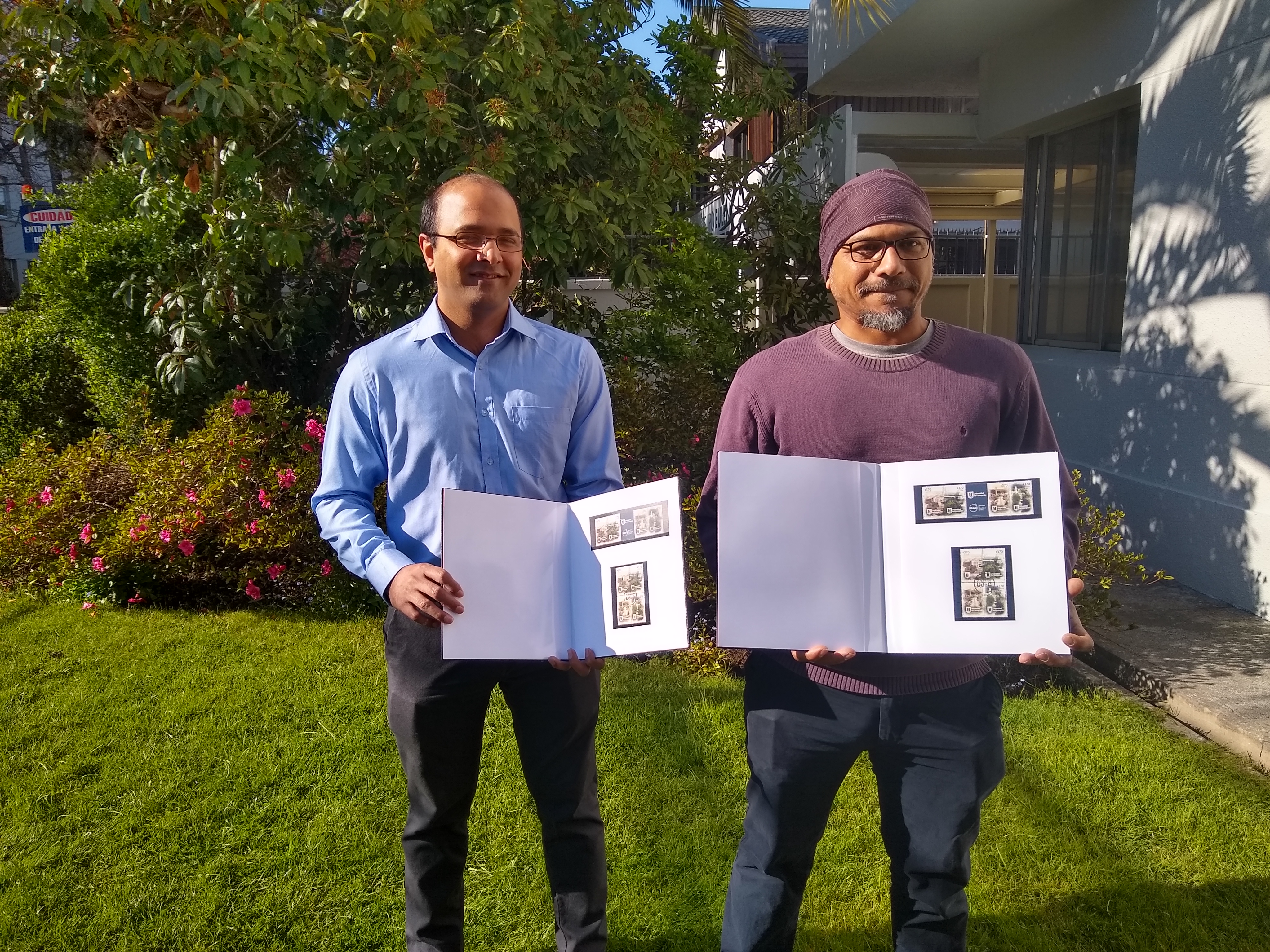
Concepción, 13 September 2019
Rector Saavedra honours astronomers on Breakthrough Prize-winning team
On September 13, the rector of the University of Concepcion (Udec, from its Spanish initials) Carlos Saavedra welcomed to the Rectorate's offices Drs. Neil Nagar and Venkatessh Ramakrishnan, both UdeC astronomers and members of EHT, an international group of scientists who captured the first image in history of a supermassive black hole, for which the team was awarded the Breakthrough Prize in Fundamental Physics.
Rector Carlos Saavedra stated: "This is a major prize for astronomy, but also a recognition for the University. Astronomy is one of the most proactive fields at UdeC; we thank them for their work and dedication in achieving this significant scientific advance".
Dr. Neil Nagar, for his part, expressed his gratitude for this recognition and stressed that through the Breakthrough Prize in Fundamental Physics all EHT members are equally recognised. "We are proud of this prize, especially because the hierarchy was not considered here, but rather all international members who were equally acknowledged", he commented.
Regarding the Breakthorugh Prize, Dr. Ramakrishnan commented: "It is a great recognition for the entire team and also for the young researchers who are part of the team, helping to develop new research positions for the future. I am grateful for the recognition the University is granting us today and for the support it provides us to carry out research", he concluded.
Let us recall that both researchers and more than 300 researchers of the EHT international collaboration were awarded 3 million dollars as part of the Breakthrough Prize in Fundamental Physics. Regarding this, Dr. Ramakrishnan commented: "These funds will allow us to improve the EHT infrastructure, collaborate with more researchers by creating more job positions, organise scientific conferences and publish articles, among other possibilities".
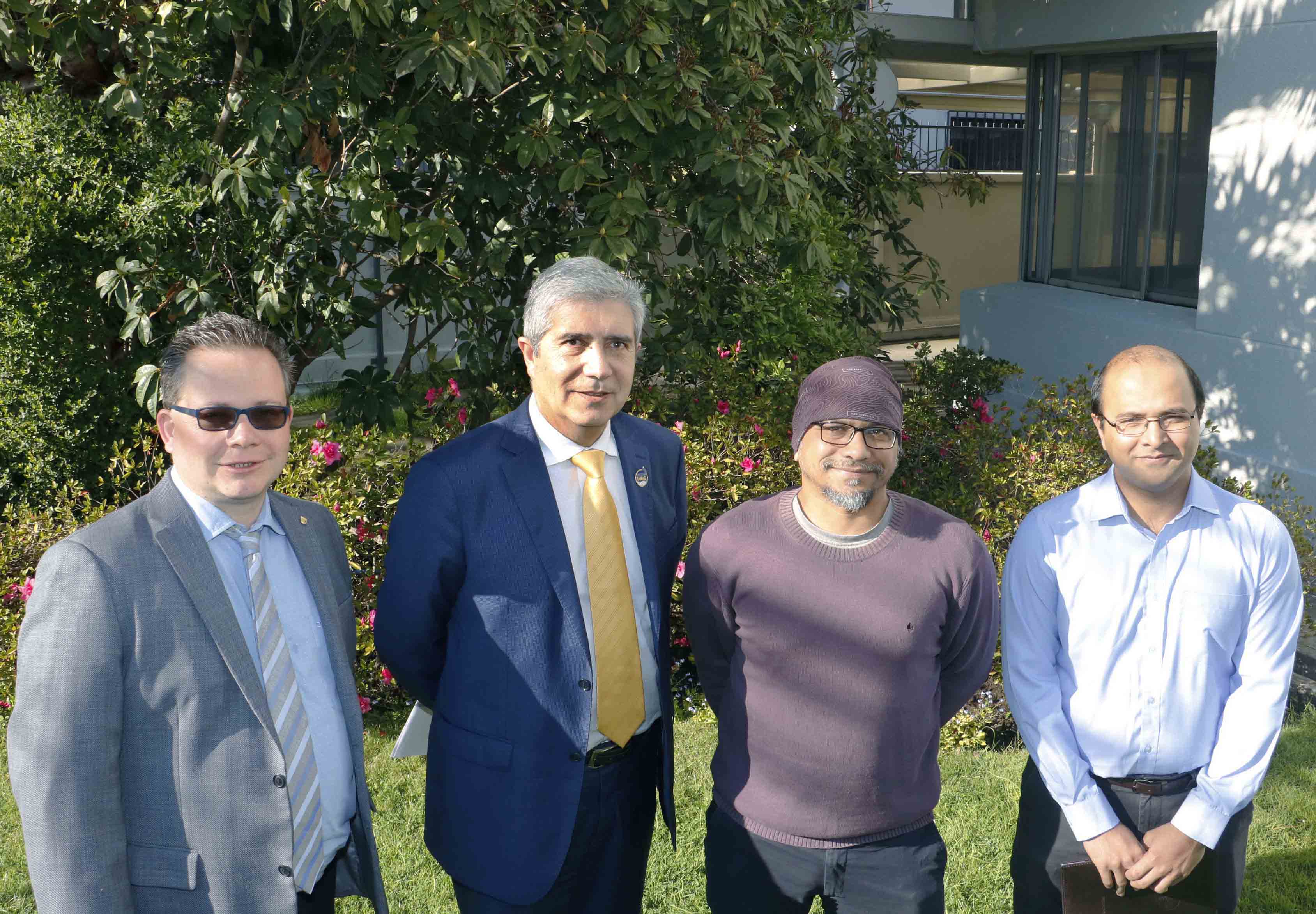
|
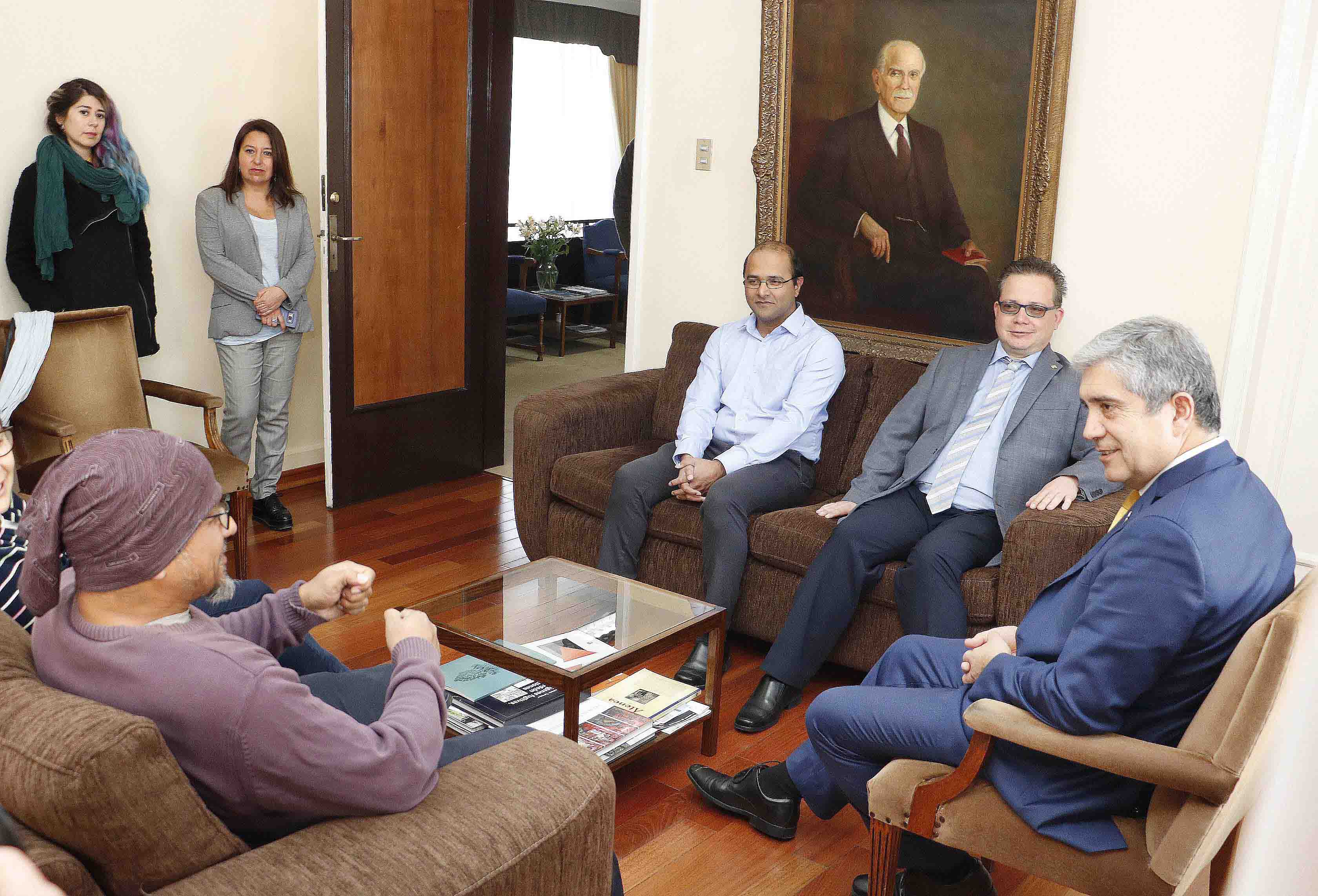
|
Department of Astronomy Communication
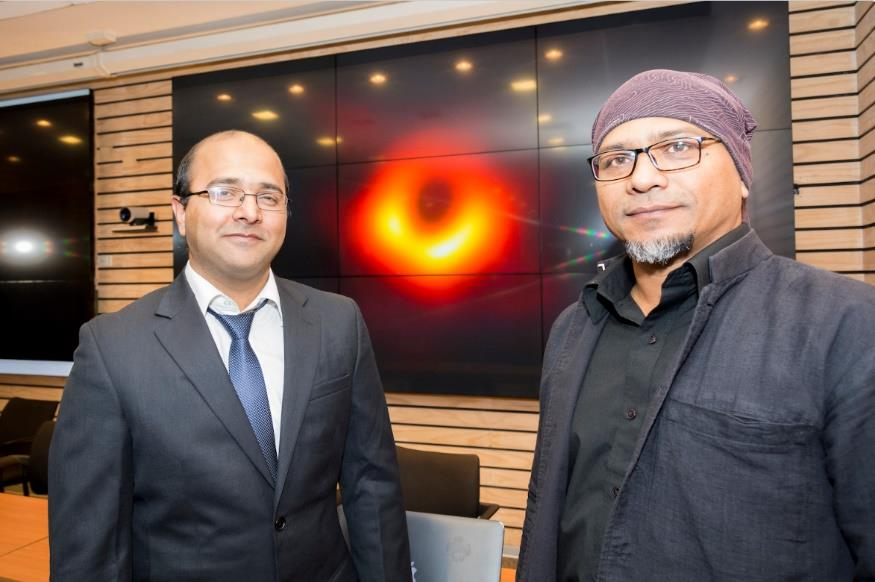
Concepción, 12 September 2019
Researchers who captured the first image of a black hole were honoured with the 2020 Breakthrough Prize
The Breakthrough Prize Foundation and its founding sponsors, Sergey Brin, Priscilla Chan, Mark Zuckerberg, Ma Huateng, Yuri and Julia Milner, and Anne Wojcicki, announced the awardees of this year. Among them, the "Fundamental Physics" category recognised the 347 researchers who contributed to capturing the first image of the shadow of the supermassive black hole in M87, taken by the EHT and published on 10 April, marking a milestone for science and astronomy.
The Breakthrough Prize, considered the "Oscars of Science", consists of US$3 million, evenly split among the 347 EHT researchers, and will be received by Shep Doeleman, Director of the EHT, on behalf of all awardees, on 3 November.
Part of this group includes Drs. Neil Nagar and Venkatessh Ramakrishnan, an academic staff member and postdoctoral researcher respectively, at the Department of Astronomy, University of Concepcion, who, thanks to their contribution to the EHT, made the university the only Chilean institution to be part of this astronomical milestone.
Therefore, on Friday 13 September at 10:00, at the Rectorate building of the University of Concepcion, the Rector Carlos Saavedra will receive both researchers in recognition of their work and award. During this event, a press conference will also be held in order to provide further details about the award and the ongoing research of the two scientists.
"I deeply appreciate that on this occasion, unlike the Nobel Prize which awards leaders of scientific groups, it was decided to recognise each member who contributed to capturing the image of the black hole, regardless of who the leader or founder of the project was, demonstrating the importance that each and every member has in achieving the proposed objectives", stated Dr. Neil Nagar, academic at the Department of Astronomy and EHT member, who received this prize.
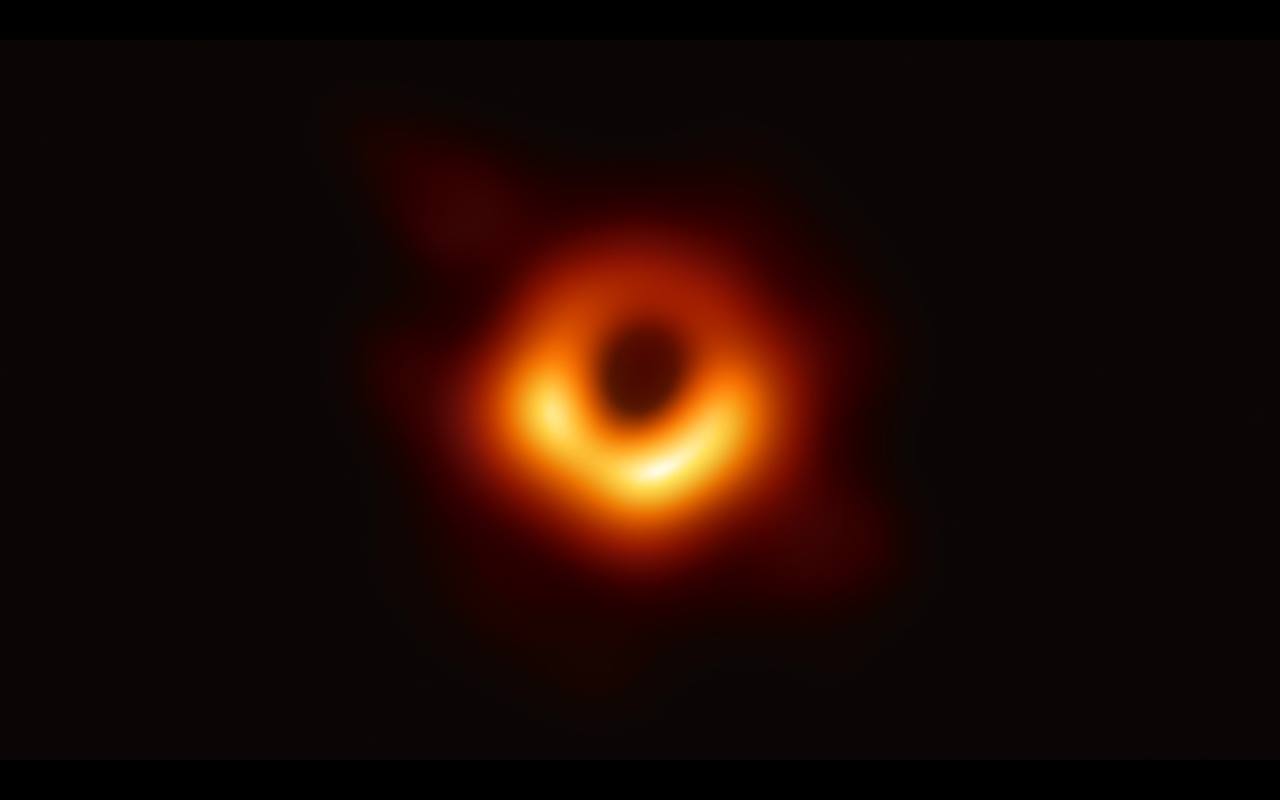
Meanwhile, Dr. Venkatessh Ramakrishnan, who is conducting postdoctoral research at the Department of Astronomy in the University of Concepcion, stated: "The Breakthrough Prize is one of the highest honours to date, and receiving it as an active EHT member opens up possibilities to obtain a more competitive role in the future, and to continue research on the Event Horizon Telescope".
Expectations for the Nobel Prize in Physics
Regarding this topic, Dr. Ramakrishnan pointed out that "there are always several expectations for awards from around the world by many people in the astronomical community, including the Nobel Prize. However, within our team, our focus is on producing high-quality results without any expectation of receiving any kind of prize, as that would distract us from our primary aim".
"We, as members of the EHT Collaboration, continue working on this research and we expect to publish more results within one or two years on SgrA*, M87 and other galaxies. With these new results, our science will reach a much more mature stage, paving the way for, maybe, a Nobel Prize", commented Dr. Nagar.
Concerning the planned use of the prize money, Dr. Ramakrishnan explained: "The funds obtaind will allow us to upgrade the EHT infrastructure, create more positions to facilitate collaboration with researchers, support attendance at scientific conferences and publish articles, among other options", he concluded.
It should be noted that, besides the Breakthrough Prize, both researchers received the Recognition Medal from the Chilean Parliament last April for their important contribution to science and humanity by publishing the first image of the shadow of a supermassive black hole, achieved through simultaneous observations by eight radio telescopes all pointed at the galaxy M87 and located around the world. In this way, astronomers transformed our planet into a giant telescope- the EHT -in order to obtain an unprecedented resolution, enabling the visualisation of ,for the first time in history, the black hole's silhouette in great detail, thus confirming theoretical predictions regarding the structure of these types of celestial objects.
Currently, the EHT Collaboration team continues to conduct research on black holes, specifically the supermassive black hole at the centre of the Milky Way, Sagittarius A, SgrA*. "We hope to obtain new images and more detailed results regarding M87 and other galaxies. In this way, we expect to have many more results in the near future, contributing to stronger tests in physics, particularly the General Theory of Relativity", concluded Dr. Nagar.
Breakthrough Prizes
- In 2012, four billionaire marriages- the co-founder of Google, Sergey Brin and biologist Anne Wojcicki; the founder of Facebook Mark Zuckerberg and Priscilla Chan; Russian physicist Yuri Milner and his wife Julia Milner; and Jack Ma, owner of a successful Chinese e-commerce company, and his wife Cathy Zhang -decided to establish the Breakthrough Prizes to recognise outstanding contributions to science.
- It includes Fundamental Physics, Mathematics and Life Sciences, as well as the 'New Horizons' category for early-career researchers.
- The prize is worth 3 million US dollars, twice the amount awarded by the Nobel Prize.
- This is the eighth occasion the prize has been held, and the jury is made up by scientists who have won in previous editions.
About the awarded UdeC researchers
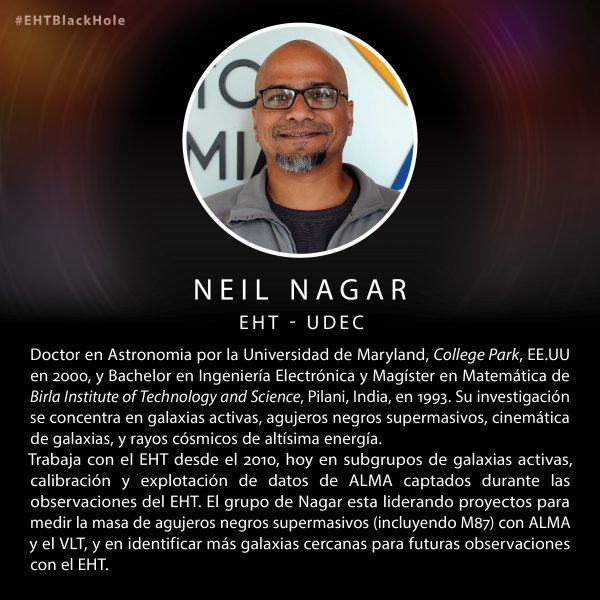
|
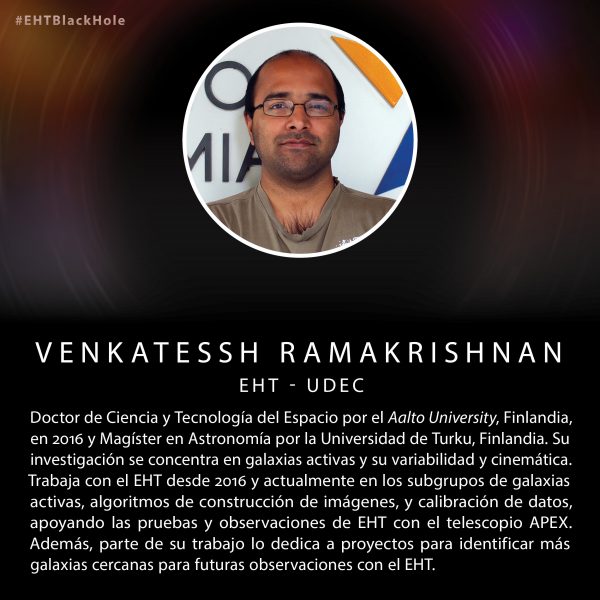
|
Department of Astronomy Communications
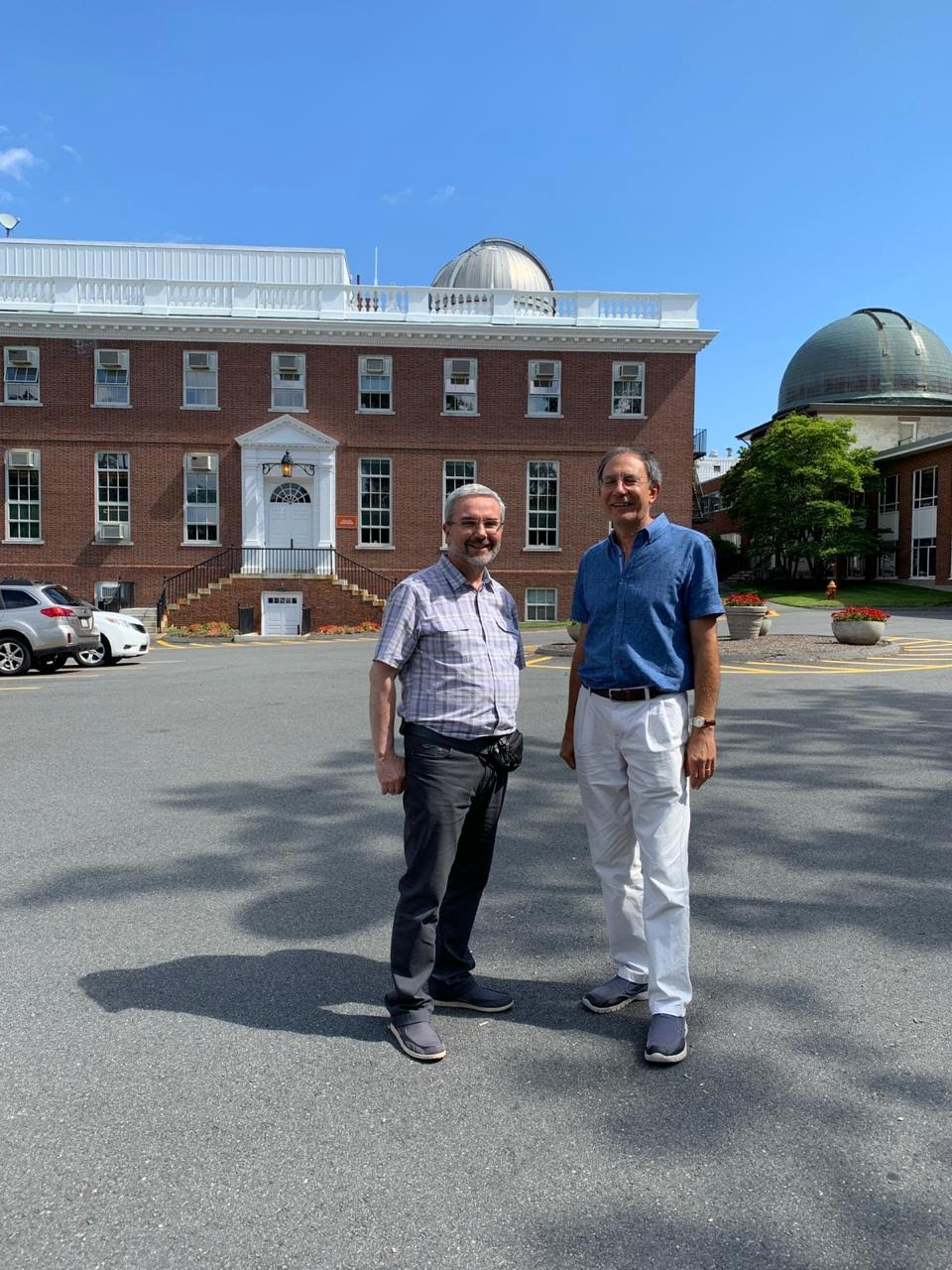
Concepción, 11 September 2019
Dr. Ronald Mennickent Cid delivered lecture at Harvard University
Dr. Ronald Mennickent, academic at the Department of Astronomy and Director of Research and Artistic Creation, was invited to give a lecture at the Harvard-Smithsonian Center for Astrophysics in Cambridge, Massachusetts, on 9 September.
The academic visited Harvard to deliver a lecture on his research into mass exchange processes in binary stars, their evolution, and accretion disc activity. This work was carried out under the Fondecyt Regular Project No. 1190621, recently awarded to Dr. Mennickent.
During the event, Dr. Mennickent received valuable feedback from Dr. Selma de Mink and two of her PhD students, who are currently developing stellar evolution models for progenitors of gravitational wave sources.
The host at Harvard was academic Dimitar Sasselov, who was Dr. Mennickent’s supervisor during his postdoctoral visit in 1998/99. In 2002, Sasselov led the team that discovered what was then the most distant known planet in the Milky Way, whose light takes five thousand years to reach Earth.
Moreover, Sasselov is the director of the Harvard's Origins of Life initiative, an interdisciplinary research programme in astrobiology. As part of his work, he travels around the globe with his students to collect in situ samples of geological sediments at Earth's primitive stage, which allows them to study extremophiles - microorganism potentially adapted to life in conditions similar to those on other planets. The academics Mennickent and Sasselov discussed the possibility of the University of Concepcion hosting a future visit to the Atacama Desert. This motivated by the unique conditions the region offfers for studying organisms adapted to extreme environments. It would also encourage cross-disciplinary research between astronomy, geology, biology, and other field at our institution, in the emerging field of astrobiology, where the involvement of professionals from different disciplines is key.
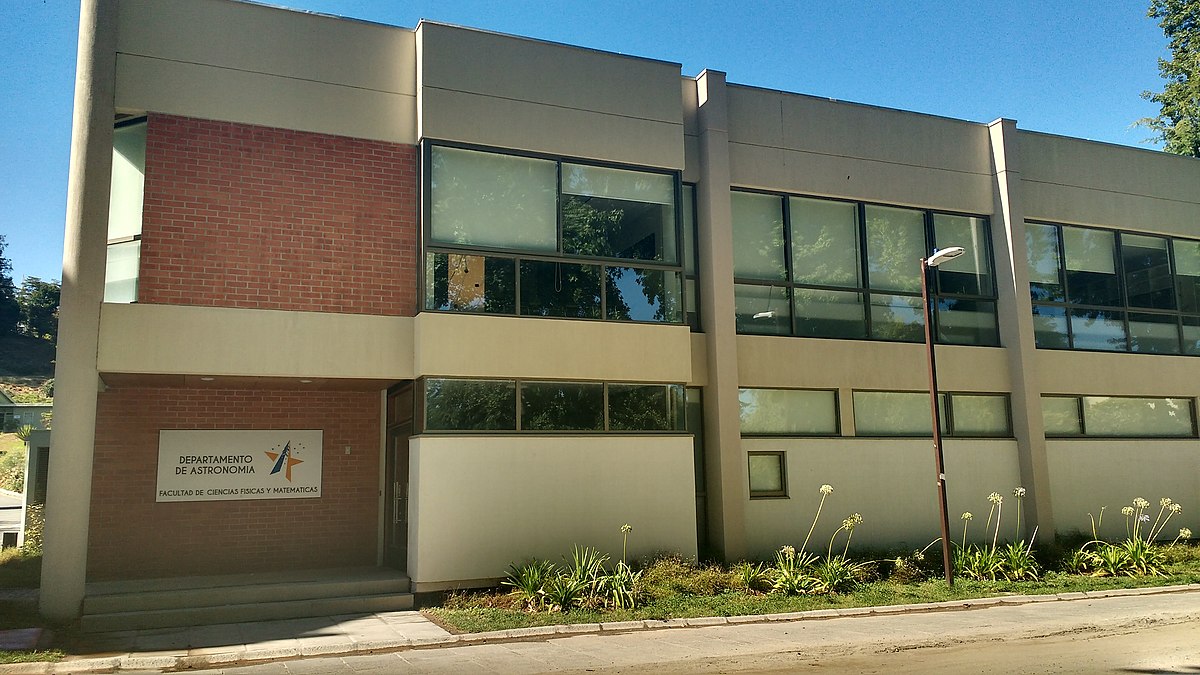
Concepción, 29 August 2019
Astronomer from the Department of Astronomy to lead team associated with the Max Planck Institute for Extraterrestrial Physics in Chile
Dr. Rodrigo Herrera-Camus, an academic at the Department of Astronomy of the University of Concepción, will lead the “Baryonic Cycle in Galaxies” team, in association with the Max Planck Society.
This collaboration will last five years and aims to promote the exchange of knowledge between researchers and students from Chile and Germany through research, internships, meetings and lectures, with a focus on the study of galaxy formation and evolution.
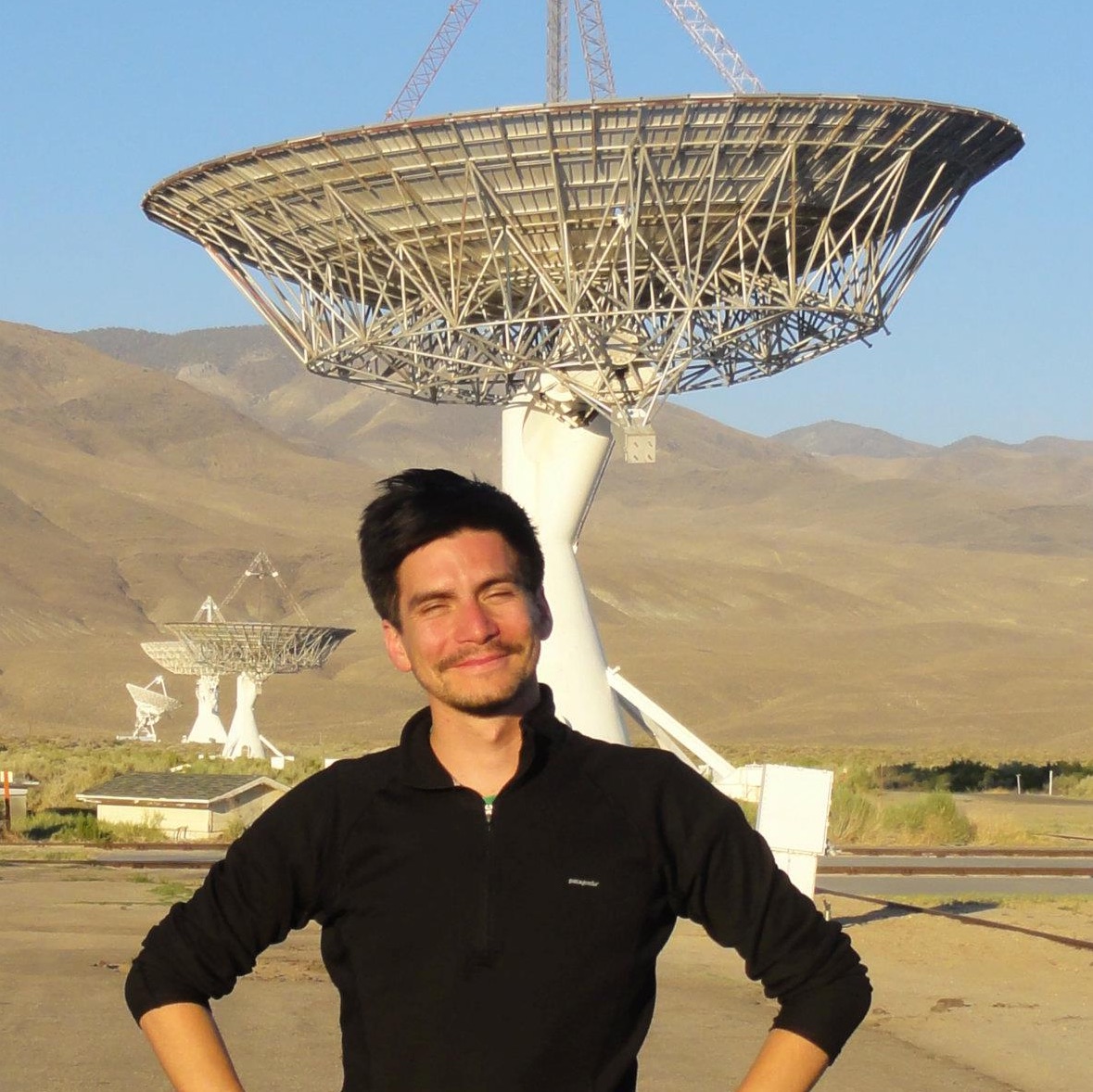
Dr. Rodrigo Herrera-Camus completed his postdoctoral studies at Max Planck Institute for Extraterrestrial Physics in Germany where he joined the Infrared/Submillimetre Group. "There, I worked with the Group Leader , Dr. Reinhard Genzel, we submitted a proposal to the President of the Max Planck Society to create a group in Chile. Our application was reviewed by a panel of experts and then accepted, hence, for the following five years we will focus on strengthening research and the exchange of knowledge in the field of astronomy", explained Dr. Herrera-Camus.
The research will be conducted at ALMA and VLT observatories in Chile and NOEMA in France. It will focus on studying the properties of molecular and ionised gas in galaxies as they evolve. "ALMA is currently revolutionising our understanding of the properties of molecular gas in galaxies, particularly those we can observe when the Universe was less than one or two billion years old. For example, one of the collaborative projects is focused on kinematic properties of a galaxy when the Universe was only one billion years old. This will allow us to learn about its structure - both baryonic and dark matter - and how advanced it is in its formation process", noted Dr. Herrera-Camus.
As mentioned earlier, one of the key goals of this project is to create a collaborative network between the Max Planck Society and the astronomical community in Chile. "On the scientific side, we expect to make significant contributions to the field of galaxy evolution, while on the academic side, our interest lies in promoting the exchange of experiences, knowledge and ideas for future projects between students, postdocs, and academics from both continents through regular visits and remote meetings", explained Dr. Rodrigo Herrera-Camus.
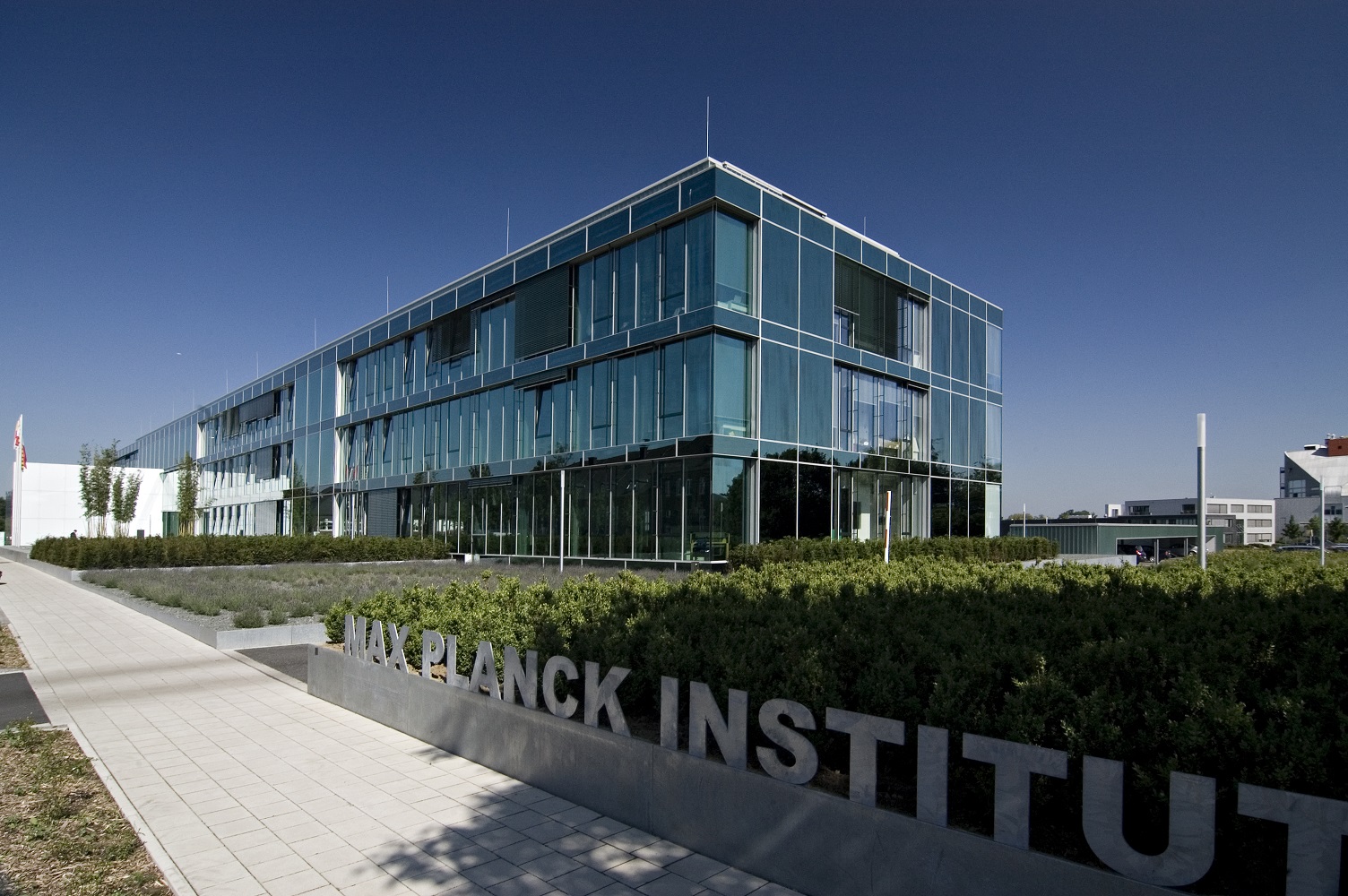
Through this collaboration, it is expected that academics and students from the Department of Astronomy conducting research in galaxy astrophysics are able to join and take full advantage of the exchange and collaboration opportunities offered by this programme. "The goal is that within five years we will have publications co-authored by students and professors from both institutions", concluded Dr. Rodrigo Herrera-Camus.
The Department of Astronomy, part of the Faculty of Physical and Mathematical Sciences at the University of Concepción, plays an important role in the professional training of new scientists in the region. It has highly qualified faculty members and actively engages in outreach activities to the community. Meanwhile, the Max Planck Society operates as an internationalised network of autonomous, interdisciplinary institutions. In Latin America, it has established scientific cooperation projects with Chile, Argentina, Brazil, Colombia, Mexico, Peru, and Uruguay, among others.
Celeste Burgos BadalDepartment of Astronomy Communication

Concepción, 22 August 2019
Technological advance in Astronomy at UdeC enhances precision in atmospheric water vapour measurements
The Centre for Astronomical Instrumentation (Centro Para la Instrumentación Astronómica, CePIA in spanish) at Universidad de Concepción (UdeC) is currently developing new technology aimed at enhancing the accuracy of atmospheric water vapour measurements and deepening our understanding of its influence on astronomical observations.
Northern Chile is recognised as one of the best locations in the world for conducting millimetre and sub-millimetre astronomical observations, due to its high-altitude sites and extremely low humidity. Consequently, several of the world’s most important astronomical observatories have been established in the region. However, despite these exceptional conditions, atmospheric water vapour — along with its temporal variability — has always posed a challenge to the detection of faint cosmic signals, as it both attenuates and scatters them, reducing their detectability.
As a result, several instruments and techniques have been developed to reduce the effects of atmospheric water vapour on astronomical observations. These instruments, known as water vapour radiometers, are mainly manufactured by companies in countries such as Germany and Sweden. Although there has been progress in recent years, these devices still face significant challenges when it comes to accurately measuring water vapour. Ideally, all radio telescopes would be equipped with such radiometers, as they provide key data for the calibration of scientific measurements and for planning observational strategies. However, only a few currently possess this instrument, mainly due to its high cost and limited precision. ALMA and Paranal Observatory are among the few facilities equipped with such devices.
In response to this challenge, the project "Development of Pseudo-Correlation Radiometer Prototypes for Ultra-Sensitive Systems", led by the Centre for Astronomical Instrumentation (CePIA) within the Department of Astronomy, in collaboration with the Department of Mechanical Engineering at the University of Concepción, aims to develop a water vapour radiometer prototype with greater sensitivity than those currently available on the market. The project is based on a redesigned signal reception architecture and the integration of ultra-sensitive millimetre-wave components currently under development, such as monolithic MMIC low-noise amplifiers (LNAs). In this way, the development of astronomical instrumentation is advancing from Concepción, driven by Chilean professionals, with the aim of achieving more precise results than those currently obtainable.
For instance, in the case of ALMA, the radiometers installed on the telescopes are located within the antennas, meaning they become inoperative whenever the telescope shutter is closed due to weather conditions or maintenance. As a result, this project also seeks to develop and deploy these new, highly sensitive radiometers on the Chilean high-altitude sites, enabling continuous, real-time measurements of atmospheric water vapour. The data will be stored, generating a long-term database that will be valuable for the ongoing operations of observatories located within ALMA's terrain.
Through the program: FONDEF IdeA I+D by CONICYT, CePIA researchers at UdeC develop this technology at WenuLafquen platform, also located at UdeC.
“We have been developing a prototype of a similar instrument for the LLAMA observatory, which is to be located in north-west Argentina, supported by the Quimal initiative from Conicyt, where this work is currently in the integration phase. The experience gained from developing this instrument for LLAMA significantly contributes to facilitating the design and development of the advanced water vapour measurement system now being undertaken in this project, which is supported by the Fondef initiative,” said Dr. Rodrigo Reeves, director of CePIA.
The project is conformed by the Centre for Astronomical Instrumentation of the Department of Astronomy at Universidad de Concepión, led by the Director Dr. Rodrigo Reeves and the Vice-Director Dr. Silvia Riquelme, expert in technological development. Other institutions involved include the Mechanical Engineering Department at the same university; Chinese Academy of Sciences South America Center for Astronomy (CASSACA), which contributes through various resources towads prototype validation; and the Finnish company VTT, which is interested in potentially bringing the technology to market.
Once the prototype has been tested within CePIA laboratories, it will undergo validation by CASSACA in the Antofagasta Region, where it will be compared against other instruments of its kind.
Celeste Burgos BadalAstronomy Department Communications
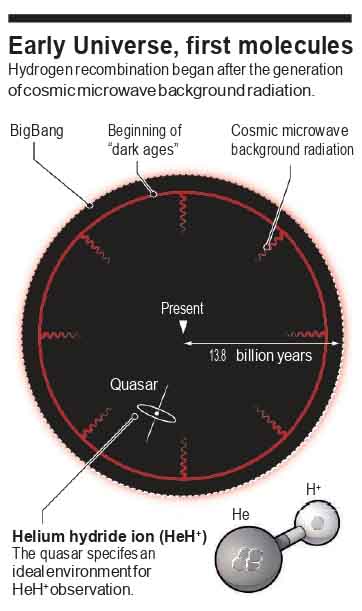
Concepción, 20 August 2019
Early Universe and its chemistry: new ideas and observation paths
Astonishing discovery for the astrochemistry world was unveiled this april: The presumably detection of the first molecular bind in the Universe. The helium hydride ion HeH+ was detected in the planetary nebula NGC 7027, confirming chemical predictions that essentially explains the Universe as we know it possible.
In august, Novotny et al. published “Quantum-state-selective electron recombination studies suggest enhanced abundance of primordial HeH+” in the journal Science. Dr. Stefano Bovino, an academic at the Astronomy Department, who was invited by Science to comment on the article, explained: "the destruction rate for HeH+ by collisions with electrons was measured. This is the most important destruction process for this molecule; in fact, it determines its abundance and observability. The experiment also represents an step forward for studies of this kind, that is, ionic molecules with electrons, which can be now applied to other molecules relevant to astrophysics".
Dr. Bovino specialises in astrocemistry and focuses on state-of-the-art models to allow comparison and a better interpretation of observational data. As astrochemist, he is involved in several different problems where microphysics is relevant, for instance, the interestellar medium in galaxies, star formation in molecular clouds, and the transition between Popullation III and II stars including the early universe's chemistry. "During my PhD I conducted studies related to HeH+. In an article of 2011, using new theoretycal calculations we combined quantum chemistry and astrochemical models, where we showed that HeH+ abundance is higher than expected from previous studies", explained Dr. Bovino.
These results generated renewed interests in this topic, where it was cited by other researchers in prestigous journals such as Nature and Science. Because of this, the journal Science invited him to comment the article "Quantum-state-selective electron recombination studies suggest enhanced abundance of primirdial HeH+".
The analysis by Drs. Stefano Bovino and Danielle Galli is titled “First molecule still animates astronomers. A study of the helium hydride ion stirs up primordial astrochemistry”. Dr. Bovino states: "Basically, in our article we comment the new articles: HeH+ observations by Rolf Güsten and collaborators and the new experiment by Novotny et al. considering the general context".
The article explains why these new studies are important for the field. "In fact, we have observed HeH+ in a planetary nebula, a hot environment where ionised hydrogen is present and HeH+ can form. However, ideally, we would like to observe HeH+ in a quasar, that is, the active nucleus of a distant galaxy in order to test theoretical predictions about the history of the Universe."
These results have open a new path for the observation of this molecule. "For example, we could observe the effect of this particle over the cosmic microwave background, because photons emitted from primordial molecules can interact with the cosmic background radiation, which generate spectral fluctuactions.", concludes the academic.
To read the analysis by the Drs. Bovino and Galli over Novotny et al. article, visit the link: https://science.sciencemag.org/content/365/6454/639/tab-pdf
To read Novotny et al., article, visit the link: https://science.sciencemag.org/content/365/6454/676.abstract
To read about the first observation, visit the link: https://www.nature.com/articles/s41586-019-1090-x
Celeste Burgos BadalAstronomy Department Communications
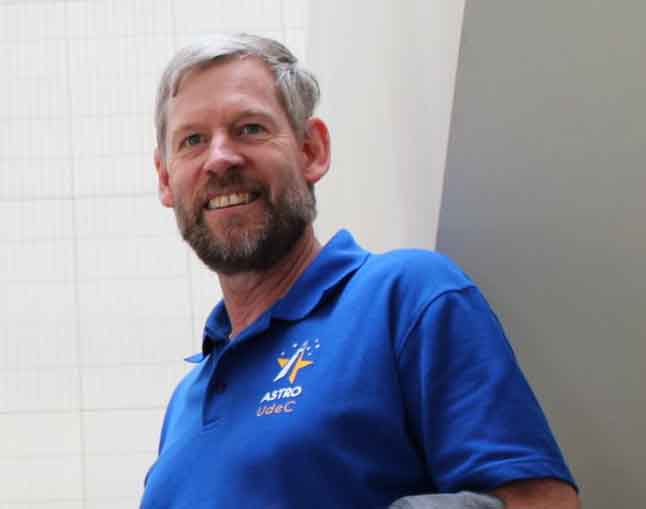
Concepción, 13 August 2019
Dr. Douglas Geisler of the Astronomy Department has been named Professor Emeritus at Universidad de Concepción
Scientist and Academic Dr. Douglas Geisler has received the title of Professor Emeritus by the Academic Council of Universidad de Concepción - an honorary degree awarded for outstanding academics of the institution.
"Its a complete honor, the greatest of my life, its one of the most prestigious distinctions a professor can receive, and I am extemely proud of it", stated Geisler. For 20 years, he has worked as researcher and professor at the institution, and he has been one of the founding members who established the astronomy group at the university. He specialized in the stellar population composition and their ages in nearby galaxies by infrared and optics astronomy.
"The university has always been open for our beloved science development, from those days with the Principal Sergio Lavanchy and Vice-Principal Ernesto Figuero to the current Principal Carlos Saavedra. Authorities has always been willing to support our growth and we had always done a good job in return. We have done high-level research, awarded important national and international projects, and we have hosted several scientific meetings of the highest quality. Its a huge privilege to work in a great university, and also in the most important country in the world for astronomical observations".
One of his distinguished investigations, refers to the first-time captured image of the stellar cluster Liller 1 - achieved through the Gemini South Telescope - located at the center of the galaxy, such object is hard to observe because of the large distance and the cosmic dust in its region. However, working alongside his team, they succeeded in obtaining an unprecedented, ultra-sharp image, revealing a uncountable stellar metropolis and one of the rare sites in the Universe where stellar collisions can occur.
Dr. Geisled obtained his PhD in Astronomy at the University of Washington, USA, in 1983. As anecdote, he mentions that he was a member of the Doctoral Committee of Neil deGrasse Tyson thesis, at University of Columbia. "This was more or less in the 90s, when I worked at Cerro Tololo Observatory. Part of his thesis employed a technique I developed, which led his advisor to invite me to join the committee. I met Neil in person for the first time in a scientific meeting held at La Serena in 1990, where he showed some results of his work; years later, in a social activity, over dinner I recognised his unique gift for educating and entertaining through his voice", he remarked.
In 1999, Dr. Geisler joined Universidad de Concepción, where he has trained new generations of astronomers and conducted cutting-edge research. "At the university, I've been supported by so many – colleagues like Wolfgang Gieren, all faculty and staff at the Astronomy Department; our Faculty Dean Roberto Riquelme, who suggested this idea to apply for this honour and has struggled for this cause for years; and wonderful people like Patricia Muñoz, María Teresa Sandoval, Marcela Sanhueza, Marllory Fuentes and Jeanette Espinoza, who have made our beloved faculty and department both welcoming and efficient. Finally, my wife María Eugenia Barraza, my lifelong companion", concluded Dr. Geisler.
Celeste Burgos BadalAstronomy Department Communications

Concepción, 05 June 2019
Astronomical Milestones achieved from Chile
It is well known that our country, Chile, is one of the best places to develop astronomy. The reason lies in its skies, the Atacama Desert has clear skies for more than 300 days that are well-suited for astronomical observations. This, combined with its low environmental humidity, readily allows for the development of this science. Hence, northern Chile is home to some of the most advanced observatories in the world and it is expected to host 70% of the world's astronomical infrastructure in the next decade.
Among all this, the Department of Astronomy at University of Concepcion stands out, with prolific researchers who are constantly carrying out outstanding research in the field.
From our Milky Way to the Large Magellanic Cloud: The most precise measurement of the Universe
One example of these achievements is the research titled "A distance to the Large Magellanic Cloud that is precise to one per cent", conducted by Drs. Grzegorz Pietrzynski (first author), Darek Graczyk, and Wolfgang Gieren, all from the Department of Astronomy and members of the "Araucaria Project", a group of 22 researchers from several countries such as Poland, France, the USA, and Germany. Through ten years of research, they succeeded in determining, with the highest precision to date, the distance between the Milky Way and the Large Magellanic Cloud, with 1% accuracy, something never achieved before and a major breakthrough for astronomy. Thanks to such research, another project, led by Nobel Prize winner Adam G. Riess, was able to determine that the Universe is expanding 9% faster than previously thought, thus strengthening the cosmic distance scale.
Event Horizon Telescope: the first image of a black hole
Another remarkable breakthrough relates to the first-ever captured image of a supermassive black hole in history. On 10 April 2019, it was announced worldwide that the Event Horizon Telescope Project succeeded in capturing the shadow of a black hole located in the centre of the galaxy M87. In this way, for the first time ever, the shadow of a black hole was visualised, located 55 million light-years from Earth and has a mass 6.5 billion times that of the Sun. In this major achievement - in which eight telescopes were used, installed in several countries and mimicking an Earth-sized telescope - two researchers from the Department of Astronomy, Drs Neil Nagar and Venkatessh Ramakrishnan, took part in the project, whose contribution made the University of Concepcion the only South American institution to be part of this success. Since 2016, these researchers together with over 200 other researchers conducted data analysis, galaxy sampling, and mass determination of black holes, among other contributions that led to this image.
|
|
|
Leighton Chajnantor Telescope: the radio telescope approaching Chile:
The project - originated by the University of Concepcion - aims to bring a new astronomical instrument from Hawaii to Chile, which will be used for deep sky surveys in a submillimetric range where data remains limited.
This high-impact project was initiated through the Department of Astronomy and is represented by Dr. Rodrigo Reeves, Head of the Centre for Astronomical Instrumentation. While it is primarily led by the University of Concepcion, other institutions involve include the California Institute of Technology and the Shanghai Normal University. The objective is to restore and relocate to Chile a 10.4-metre radio telescope currently located in Hawaii, USA, to be installed on the Chajnantor Plateau - one of the world's best sites for astronomical observation.
By utilising this instrument, it is expected to carry out deep sky surveys in the submillimetric range - which remain scarcely explored. Moreover, it is intended to characterise the reionisation epoch, a period in the early Universe that current instruments have only limited access to.
Besides, an important point to stress is that a fraction of the LCT activities will be carried out physically on the University of Concepción campus, specifically in laboratories and control rooms at WenuLafken Observatory, located within the university. This brings significant benefits in terms of international collaboration, community outreach, education, and the training of scientists and engineers.
|
|
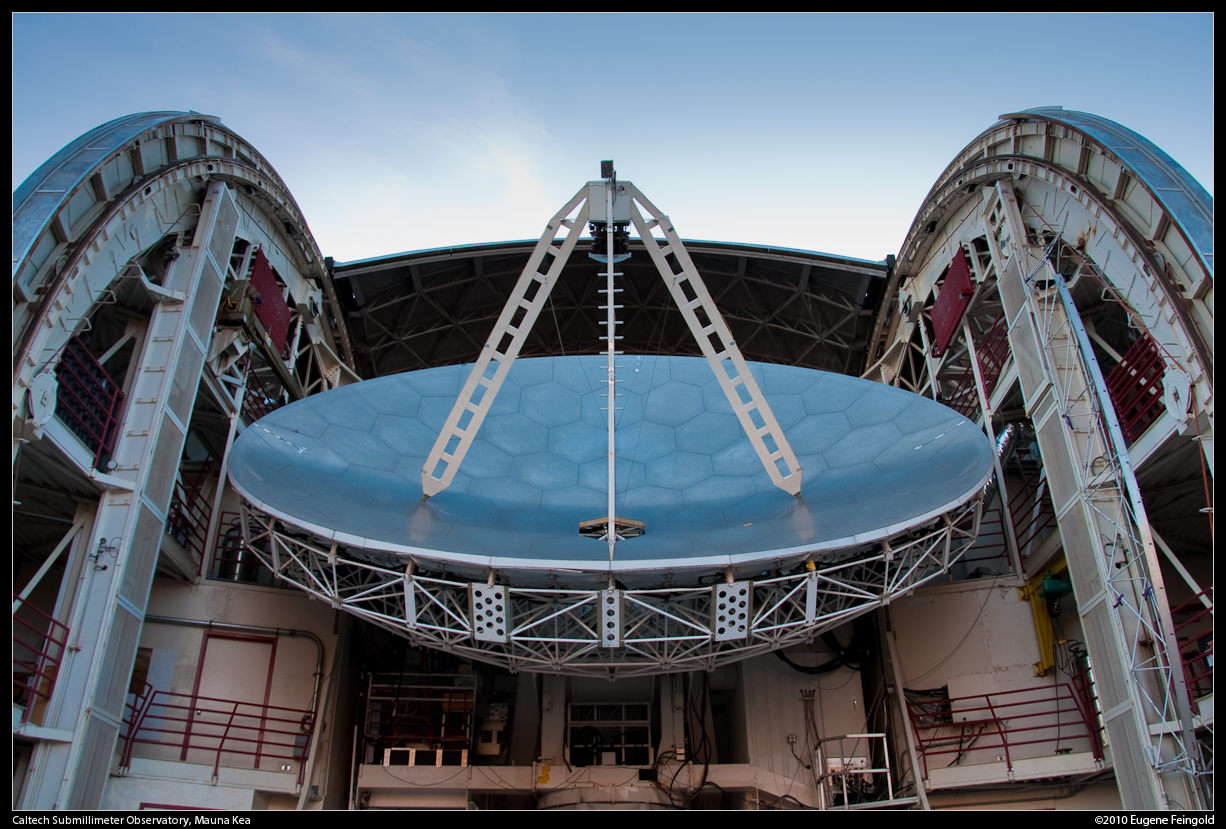
|
Department of Astronomy Communications
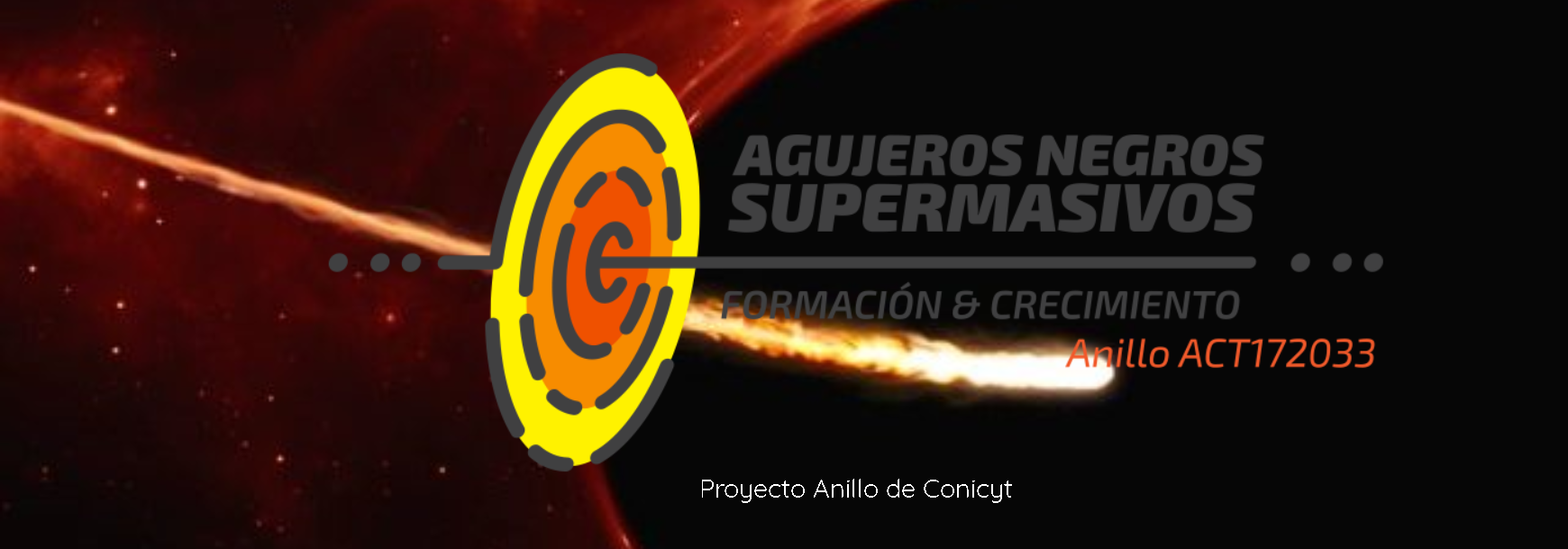
Concepción, 22 May 2019
Researchers and scientific communicators meet to discuss initiatives for Supermassive Black Hole Ring project
Researchers from Valparaíso, Metropolitana and Biobío regions will join the discussion.
From 23 to 28 May, the meeting for the "CONICYT Ring Project ACT172033: Formation and Growth of Supermassive Black Holes" will be held will be held, lead by the academic Dr. Dominik Schleicher from Universidad de Concepción .
The meeting will be host on Universidad de Concepción Campus at EmpreUdec and Astronomy Department Auditorium facilities. It will gather 32 researchers and scientific communicators from Universidad de Valparaíso, Pontificia Universidad Católica de Chile, Universidad Diego Portales y Universidad de Concepción, that are also active members of the CONICYT project.
The meeting aims to "enhance collaboration and scientific exchange, while planning next year's research and public outreach projects", explained Dr Dominik Schleicher. This includes determining all project-funded initiatives – from purely black hole research to outreach activities for community as the Astronomical Congress, Astronomy School for Teachers, and Inclusive Astronomy initiatives.
The first meeting was held in 2018 on Valparaíso aimed only for main researchers of the project, unlike the current meeting where all Ring Project members will gather.
The CONICY Ring Project ACT172033 started in 2017 aimed to study supermassive black holes from theory and observations.
Celeste Burgos BadalAstronomy Department Communications

Concepción, 16 April 2019
Astronomers from Universidad de Concepción to receive Medal Recognition by the Senate Chamber
Scientists Neil Nagar and Venkatessh Ramakrishnan will receive this dinstinction for their contribution to capturing the first-ever image of a black hole - an historical achievement for astronomy.
Congratulations continue for Drs. Neil Nagar and Venkatessh Ramakrishnan, both from the Astronomy Department of Universidad de Concepción, who will be awarded the Medal Recognition by the Senate of Chile for their contribution to Event Horizon Telescope (EHT) in capturing the first-ever image in history of a black hole's shadow.
Jaime Quintana Leal, President of the Senate of Chile, invited both researchers "for their extraordinary contribution to science and humanity". They will be received at the Senate Chamber in Valparaiso on 17 April.
On 10 April 2019, the first-ever image of a black hole was unveiled to the world. This milestone was achieved by the collaborative work of over 200 researchers from the Event Horizon Telescope (EHT) - a global network of telescopes across Chile, México, USA, Europe and the South Pole - which work as a single Earth-sized telescope. After years of research, the team succeeded in capturing this historic image, now part of scientific history.
Thanks to the contributions of Neil Nagar and Venkatessh Ramakrishnan, Universidad de Concepción became the only Chilean institution to participate in this international project.
Dr. Nagar Contribution
Universidad de Concepción has been an EHT member since its fundation. Dr. Nagar - academic at the Astronomy Department of Universidad de Concepción since 2004 - serves as co-coordinator of the EHT Working Group “AGN and Other Non-Horizon Science”. His key contributions include the analysis of ALMA datasets, support in APEX observations, proposals (e.g., Co-PI in M87 and SgrA* proposals to ALMA) and funds for postdoctoral researchers, the creation of a sample with nearby galaxies - beyond SgrA* and M87 - for EHT observations, and mass determination for black holes as M87 and other future objects aimed by EHT.
Dr. Ramakrishnan Contribution
Ramakrishnan was appointed as ALMA-Conicyt postdoctorate researcher at Universidad de Concepción since 2007 to support the scientific utilisation of EHT. He has done significant contributions for the EHT Imaging Group, participating in all imaging efforts done to M87. His work also focuses on imaging other EHT objects. Ramakrishnan specialises in both continuum and spectral line images from ALMA data obtained for the EHT, hence improving the calibration for EHT, and shortlisting a bigger sample of nearby galaxies for future EHT observations. Besides, He is actively involved in all EHT observations (past and future) at APEX.
Celeste Burgos Badal
Astronomy Department Communications

Concepción 12 April 2019
Team of Astronomers Captures the First-Ever Picture of a Black Hole
The Event Horizon Telescope (EHT), a network of eight telescopes located around the world and formed through an international collaboration, was designed to capture images of a black hole. On 10 April 2019, six coordinated press conferences worldwide revealed, as announced by EHT researchers, the first direct evidence of a supermassive black hole and its shadow.
This revolutionary advance was announced in a series of six scientific articles published in a special issue of the The Astrophysical Journal Letters. The image reveals the black hole at the centre of Messier 87 (M87) [1], a massive galaxy in the nerby Virgo galaxy cluster. This black hole is located 55 million light-years from Earth and it has a mass 6.5 billion times that of the Sun. [2].
The EHT links telescopes located worldwide to form an unprecedented Earth-sized virtual telescope. [3]. For scientists, it offers a new way to study the most extreme objects in the universe, as predicted by Einstein's general theory of relativity, in the centenary year of the historic 1919 experiment that first confirmed the theory[4].
"We have taken the first ever photograph of a black hole", declared Sheperd S. Doeleman, Director of the Event Horizon Telescope (EHT) at the Harvard–Smithsonian Center for Astrophysics "It is an extraordinary scientific achievement, accomplished by a team of over 200 researchers"
Black holes are extraordinary cosmic objects with enormous mass yet extremely compact dimensions. Their presence affects their surroundings in extreme ways, distorting space-time and overheating any surrounding material.

"If it is within a bright region, like a disc of gas shining intensely, we can expect that a black hole creates a dark region similar to a shadow, something predicted by Einstein’s general theory of relativity that we have never seen before", explained Heino Falcke, the Chair of the EHT Science Council, at University of Radboud in the Netherlands. "This shadow, caused by the gravitational bending and the light captured by the event horizon, reveals a lot about the nature of these fascinating objects and has allowed us to measure the large mass of the black hole in M87."
Using multiple calibration and imaging methods, a ring-shaped structure with a dark region at the centre - the black hole's shadow - has been discovered, which was consistently detected across several independent observations conducted by the EHT.
"When we were sure that we had captured the image of the shadow, we could compare our observations against a large library of computational models that include the physics of curved space, superheated matter and intense magnetic fields. Many of the structures in the image match the theoretical predictions surprisingly well", commented Paul T.P. Ho, member of the EHT Science Council and Director of the East Asian Observatory. "This allows us to be confident in the interpretation of our observations, including the estimated mass of the black hole".
Over 200 researchers contributed to this work. Among them were Drs. Neil Nagar and Venkatessh Ramakrishnan - an academic and a postdoctoral researcher, respectively - both from the Department of Astronomy at the University of Concepcion. Their contribution made the university the only Chilean institution to participate in this astronomical breakthrough. "This discovery is one of the most precise tests that Einstein's general theory of relativity has faced, which is now approximately 100 years old. This is because the discovery lies at the limit of strong gravity (event horizon, very close to a black hole), which makes it easier to detect small differences between observation and theory; and the theory has survived… for now", commented Dr. Neil Nagar.
"The image we captured is the strongest and most direct evidence that confirms the existence of supermassive black holes (masses millions of times greater than that of the Sun). Previously, the confirmation of the existence of black holes with masses ten times that of the Sun was through the detection of gravitational waves", noted Dr. Nagar.
"Confronting theory with observation is always a crucial moment for a theorist. It was a source of pride and relief to have concluded that observations matched the prediction so well", added Luciano Rezzola, member of the EHT Council from University of Goethe, Germany.
The creation of the EHT was a formidable challenge. It required the upgrading and connection of a global network of eight telescopes, located in multiple high-altitude locations. Among these locations, the volcanoes in Hawaii and Mexico, the mountains in both Arizona and Sierra Nevada, the Atacama Desert in Chile, and Antarctica.
The observations conducted by the EHT employ a technique called Very-Long-Baseline Interferometry (VLBI) that synchronises telescopes located in facilities around the world, and exploits the Earth's rotation to create a large Earth-sized telescope that can observe at a wavelength of 1.3 mm. This technique allows the EHT to achieve an angular resolution of 20 microarcseconds (fine enough to read a newspaper in New York from a coffee shop in Paris) [5].
The telescopes that contributed to this achievement are ALMA and APEX, both in Chile, the 30-metre IRAM telescope, the James Clerk Maxwell Telescope, the Large Millimeter Telescope Alfonso Serrano, the Submillimetre Array, the Submillimetre Telescope, and the South Pole Telescope[6]. The raw data obtained from these telescopes totalled petabytes (1 petabyte = 1.024 terabytes), and were processed and combined by highly specialised supercomputers located at the Max Planck Institute for Radio Astronomy and the Haystack Observatory at MIT.
"For ESO, it was a source of satisfaction to be able to have contributed significantly to this result through its European leadership and its fundamental role in two telescopes that are part of EHT, ALMA and APEX, located in Chile" [7], said Xavier Barcons, Director General of ESO. "ALMA is the most sensitive facility in the EHT, its 66 high-precision antennas were vital in making the EHT a success".
The construction of the EHT and the observations announced today represent the culmination of decades of theoretical, technical, and observational work. This example of teamwork required the close collaboration among researchers from around the world. Thirteen institutions worked together to create the EHT, using both pre-existing infrastructure and support from many institutions. The key funding was provided by the National Science Foundation (NSF), the European Research Council (ERC), and funding agencies in East Asia [8].
"We have achieved something that, just a generation ago, seemed impossible", concluded Doeleman. "The revolutionary advances in technology, the links between the world’s leading radio observatories, and the innovative algorithms, all of these together have opened an entirely new window for studying black holes and the event horizon".
Notes
[1] The shadow of a black hole is the closest we can come to capturing the image of a black hole, an entirely dark object from which light cannot escape. The boundary of a black hole - the event horizon, from which the EHT takes its name - is approximately 2.5 times smaller than the projected shadow and is almost 40 billion kilometres.
[2] Supermassive black holes are relatively small objects, which has made it impossible to observe them directly until now. Given that the size of the event horizon is proportional to its mass, the more massive it is, the bigger its shadow becomes. Thanks to its large mass and its relative proximity, it was predicted that the black hole in M87 would be one of the most visible from Earth, making it the perfect target for the EHT.
[3] Although the telescopes are not physically connected, they are able to synchronise their data using atomic clocks — hydrogen maser, which precisely measure the time of the observations. These observations were taken at a wavelength of 1.3 mm during a worldwide campaign conducted in 2017. Each telescope produced a large amount of data - approximately 350 terabytes per day - which was stored in high-performance helium hard drives. This data was sent to specialised supercomputers - known as correlators - located at theMax Planck Institute for Radio Astronomy and the MIT Haystack Observatory , where they were combined. Then, using novel computational tools developed by the collaboration, the data was carefully converted into an image.
[4] A hundred years ago, two expeditions were sent to Principe (off Africa's coast) and Sobral (Brazil) to observe the solar eclipse in 1919. The aim was to test general relativity by observing whether starlight would bend around the edges of the Sun as predicted by Einstein. Inspired by these observations, the EHT sent members to some of these remote and high-altitude radio astronomy facilities to test once again our understanding of gravity.
[5] The participation of the East Asian Observatory in the EHT represents also the involvement of many regions across Asia, including China, Japan, Korea, Taiwan, Vietnam, Thailand, Malaysia, India and Indonesia.
[6] Future EHT observations will benefit from substantially higher sensitivity thanks to the participation of the IRAM NOEMA Observatory, Greenland Telescope, and the Kitt Peak Telescope.
[7] ALMA (Atacama Large Millimeter/submillimeter Array) is an international astronomical facility established through a collaboration between the European Southern Observatory (ESO, Europe), the National Science Foundation (NSF, USA), the National Institutes of Natural Sciences (NINS, Japan), together with the National Research Council of Canada, the Ministry of Science and Technology (MOST, Taiwan), the Academia Sinica Institute of Astronomy and Astrophysics (ASIAA, Taiwan), the Korea Astronomy and Space Science Institute (KASI, Korea), in cooperation with the Republic of Chile. Operations of APEX are managed by ESO; the 30-metre Telescope is operated by IRAM (partners of IRAM are MPG in Germany, CNRS in France, and IGN in Spain); the James Clerk Maxwell Telescope is managed by EAO; the Large Millimeter Telescope Alfonso Serrano is operated by INAOE and the UMass; the Submillimetre Array is operated by SAO and ASIAA; and the Submillimetre Telescope is managed by ARO (Arizona Radio Observatory). Operations of the South Pole Telescope are managed by the University of Chicago and is equipped with specialised instrumentation for the ETH provided by the University of Arizona .
[8] The BlackHoleCam project is funded by the EU to capture images, make measurements, and understand black holes. The main aim of BlackHoleCam and the Event Horizon Telescope (EHT) is to capture the first image of a billion-solar-mass black hole located in the nearby galaxy M87, as well as its smaller counterpart, Sagittarius A*, the supermassive black hole located at the centre of our Milky Way. This allows us to measure with extreme precision the spacetime deformation caused by a black hole.
He obtained his PhD in Astronomy from the University of Maryland, College Park, USA, in 2000, and earned his Bachelor's degree in Electrical Engineering and Master's degree in Mathematics from the Birla Institute of Technology and Science, Pilani, India, in 1993. His research focuses on active galaxies, supermassive black holes, galaxy kinematics, and ultra-high-energy cosmic rays.
He has been working with the EHT since 2010. Currently, he is involved in sub-groups focusing on active galaxies, calibration of ALMA data collected during EHT observations. His research group is leading projects aimed at measuring the mass of supermassive black holes (including M87) utilising ALMA and VLT, and at identifying additional nearby galaxies for future EHT observations.
Currently, he has been teaching in the Department of Astronomy at the University of Concepción since 2004.
Specific roles in ALMA and EHT:
- ALMA Phasing Project (APP) and APEX: Nagar has participated in the APP since 2009 and contributed funding equivalent to approximately five years of postdoctoral funding and around $80K US in equipment, as well as to the maser installation and setting up the APP. Postdoctoral researchers Nestor Lasso collaborated in programming the PIC cards (inserted in the correlator), while the postdoctoral researchers Jay Blanchard played an important role in the installation and bringing into service. Drs. Nagar and Blanchard have also been heavily involved in most of the efforts to commissioning and conduct APEX observations from 2014 to the present.
- EHT: Dr. Nagar has participated since 2009, starting with the APP. The University of Concepcion has been an EHT member since its establishment. Dr. Nagar is co-coordinator of the "AGN and other non-horizon sciences" group of the EHT. His main contributions include the analysis of ALMA data sets, support during APEX observations, time proposals (e.g., Co-PI of the proposals for M87 and SgrA* at ALMA) and funds to mainly postdoctoral researchers, development of a sample of nearby galaxies beyond M87 and SgrA* for EHT observations, and the determination of black hole masses for M87 and other future EHT targets.
He obtained his PhD in Space Science and Technology from Aalto University, Finland, in 2016, and holds a Master's degree in Astronomy from University of Turku, Finland. His research focuses on active galaxies, particularly their variability and kinematics. He has worked with the EHT since 2016 and is currently working in the sub-groups of active galaxies, image reconstruction algorithms, and data calibration, supporting EHT testing and observations using the APEX telescope. Moreover, he dedicates part of his work to projects aimed at identifying nearby galaxies for future EHT observations.
He has been working in his postdoctoral research at the Department of Astronomy since 2016. Dr. Venkatessh was hired through the ALMA-CONICYT Postdoctoral Programme at University of Concepcion to support the scientific use of EHT. He has made significant contributions to the EHT Imaging Group, having participated in all major imaging efforts of M87, and is also dedicated to obtaining images of other EHT targets. His work includes continuum and spectral line imaging data of ALMA from the EHT, contributing to improved calibration and collecting a larger sample of nearby galaxies for future EHT observations. In addition, he has been involved in all EHT runs - system set up and observations - at APEX.
Additional information
This research has been published as a series of six articles in a special issue of The Astrophysical Journal Letters.
The EHT collaboration involves over 200 researchers from Africa, Asia, Europe, North and South America. This international collaboration is working to capture the first and most detailed images of black holes thanks to the creation of a virtual telescope the size of the Earth. Supported by significant international funding, The EHT combines pre-existing telescopes equipped with new systems, effectively creating a new instrument with greater angular resolution than ever before.
The single telescopes involved are: ALMA, APEX, 30-metre IRAM Telescope, the NOEMA-IRAM Observatory, the James Clerk Maxwell Telescope, the Large Millimeter Telescope, the Submillimeter Telescope, the South Pole Telescope, the Kitt Peak National Observatory, and the Greenland Telescope.
The EHT Consortium is composed of 13 institutes: the Seneca Academy Institute of Astronomy and Astrophysics, the University of Arizona, the University of Chicago, the East Asian Observatory, the Goethe University Frankfurt, the Institut de Radioastronomie Millimétrique, the Large Millimeter Telescope, the Max Planck Institute for Radio Astronomy, the MIT Haystack Observatory, the National Astronomical Observatory of Japan, the Perimeter Institute for Theoretical Physics, the Radboud University, and the Smithsonian Astrophysical Observatory.
The European Southern Observatory is the leading intergovernmental astronomy organisation in Europe and the most productive astronomical observatory in the world. It has sixteen member countries: Germany, Austria, Belgium, Denmark, Spain, Finland, France, Ireland, Italy, the Netherlands, Poland, Portugal, United Kingdom, Czech Republic, Switzerland, together with the host country, Chile, and the strategic partner, Australia. The institution develops an ambitious programme centred on the design, construction and operation of powerful facilities for ground observations that enables the astronomers to make significant scientific discoveries. It also plays an important role in promoting and fostering cooperation in astronomical observations. In Chile, it operates three unique observing sites in the world: La Silla, Paranal and Chajnantor. In Paranal, ESO operates the Very Large Telescope together with the Very Large Telescope Interferometer, the most advanced in the world, as well as two survey telescopes: the Visible and Infrared Survey Telescope for Astronomy, which observes in the infrared, and the VLT Survey Telescope, which surveys in visible light. In this location, ESO will host and operate the Cherenkov Telescope Array, the largest and most sensitive gamma-ray observatory in the world. ESO is also a partner in two facilities in Chajnantor, APEX, and ALMA, currently the largest operational astronomical project in the world. Finally, at Cerro Armazones, close to Paranal, ESO is building the Extremely Large Telescope, a 39-metre telescope, which is said to be "the world’s biggest eye on the sky".
Celeste Burgos Badal
Astronomy Department Communications
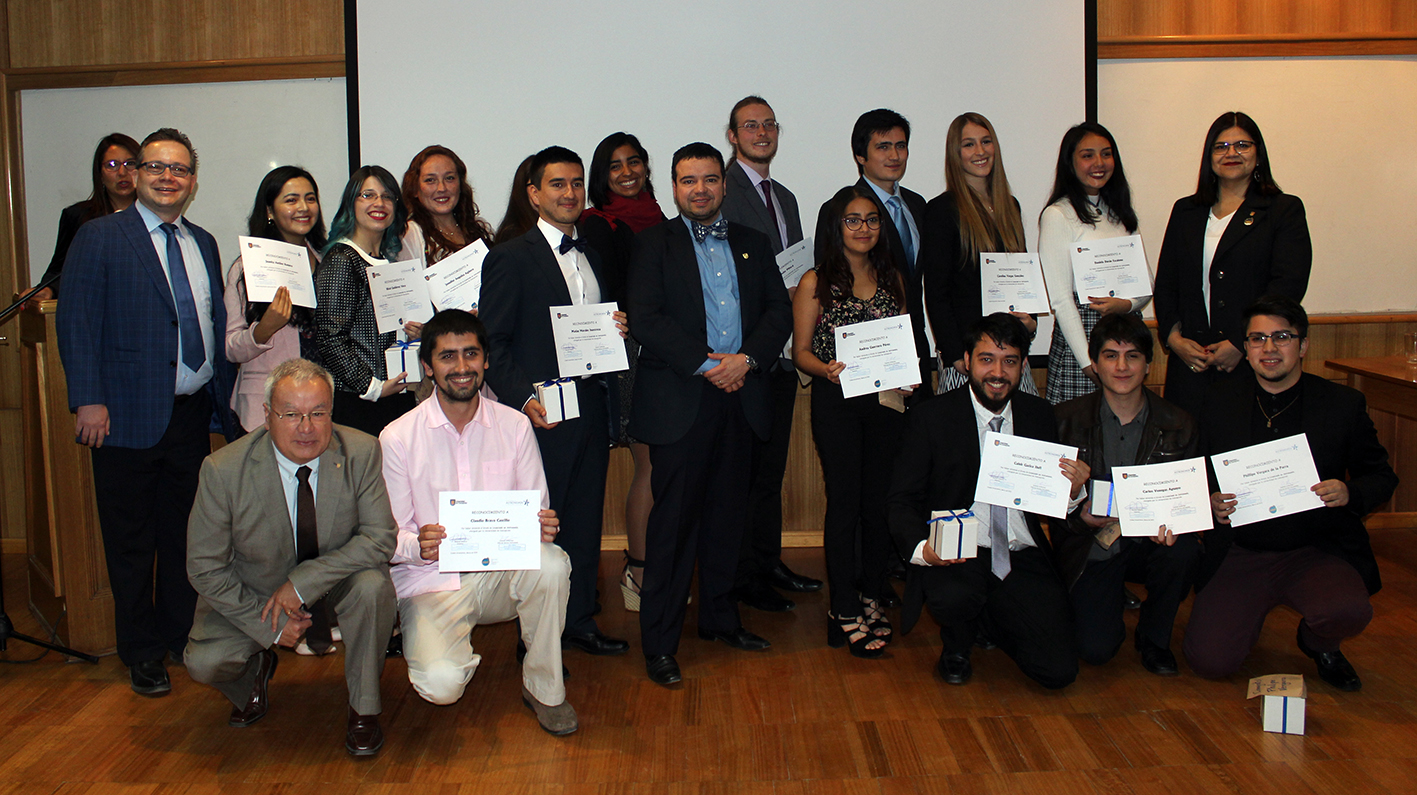
A new generation of astronomers graduates
On 30 March 2019, 16 astronomy undergraduates students from the Faculty of Physical and Mathematical Sciences celebrated their graduation. The ceremony was attended by the Dean and Vice-Dean of the Faculty of Physical and Mathematical Sciences, Dr. Roberto Riquelme and Dr. Myrna Sandoval respectively; the Head of the Astronomy Department, Dr. Ricardo Demarco; the Degree Programme Director, Dr. Dominik Schleicher; and the graduates' families.
The graduates are: Jennifer Anguita, Juanita Antilén, Claudio Bravo, Camila Cid, Marcelo Cortés, Daniela Durán, Caleb Gatica, Andrea Guerrero, Nicol Gutiérrez, Matías Morales, Morín Órdenes, Alexander Pillard, Matías Sotomayor, Carolina Vargas, Carlos Venegas and Phillipe Vergara.
Celeste Burgos Badal
Astronomy Department Communications
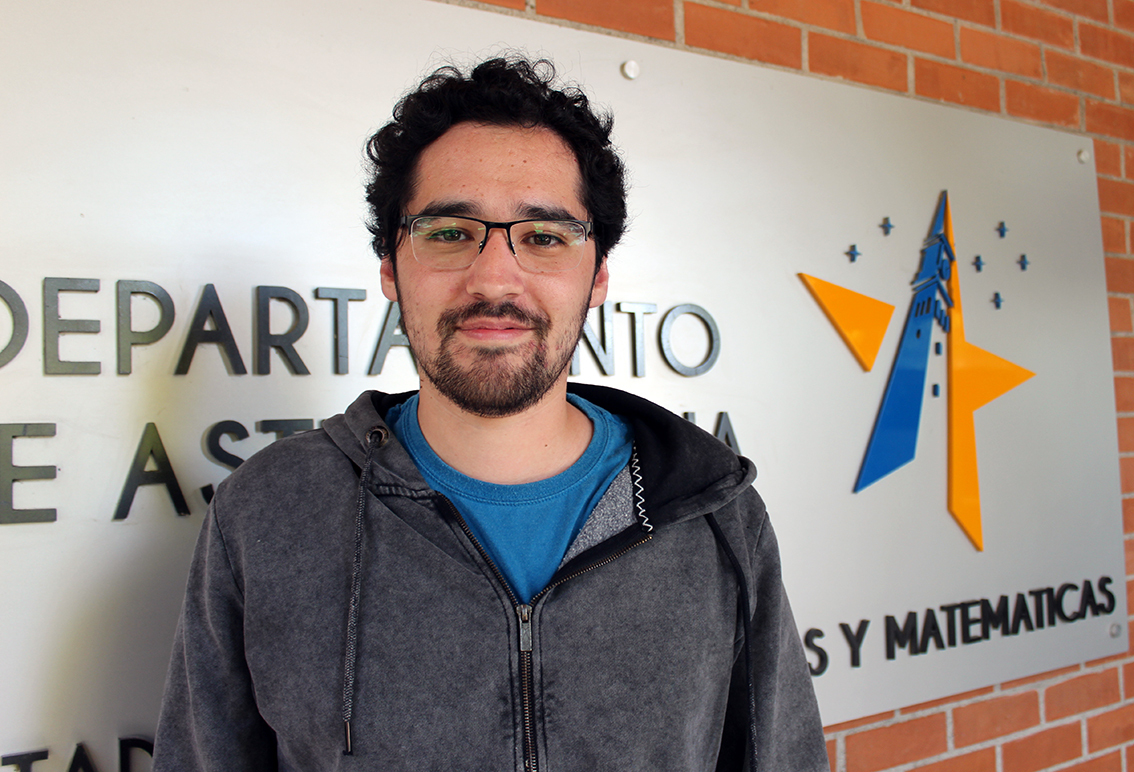
Faculty of Physical and Mathematical Sciences student awarded DAAD scholarship for studies abroad
The Astronomy Department scores another exciting news: the MSc student Felipe Navarrete, who obtained his scolarship, will course his PhD studies in stellar astrophysics for three years, particularly in magnetic fields of type M dwarf stars at Hamburg Observatory.
He will work alongside professor Robi Banerjee - director of Hamburg Observatory - and the postdoctoral researcher Marcel Völschow in the same institution.
"This research involves the development of a computational model for magnetic fields formation in type M dwarf stars. Currently, there are many enigmas related to the origin of their magnetism, as the solar analogy breaks down given that M-dwarfs are structurally different from the Sun", explained Felipe.
After the development, the model can be used to understand the underlying processes for the magnetic fields formation in type M dwarfs, perform comparison with observations, help determine what causes the eclipsing time variation in certain binary stars type, and to assess the magnetic fields impact on potentially habitable exoplanets.
During the application process, Felipe received guidance from the academic Dr. Dominik Schleicher of the Astronomy Department. "Professor Domink told me about this scolarship and supported me throughout the application process. With these studies, I hope to build an international collaborative network, which is currently indispensable for conducting high-quality science", Felipe concluded.
Celeste Burgos Badal
Astronomy Department Communications
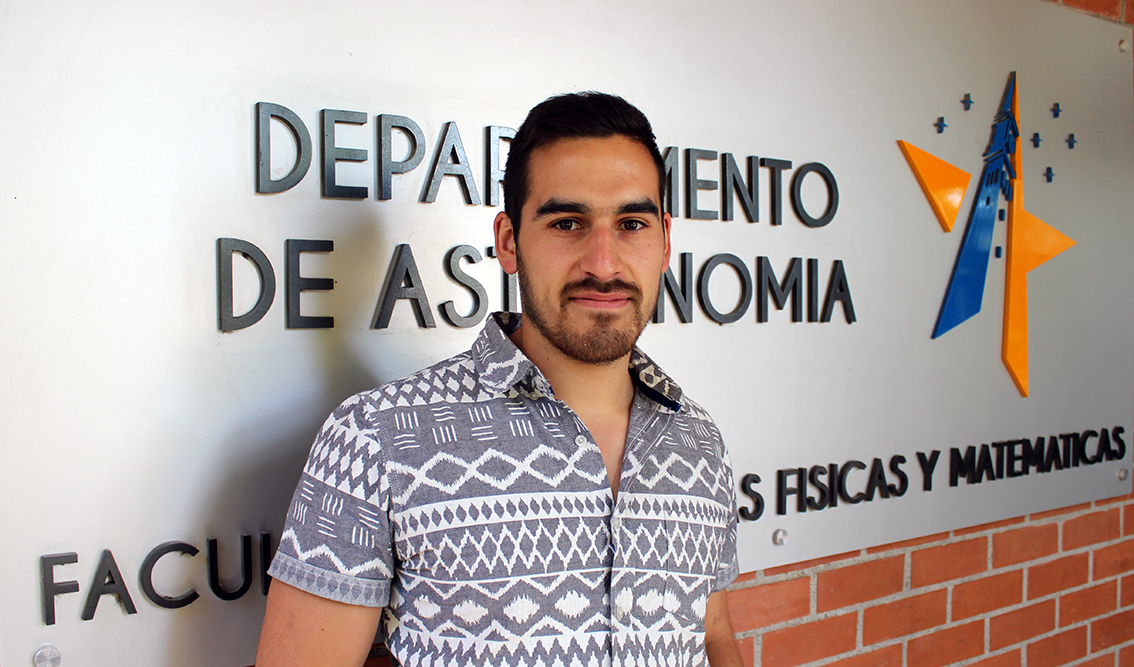
Student from Faculty of Physical and Mathematical Sciences to pursue PhD in Germany
Joaquín Zamponi, an MSc student in the Theory Group of Universidad de Concepción's Astronomy Department, has been selected to pursue his PhD at Germany's International Max Planck Research School (IMPRS). Zamponi commented: "Initially, 341 applications from 50 countries were received, with only 45 candidates shortlisted and invited for the IMPRS Recruitment Workshop (25-27 February) at the Max Planck Institute for Extraterrestrial Physics, Graching". Hence, for three years he will collaborate with the scientific community, particularly in the astrochemistry and radioastronomy, conducting synthetic observations of protostellar disks for comparison with actual ALMA interferometer observations.
In Garching, Joaquín will work in his PhD supervised by Dra. Paola Caselli and Dr. Bo Zhao in the same institution. "Professor Caselli is a leading expert in astrochemistry with near three decades of experience. Because of this, for me it is a great success to work under her supervision. Professor Zhao is an expert in numerical simulations that includes magnetohydrodynamic effects. Their work represent the cornerstone of my thesis. Once the program starts, I will be part of Center of Astrochemical Studies (CAS) in MPE", Joaquín Explained.
Currently, Joaquín is part of the Theory Group of the Astronomy Department as researcher and MSc student and said: "My contribution lies on the astrochemical and observational studies of massive star formation regions. It is important to stress the constant support to stundents from professors of the group. Thanks to this I was able to reach the needed contacts in order to apply for the PhD, without the support of my supervisors, Domink Schleicher and Stefano Bovino, the path to a successful application would have been harder."
The MPE is located alongside the Max Planck Institute for Astrophysics (MPA) and the European Southern Observatory (ESO). These institutions host over 200 international researchers working across multiple branches of astronomy. "Starting from the lowest point and being enrolled among such researchers allows me to gain scientific experience. The research workflow in the campus is exceptionally intense, with regular seminars and international guests invited who you can talk with when any question arise during thesis development. At the end, being part of the scientific community to me is one of the highest achievements to date, and I hope to meet its high standards", Joaquín concluded.
Celeste Burgos Badal
Astronomy Department Communications
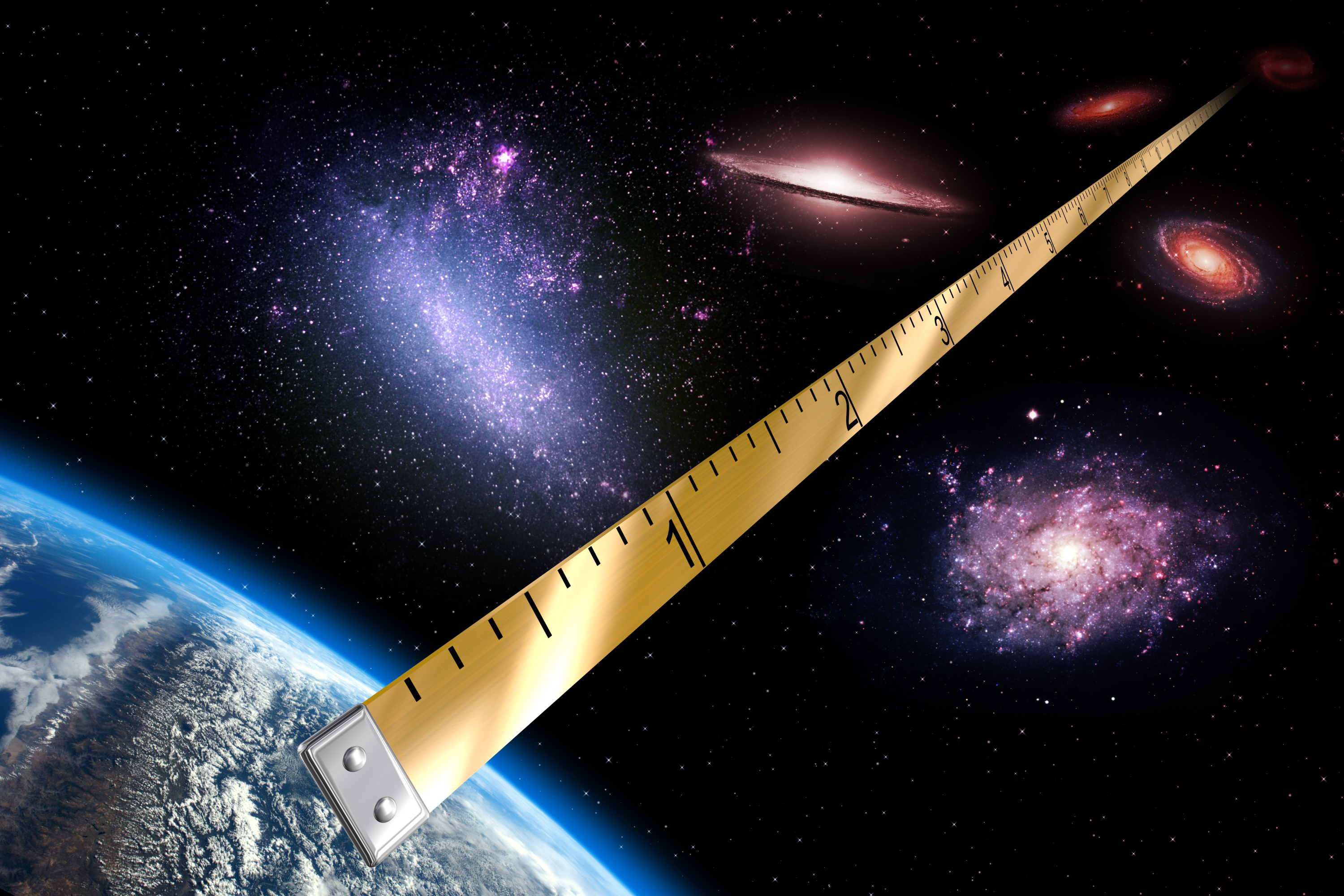
From our Milky Way to the Large Magellanic Cloud
The most precise measurement of the Universe
Over 16 years of research, a team led by academics from Universidad de Concepción has worked to refine the calibration of the cosmic distance ladder within the local Universe. They could determined the distance to the closest galaxy, the Large Magellanic Cloud, with 1% uncertainty - something never achieved before and a big success for astronomy.
The research, titled 'A distance to the Large Magellanic Cloud accurate to one per cent', was published in Nature on 14 March 2019.
The article is led by the Drs. Grzegorz Pietrzynski (first author), Darek Graczyk y Wolfgang Gieren of the Universidad de Concepción, working with a team of 22 researchers from Poland, Francia, USA and Germany.
The research forms part of the "Araucaria Project" from Centro de Astrofsica y Tecnologías Afines (CATA), supported by Instituto Milenio de Astrofísica (MAS) - led by Dr. Wolfgang Gieren of the Astronomy Department from Universidad de Concepción.
The research utilised the very rare eclipsing binary stars (one per million stars) through a novel technique calibrated by the research team. "The Large Magellnic Cloud is being used to calibrate the distance scales to all galaxies in the Universe. It is the first time in the history of Astronomy that the distance to a galaxy has been measured with such presicion".
In 2013, the same "Araucaria Project" team - established in 2002 at Universidad de Concepción - determined the distance to the Large Magellanic Cloud with 2.2% precision (published in Nature that same year). Dr Wolfgang Gieren, researcher from MAS, explains:"Improvement this precision to 1% is a huge step to better understand our knowledge of cosmic expansion and the dark energy phenomenon, which represent one of the greatest contemporary mysteries of Astrophysics"
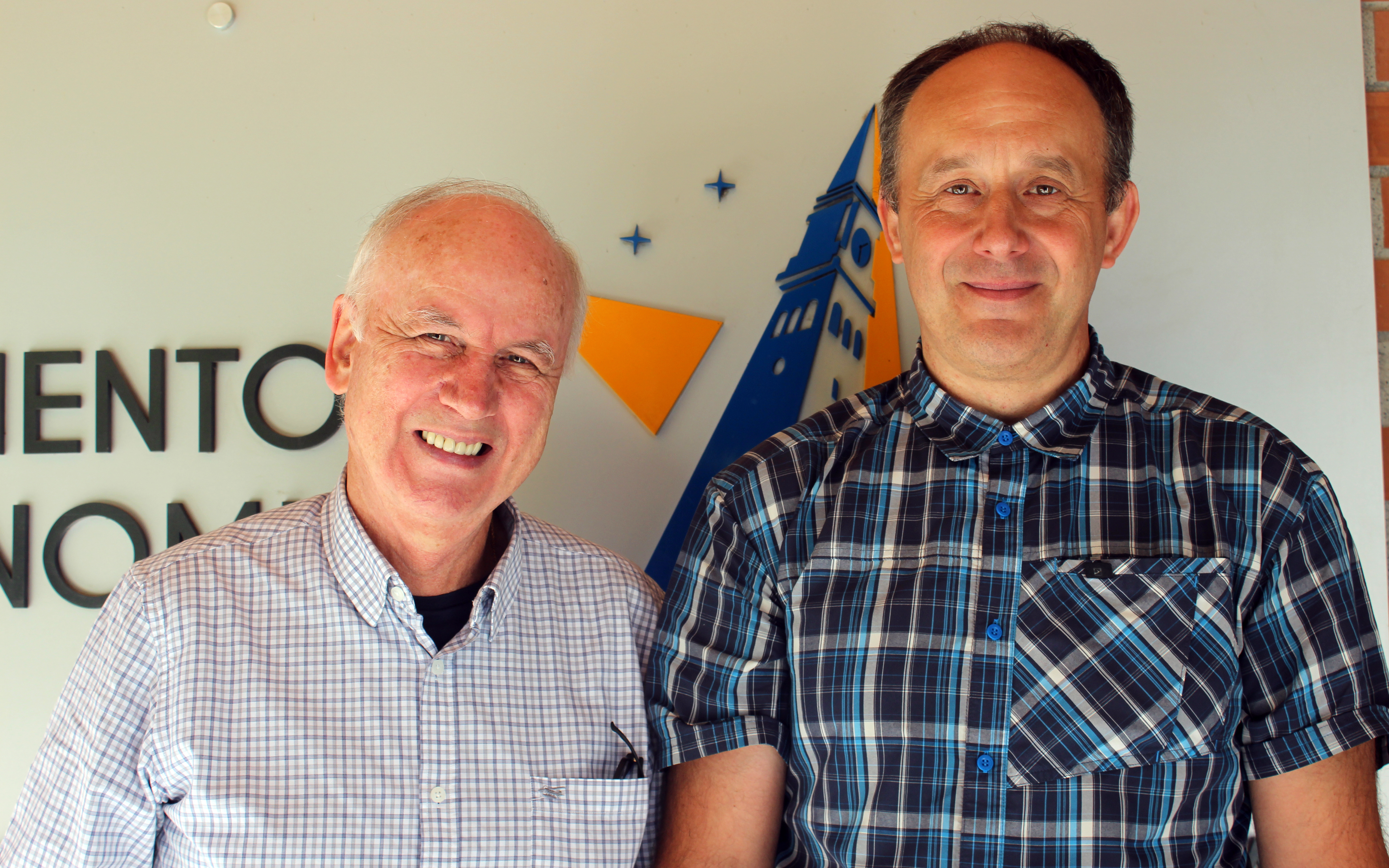
But, How was this advance achieved?
To improve the precision achieved in 2013 (from 2.2% to 1%), researchers expanded the sample of binary star systems in the Large Magellanic Cloud from eight to twenty. This was combined with a new calibration performed of the technique using interferometric measurements obtained from ESO's Paranal Observatory in Chile. The study additionally utilised telescopes at La Silla Observatory, The Magellan at Las Campanas Observatory, and the South African Astronomical Observatory (SAAO) near Cape Town, South Africa.
The research required 16 years because "the most of the binary sistems in the Large Magellanic Cloud need several years to complete their orbital cycles, which we had to completely cover through photometric and spectropic observations", clarifies Dr. Gieren, who is co-author of the study alongside Dr. Pietrzynski. Both researchers participated in observations, data analysis, and writing in the article.
Thus, after more than a decade of dedicated scientific work led from Chile, this research represents a significant advance in our understanding of the Universe's evolutionary history.
Celeste Burgos Badal
Astronomy Department Communications
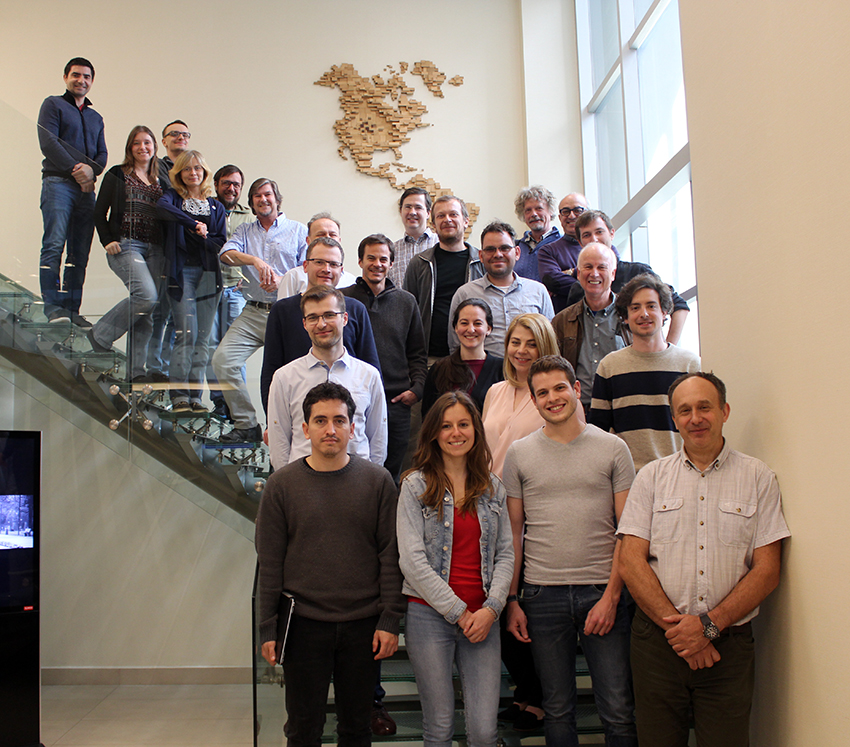
Scientists behind the universe’s most precise measurements of nearby galaxy distances meet in Concepción
On March 6, 7 and 8, the Araucaria Project science meeting will take place, aiming to share breakthroughs and collaborative strategies among researchers working on distance measurements in the Universe.
A few years ago, a team of astronomers working on the "Araucaria Project" determined with unprecedented accuracy the distance to the Large Magellanic Cloud, one of the Milky Way's closest neighbouring galaxies.
Through this work, the international team of scientists - comprising researchers from Chile, Poland, Germany, France, the United States, Italy and England - has further developed even more precise advances in the field. As a result, researchers will convene in Concepción from 6 to 8 March to discuss and share progress and plan next steps.
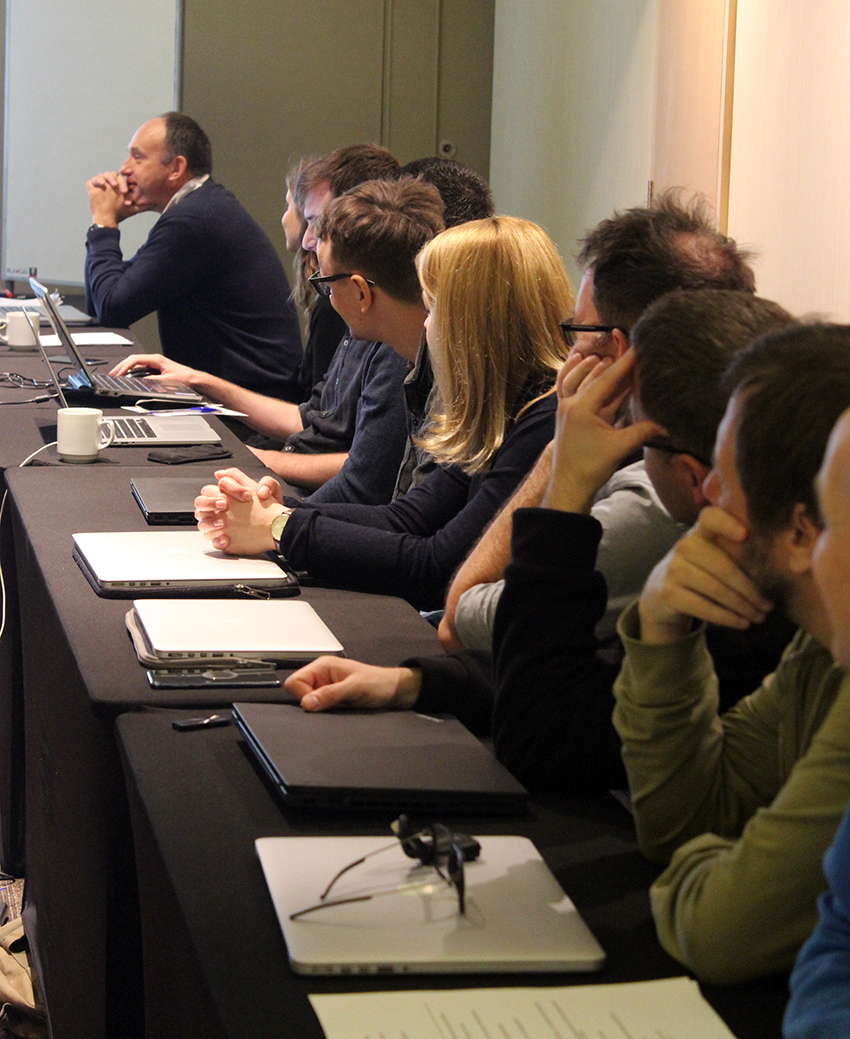
Dr. Wolfgang Gieren, one of the leaders of "Araucaria Project" and academic at the Astronomy Departmen from Universidad de Concepción, states: "We aim to improve the precision with which we can determine distances to galaxies, from the closest to the most remote in the Universe. This is fundamental for practically all fields of Astrophysics, including cosmology. The perhaps most important parameter in cosmology, the so-called Hubble constant, depends critically on our ability to measure ultra-precise distances to galaxies".
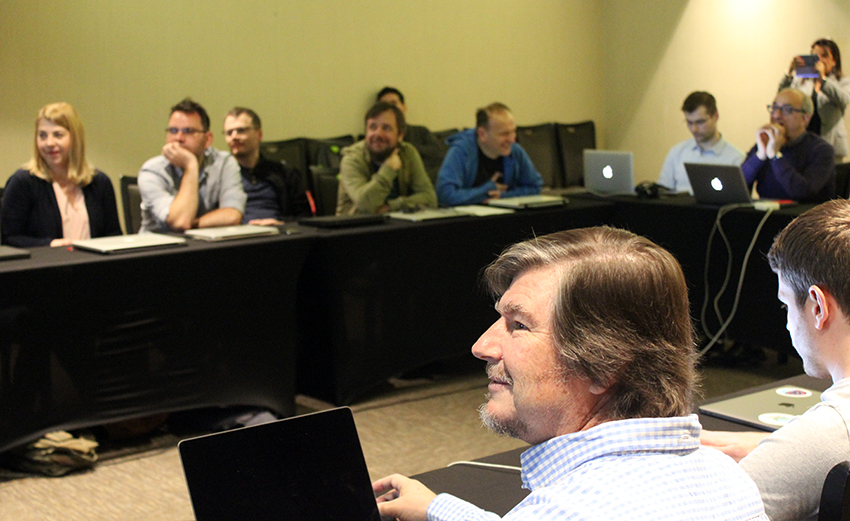
The Araucaria Project scientific meeting will take place at Hotel atton, beginning on March 6 at 09:00 and continuing through March 8. Over these days, 30 scientists will present talks on topics inclugind photometry softwares, stellar clusters with variable stars, analyses of the Large Magellanic Cloud, Cepheidas, among others.
This marks the fourth meeting between the project's members - following previous gathering in Poland (2017), France (2013) and Germany (2010) - and it is intended to update the topic of each group and sub-group of research. Next topics of work will be define and so does the scientific goals for the next three to five years.
Araucaria Project
The Araucaria Project was established in 2000 by researchers Wolfgang Gieren and Grzegorz Pietrzynski of the Astronomy Department of Universidad de Concepción, with the primary aim of refining the calibration of the cosmic distance ladder in the local Universe.
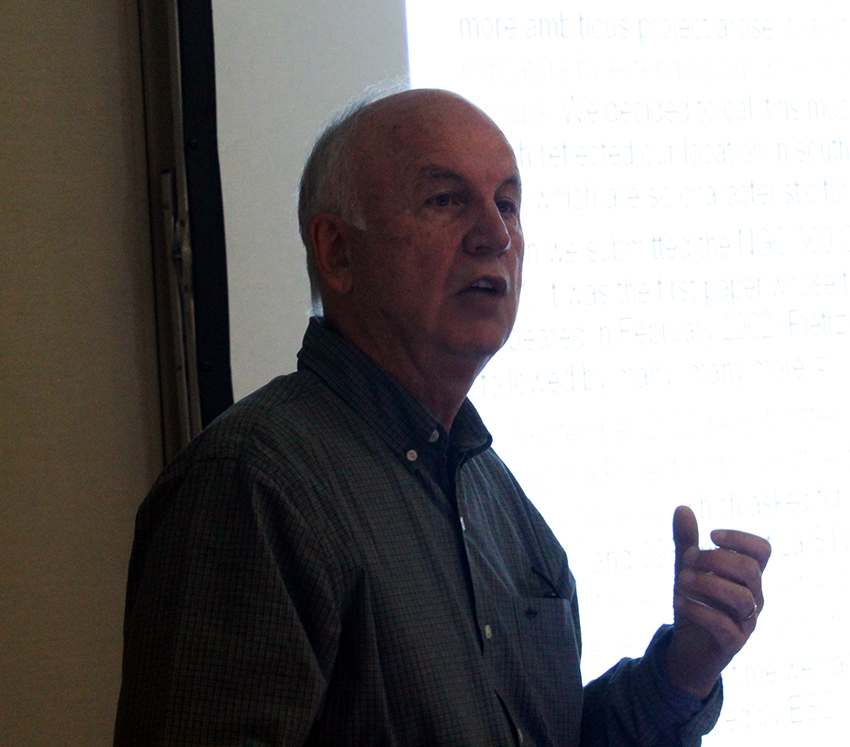
Dr. Gieren said "It was an extraordinarily ambitious project. We gave it a special name reflecting its Southern Chilean origins – the Araucaria Project – because we both love this tree that symbolises the region for us."
Approximately 30 researchers from Chile, Poland, Germany, France, United States, Italy and England belong to the project, which has produced nearly 200 papers in top-tier international journals - including three in Nature.
Dr. Gieren explains: "In 2013, we published in Nature the most precise measurement - with just 2% uncertainty - to the nearest galaxy, the Large Magellanic Cloud, using a technique developed by us through the Araucaria Project. We used eclipsing binary stars, which are very rare, that can be used to measure distances. The Large Magellanic Cloud serves as the base, the zero point, to determine distances to farest galaxies, therefore it is fundamental to measure the Large Magellanic Cloud's distance with the highest precision possible"
The Nature publication gained significant media attention due to the discovery's importance and has since become the standard reference in astronomical literature for distance measurements, accumulating nearly 400 citations to date. Through the Araucaria Project, researchers have produced groundbreaking - and at times spectacular - results in the fields of variable stars and stellar evolution, including both empirical and theoretical studies.
Days: 6,7 y 8 de Marzo
Venue: Hotel Atton. Eleuterio Ramírez 75, Concepción
Hora: 9:00 - 18:00
Participants: Thirty national and international cosmology researchers will exchange ideas and knowledge on cosmic distance scale measurements.
*The Araucaria Project has produced the most precise distance measurement to date of the Large Magellanic Cloud galaxy*
More info: araucaria.camk.edu.pl
Comunicaciones Departamento de Astronomía UdeC
January 28, 2019
Astronomy Department UdeC adds a new telescope for teaching and research
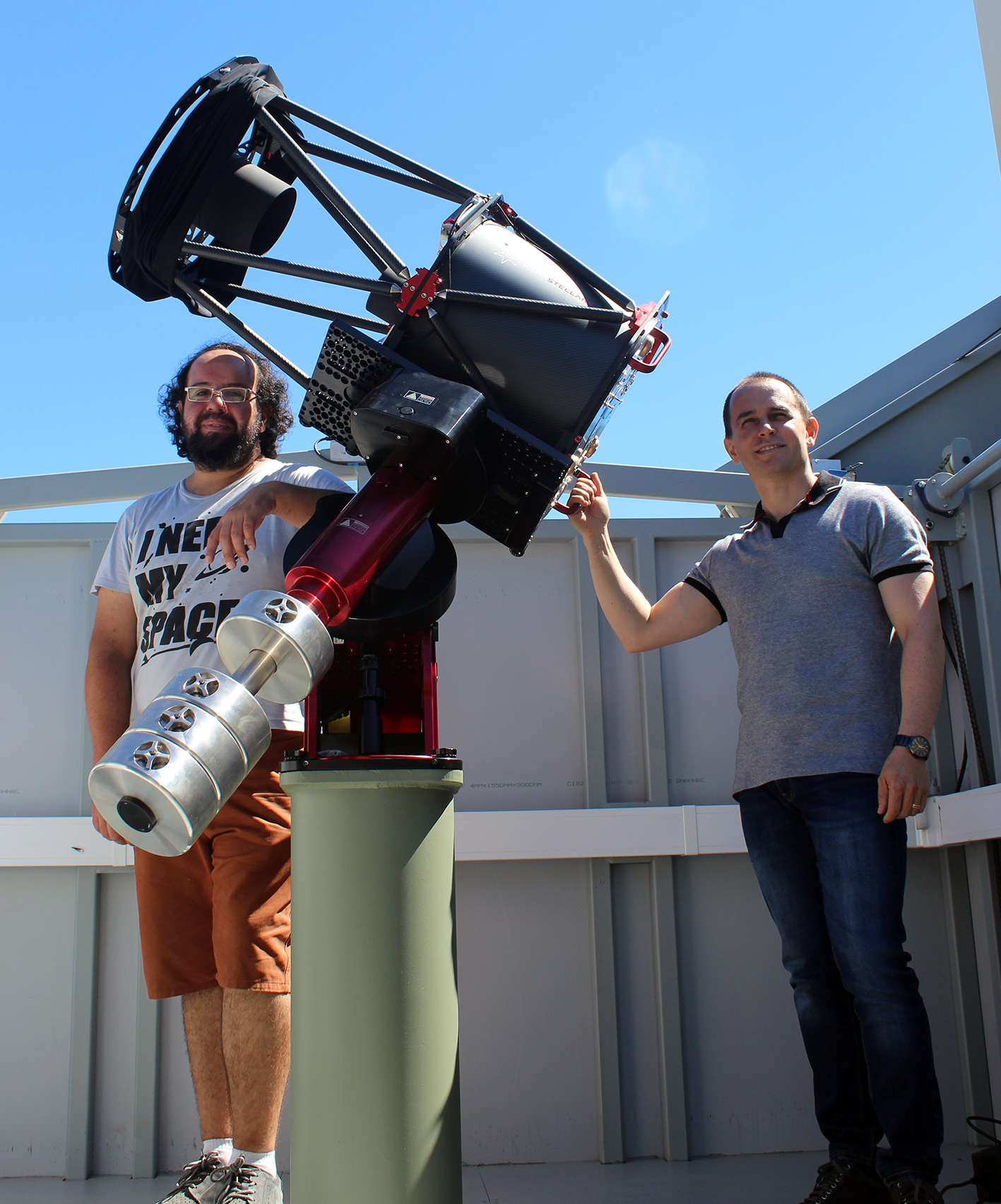
The Astronomy Department at Universidad de Concepción adds a new instrument for scientific development to its facilities: a 40-centimetre diameter catadioptric telescope (which uses mirrors and lenses to capture images) that is remotely operated.
The idea came up a few years ago, when Dr. Douglas Geisler had the idea to acquire a telescope with technological capabilities to support teaching and research. Then, Dr Sandro Villanova, the project's executive director, made the necessary arragenments to acquire the telescope. "A year and a half ago, I started making inquiries, I contacted Officina Stellare, an italian business that designs and manufactures this kind of technology, and I took charge in defining the telescope's size, mount, cameras, filters and other technical details according to the budget we had", In this way, the telescope arrived in Chile at the beginning of 2018. Recently, it was installed at the scientific platform WenuLafquen at UdeC and it lies inside a dome for its protection.
The project cost $120,000 and was funded by BASAL AFB-17002.
Until 2018, the Astronomy Department had five telescopes: one refractor, one reflector, and three catadioptrics, the largest has 27-centimetre diameter used for outreach and teaching located at Facultad de Ciencias Físicas y Matemáticas. However, the presence of light pollution and environmental conditions produced limitations when astronomical observations were conducted; something that will change with the new equipment.
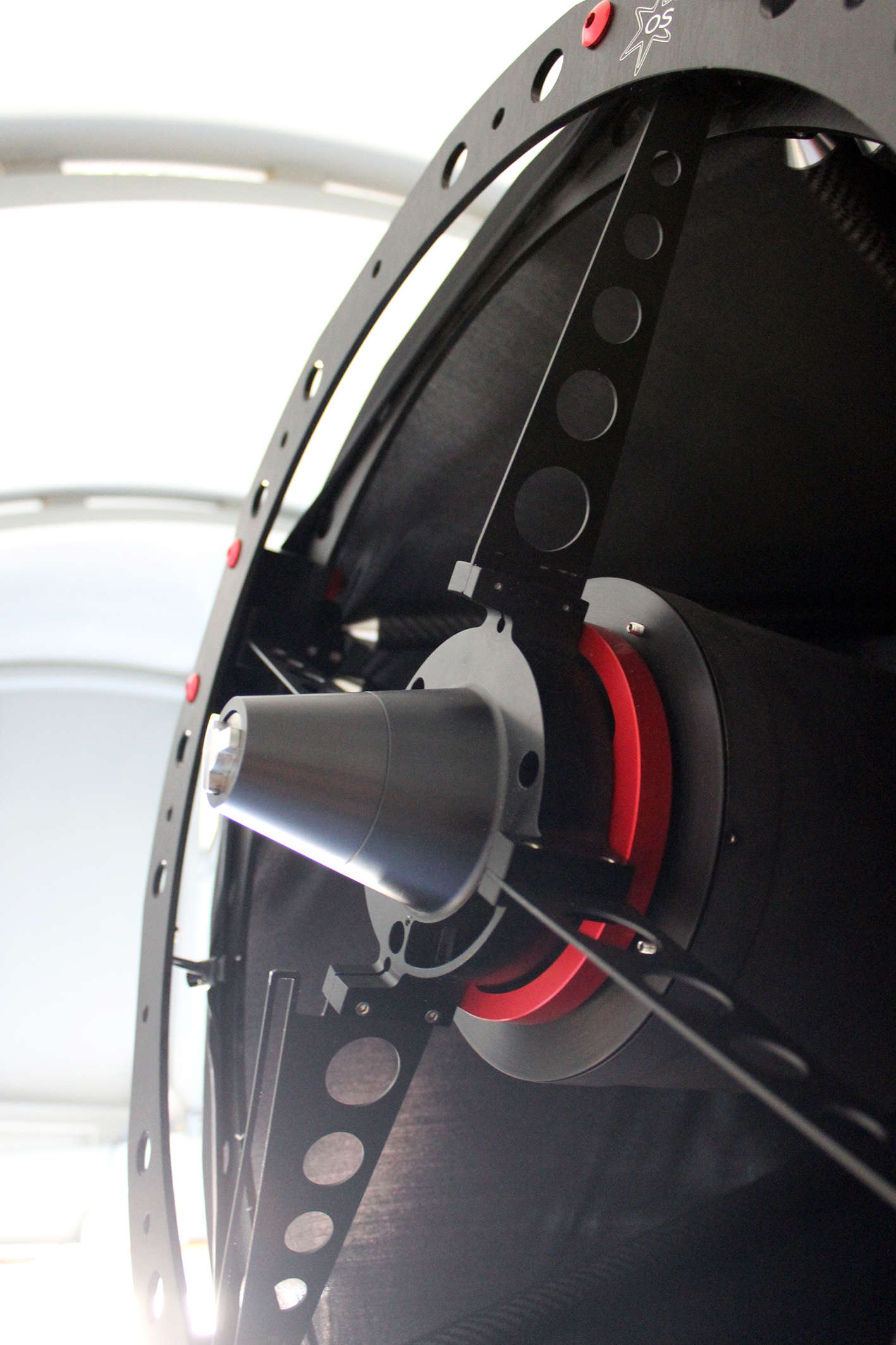
For Mr. Fernando Cortés, in charge of telescopes, the new 40-centimetre optical telescope greatly enhances both teaching for students and research development. "It will no longer be necessary to travel to the observatories in the northern Chile for certain sessions of the Bachelor's in Astronomy, which will save money and time, besides the astronomical science development from Concepción", explained.
Furthermore, for research, this new telescope allows remote control, which removes the need of an astronomer inside the facilities and adds professional efficiency. Its environment, being less light polluted, favours better images and data, allowing for the study of star clusters, variable stars, planets, star-forming regions and nearby galaxies.
It is significant to point out that the scientific platform, WenuLafquen, has a criogenic station, a microwave laboratory and a 3-metre radiotelescope. These equipment transforms UdeC into the only academic institution in the region with this kind of instrumentation and observatories.
The next steps are the installation of comunication networks, both electrical system and software, for setting up the telescope, which is expected to take place in the first semester of 2019.
Comunicaciones Astronomía UdeC


